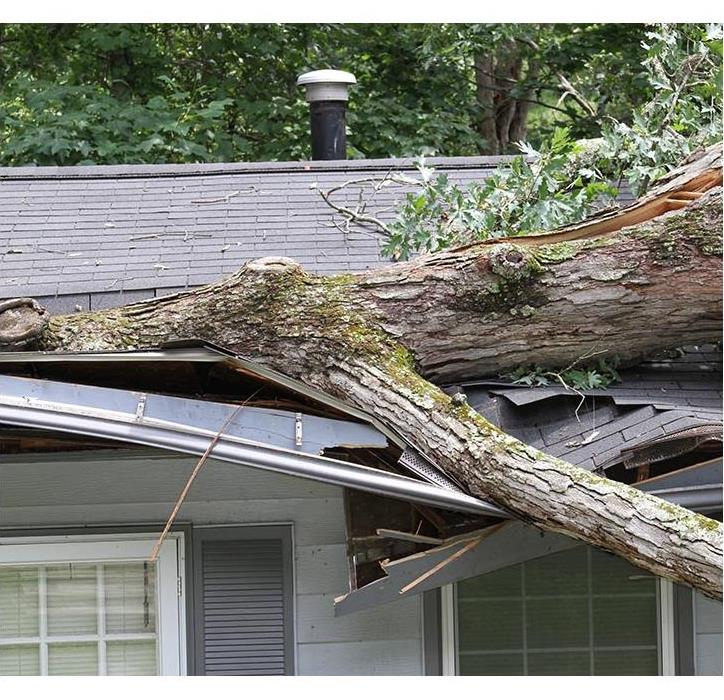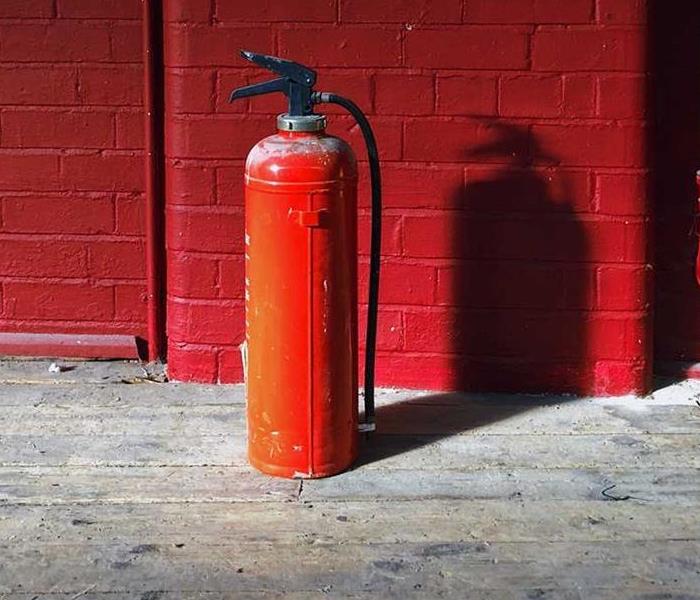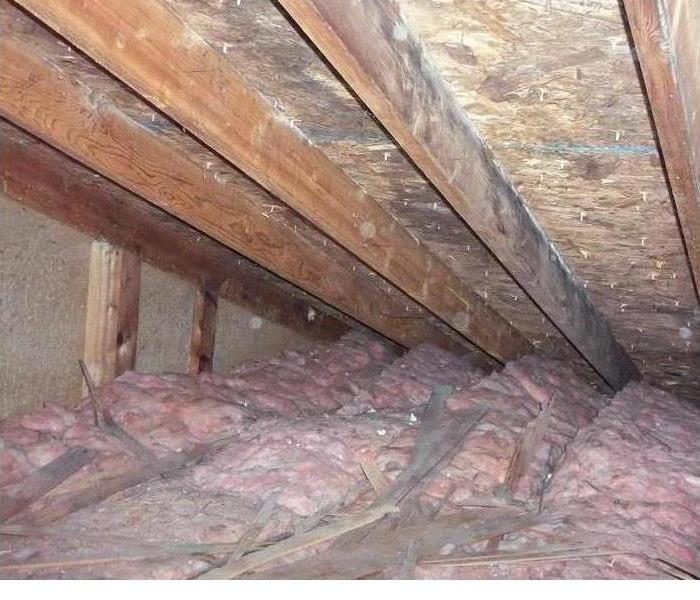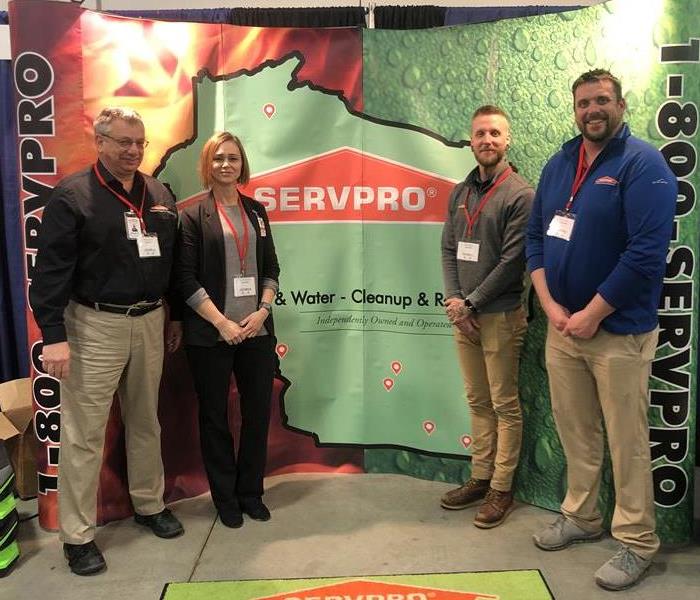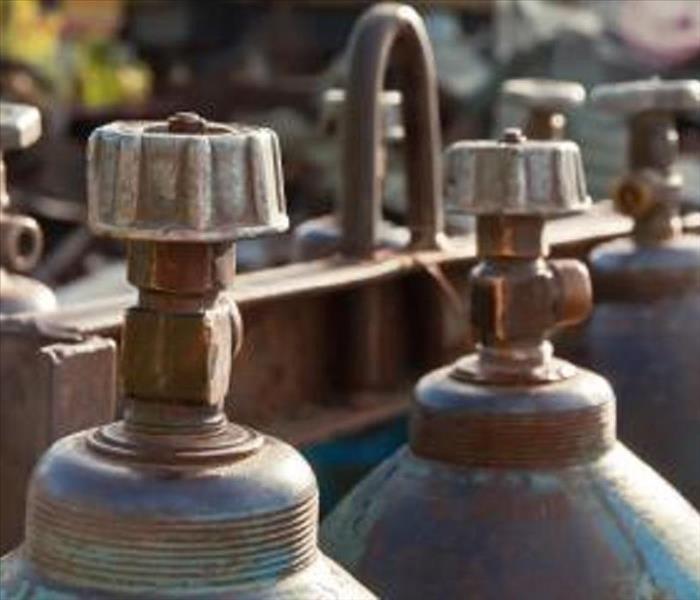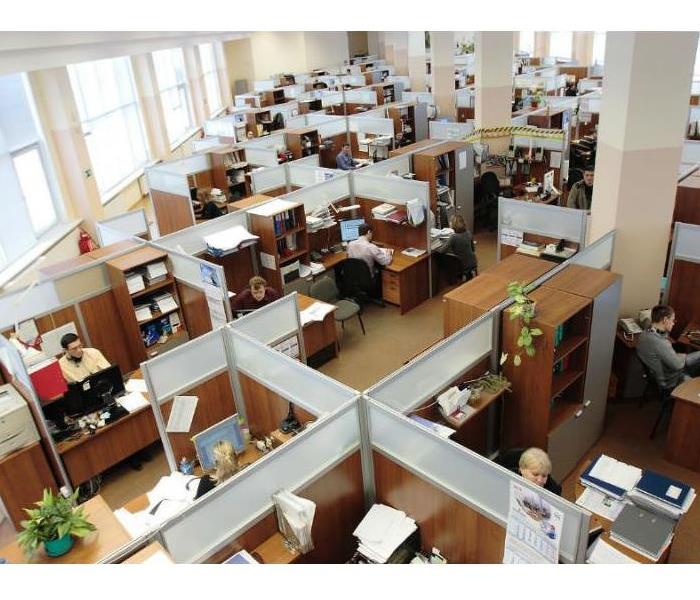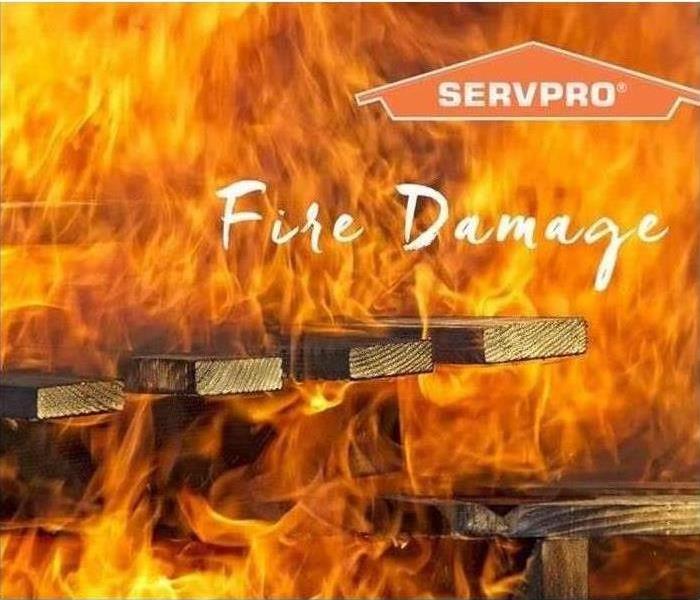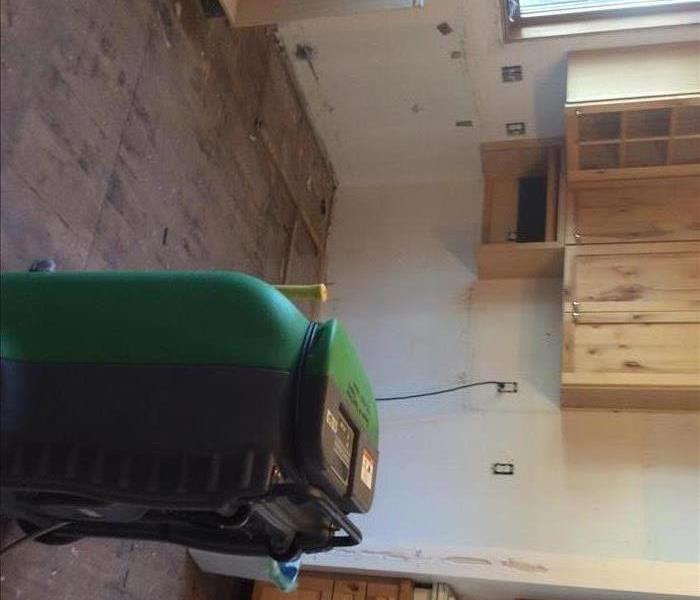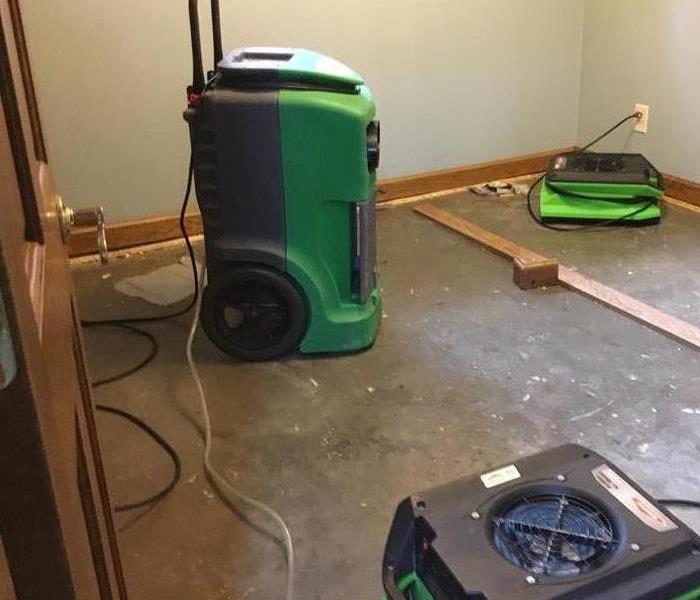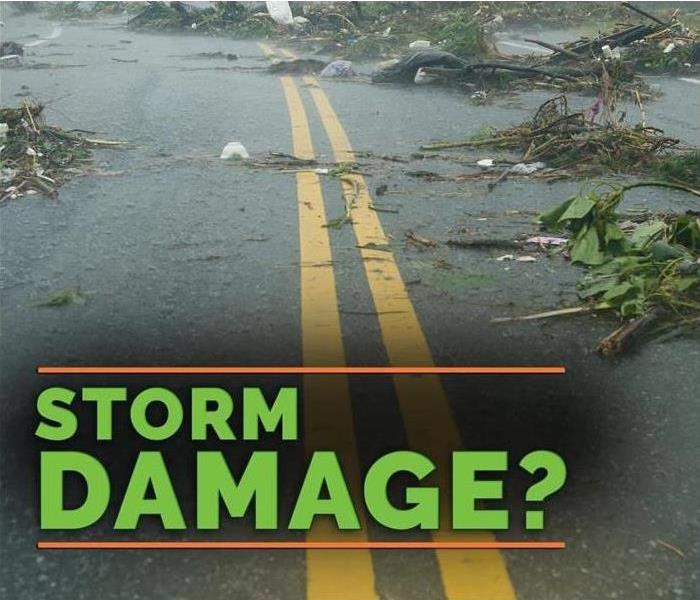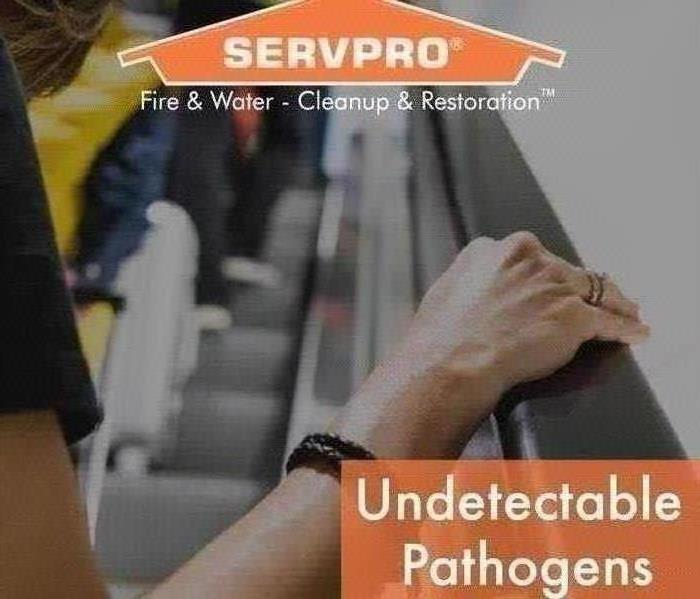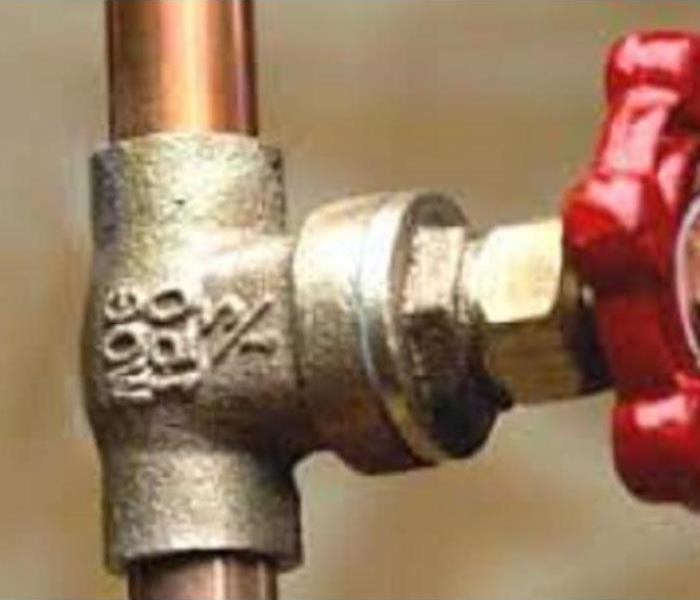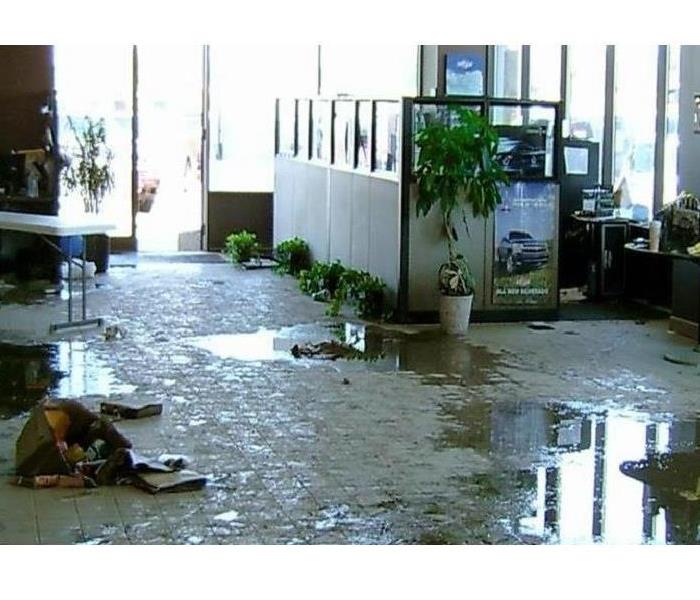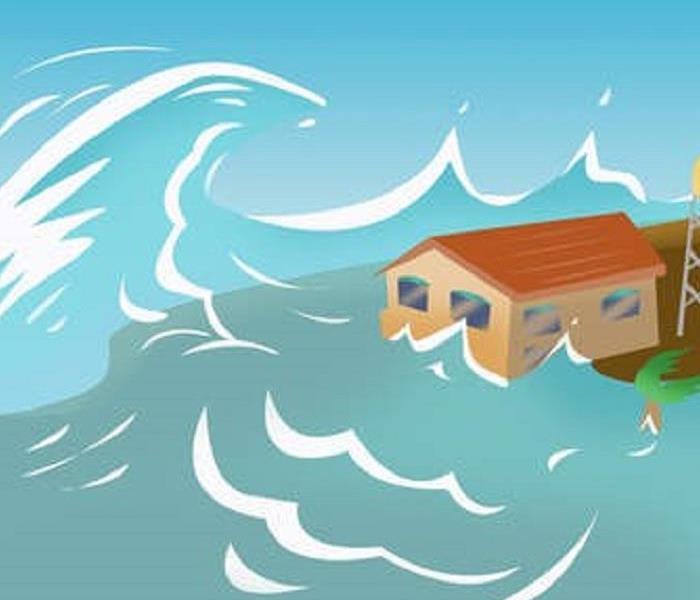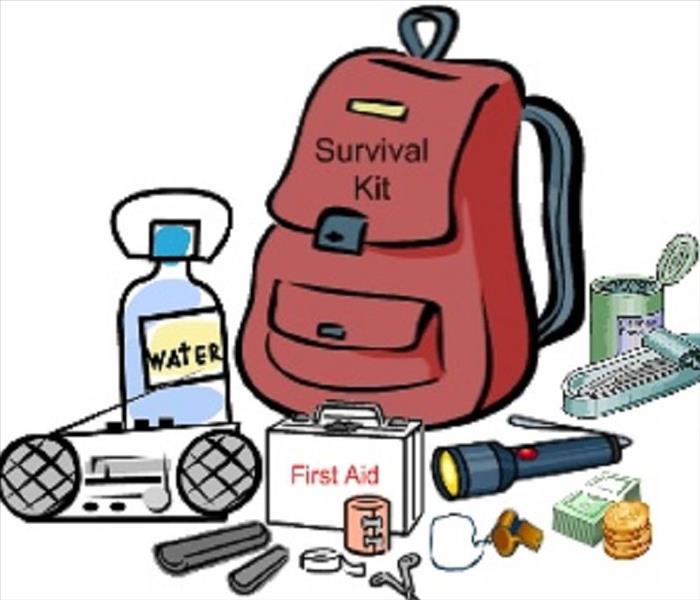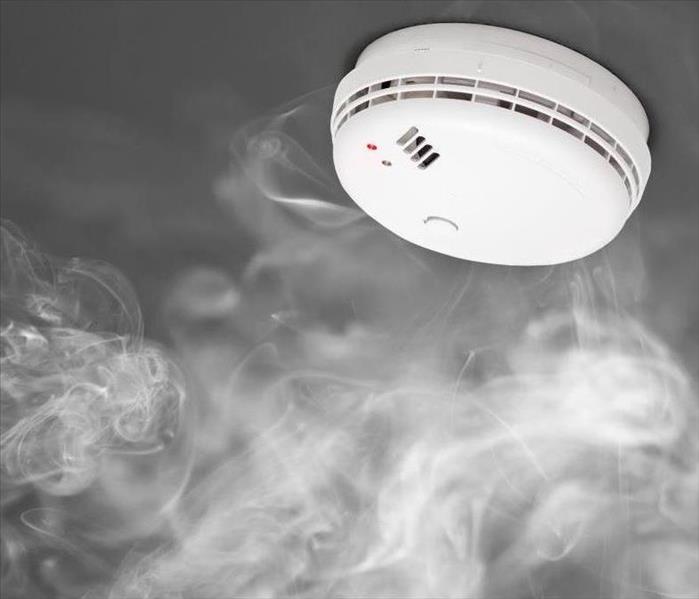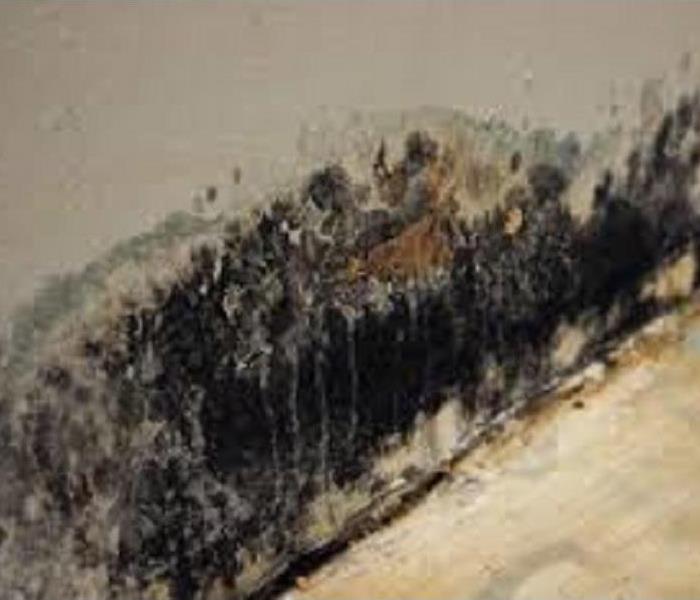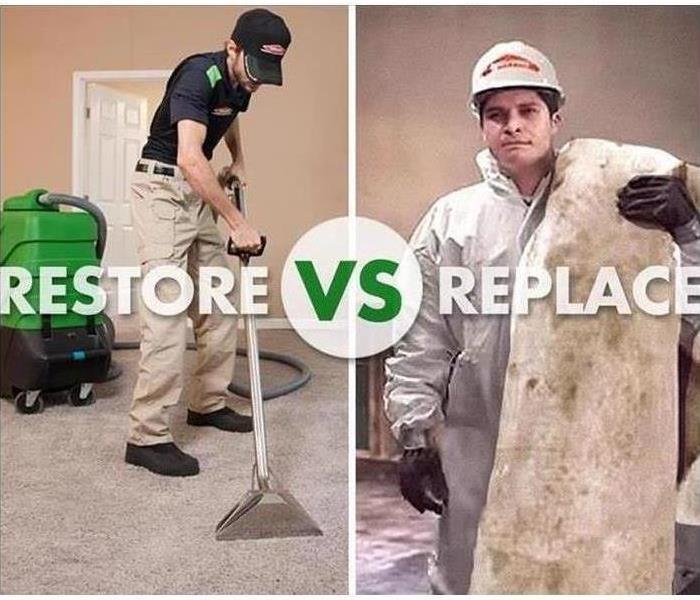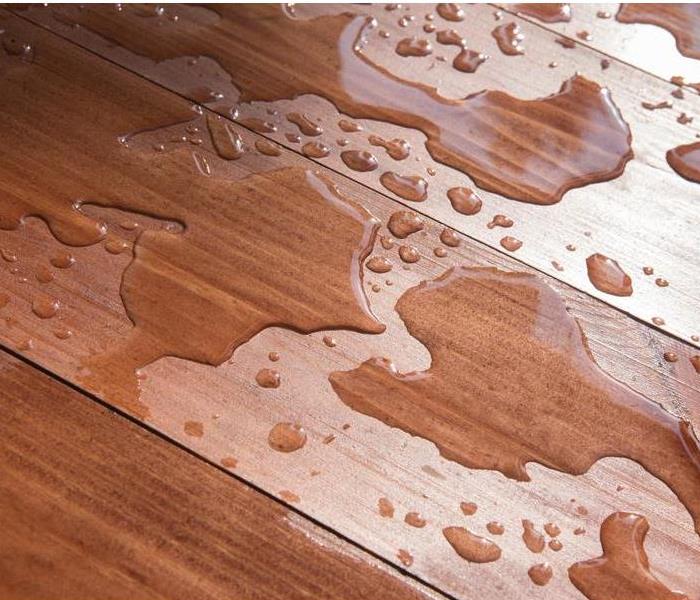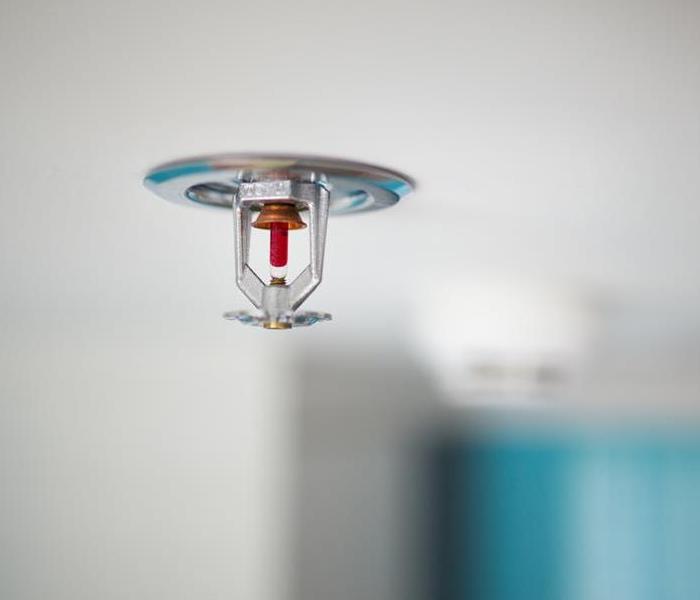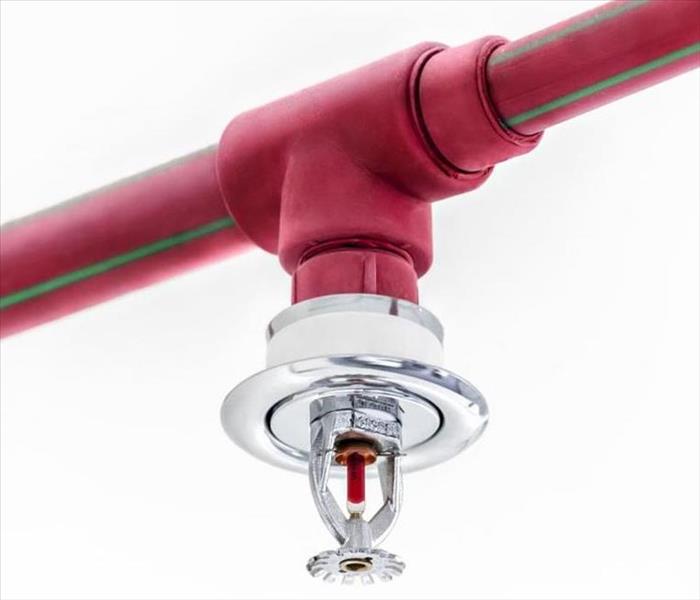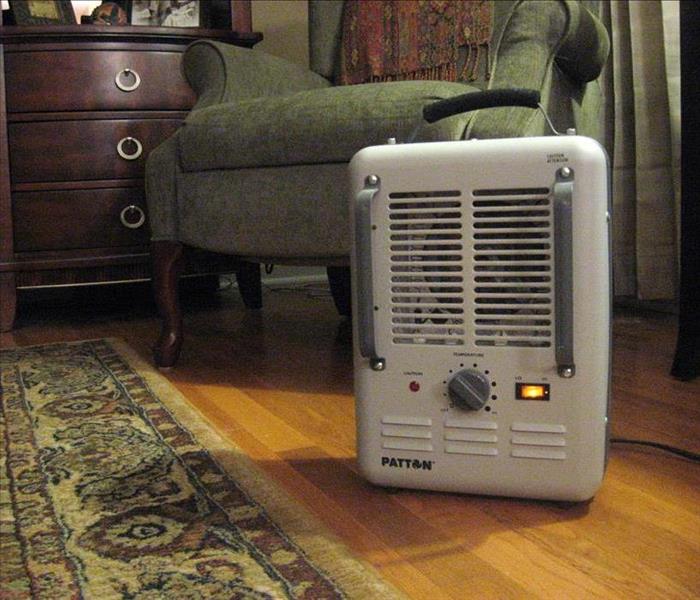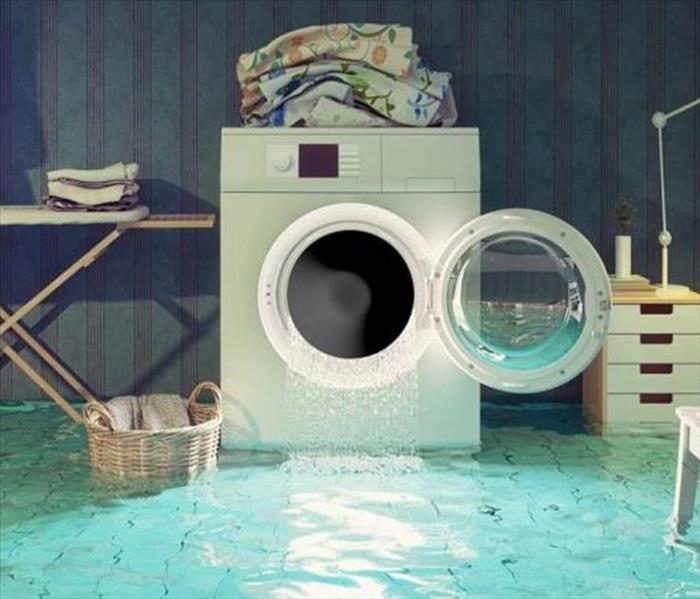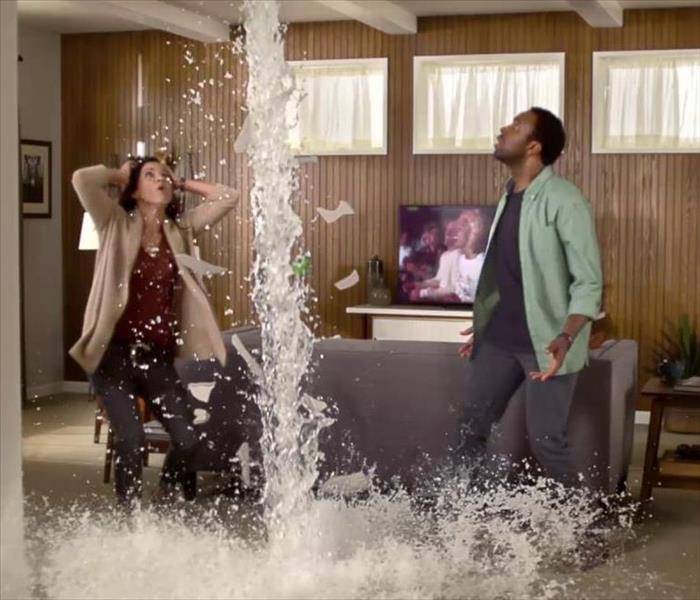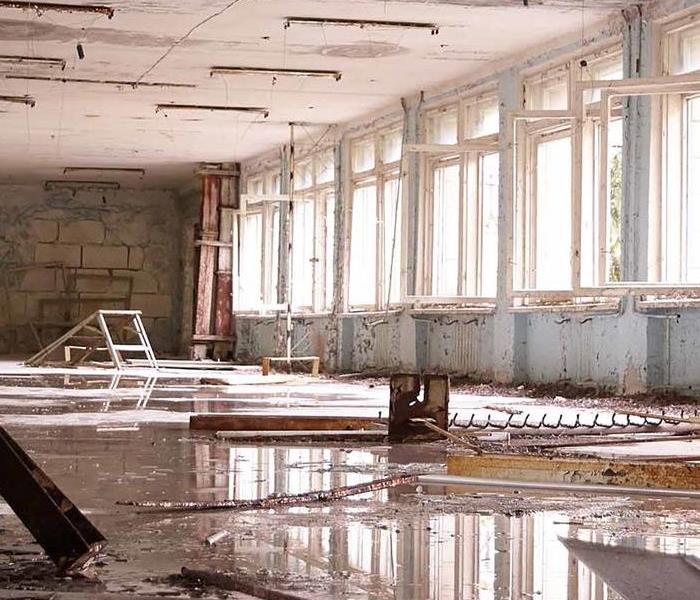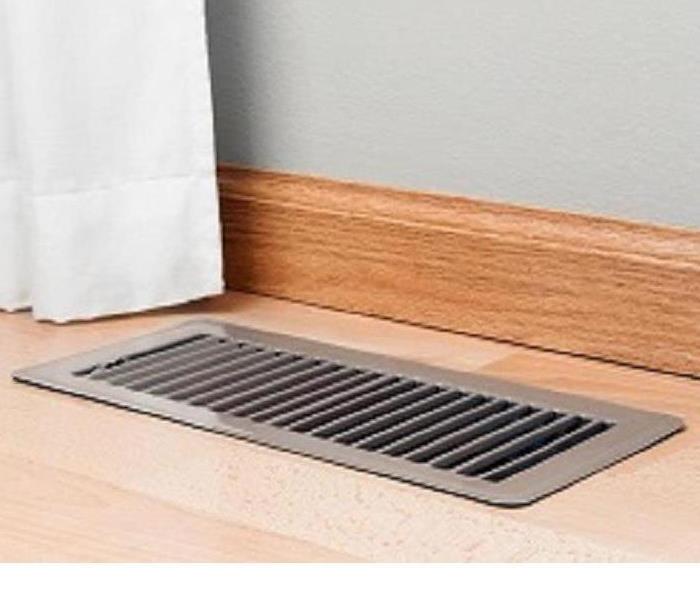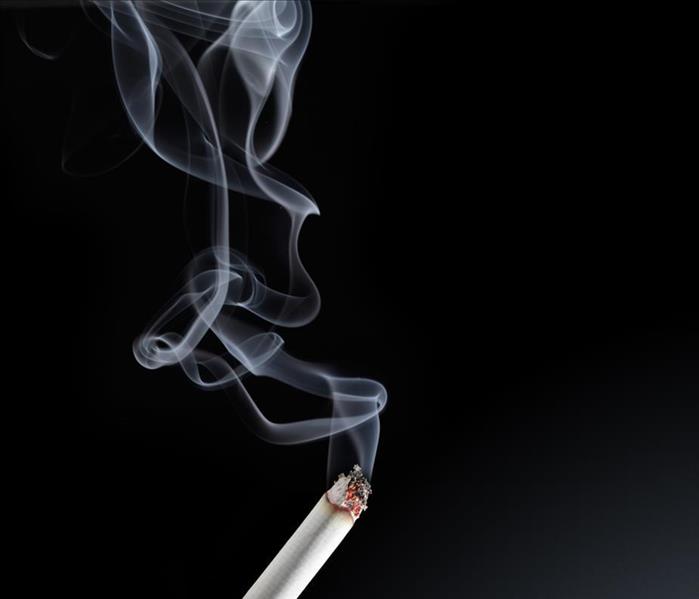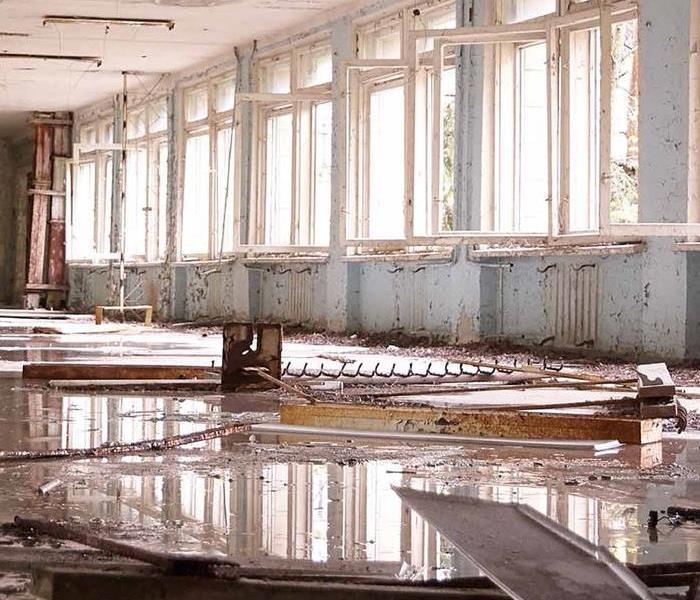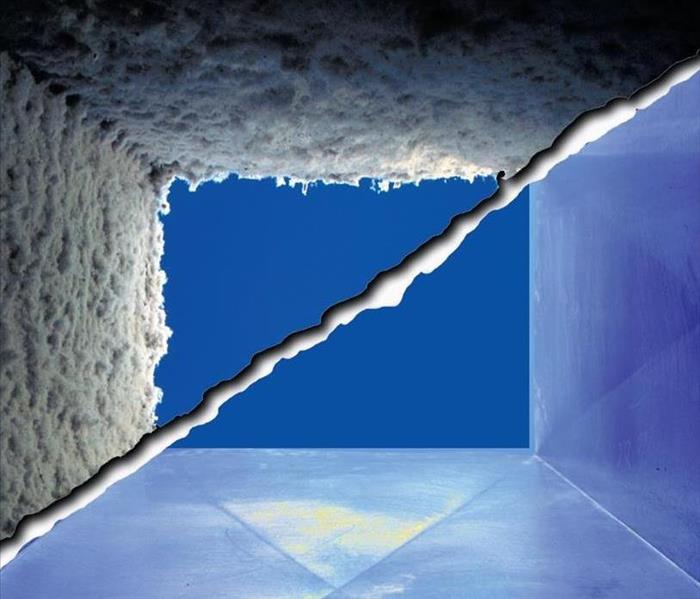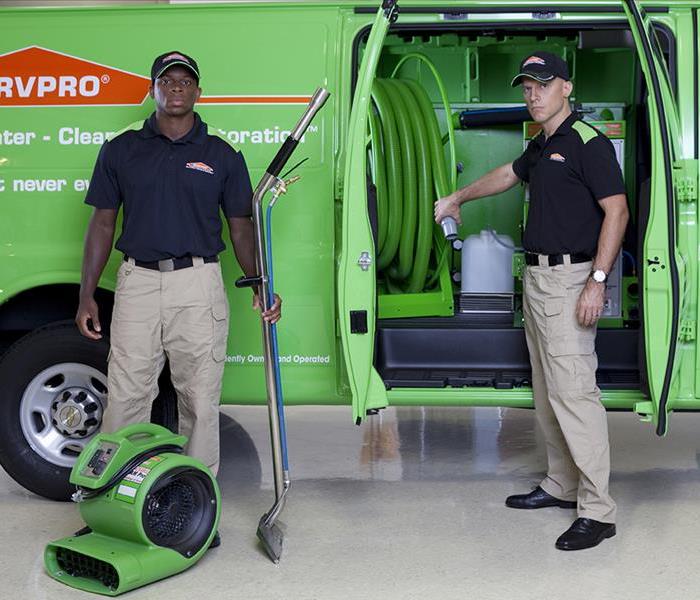Archived Blog Posts
How To Clean Black Mold in Commercial Air Ducts
9/5/2022 (Permalink)
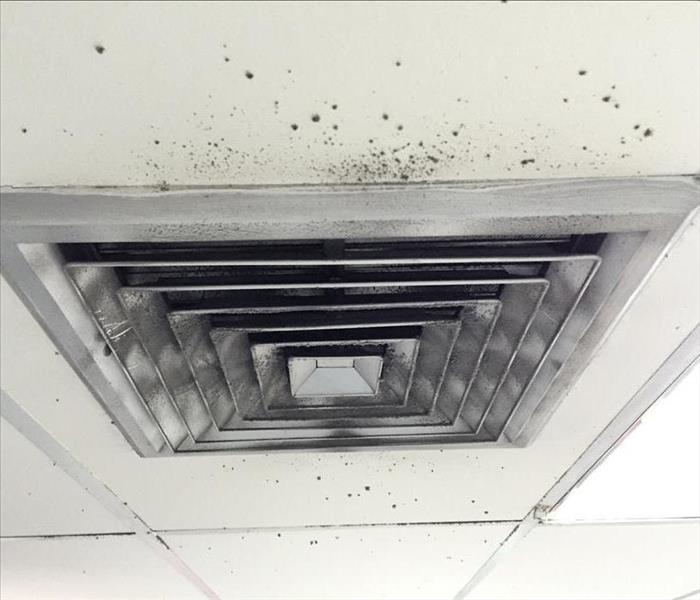 So regular duct maintenance can mitigate this risk.
So regular duct maintenance can mitigate this risk.
Air ducts are a haven for black mold. When is the last time you had your ventilation system professionally cleaned? As a commercial business owner, you know that costly repairs can seemingly come out of thin air. This time, they're coming out of your air vents.
Signs of Mold Overgrowth in Air Ducts
Watch out for these classic signs of vent contamination:
- Black, dusty, hard-to-remove patches around air vents
- The musty smell upon turning on the AC
- Itchy, watery eyes and sneezing
It's always possible that mold overgrowth goes undetected. For this reason, it's best to remain vigilant and keep clean ducts.
How To Clean Ducts
Cleaning an air ventilation system is not an easy task. For this reason, it's best to consult a professional right off the bat. Attempting this feat alone is not only time-consuming, but it could be harmful to you and your clients in the building. If not done properly, attempting to remove black mold may accidentally exacerbate the issue. Luckily, there are some simple steps you can take instead.
Contact an expert in Prescott, WI.
The right mold remediation professionals will verify that mold is indeed present.
Cleaning will begin, and if spread to insulation, insulation will need to be replaced.
The professional team will use the correct cleaners and tools while disinfecting your commercial air ducts.
Once done, now it's your turn: prevent mold regrowth!
How To Prevent Mold Regrowth
Step five is arguably the most important step. Taking the necessary precautions to prevent black mold from reappearing will save you and your commercial business tons of time, money, and stress. In order to stop the fungus from thriving, you need to first locate the source. What is causing the mold to prosper? Air vents are naturally a breeding ground for mold, so regular duct maintenance can mitigate this risk. Make sure the AC filters are changed out periodically. Reduce moisture and humidity in your commercial space. Use natural air circulation when possible, like opening a window. Keep the aforementioned tips in mind, and mold won't have a chance to damage your livelihood.
3 Mistakes to Avoid During a Workplace Fire
8/31/2022 (Permalink)
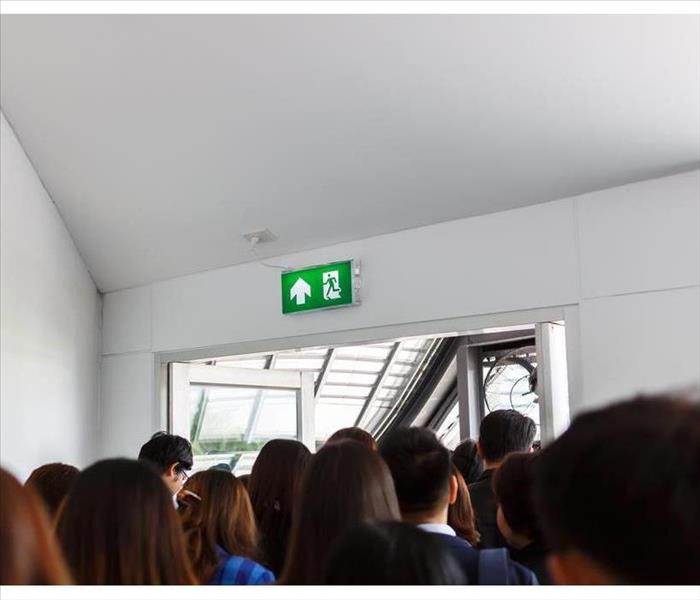 To keep the fire from spreading, instruct your staff to use only emergency exit doors
To keep the fire from spreading, instruct your staff to use only emergency exit doors
What Not to Do During a Workplace Fire
Making sure fire extinguishers are accessible and smoke alarms are maintained are crucial steps to take as an employer. If a fire does erupt in your workplace, it’s natural for people to panic. Unfortunately, this can lead to common mistakes that aggravate the situation. To ensure everyone makes it out of the building safely during an emergency, here are a few safety guidelines to remind your staff of during fire training.
Break Windows
Smoke inhalation is a threat to those inside the building. In an effort to access fresh air, some people might open windows or break the glass. However, when oxygenated air from outside rushes in, the intensity of the fire will build more quickly.
As smoke and heat rise, everyone should stay close to the ground and crawl to the exits to avoid fumes. If exits are blocked, put wet towels under the doors to keep out the smoke instead of opening windows.
Fail to Use Emergency Exits
Fire extinguishers. When a fire starts, people might try to evacuate the building the same way they got in. However, you shouldn’t open any doors leading to the main corridors, especially if the handles are warm to the touch. Flames could be on the other side of these, and opening them could feed more oxygen to the fire and expose people to smoke.
To keep the fire from spreading, instruct your staff to use only emergency exit doors, stairwells, and fire escapes.
Forget to Alert Others
When they hear the fire alarm protection system, some people may think it’s just a test. If they don’t smell smoke or feel the heat, they might fail to take action.
To protect everyone in the workplace, people who see the flames or smoke should yell “fire” to alert others that it is not a drill. Those trained to use fire extinguishers can try to control the blaze while others call emergency services for help. If anyone in the workplace has mobility difficulties, assign someone to ensure they can get out safely during your safety plan design.
3 Ways SERVPRO Helps Insurance Adjusters and Their Clients
8/31/2022 (Permalink)
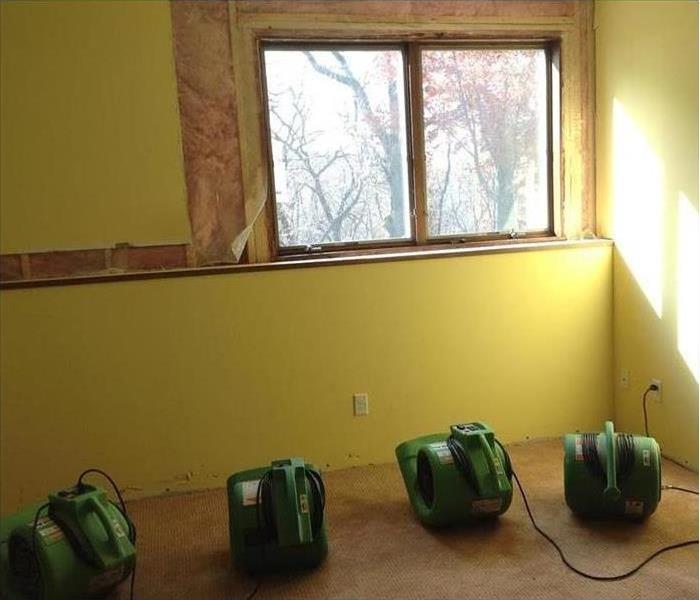 SERVPRO's professionals take pride in their customer service.
SERVPRO's professionals take pride in their customer service.
SERVPRO Offers Three Ways to Assist Insurance Adjusters and Their Clients
The restoration experts at SERVPRO are committed to satisfying their customers. Local and national professionals work as a team to help manage the disaster recovery process, from restoring damaged property to working with an insurance adjuster. While the company's headquarters builds and maintains relationships with insurance companies, it is the local representative that will assist onsite in Prescott, WI. Here are three ways that these experts aid adjusters and their clients.
1. Arrive Quickly To Begin Helping
First, this franchise understands that when an accident or natural disaster damages a business, the owners want and need assistance as soon as possible. The company has over 1,900 locations across the United States and Canada, which enables its restoration professionals to arrive at a disaster site in under four hours. Additionally, this time frame holds day or night because these professionals are available to respond 24 hours a day, every day of the year.
2. Inventory for Information
Once on the scene, professional cleanup workers immediately address emergency issues, such as shutting off water and gas lines. After deeming the site stable, the restoration crew works its way through the property and carefully makes a list of every item, noting the degree of damage. In addition, SERVPRO’s employees will photograph expensive items. These photographs of the inventory will help insurance adjusters determine how much their clients will receive for the losses.
3. Pretest To Reduce Insurance Claim Issues
SERVPRO’s restoration philosophy includes pretesting, which asserts that it is better to restore than replace because repairing damaged goods is usually less expensive than buying new ones. After pretesting, SERVPRO’s local representative can work with the adjuster and its client to save money for everyone involved.
SERVPRO's professionals take pride in their customer service. Helping insurance adjusters make their clients whole again is just one way that these franchises contribute to their communities.
The Top 3 Challenges Posed By Large Losses
8/4/2022 (Permalink)
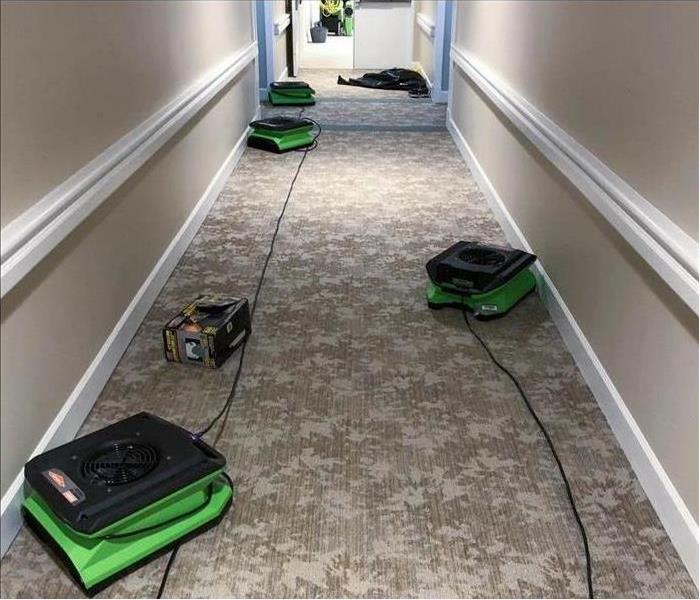 Drying equipment is placed to avoid further damage.
Drying equipment is placed to avoid further damage.
The Top 3 Challenges Posed By Large Losses
A devastating natural disaster such as a tornado or other severe weather events can result in a catastrophic loss of properties throughout Baldwin, WI. Find out more about the three main obstacles property owners and insurance agents must overcome in order to achieve a timely recovery.
1. Many Properties May Be Affected
Adverse weather such as flooding or a tornado can affect an entire neighborhood, town or city. When these events occur, local restoration franchises and independent remediation firms may all have their resources strained to the limit. The difference among these service providers is that franchises in a national company can share staff and resources to meet sudden spikes in demand for mitigation, cleanup and restoration.
2. Insurance Response Can Be Limited
Insurance agents and adjusters in a region affected by severe weather, or any other disaster resulting in catastrophic loss, may also have claims from many clients to inspect. As a result, it may not be possible to visit every affected property before mitigation is needed to limit the severity of the damage. Relying on a restoration company that arrives on-site within hours and thoroughly documents conditions makes it possible to start alleviating the destruction sooner.
3. Property Owners Must Act Quickly
The severity of storm damage can increase significantly over the hours following an incident. It is important to extract water within 24 to 48 hours to prevent serious mold problems. A local restoration franchise that is part of an extensive network can ensure that mitigation and cleanup measures stay on schedule.
Each of these factors has the potential to hold up recovery from an incident that causes catastrophic loss in Baldwin, WI. Property owners and insurers can avoid delays by relying on a restoration company that has over 1,700 locations across North America. Affiliated local and regional franchises can work together to provide mitigation, cleanup and restoration services after a large loss.
3 Proactive Ways To Minimize the Risk of Commercial Plumbing Issues
7/30/2022 (Permalink)
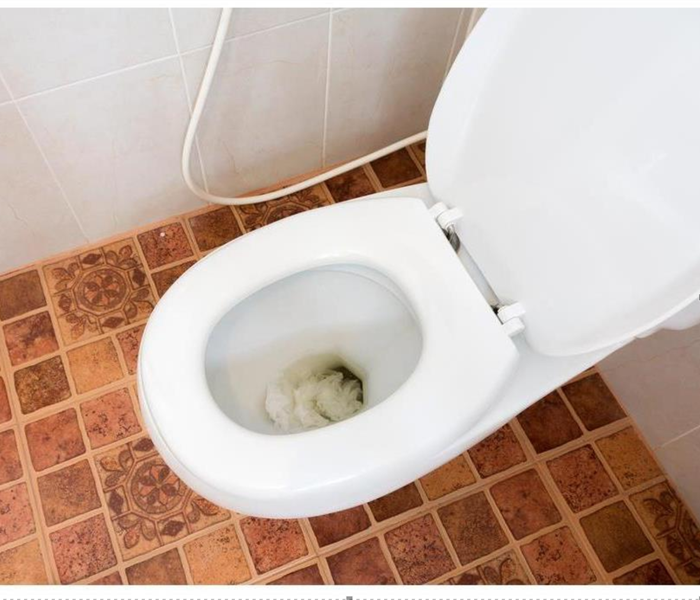 Clogged drains are easy to recognize and easy enough to fix.
Clogged drains are easy to recognize and easy enough to fix.
The Risk of Commercial Plumbing Issues
When you encounter plumbing problems, you could be looking at small problems or big ones. A clogged drain, for instance, is not the same as a broken pipe. Businesses in Baldwin, WI, and across the country would benefit from employing proactive methods of looking after their plumbing systems, diminishing the potential for future issues. Here are three proactive ways to ensure your commercial plumbing system keeps working properly.
1. Check Your Drains Often
Clogged drains are easy to recognize and easy enough to fix. When you see water beginning to back up in the toilets or sinks, you could employ a chemical or chemical-free solution, a wire hanger or a plunger. Typically, you'll pull out whatever's creating the clog, or the solution will flush it through the rest of the system.
2. Utilize Appropriate Water Pressure
If the water pressure in a building is too high, it could lead to broken seals, damaged fixtures and leaks. High water pressure applies stress to the pipes, but you can monitor it by attaching a hose bib gauge to your outside spigot. You're looking for water pressure between 40 and 80 psi. If you get readings above 80, you may want to install a pressure reducer.
3. Find a Plumber Who Is Versed in Various Plumbing Problems
Eventually, your plumbing system will alert you that something is wrong. The rule of thumb is the faster the fix, the better, but plumbing systems are complex, and most of their components are hidden. A trusted, experienced plumber can recognize issues quickly and prevent a small issue from affecting the rest of the system. If, for instance, your water bills are higher than normal and there are soft, mushy spots on the lawn, you may or may not consider a broken water main, but your plumber will likely pin it down immediately.
In the event of broken pipes or high water pressure, you'll need water damage restoration professionals. In the meantime, employing a proactive approach to your commercial water system can reduce your risk of experiencing plumbing problems.
Steps To Replace Your Leaking Toilet
7/15/2022 (Permalink)
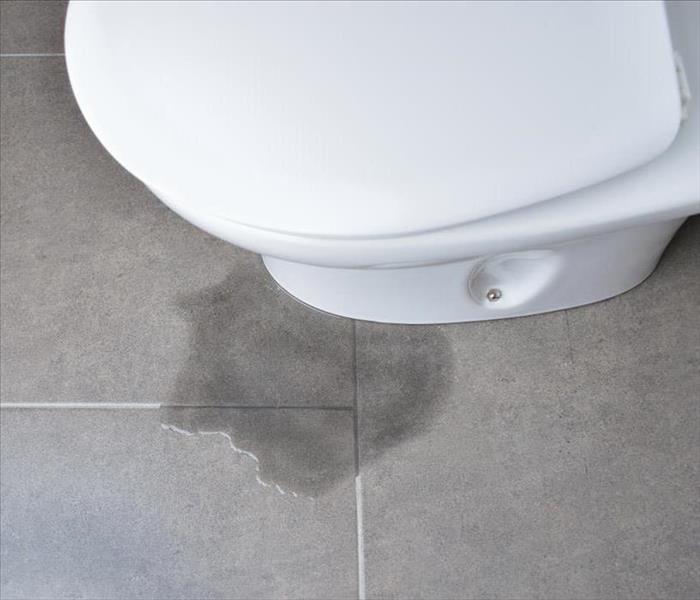 A leaking toilet in New Richmond, WI.
A leaking toilet in New Richmond, WI.
How to Replace a Leaking Toilet
Replacing a toilet is not always necessary, but sometimes toilet repair is not enough to fix your leaking toilet. Inspect for water damage on the walls and floors before replacing your toilet. If you discover there is damage, contact a water damage restoration company in New Richmond, WI, so professionals can handle the remediation. Once you’ve determined there is no water damage, you can replace your toilet following these steps.
1. Remove the Old Toilet
Turn off the water to the toilet using the shutoff valve. Flush the toilet to drain the water from the leaking toilet. Continue to hold down the handle until the water no longer drains. Sop up the remaining water in the tank with a towel or a sponge. Use a cup to remove any water left in the bowl. Disconnect the water-supply tube. Take off the caps of the closet bolts and remove the nuts. Lift the toilet off the floor and place it aside on plastic or cardboard.
2. Prepare for Installation
Scrape off the old wax gasket. When putting a new wax gasket on the closet flange, make sure it is centered. Apply plumber’s tape or a light coating of pipe-joint compound to the fittings on the water-supply tube.
3. Install the New Toilet
Lift the new toilet by the bowl near the seat hinges. Carry it over the flange and set it on the wax gasket aligning it with the closet bolts. Press down firmly on the rim of the bowl. Place the washer and nuts over the closet bolts and tighten until snug. Repeat pressing on the bowl and tightening the nuts until the nuts are no longer loose. Cut the bolts using a hacksaw and replace the caps.
4. Attach the Water Supply
Connect the water-supply tube to the toilet and the shutoff valve. Turn on the water and flush the toilet a few times. Prevent another leaking toilet by pressing on the bowl and tightening the nuts again. Use the toilet for several weeks, then retighten the bolts.
Allowing professionals to tackle any water damage is advised, but following these steps will ensure a properly installed toilet.
How To Prevent Frozen Pipes This Winter
7/3/2022 (Permalink)
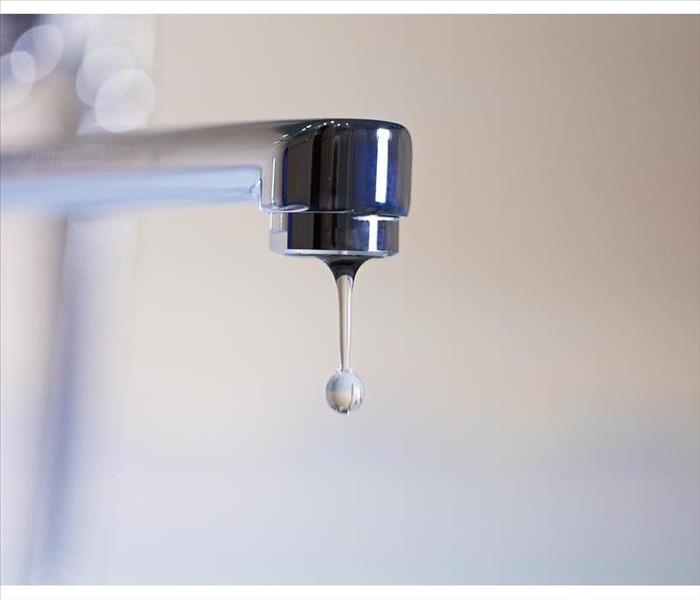 Allow water to drip from any faucet
Allow water to drip from any faucet
Winter storms can wreak havoc on your house, so practicing proper winterization and flood prevention techniques is crucial during the colder months. Did you know that most floods are not caused by excess rainwater but rather from a burst pipe resulting from frozen water in the line? Read on to learn how you can prevent storm damage and keep your house damage-free this winter.
How Do Pipes Freeze?
Unlike other liquids, water expands as it freezes. Therefore, if standing water is left in pipes before winter arrives, it will likely freeze and expand as the temperatures outside drop. Pipes that commonly freeze are:
- Outdoor pipes that are uncovered and vulnerable to the cold.
- Pipes located in unheated rooms like the attic or garage.
- Pipelines that extend along the outside of the house where there is no insulation.
How To Prepare for Winter
As winter looms in River Falls, WI, be sure to properly winterize your home to avoid the need for storm damage repair. Empty your swimming pool, and blow out all sprinkler water lines. Drain your hoses, and open the spouts of all outdoor hose bibs to allow them to empty. Consider adding insulation to your attic, garage, basement, or any other uninsulated areas that contain pipelines.
How To Avoid Frozen Pipes
In the winter, be mindful of keeping garage doors closed to keep the cold air outside. In the bathroom and kitchen, open cabinet doors to keep plumbing fixtures warm. Further, if temperatures approach freezing, allow water to drip from any faucet connected to an outdoor pipeline; you are less likely to experience a frozen pipe if a small amount of water moves through it. Finally, even if you're leaving town, keep your thermostat set to a temperature above 55 degrees F. While your heating bill might be higher, it is still much cheaper than a burst pipe.
Winterizing your home is a relatively easy chore that can save your home from catastrophic damage. Avoid a burst pipe this winter by following these simple and helpful tips.
Where Do Different Types of Flood Damage Come From?
6/22/2022 (Permalink)
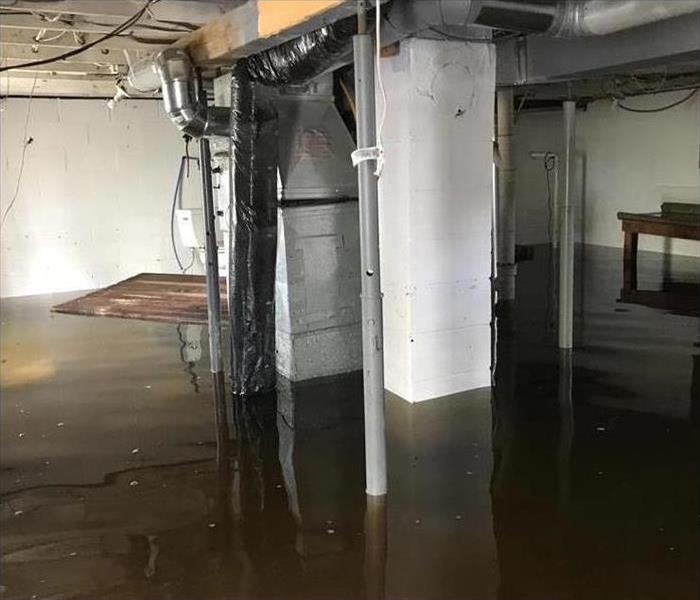 A flooded basement in River Falls, WI.
A flooded basement in River Falls, WI.
What Causes Water Damage?
Heavy flooding can cause serious damage to your River Falls, WI, home, but did you know there are different types of issues it can cause? Depending on the source of the water, your home and its contents may experience a wide variety of problems. Learning what causes water damage and why may help you call for the right type of assistance when these floods happen.
Outdoor Floods
When outdoor floods occur, the water source is usually from a variety of sources, such as:
- Local creeks
- Ponds
- Clogged sewers
These floodwaters usually carry dangerous bacteria, animal offal and sewer contents. Because of its contents, professionals mark this water as Category 3 or black water. You should avoid handling this type of water if it enters your home and call a professional flood restoration service for assistance.
Indoor Sink and Toilet Floods
Flooding that occurs from an indoor source, such as a sink, washing machine, or toilet, may have different grades of cleanliness. For example, if the flood comes from a broken refrigerator line that is used to make ice, this is a Category 1 flood situation that should not be harmful. However, if standing water from a clean source sits for more than 24 hours, it can break down rapidly and grow bacteria. This can cause it to become dangerous to handle. Toilet water is usually considered a Category 3 flood and typically requires the assistance of a flood mitigation and restoration service.
Flood Damage In Basements
When spring thaws occur, they can affect your home's gutters and cause ice dams, which may result in serious water leaks inside your home from the gutters not draining water away properly. Basement leaks and floods are quite common, and depending on how long the water stands in the room, it may be either a Category 2 or Category 3 flood.
Different types of flooding in River Falls, WI, can affect your home in a variety of ways. Generally, avoiding the water until you can call for assistance regarding its removal is usually the wisest course of action.
Common Places Mold Grows in Commercial Buildings
6/13/2022 (Permalink)
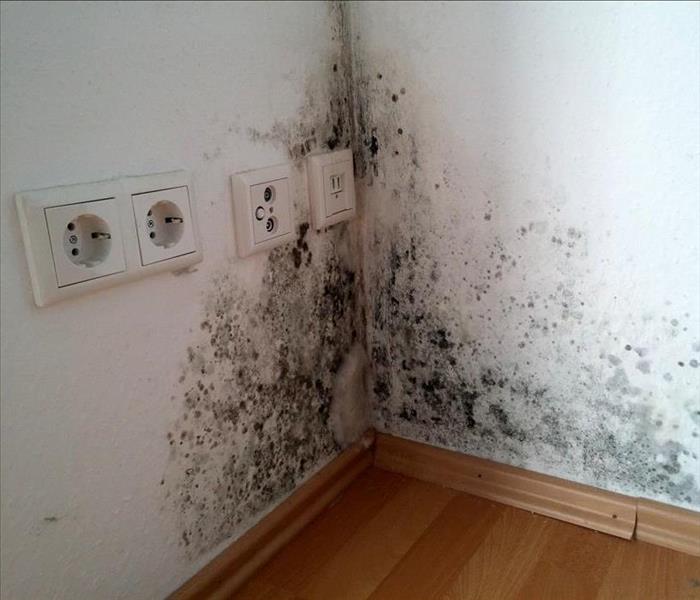 Mold damage in a commercial building in Hudson, WI.
Mold damage in a commercial building in Hudson, WI.
Common Places Mold Grows in Commercial Buildings
It does not take much for mold growth to occur. Mold is often found in dark, isolated spaces plagued by moisture. Mold can be costly and time-consuming to clean. The best defense against mold is to do everything possible to prevent it from ever happening. Here are a few places to check for mold in your building in Hudson, WI.
Common Places You Expect To Find Mold
Moisture, a surface, darkness, and organic nutrients from dust are all that is needed for mold to grow. Any area that has frequent exposure to water or high humidity can easily become infested with mold. Places you might expect to find mold include:
- Bathrooms
- Kitchens
- Carpets
- Windows
- Water heaters
- Air conditioners
Mold may not be out in the open in these areas. Remember that it thrives on darkness. Look under carpets, behind doors, inside devices, and within any cracks and crevices if you smell or otherwise suspect mold.
Places You May Not Think To Look For Mold
The common places you expect to find mold are the places you expect to find water and moisture. The places you may not think to look for mold are the areas of your building you do not associate with water at all. Areas that are rarely seen and are only occasionally inspected are common spots for overlooked mold growth. As these areas are left unchecked for long periods of time, unknown water damage can quickly turn into mold. Ceiling tiles, wall cavities, and wallboard damaged by leaks can easily become infested with mold. They are rarely explored and provide dark, enclosed environments. Ductwork and electrical equipment exposed to moisture or humidity can provide ample places for mold to grow.
Mold growth is pervasive and silent. It can spread before you realize that it exists. Conduct regular inspections of your building to keep mold at bay. A mold restoration specialist can help with cleaning and mitigation of the problem, but once mold is found, it is virtually impossible to eradicate.
Why You Need Fire Insurance for Your Business
6/6/2022 (Permalink)
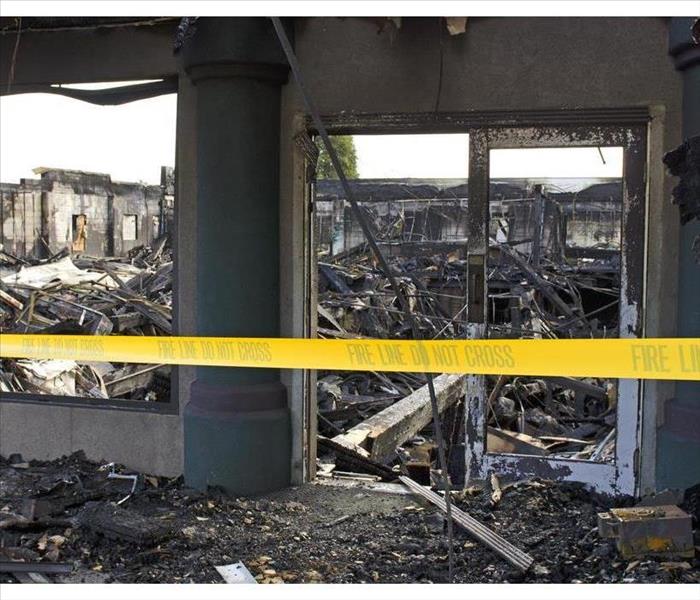 Commercial fire damage in Star Prairie, WI.
Commercial fire damage in Star Prairie, WI.
Why Does Your Company Need Fire Insurance?
In order to keep your Star Prairie, WI, business running smoothly, your commercial building and property must consistently be in good condition. Factors such as fire damage can wreak havoc on your building and prevent your business from functioning at its best. Investing in fire insurance can help comfort you during a difficult situation and provide your business with an extra layer of security. Here are some of the major benefits of buying insurance to protect your business from fire loss.
Covers Damage
A key advantage of having insurance for your commercial building is that it provides coverage for various types of fire damage. Property damage and loss may be caused by factors such as:
- Flames
- Smoke
- Water
- Powders (from firefighting efforts)
The damage from these sources and others can add up and make fire restoration a more difficult job. Being insured helps to ease part of the process.
Takes Care of Costs
Without fire insurance, the many costs of fire repairs and smoke cleanup may become overwhelming. In addition to repairs, you will have the responsibility of paying for fire department service fees on your own if you aren’t insured. This responsibility can seriously harm your business if you aren’t able to pay for all the costs that are included. Having insurance takes this financial burden off your shoulders.
Gives You Peace of Mind
Dealing with the aftermath of a fire can be an incredibly stressful situation. The last thing you need to worry about is how to cope with the costs of loss and damage to your commercial building. When you have insurance to carry the financial weight of your fire damage, the process of fire restoration can go much more smoothly.
Investing in fire insurance is only the first step towards recovering from a fire in Star Prairie, WI. Be sure to call a professional for a fire damage assessment in order to have your business restored as soon as possible.
You Should Not Wait for the Insurance Adjuster if You Have Storm Damage
5/24/2022 (Permalink)
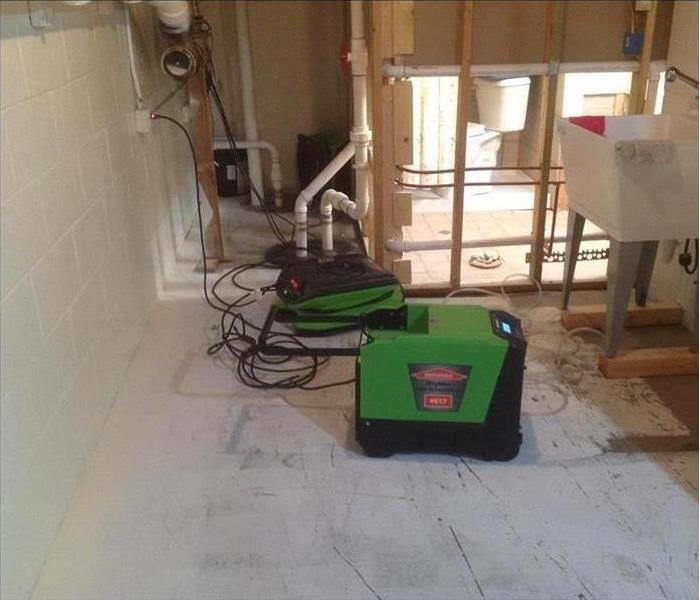 Restoration services in Hudson, WI.
Restoration services in Hudson, WI.
If you are dealing with storm damage in Hudson, WI, one of the first things you should do is call your insurance company. Depending on the type of damage, ask if you have flood insurance or the type of coverage necessary for repair and restoration. After filing a claim, you will be assigned an adjuster to come and estimate the damages. However, you should not wait for the adjuster, as he or she is probably busy dealing with other homeowners and their storm damage, and the longer you wait, the more damage your house will take on.
Types of Damage that Can Occur If Too Much Time Passes
A number of unwanted consequences can occur if you wait too long to start the restoration process. Depending on the type of storm, these may include:
- Mold damage from standing water
- Multiplication of contaminants like bacteria or chemicals
- Further structural damage
- Swelling of furniture and drywall
- Odor buildup
To start the process right away, call a professional storm and flood damage restoration company. These professionals know exactly what steps to take to minimize damage and prevent future issues.
Document Losses and Costs for Flood Insurance Reimbursement
Even if you get the restoration process started before you meet with the adjuster, you can still do things to improve your chances of reimbursement. Document and take pictures and videos of damaged structures and personal items. Keep all receipts related to the repair and restoration of the damage as well as the estimation from the restoration company.
When you are dealing with flood insurance or other storm damage coverage, the adjuster may not always be able to get to you right away. Even when this is the case, do not wait to begin the restoration process, as the quicker you get started to clean up water and other hazards, the better the outcome.
3 Ways That SERVPRO Serves Adjusters and Their Clients
5/12/2022 (Permalink)
 SERVPRO of The Saint Croix Valley offers a response service that is available 24/7.
SERVPRO of The Saint Croix Valley offers a response service that is available 24/7.
SERVPRO Helps Adjusters and Their Clients in Three Ways
An insurance adjuster for business owners in Hammond, WI, collaborates with a variety of professionals to assist clients, including commercial remediation specialists. These companies work with the owners and the adjuster to effectively repair properties after a disaster. However, one of these organizations stands out among the rest. SERVPRO goes above and beyond in serving agents and their clients through various methods.
1. Fast Response
Disasters can occur or manifest at inconvenient times. The insurance client might notice a leak right before the weekend or a fire could ravage a building in the middle of the night. A strong restoration company offers a response service that is available to business owners 24/7 and deploys experts in a matter of hours. Fast emergency repair helps the business recover fast and it reduces the insurance claim expenses, benefitting both the adjuster and the client.
2. Detailed Information
The information regarding commercial damage is important since it helps both the client and the insurance adjuster make the best decision regarding the case. SERVPRO has a claims information center that collects and organizes information in a way that is useful to the insurance agent. It provides a job file that includes photos, detailed descriptions and paperwork, as well as job costs and industry-standard comparisons. Agents can request this information in both physical and electronic copies.
3. Pretesting Process
Adjusters prefer to restore property and objects instead of replacing them, as the latter is more expensive. The best way to measure restorability is to have a remediation company run pretesting on the affected area and belongings. In addition to determining what can be salvaged or replaced, the process provides information to both the technicians and the adjusters. They can see what equipment and methods they need for the best results and the estimated costs of the procedure.
The right remediation company can make the repair process beneficial to both the insurance adjuster and the establishment owner. SERVPRO provides these services and more to successfully help both parties.
Commercial Storm Insurance: What Does It Cover?
5/4/2022 (Permalink)
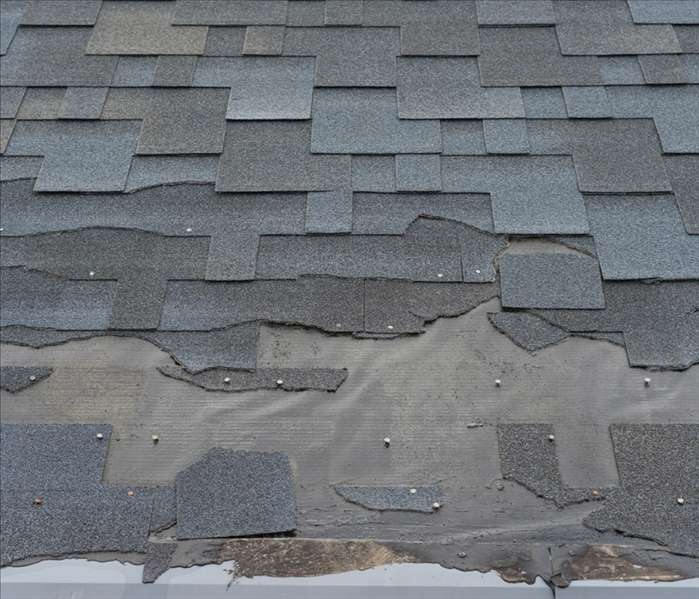 Wind cause missing shingles in this roof.
Wind cause missing shingles in this roof.
What Commercial Storm Insurance Covers?
Are you a Glenwood City, WI business owner who wonders what commercial storm insurance actually covers? It is important to understand your coverage in order to be prepared for an emergency if it should occur. Here are three things that are covered by most policies in addition to damage to your actual building itself.
1. Wind damage. If your area is particularly prone to windstorm issues, you will be happy to learn that most wind-related storm damage is covered by commercial insurance. Remember to keep records of any damage directly caused by wind, such as pictures and receipts from repair work.
2. Theft and Vandalism. Unfortunately, criminal acts can become a concern when dealing with storms and similar disasters, so most policies will cover both vandalism and theft that can affect your building as a result of a storm.
3. Business equipment. If your supplies, furnishings, office fixtures and other equipment are damaged during bad weather, most storm insurance policies will cover it.
Keep in mind that damage from floods, earthquakes and hurricanes may not be a part of your standard insurance coverage without an added rider. Talk to your insurance agent about including these coverages to better protect your business and your investments.
Getting Help After a Storm
If you ever find yourself facing storm-related damage at your business, wait until the weather dies down to seek help. Then, call a trusted commercial storm damage company in the Glenwood City, WI, area for assistance with cleanup and remediation. While you may feel the urge to take matters into your own hands, it is better for you, your business and your insurance claims to get help from trained technicians who know what to do in such a situation.
Storm insurance and storm damage, in general, can be hard to navigate for even the savviest of business owners. Talking to your insurance agent and other knowledgeable professionals can help take some of the burdens off of you and put you in a position to take control after a storm.
How To Prepare Your Business For Hail Damage
4/23/2022 (Permalink)
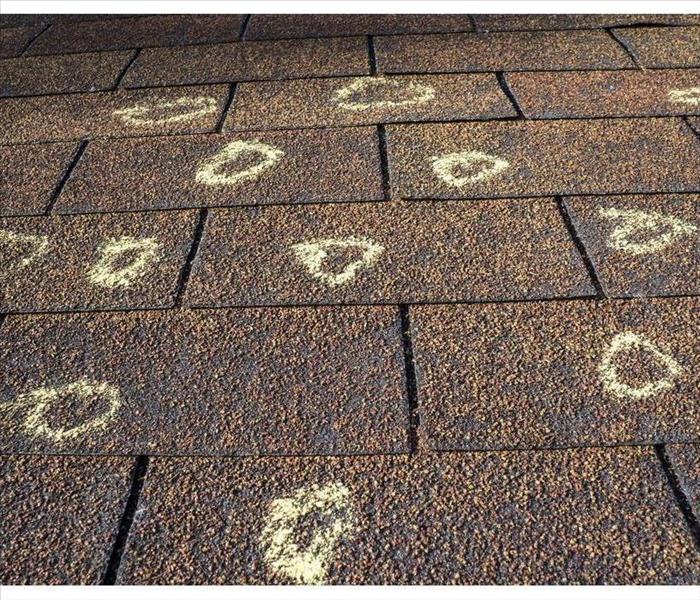 Regular maintenance can help prevent severe roof damage.
Regular maintenance can help prevent severe roof damage.
Owning a business comes with many responsibilities, not the least of which is maintaining your commercial property. Along with regular building maintenance, have a plan in place in case of natural disasters, such as hail storms. Here are a few things you can do to prepare for possible hail damage.
Know the Common Types of Hail Damage
Think through potential types of damage so you can make sure you have each one covered. Here are a few common types:
Roof Damage: This is a very common area of hail damage. Be sure to have your roof regularly inspected and repaired, especially after a hail storm. Regular maintenance can help prevent severe roof damage.
Glass Damage: If you have skylights, be sure that they are impact-resistant. Windows can be at risk too, depending on the angle of the hail coming down. Consider using impact-resistant glass here as well.
Property Damage: Hail can also cause damage to the property surrounding your building. This could include trees, HVAC units, or even commercial vehicles kept on your property.
Make Sure You are Covered
Once you have reviewed potential sources of storm damage, make sure that you have adequate commercial property insurance. This type of insurance will cover the financial impact of storm-related damage, which is an important protection for the financial health of your company. In the event of storm damage, initiate a claim with your insurance company and request authorization for a Roberts, WI, storm damage company to come in to do repairs. You don't want to be left with roof damage or other property damage impeding your ability to get back to business.
Protect Employees
Have an emergency plan in place to make sure employees stay safe in the event of a hail storm. Designate a gathering area safely away from windows, and communicate a procedure to follow with your employees. Consider practicing emergency drills.
No one wants to think about their business suffering storm damage, but early preparation can save a lot of hassle in the event of damaging hail. Make sure you have your bases covered to protect your property, your employees and your hard work.
What Is a Preferred Vendor?
4/13/2022 (Permalink)
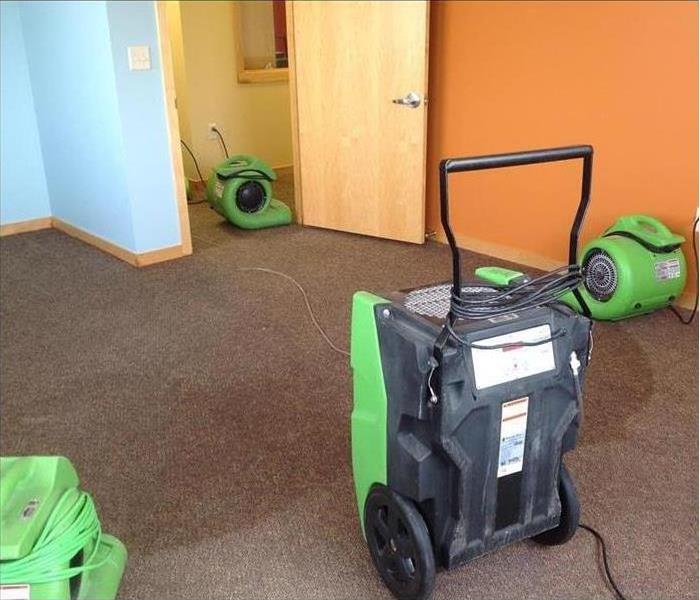 Office drying in Bay City, WI.
Office drying in Bay City, WI.
With a big commercial disaster claim, there’s often a lot on the line. Everyone involved, from the property manager to the business owner to the commercial property insurance agent, has an interest in making sure that the restoration work is completed competently, on schedule, and at a fair price. In many cases, this is most easily accomplished by using the insurance company’s preferred vendors.
What Is a Preferred Vendor?
Insurance companies have extensive experience handling disaster-based claims and working with various disaster recovery companies. Over time, some restoration companies begin to stand out as consistently delivering quality work and reasonable estimates on time. Insurance providers often designate such restoration companies as “preferred” vendors.
How Does a Preferred Vendor Program Work?
Most commercial insurance companies have some sort of process for selecting vendors for preferred status. Typically, these vendors must meet exacting guidelines for quality and performance to be selected as preferred vendors. Insurance companies ordinarily monitor these vendors to ensure that they continue to consistently meet these standards and maintain compliance with all requirements. For an insurance agent, working with a preferred vendor usually means a shorter turnaround time for approving estimates, since the vendor’s billing practices have already been approved by the insurance provider.
How Does SERVPRO Ensure Compliance?
SERVPRO is not only one of America’s largest restoration companies, but also has some of the industry’s highest internal performance standards. Every franchise must comply with 21 different performance guidelines, covering such matters as:
- minimum insurance requirements
- employee background checks
- bookkeeping and data reporting procedures
- equipment training and maintenance
These extensive requirements help ensure that every franchise continues to live up to the company’s high standards for quality and professionalism.
In the aftermath of a disaster in Bay City, WI, working with a respected and reliable preferred vendor typically makes things easier for the assigned insurance agent. The result is that restoration begins sooner, which is good news for the property owner as well.
Buying in a Flood Zone: What To Do
4/6/2022 (Permalink)
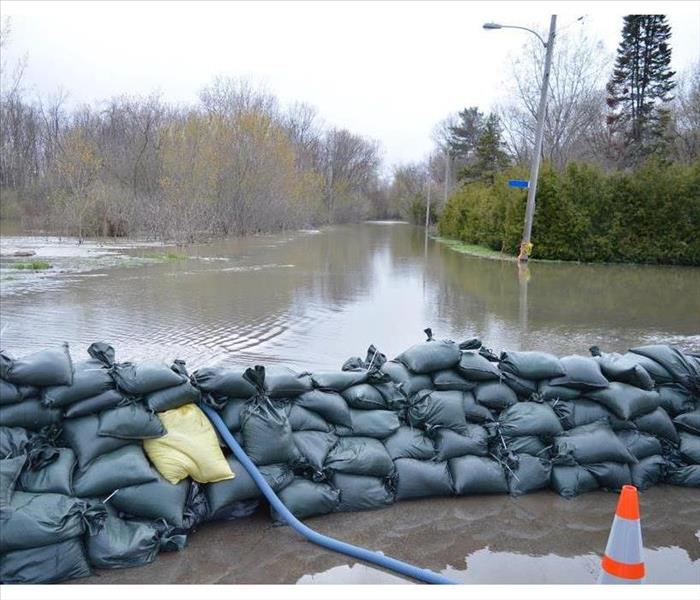 Remember that even homes outside of a flood zone can suffer from floods.
Remember that even homes outside of a flood zone can suffer from floods.
Flood Zones
Are you planning to buy a home in the Prescott, WI, area that falls within a flood zone? There are a few things you should do to prepare so you can better protect your finances and potentially your future property. Here are four steps to take to better inform yourself about flood zones and figure out if you really want to live in a high-risk area.
1. Estimate flood insurance costs. When you live at a location that has a high risk of flooding, it is very common for flood insurance to be required - sometimes by the federal government. Get a few quotes before you buy the home, and make sure to ask for any discounts that you may be eligible for. You will also want to ensure that federal coverage is not required.
2. Learn the home’s exact zone. Some areas of a flood zone are considered lower risk than others. Make sure to find the FEMA map for your area to know exactly what kind of risk you are dealing with. Additionally, your home may need to be re-categorized if it was mapped out a long time ago.
3. Get an elevation certificate. It is possible that an elevation certificate will be required if you purchase a home within a high-risk zone. Such a certificate can also help you further gauge the probability of a bad flood at or near your house.
4. Know your local remediation service. If you should suffer from a damaging flood, you will want professional help to have the best chance of restoring your property. Find out what your most trustworthy local storm damage service is so you have reliable cleanup aid in the event of a disaster.
If you are getting discouraged by the prospect of living in a high-risk area, remember that even homes outside of a flood zone can suffer from floods. After following the steps above, you will be better able to understand what you are getting into before making the serious commitment of home ownership.
3 Ways To Fix a Toilet That Keeps Flushing
3/30/2022 (Permalink)
 Toilets that are not connected to flushometers may keep running for different reasons.
Toilets that are not connected to flushometers may keep running for different reasons.
Three Ways To Fix Toilet Overflow
Commercial toilets run the risk of problems that may cause continued flushing. The underlying cause of this problem may be determined by the setup of the bathroom facilities at a building in Baldwin, WI. Here are three ways to fix toilet overflow problems and reduce the added cost and risk of a toilet flood associated with this plumbing issue.
1. Fix the Flushometer
A commercial structure may rely on a flushometer to eliminate waste from toilets or urinals. These systems are either manual or automatic. If facilities equipped with this technology start running continuously, it may be necessary to clean or replace the gasket of a manual flushometer or the diaphragm kit of an automatic model.
2. Check the Internal Components
Toilets that are not connected to flushometers may keep running for different reasons. A flapper may not seal properly and could require replacement or fill tube adjustments. A fill valve leak might also be the cause of the problem. These repairs are relatively easy for amateurs to complete, but a building owner or manager can also schedule expert repair and water damage restoration.
3. Call a Plumber
If the owner or manager of a commercial building cannot stop a toilet, it is time to contact a plumber. Repairs should ideally take place prior to a toilet overflow. If a facility has already become flooded, shut off the water supply and try to extract as much standing water as possible with a mop or wet-dry vacuum.
Whether the bathrooms in a commercial building are equipped with flushometers or have standard designs, these measures can stop water from continuously running through a toilet and reduce the risk of a toilet overflow. These fixes may be done by the owner or manager of a building in Baldwin, WI, or it may be worthwhile to rely on a plumber to prevent water damage.
Steps To Clean Smoke and Soot after a Fire
3/21/2022 (Permalink)
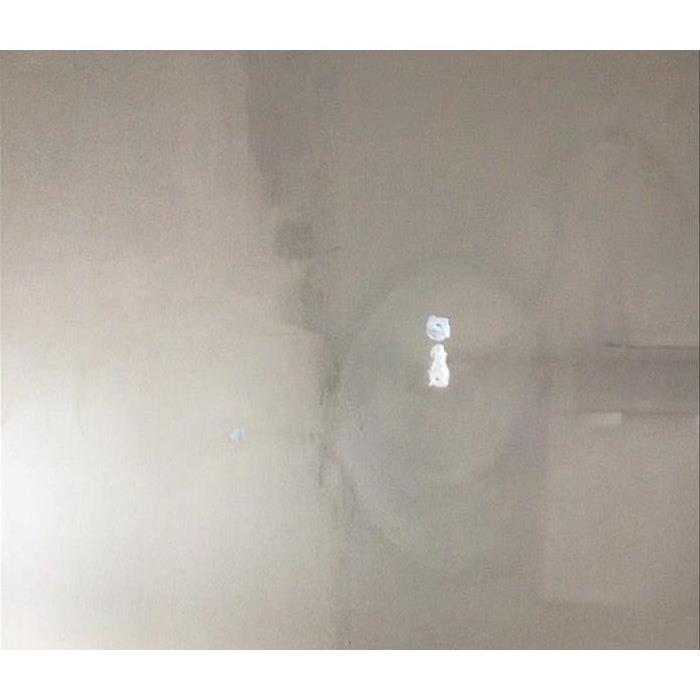 Soot damaged wall in a New Richmond, WI home.
Soot damaged wall in a New Richmond, WI home.
Minimize Smoke Damage In Your Home
A fire can be a disastrous experience to endure, and the destruction can be devastating. Extinguishing the blaze is only the first step toward recovery, and you will need to move quickly to begin the cleanup process to avoid incurring even more losses. If your home in New Richmond, WI, has been damaged by fire, follow these steps to sanitize your residence and minimize smoke damage.
Make a Plan
You will need to decide whether to tackle the cleanup process on your own or call in the professionals. Consider a few factors to help you make the right choice.
- Size of the fire
- Type of fire
- Exposure Time
If you’re dealing with a large fire that means that damage from soot and smoke can be intensive. The types of materials that were burned can also play a role in the level of difficulty in restoring your home. The length of time your belongings have been exposed to smoke is also important, and the more time passes, the more complex the cleanup can be.
Ventilate the Home
Open all the windows and doors as soon as possible after smoke damage and use fans to increase the airflow. You may even need to remove window screens to maximize the amount of fresh air inside.
Clean and Deodorize
All fabrics and upholstery may need to be washed or dry cleaned to remove lingering odors. All solid surfaces can be to be sanitized, and your HVAC will likely need attention, as well. This can be a long and tedious endeavor, but it’s essential to clean everything thoroughly to reduce smoke and soot damage.
Repaint the Walls
It may be necessary to apply new paint to the walls of your home to ensure proper smoke cleaning. Be sure to wash the walls first, and let them dry completely.
If you don’t feel prepared for the task of cleaning and sanitizing, or your problems are persisting, contact a fire restoration service to help you avoid soot and smoke damage and return your home back to normal.
How the Pros Clean Electronics After a Fire
3/15/2022 (Permalink)
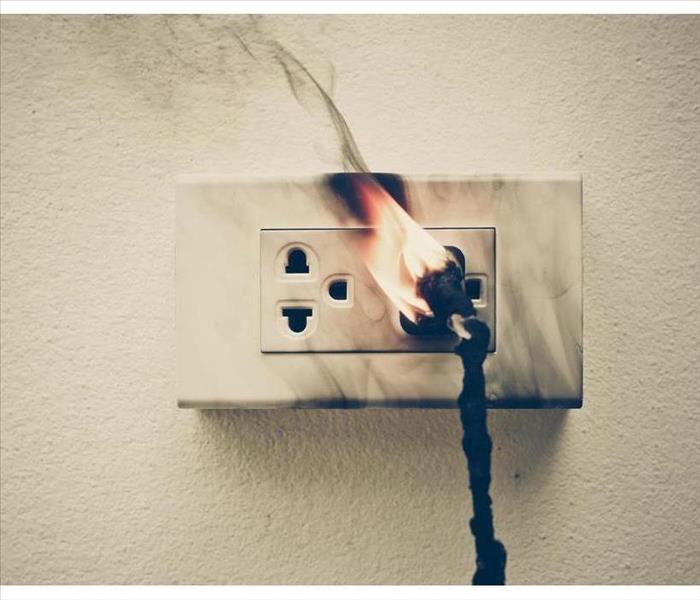 Electrical fire in River Falls, WI.
Electrical fire in River Falls, WI.
How To Clean Electronics After a Fire
If you're like many businesses, you rely on electronic equipment at work each day. Without dependable devices such as computers, printers and servers, you would not be able to communicate effectively, meet customers' demands or keep up with competitors in a demanding, fast-paced environment. It's no wonder an electrical fire in your building would cause so much concern. Fortunately, there are ways River Falls, WI, companies can salvage and even repair your electronics following a fire.
How They Start
It's helpful to know how these fires can start so you can put safeguards in place to help prevent them. An electrical fire is largely preventable if you are simply aware and use equipment properly. Here are some causes of these situations:
- Faulty outlets
- Old, run-down equipment
- Circuit overloading
- Running cords under rugs or carpet
- Keeping cords too close to heat sources
Call in the Pros
If a fire damages your electronics, or if you know you need to address computer cleanup, get in touch with a trusted electronics cleanup company. Unplug the equipment and don't attempt to turn on anything. The specialists will come to your office and assess the severity of the problems and the extent of the damage. These companies have the right experience, tools and methods to safely clean and restore your items without posing the risks of ruining them. The team will be sensitive and will handle everything with care.
The Process
To combat issues such as smoke damage, the technicians will start by wiping down the equipment with a soft cloth. Next, a crew member may use compressed air to blow dust and other debris out of motors and ports. The company will handle everything carefully, as the items may be fragile.
A professional company is accustomed to repairing and cleaning up devices after an electrical fire. As distressing as this ordeal may be, you can have confidence that you can use the electronics once again when you enlist the help of a cleanup specialist.
3 Helpful Things To Know About Flood Insurance
2/28/2022 (Permalink)
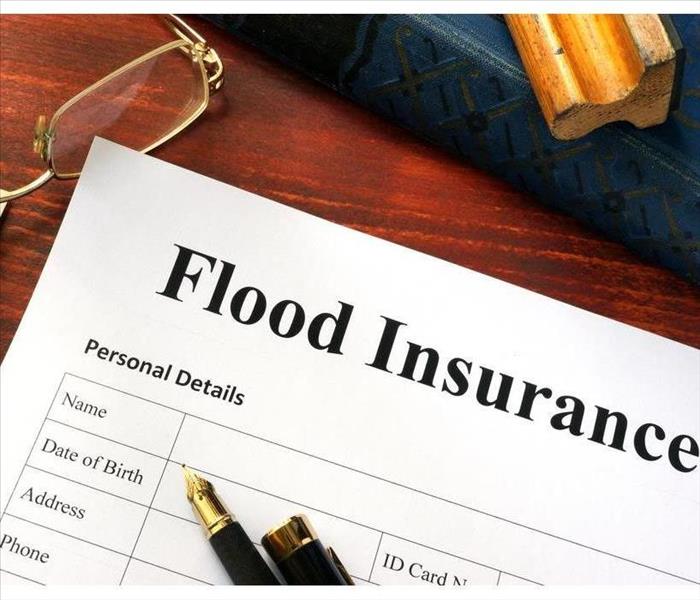 Flood insurance is a good choice for your property.
Flood insurance is a good choice for your property.
Flood Insurance
When looking at commercial insurance policies for a Hudson, WI, business, many company owners may be wondering if flood insurance is a good choice for their property. Here are a few things to consider.
1. What May Be Covered
In most cases, a flood policy will cover damage caused by nature or accidents. This usually includes incidents such as a broken pipe or sewer backup, along with rain overflow and other storm damage. It is the policy holder’s responsibility to know exactly what their plan covers, but most normal flooding falls under these categories. In many cases, the insurance provider may also cover the cost of repair and cleanup, as well as recommend a professional restoration service.
2. What May Not Be Covered
Many commercial insurance policies will not cover flooding that comes as a result of neglect. This means that if you knew one area needed repairs, you failed to take action, and flooding occurred as a result, then your insurance provider may decline coverage.
3. What a Restoration Company Can Do
Insurance providers may have recommendations for a restoration company that may be able to help. A professional restoration service is equipped to help with large-scale disasters according to FEMA guidelines. They also offer services such as electronic inventory management system, which can be used to document items and repair requirements as they go. The database can be updated by the restoration team and accessed by the insurance agents allowing them to have the most up-to-date information as they keep track of the claim.
When looking at their commercial insurance policy, it's up to the policyholder to know what exactly is included. In most cases, flooding caused by accidents or natural disasters will be covered. Flooding caused by neglect, however, probably will not. A professional restoration team may have the tools necessary to work with the insurance company in order to help process the claim and keep all required information updated.
Fire Cleanup 101: Always Throw Away These Three Items When Damaged by a Fire
2/26/2022 (Permalink)
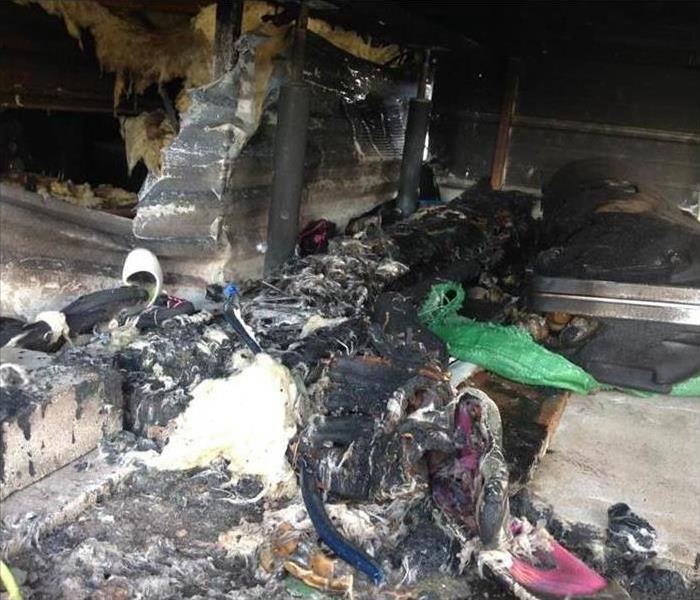 After a fire, you should throw away any damaged food, medicine, or cosmetics.
After a fire, you should throw away any damaged food, medicine, or cosmetics.
Items To Throw Away After a Fire
A house fire is a devastating experience that everyone hopes to avoid. However, if a fire does occur in your home in Hammond, WI, you likely are wondering what items can be restored by a fire cleanup company and what items you will need to throw away. Fortunately, many of your most valuable possessions and important documents can be repaired from damage caused by fire and smoke. However, there are three items that you should always discard if they have been anywhere near the fire.
Food
All food items that have apparent fire damage are unfit for human consumption. If the fire happened in another part of the house, there might be a chance that your food was unaffected. However, you will need to observe your food because high temperatures and power outages can also be an issue. Here are some signs that you need to throw away your food items:
- Rusted or bulging cans
- Charred food
- Smoky smell inside the refrigerator
- Food in the freezer no longer frozen
- A foul smell before or while cooking
Medicine
If you have any medicine in your home, you will need to consider if it is at all possible it came into contact with high heat. If so, immediately throw it out! Medicines that are exposed to temperatures in the mid-80s or higher can lose their effectiveness. Also, some types of medicine can cause serious damage to your organs if they’ve experienced any kind of decay.
Cosmetics
Hazardous chemicals can easily make their way into any cosmetics that you may have, and extreme heat can even completely alter their chemical composition. Do not apply any makeups or hygiene products that have signs of either fire damage or soot stains to your skin to avoid irritation.
While you may want to preserve whatever you can after a fire, you’re better off making the decision to throw away any damaged food, medicines, or cosmetics to avoid effects that could impact on your health!
How to Keep Pipes Safe During a Freeze
2/21/2022 (Permalink)
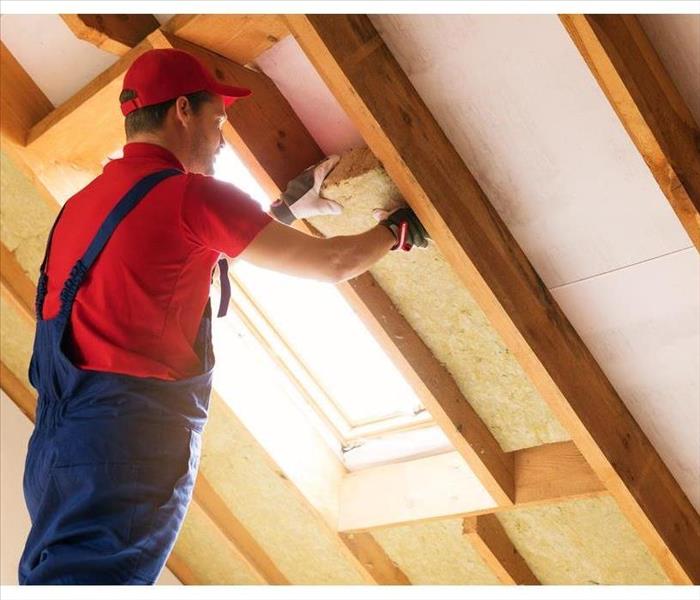 Adding insulation to your attic can keep the temperatures safer for pipes.
Adding insulation to your attic can keep the temperatures safer for pipes.
How to Prevent Pipes from Freezing During a Freeze
Winter can be a beautiful and festive time of year. However, if you don’t adequately prepare your home, the freezing temperatures of winter can cause frozen pipes that burst and flood your house. If that happens, you could end up needing professional restoration services and water line repair. Here are some of the most vulnerable pipes:
- Outdoor pipes for pools and sprinklers
- Units in basements
- Pipes in attics and garages
- Units under kitchen and bathroom cabinets
Avoid frozen pipes in these areas with a few steps.
Drain Outdoor Lines
If you have a swimming pool or a sprinkler system, follow the manufacturer’s directions for draining the supply lines before a freeze comes to Roberts, WI. You may be tempted to use antifreeze in these outdoor areas, but such chemicals can be harmful to the environment, your yard, your animals, and your children.
Insulate Indoor Areas
Pipes in basements, attics, garages, and crawl spaces freeze because these areas aren’t always well insulated. While the rest of your house may be comfortable when the weather is cold, these areas can see below-freezing temperatures. Adding insulation in these parts of your home can keep the temperatures safer for pipes.
Protect Cabinets
The pipes in your kitchen and bathroom cabinets can get too cold because your heater doesn’t affect the air around them. You can use heat tape or a similar product to keep these pipes safe from freezing temperatures. You may also consider a pipe sleeve. If a sudden freeze is coming and you don’t have these products, you can wrap the pipes in a newspaper and keep the cabinets open.
If you do end up with frozen pipes that burst, be sure to turn off the water supply to the pipe and secure the area. Then, you can call a professional restoration company to fix the damage. Doing so can help keep mold and other damage at bay.
Storm Preparedness Tips for Business Owners
1/31/2022 (Permalink)
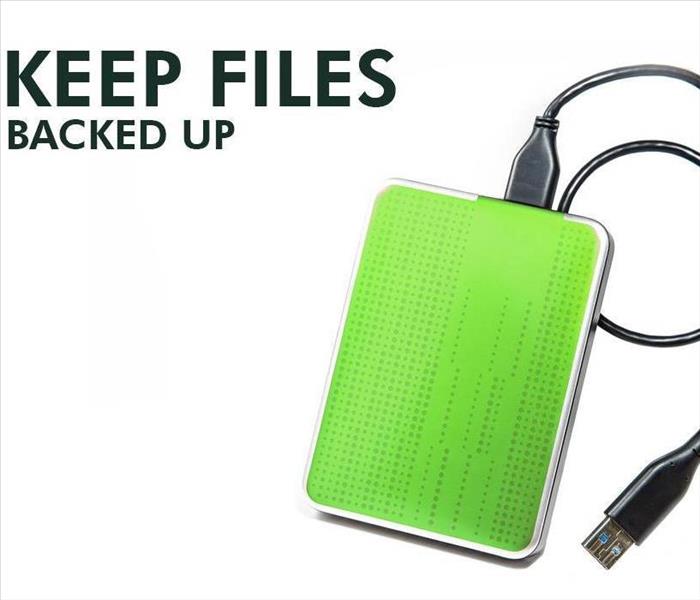 Make sure to back up important files.
Make sure to back up important files.
Storm Preparation Tips
Any commercial property owner in Bay City, WI, knows that hurricane damage is devastating. Even businesses further from the coast are susceptible to the impact of high winds and severe storms. Unfortunately, you cannot prevent Mother Nature from inflicting mayhem. Here are some storm preparation steps to protect yourself and your investment.
Have a Safety Plan
In an emergency, the priority is the safety of your employees and yourself. Prepare ahead of time by setting and practicing evacuation and shelter-in-place procedures. Always have these items accessible:
- Fire extinguisher
- Basic tools, including flashlights
- Emergency numbers
- First aid kit
- Bottled water and non-perishable food
- Blankets
Protect Important Records
Hurricane damage can involve high winds and flooding. Water may destroy papers and electrical equipment, such as computers. Prior to a storm threat, take the time to safeguard critical business documents.
• Back up data files regarding employee records, tax information, insurance policies, customer information and inventory. Keep backed up material secure at an off-site location.
• When possible, house on-site paper records in water- and fire-resistant containers.
Prepare Your Structure
During a hurricane, winds can blow at speeds of 74 mph to 215 mph. It is difficult for a building to withstand such weather. Before a tropical storm or another event, put measures in place to prevent and mitigate damage, should it occur.
• Maintain the property year-round. Have the roof inspected and clear overgrown foliage.
• When a storm is imminent, board the windows, move electronics and valuables to a higher floor, sandbag the area and secure furniture.
• After the weather event has ended, contact a storm restoration specialist as soon as possible to evaluate the damage and begin the mitigation and restoration process.
Hurricane damage at your business in Bay City, WI, can be devastating. However, you can minimize the impact by being prepared. Have a safety plan, protect your documents, stormproof your property and contact a restoration professional immediately in the aftermath.
What You Need To Know About Contaminated Water
1/31/2022 (Permalink)
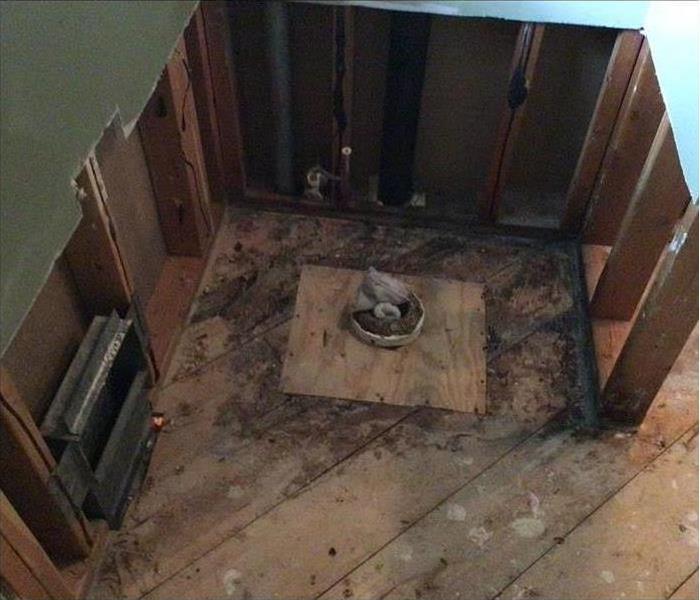 Supply line leak causes severe water damage.
Supply line leak causes severe water damage.
The Classifications Of Flood Water
After a flood, there’s a lot to do, and there’s a lot to know. Before you can even touch on the cleanup process, it’s important to understand the classifications of flood water. The process that you or your restoration specialist will have to undergo may vary between the three classifications.
Category 1
Category 1 water is considered clean water, which is not a threat to you or your family. It does not carry any harmful bacteria or pathogens. For instance, this water can include:
- Broken water lines
- Toilet holding tanks
- Melted snow
- Rain water
Because category 1 is not contaminated water, it can be cleaned easily. Also, if clean water dries out quickly, it should leave little to no damage.
Category 2
Category 2 is called gray water, which may have some chemical contamination. For instance, dishwashers and washing machines may leak soapy water and biological matter. Most gray water comes from these appliances, but also sinks and aquariums.
Category 3
The final category is severely contaminated water. Gray water can become black after 48 hours. Unlike clean water that may come from the supply line, category 3 water carries bacteria and pathogens. Often sewage or outside water falls within this category. While you should always act in haste after a flood, you have to be particularly fast and careful with this type of polluted water.
Flood cleanup can be a difficult time for anyone. However, in order to make the most out of your cleanup and to stay safe while working, you should keep in mind the classifications of flood waters. Category 1 is relatively harmless, while category 3 contaminated water can cause serious damage to your Roberts, WI, home. However, after any flood, it’s imperative to work on cleanup efforts as soon as possible.
Renter’s Insurance and Mold – What You Should Know
1/31/2022 (Permalink)
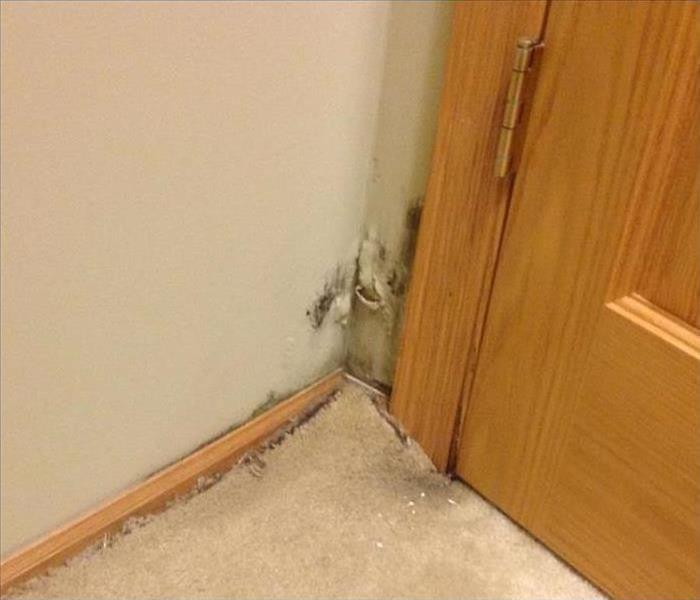 Black mold growth in Hammond, WI.
Black mold growth in Hammond, WI.
Whether you rent or own, hearing that you have mold in your home can be especially stressful. If you’re in an apartment, one of the first things you may wonder is if your rental insurance will cover any damage and removal. This can be a tricky question depending on the policy. Here are a few pointers to help you know when to expect a policy to cover damage to your Hammond, WI apartment, and when you shouldn’t.
What Renter’s Insurance Covers
Many apartment buildings require tenants to carry renter’s insurance as a prerequisite for renting. It’s designed to protect the landlord but also the tenant by covering things like
- Clothing
- Furniture
- Electronics
It can also cover other personal belongings inside an apartment. That’s a broad concept, however, and it can be especially hard to maneuver when it comes to mold.
When Rental Policies Do Cover Mold
Rental insurance does cover damage from mold, but only if it’s the result of a situation that is already covered under the policy. For instance, if your policy covers burse pipes, and one leads to mold damage in your apartment, you should be covered. The same is true for fire, wind, etc. as long as it’s under your policy and is directly related to the mold.
When Rental Policies Don’t Cover Mold
An important exception to mold coverage is related to floods. Many times, renters need separate flood policies. If your policy doesn’t cover flood damage, and mold is a result of floodwaters, you won’t likely get coverage. Also, if mold is a result of your own negligence, you can’t tap into your policy.
Rental insurance can be a huge lifesaver, but only if it covers your particular crisis. Check with your insurance carrier to confirm coverage and call a mold removal specialist to get rid of the mold in your apartment as soon as you spot it.
How To Mitigate Water Damage
12/30/2021 (Permalink)
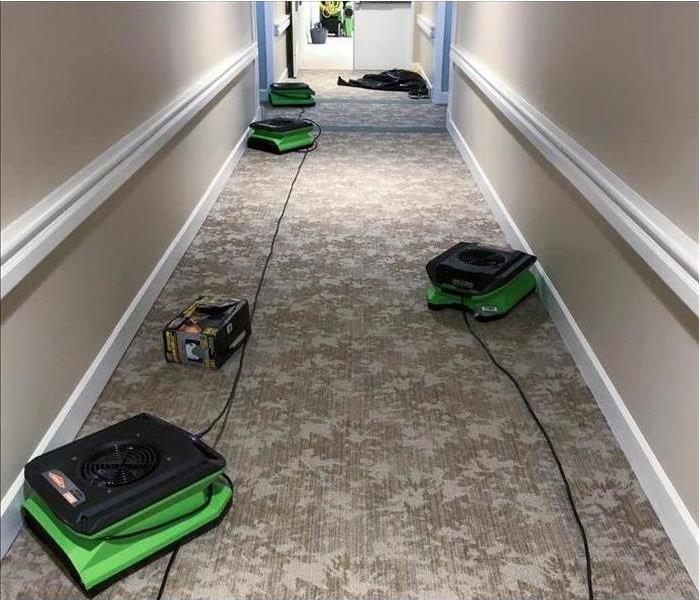 Dry the area regardless of the category of water damage.
Dry the area regardless of the category of water damage.
Water Mitigation
Mitigation should begin as soon as a property owner or manager notices signs of water damage. Whether you discover a supply line leaking or you need a pipe burst cleanup, these water cleanup measures can limit the severity of damage.
Address the Cause
Damage is likely to worsen until the cause is fixed. Take the following mitigation measures:
- Turn off the water supply
- Collect water in containers
- Contact a plumber
These steps can limit the severity of water damage. Once the problem is fixed, cleanup can proceed.
Remove Standing Water
Water left standing will damage contents. Depending on how much water is present, you may need to use towels and a mop, a wet vac, or a pump. If you do not have equipment capable of handling a pipe burst cleanup, contact a water damage cleanup service. Mitigation professionals can quickly address primary and secondary damage.
Clean and Disinfect
It may be necessary to clean or disinfect the damaged area. The treatment required depends on conditions where the leak occurred and the category of water damage. You will need to
- Dry Category One damage
- Clean and disinfect Category Two damage
- Clean and disinfect Category Three damage
Category One water is clean and treated. Category Two gray water is contaminated but does not contain solid waste. Category Three black water is highly contaminated and may contain sewage.
Dry the Area
It is necessary to dry the affected area regardless of the category of water damage. You may use air movers, dehumidifiers, or fans. This equipment will promote faster drying and draw moisture out of porous surfaces. Drying can limit the severity of water damage.
The owner or manager of a commercial property should fix the cause of water damage as soon as possible. If pipe burst cleanup or other major mitigation measures are necessary, hire a water cleanup service located in Star Prairie, WI.
3 Steps for Home Flooding Recovery
12/17/2021 (Permalink)
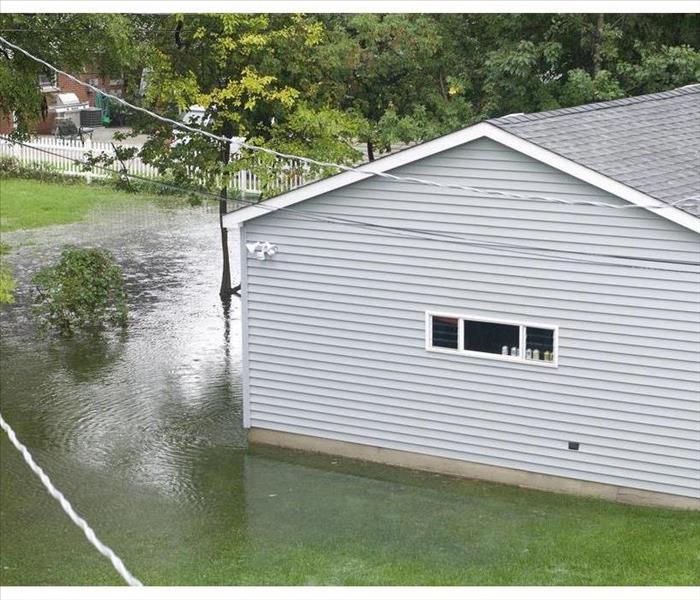 Floodwater in a home.
Floodwater in a home.
Home Flooding Recovery
The damages left behind by floodwater in-home settings can be extensive and leave an emotional toll behind as well. This is true whether the water damage resulted from rising waters after prolonged rain or a broken pipe. After flooding recedes, most people want to get back to their normal lives as quickly as possible, but the full recovery from the situation may take a long time. Breaking recovery tasks into orderly chunks may help the process move along more smoothly.
1. Contact Your Insurance Company
Talk to your insurance agent about the terms of your flood insurance. The agent may recommend certain water damage restoration professionals in Glenwood City, WI. Be prepared to share contact information, such as the phone number and address of where you are staying during the recovery process. Discuss steps such as keeping photographic evidence of the damages and holding onto damaged materials as proof of your losses.
2. Maintain Safety
Water in the home and electricity make a dangerous combination. Make sure you shut off the electricity to the home before attempting any repairs or cleanup. Ask professionals about whether it's safe to enter the residence to avoid injuries from gas leaks or fire hazards. Remember to practice basic safety procedures.
- Wear sturdy work gloves and protective hand and eyewear.
- Consider wearing a respirator.
- Don't mix cleaning chemicals, such as chlorine bleach with ammonia.
- Watch out for pests, such as snakes and mice.
3. Separate Belongings for Professional and DIY Cleaning
You may be able to hose off or rinse out many of your belongings. Some items, such as clothing, can be cared for at a dry cleaning shop. However, many furnishings, such as carpets or upholstered couches, will require specific professional care. Water damage restoration professionals have the right tools and training to clean without causing further damage and will take steps to prevent long-term damages, such as mold.
Remember, after floodwater in-home settings recedes, contact Glenwood City, WI, professionals, ensure safety, and then set aside tasks for professionals. Working methodically through recovery helps get things back to normal more quickly.
Dryer Maintenance 101
12/6/2021 (Permalink)
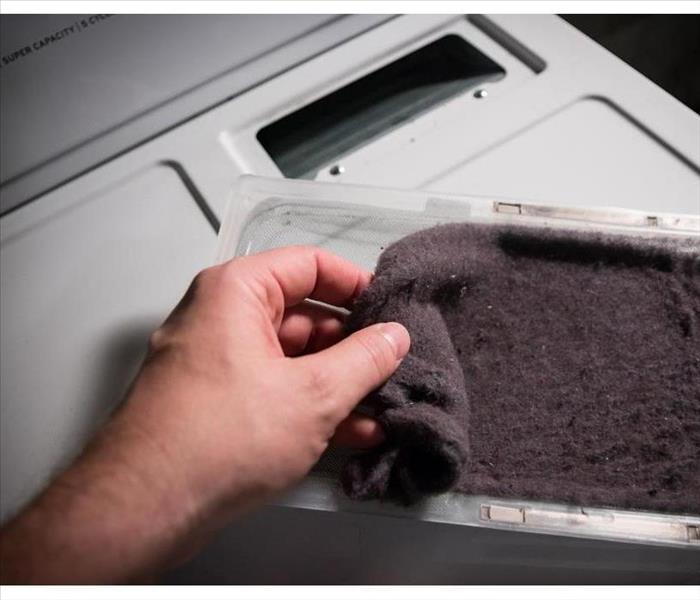 Cleaning your dryer regularly may help you avoid a potential lint fire.
Cleaning your dryer regularly may help you avoid a potential lint fire.
Dryer Maintenance Tips
Around 2,900 dryer fires occur each year including incidents in Prescott, WI. If you’re concerned about protecting your home, proper dryer maintenance is one important step toward lint fire prevention. Here are some maintenance tips you may want to know about.
1. Observe Dryer Safety
One way to avoid a dryer fire is to observe dryer use safety recommendations. These include things like not overloading your dryer, not letting it run without someone in the house, and ensuring that it’s off before you head to bed. It’s also important to never put flammable materials inside the dryer. These include rags or clothing that may have come into contacts with substances such as grease, alcohol, paint, or gasoline. Items containing rubber such as potholders, bathmats, or footwear will come with washing instructions that should be observed as well.
2. Clean Your Dryer Regularly
Cleaning your dryer regularly may help you avoid a potential lint fire. It’s easy to remove the lint from the lint screen after each use, but your dryer should be deep cleaned at least once a year. Depending on your dryer use frequency you may want to clean it as soon as every three month. After unplugging the dryer, you can vacuum out the lint trap, clean the exhaust hose and exterior vents, and in most cases remove the back panel to clean out any accumulated lint inside the machine.
3. If Issues Persist, Contact a Professional.
If you’re experiencing problems with your dryer it’s best to contact a professional to service the machine. If you do experience a dryer fire, then a fire damage restoration professional may be able to conduct repairs and restore your home to its pre-fire state.
Proper dryer maintenance may help prevent a lint fire in your home. Always observe the manufacturer's instructions when drying items and avoid leaving a running dryer unattended. If your dryer is malfunctioning it’s best to contact a professional for repairs.
Don’t Break Your Back Over Sandbags, Try These Water Barriers Instead
11/22/2021 (Permalink)
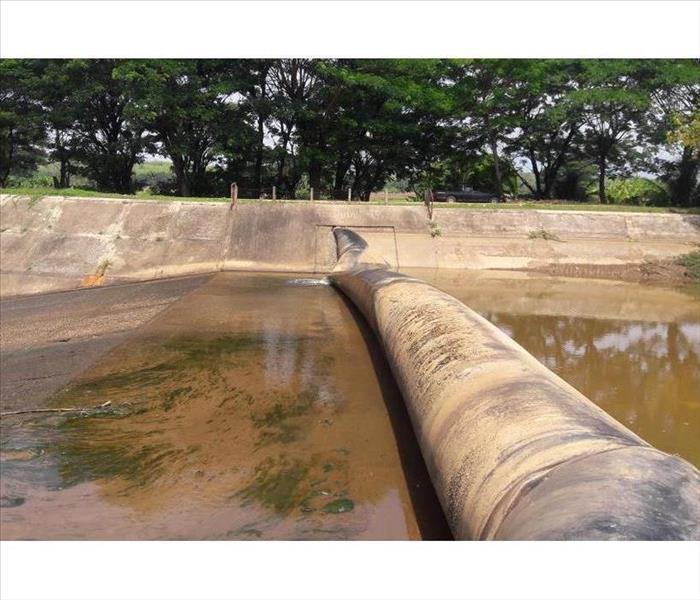 Flood dams can help you protect your building.
Flood dams can help you protect your building.
Sandbags Alternatives
If you know the water is coming, and you have weeks to prepare, tons of sand, and dozens of people to help you fill and move a sand bag around, this is a great way to keep the water from entering your land. But damming a commercial property in Baldwin, WI, before a storm can be difficult using one bag of sand at a time. Here are three new alternatives to the old way of property damming.
1. Water Barricade
Easy-to-use water tubes can be found in lengths between six and 50 feet. They also typically come in several diameters, including 4 inches and 20 inches. You simply lay the tube where you want the dam around your property to be, fill it with water, and watch the tubes prevent the floodwaters from damaging your property. After use, simply hang them up to dry, and store them away for the next time they are needed.
2. Water Fence
Don’t let the unusual design of a water fence put you off because it can protect as well as any sand bag. Many water fences have been engineered from marine-secure panels, reinforced with aluminum and stainless-steel, and covered in PVC canvas. Typically 4 feet tall, these fences are made of panels that can be reused up to 60 times, and that can provide protection from flood damage for years to come. Simply fold and store the sections of fence after use.
3. Water Dam
With a feel of fabric-covered diaper material, this type of floodwater protection may be one of the best flood dams available. Better yet, it can be found at most local hardware stores. Roll the sections out, run hose water over each unit, and watch it expand. The small tubes can also be stacked for additional protection. When the water recedes, the tubes can shrink as they dry out, waiting for the next storm to hit.
The back-breaking work of filling a sand bag can be a thing of the past with these new and surprisingly efficient options to raging floodwaters. Whether you need to protect a small building or a whole city block, it is easy to do with these inventive water barriers. If water does flood your property, contact a water damage specialist for assistance.
6 Common Causes of House Fires
11/22/2021 (Permalink)
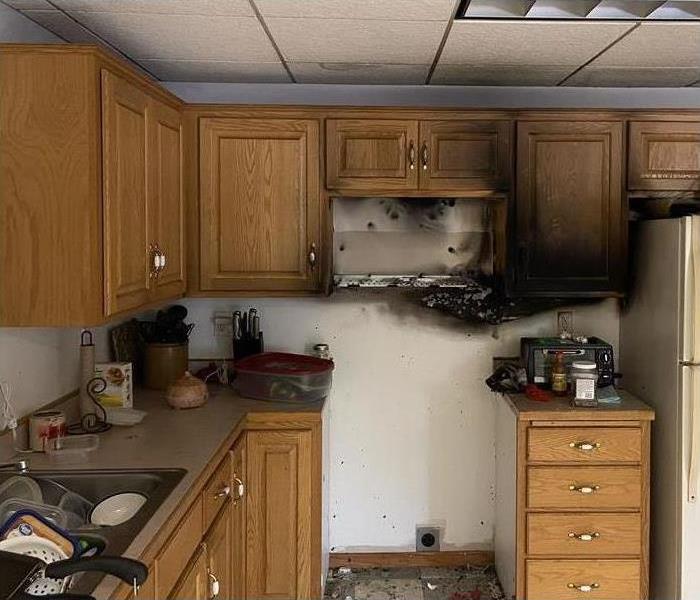 A kitchen fire in Prescott, WI.
A kitchen fire in Prescott, WI.
Top Causes of a Home Fire
A home fire can break out in Prescott, WI, for a wide range of reasons. No matter why flames start, it can be helpful to call in a residential cleanup crew after the fact. If you become familiar with the top causes of a fire, you may be able to avoid the disaster in your own house.
1. Heaters: Heating equipment, such as space heaters, wood-burning stoves, and electric fireplaces, plays a big role in the occurrence of house fires. Occasionally, central heating systems may start a fire, but other forms of house heaters tend to be more dangerous.
2. Cooking Appliances: The kitchen is a dangerous room in the house and is responsible for a variety of fire causes. Frying mishaps, unattended cooking, and gas fires are often associated with this type of fire.
3. Smoking Materials: Most people put out their cigarettes when they are done smoking. However, sometimes accidents happen and the burning butt is left unattended. This mishap often leads to the need for some type of fire cleaning.
4. Electrical Factors: Frayed cords, damaged plugs, and faulty wiring can cause a home fire to break out. If an appliance overheats, it may fall into the category of electrical factors.
5. Faulty Alarms: While the alarms themselves may not start the fires, they can play a role in how bad the flames get. If your smoke alarm does not go off, you may end up sleeping until the fire has engulfed most of your house.
6. Intentional Acts: Every once in a while, a house fire may be started on purpose. An angry spouse or disgruntled neighbor could be behind an intentional fire. Even some homeowners may be the ones who started the fire to cash in on insurance money.
There is no one cause of a home fire. Being aware of the potential for danger can help you keep your house safer.
3 Signs You May Have a Sewage Problem in Your Home
11/3/2021 (Permalink)
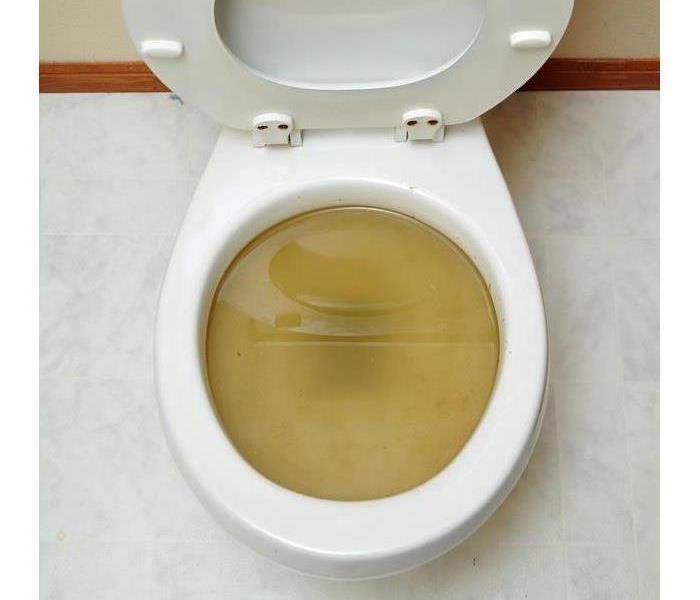 An overflowing toilet can be a sign of a serious clog in your plumbing.
An overflowing toilet can be a sign of a serious clog in your plumbing.
3 Signs Your Home May Have a Sewage Problem
Water problems in your New Richmond, WI, home can cause financial setbacks and other problems that keep you up at night. This may include an old plumbing system that backs up frequently or arranging for sewage cleaning services when your toilets spillover. Catching problems early could lower the risk of flooding and overflow, but you can often prevent these difficulties when you learn to spot the signs of potential sewage trouble.
1. There Is Overflow During Showers
If your toilet backs up and overflows when you run the shower, this can be a sign of a serious clog in your plumbing. If the excess water cannot drain the usual way when the shower is running because of a clog, it may run into the toilet line and cause the bowl to overflow. If a toilet overflow occurs each time you turn on the shower, you may want to call in a plumbing service for sewage cleaning and to have your lines inspected.
2. There Is a Lingering Sewer Smell
Keeping your bathroom clean is probably high on your list of housekeeping priorities, but if a foul odor persists even after you scrub your toilet, you may have a sewer problem. Damaged or cracked pipes could be sending this smell back into your home and could eventually cause your toilet to spew sewer contents up the line and into your bathroom. Asking a plumber or flood damage and restoration company for advice and assistance may prevent a troublesome and messy cleaning job.
3. There Is Inconsistent Flushing Power
If your toilet has become sluggish and does not flush completely, a clogged pipe may be to blame. However, you may also want to check the unit’s flapper or look for a leak around the base before calling a plumber to remove a potential clog.
Sewer issues in your New Richmond, WI, home can be costly in terms of water removal and sewage cleaning. Learning to spot the signs of a possible problem can save you time and money and help you avoid future damage to your home.
Grease Fires: Fast and Dangerous
10/17/2021 (Permalink)
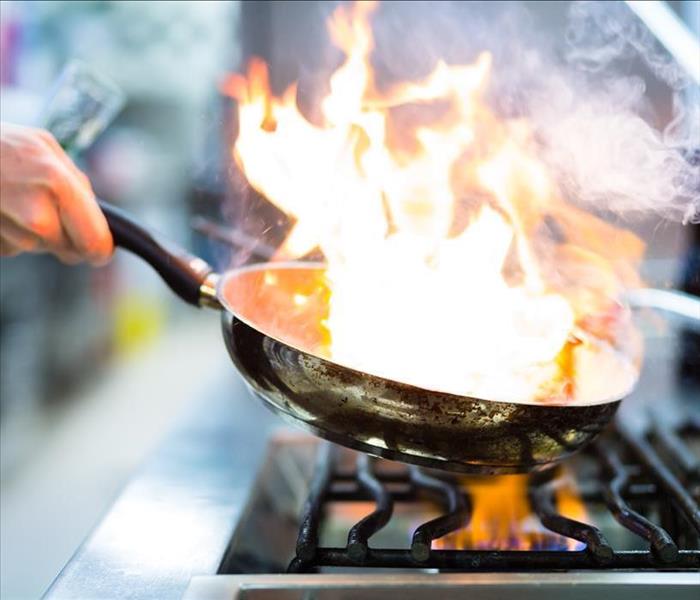 In the event of a grease fire contact a fire department.
In the event of a grease fire contact a fire department.
It’s no surprise that most home fires start in the kitchen. But did you know that most kitchen fires are grease fires? It’s true. Cooking with oil and fat adds an extra element of risk to home cooking. Fortunately, a few simple precautions can help you avoid grease fires in your kitchen.
How to Stop Grease Fires Before They Start
1) Keep cooking surfaces clean. Wipe grease off the stove and countertops and clean the oven regularly.
2) Pay attention to temperature directions in recipes and on packages. Fats and oils with low smoking points, like butter and sesame oil, should never be used with high heat. Others, like peanut oil and extra virgin olive oil, can tolerate much higher temperatures.
3) Never leave cooking food unattended. Fats and oils can ignite quickly. If you see smoke rising from the pan or detect a sharp, smoky smell, turn down the heat or remove the pan from the stove immediately.
What to Do If A Fire Breaks Out
1) DO NOT POUR WATER ON THE FLAMES. This will cause the grease to splatter, spreading out fire and making it more difficult to extinguish.
2) If possible, smother the fire using a metal lid or pan. Do not use glass, as it may shatter. Turn off the heat and leave the cover on until it is cool.
3) Alternatively, pour baking soda or salt on the fire to extinguish the flames. Do not use other cooking products like flour, sugar or cornstarch, as these may make things worse.
4) Point a Class B dry chemical fire extinguisher at the fire and spray until flames are gone.
Once the grease fire has been extinguished, assess the damage and begin fire cleanup. Contact the River Falls, WI fire department or the National Fire Protection Association for more information about keeping your home and family safe from fire.
Do You Suffer from Lawn Slime?
10/12/2021 (Permalink)
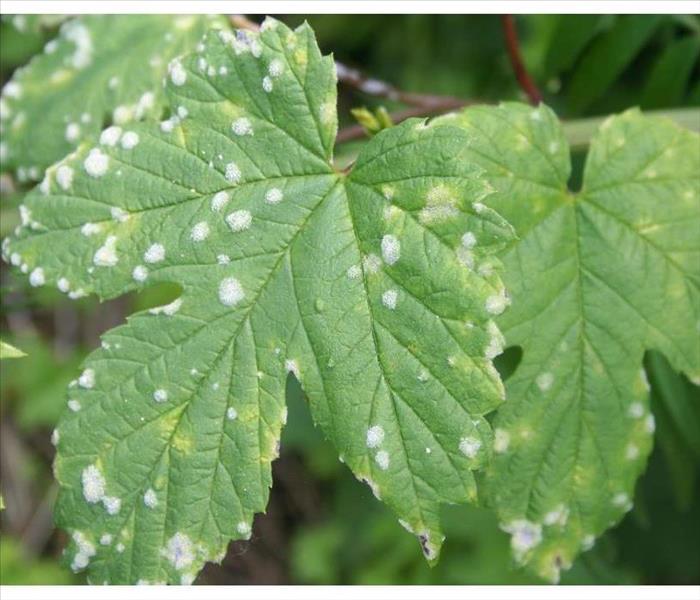 Avoid lawn slime by keeping your lawn clear of debris.
Avoid lawn slime by keeping your lawn clear of debris.
Is Lawn Slime a Problem for You?
Lawn slime is exactly what it sounds like – a creeping, invasive slime that seemingly crops up overnight on your Hudson, WI lawn, often in brightly colored patches. Not only is this slime disgusting, but it can prevent your grass and other cultivated plants from growing. It also poses a safety hazard for slipping on the sticky, gooey mess. But did you know that lawn slime is actually a form of outdoor mold?
Getting to the Root of Lawn Slime
Lawn slime, like any other fungus, feeds on organic matter. Lawn slime in particular prefers dead and decaying matter, and if it’s been a while since you raked the lawn you might have created perfect breeding grounds for lawn slime to grow. Conditions that favor lawn slime include:
- Dark, shaded places, such as beneath thick trees, under bushes, and under heavy leaf, twig, and needle thatch
- Areas with trapped moisture, such as muddy gravel and peat beds or boggy areas
- Accumulations of dead matter such as dead leaves and other rotting foliage
- Hot, humid and/or rainy weather
- Overwatering
- Improper mowing
- Wrong grass type for your yard, leading to dry grass and decaying, dead matter
Keeping Lawn Slime Away
Unlike indoor mold, lawn slime rarely responds to the sort of mold remediation techniques used on household mold. Raking up lawn slime is a start, but as a fungus it often has a network of fibrous matter that extends through places you can’t see. It also doesn’t respond much to chemical treatments or other mold deterrents.
The best offense is a good defense, so avoid lawn slime by keeping your lawn clear of debris, trimming overhanging trees to reduce shadows, and using a sandy soil type that lawn slime has difficulty taking root in. Avoid overwatering your lawn and creating conditions ripe for lawn slime breeding. With a little diligence, you can keep your lawn slime-free.
Basic First Aid for Workplace Burns
10/12/2021 (Permalink)
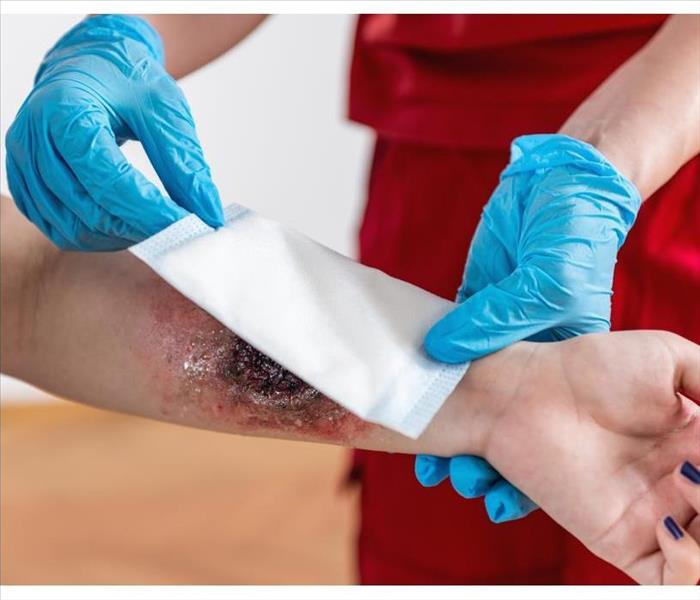 First aid training - Burn Injury
First aid training - Burn Injury
Workplace Burns: Basic First Aid
When fire accidents happen around the workplace in New Richmond, WI, it isn’t only fire damage to your property you need to worry about. To improve safety conditions, all employees should understand basic burn first aid. Minor burns can be managed on site, but more serious burns need to be treated by a doctor. If a burn meets any of the following criteria, call for emergency help right away.
- Appears charred
- Has white, brown or black patches
- Is larger than three inches across
- Covers hands, face, feet, buttocks, groin or joints
- Is deep
Treating Minor Burns
If fire damage to the skin affects a small area and appears red or blistered, it’s probably minor enough to treat on-site. First, run the burn under cool water or hold cool, wet compresses against it to reduce the pain. If there is any jewelry in the burned area it should be removed, because burns can swell and cause jewelry to become painfully tight. A burn lotion, such as aloe vera, can be applied and a dry gauze bandage wrapped loosely around the area. Try not to break any blisters, as these protect the burned skin from infection. If a blister does break, gently clean it and cover the area with gauze.
Handling Major Burns Until Help Arrives
If an employee sustains major burns, there are things you can do to treat the burn until emergency services arrive. The most important thing is to get the injured person away from the heat source and to check to see if they are breathing. If not, begin resuscitative breathing immediately. The following actions can prevent further harm until trained medical personnel can take over.
- Remove restrictive items, such as jewelry and belts, from the burned area
- Cover the burn with cool, damp cloth
- Elevate the burned area
- Treat for shock by lying the person down, elevating their feet and keeping them warm
While fire damage to property should only be handled by a professional fire remediation company in New Richmond, WI, every worker should be trained in basic first aid for burns. Addressing a wound right away can make a big difference in the healing process.
Rain Rain Go Away
6/4/2021 (Permalink)
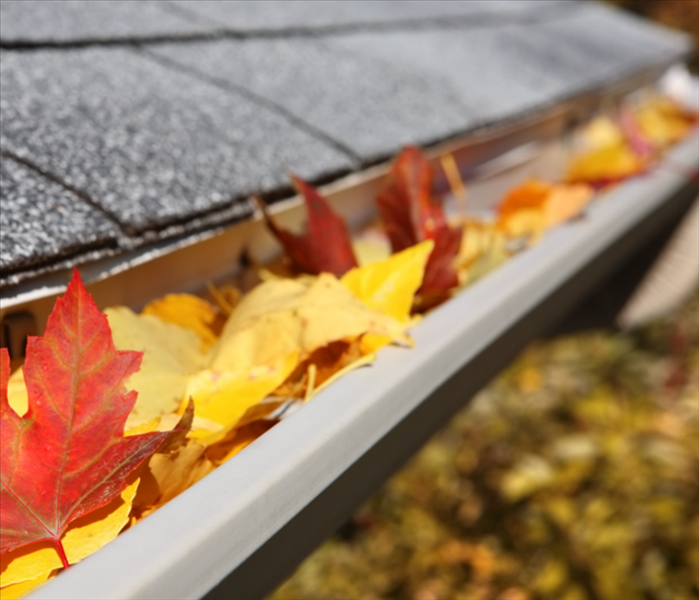 Debris from trees still falls on your roof.
Debris from trees still falls on your roof.
During the winter months we talk a lot about watching your roof and gutters for ice buildup, to help avoid ice dams. Today we are going to talk about your house gutters again, but only with a non-winter slant. It may not be fall yet, but debris from trees still falls on your roof, the usual leaves or sticks on a winter day, or the really messy dried pine needles. All of which can plug your gutters and cause rain run off to flow over the edge and collect around your foundation.
We suggest that you periodically check your gutters and remove the buildup. Especially when the weather man is predicting a heavy rain fall. If the water over flows and lands around your foundation causing an excessive saturation, which can seep into your basement and cause damage. The good news is, SERVPRO can help with the mitigation. The bad news, homeowner’s insurance doesn’t always cover for seepage of this sort in most policies. That’s why it’s a good idea to keep up with your home maintenance to avoid having to call us out.
What To Do When Your House Floods
5/28/2021 (Permalink)
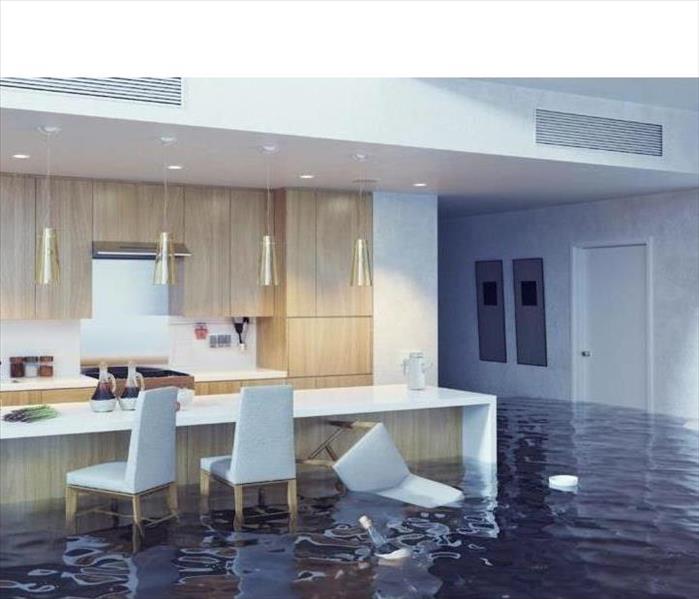 98% of basements in houses in the US are prone to flooding and will experience water damage during their lifespan.
98% of basements in houses in the US are prone to flooding and will experience water damage during their lifespan.
Flooding is a major problem for many residents in the US. Water Damage Defense states that about 98% of basements in houses in the US are prone to flooding and will experience water damage during their lifespan. And when it comes to house floods, no matter how minor it is, it can be damaging and can leave your home vulnerable to damage and mold growth.
Whether the flooding is caused by heavy rain, sewer back-up, or a broken pipe, it is crucial to deal with the flood as soon as possible to prevent further water damage. Here are the first things that you need to do when faced with house floods.
Floodwater poses a lot of risks both to your safety and health. The electricity that has come in contact with water can be life-threatening. Make sure to turn off the main breaker and all other individual fuses in your home before you step into the floodwater. If the water is too high, call a licensed electrician to inspect and evaluate your power box condition. Don’t forget to wear protective gear too, such as gloves, boots, and a mask. You don’t know what contaminates the water; it is best to protect yourself against the harmful chemicals present.
If you have kids at home, make sure to refrain your children from eating the foods that may have come in contact with water for an extended period. Transfer furniture and other items that can still be salvaged in a higher area.
- Identify the source of the flood and stop it.
Once the main power supply is turned off, the next thing that you will need to do is to find the cause of flooding and prevent more water from coming into your home. This will help prevent further water damage to your house. If the cause of a house flood is a leaky or broken pipe, then turn off your home’s main water supply.
Before you start removing the floodwater to clean up your home, take a video or pictures of everything affected by the water. Documenting the damage done by the flooding is crucial for your insurance claims. Take photos of the damaged items, the warped wall and flooring, and other water damage in your home. Then keep a copy of every single document that you have presented to your insurance agent.
- Call your insurance provider.
Once all the necessary documents are ready, call your insurance provider and inform them about the incident. Your insurance company will then send an adjuster to inspect the damage and evaluate the losses.
- Get help from a reputable water damage professional.
You may be tempted to do the water removal and cleaning process on your own. However, time is of the essence when it comes to water damage. The earlier and the faster you deal with the flood, the lesser damage it will cause. The best way to deal with water damage caused by house floods is by calling a reputable water restoration company like Water Damage America. The good thing about hiring professional water restoration contractors is that they can also assist you with your insurance claims.
How Mold Can Damage Your House
5/21/2021 (Permalink)
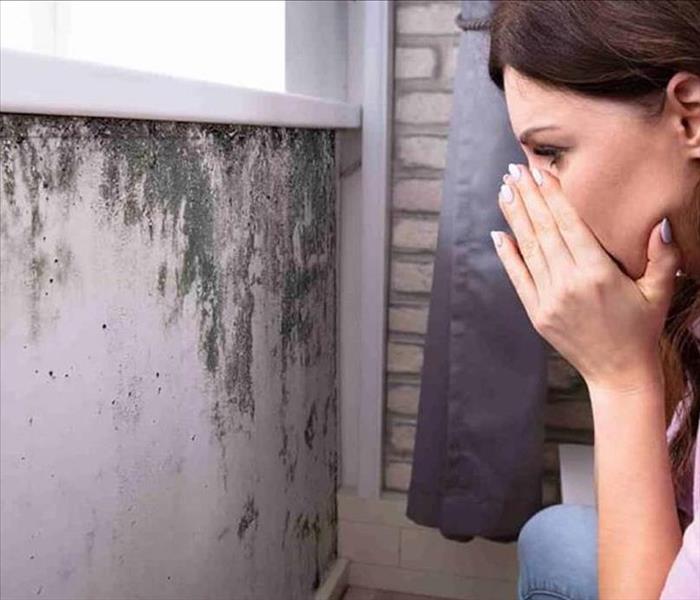 Water damage is the leading cause of mold growth in many homes.
Water damage is the leading cause of mold growth in many homes.
While mold is not harmful at all as it participates in the decomposition of dead organisms and other aspects of the environment, the problem happens when it enters your house and damages it.
Water damage is the leading cause of mold growth in many homes. According to insurance industry research, 98% of US basements will experience some type of water damage, while about 14,000 Americans suffer water damage emergencies at home or work each day.
Once molds enter and penetrate your home, its population can start growing in just 24 hours. It’s only then a matter of time before they cause permanent damage to your house.
Where do molds usually grow?
Molds only need two things to thrive and multiply —- damp and humid environment and permeable objects. With this, the following areas in your home make it the perfect breeding ground for molds.
-Bathrooms
-Drywall
-Carpets
-Attics
-Ventilation and air-conditioning system
-Upholstery
-Ceiling
-Areas around washing machines and dryers
-Fireplaces and chimneys
How molds damage your home?
Once molds are attached to a specific area or part of your house, it starts to eat away the material of its host; causing it to weaken. A weakened foundation of the house should be dealt with right away, or else it may collapse or result in a more costly repair.
Early detection is the best solution to deal with molds in your house. Here are the sneaky signs that molds may be growing inside your home.
-The nasty smell coming from your heating and cooling systems
-Discoloration or dark spots forming on the wall and ceiling
-Musty odors that seem to linger in the air
-Mold can cause health effects
How to deal with molds in your home?
Molds may be microscopic, but they are also tough to deal with. They can’t be removed with simple cleaning using soap and water. It is important to note that where there are molds, there is also a source of moisture. Deal with water leaks right away, no matter how minor the problem is. For significant water damage, calling water damage professionals is the best option.
It is also crucial to call a professional mold remediation company when you spot molds in your house. The good thing about hiring professional services is that they have the proper equipment in dealing with molds. They can altogether remove mold out of your home and even get to its source.
6 Steps You Should Take During a Power Outage
5/10/2021 (Permalink)
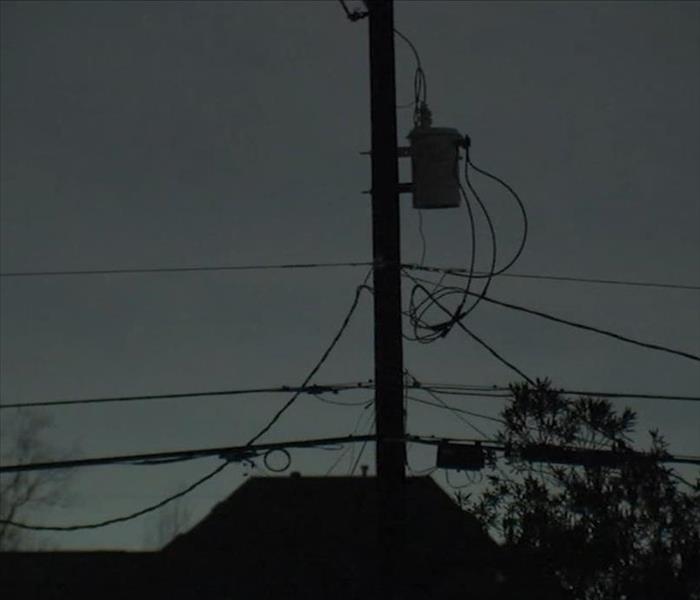 You could face a more prolonged outage.
You could face a more prolonged outage.
Most power outages are short. They may only last a few seconds to a couple of minutes. Now and then, however, you could face a more prolonged outage. Being prepared for a longer outage should help your family stay safe while the power’s out and properly return to using electricity in your home when the power comes back. Follow these six steps to prepare for and handle any prolonged power outages that could come your way.
- Create an Outage Kit
The key to safely navigating a power outage — especially an extended outage — is being prepared before the outage happens. Create a home emergency kit that includes supplies you’ll need if the power goes out. Some things you might want to have in your kit include:
Flashlights — either fully-charged rechargeable or battery-powered
Extra batteries
Candles in safe holders
Lighter or matches
Battery-operated or crank radio
External battery packs/charging ports for cell phones and other small electronics
Basic first aid kit
A few bottled waters and non-perishable food items like granola bars
Store your outage or emergency kit in a place that’s easy to find and access if the power goes out and you’re left in the dark. The last thing you’ll want to do when the power goes out is rummage through boxes in the dark.
- Practice for Power Outages
If you have small children or someone with special needs, like an elderly parent, living in your home, do a few tests runs so you know what to do when your power goes out. Small children are often scared of the dark and may panic if the power goes out at night. Store a child-sized flashlight in their room and teach them where to find it. This makes it easier for them to go right to their flashlight if the lights suddenly go out.
For households with someone who has special needs, like medical equipment that needs electricity, be sure you have a backup plan in case of a power outage. You might consider asking friends or family within driving distance if you can use their homes when the power goes out, as long as they have power.
- Investigate Why the Power Is Out
When the power goes out, your first step after grabbing your outage kit should be to find out why it went out. Look out of the nearest window to see if your streetlights or neighbor’s homes still have power. If only your house is dark, you may have tripped a breaker. Find your electrical box and check if any breakers are off. If so, switch them back on to see if that restores power.
If your entire block is out of power, you can check with your electric company to see if they know about an outage. Many electric providers have outage maps and data on their websites so you can easily check on the status of your power from a cell phone. If no outage is reported, call your electric company and let them know an outage has occurred. They’ll likely send out a crew right away to identify the problem and restore power as soon as possible.
- Unplug Electronics and Turn Off Lights
Go around your home to unplug electronics and turn off any lights that were on before the power went out. This is an important and often overlooked step during a power outage. Unplugging your electronics like your TV or microwave can help reduce potential damage to your electrical system or electronics when the power is restored.
When power comes back on after an outage, your home’s electrical system gets a surge of electricity. This surge can cause damage to electronics. You might want to leave one light on the inside and one light on the outside. The inside light will help you know when power is back on, and the outside light can help the power company’s crew know when they’ve restored power to your home.
- Use Generators Safely
A standby generator can be an important tool to keep your power up and running if the power to the grid goes out. Generators also come with a lot of inherent risks. Know how to operate your generator safely before you need to use it during a power outage. Some essential generator safety tips include:
Read and follow the manufacturer’s instructions.
Consider hiring an electrician to help you install a back-up home generator to your electrical panel.
Never connect portable generators to your home’s electrical system.
Always operate your generator outdoors in a well-ventilated area away from doors or windows.
Never bring a running generator into your home, garage or basement.
Connect lights or appliances directly to the generator.
Along with generators, you should never bring outdoor heating or cooking equipment into your home to help heat it. Things like propane camp stoves, charcoal grills, and outdoor heaters give off carbon monoxide and need to be used in well-ventilated, outdoor areas to avoid carbon monoxide poisoning.
- Know What to Do When Power Comes Back
Short power outages will usually end with your lights and appliances coming back on in one wave. After a longer outage, however, you may need to take a few steps to restore power to your home safely. When the power returns, first inspect your home for damage. If there’s standing water in your basement, do not enter the water until you’re sure there are no live electrical wires that could electrify the water.
If you find no damage to your home, start plugging your appliances and electronics back in. Start with large appliances like your refrigerator and wait a few minutes before plugging in each new electronic. This will help your home’s electrical system safely send electricity to your electronics without surging. When your electronics are back on the grid, check your emergency kit and restock any supplies you may have used so you’re prepared for the next power outage.
How to Prepare for a Natural Disaster
5/10/2021 (Permalink)
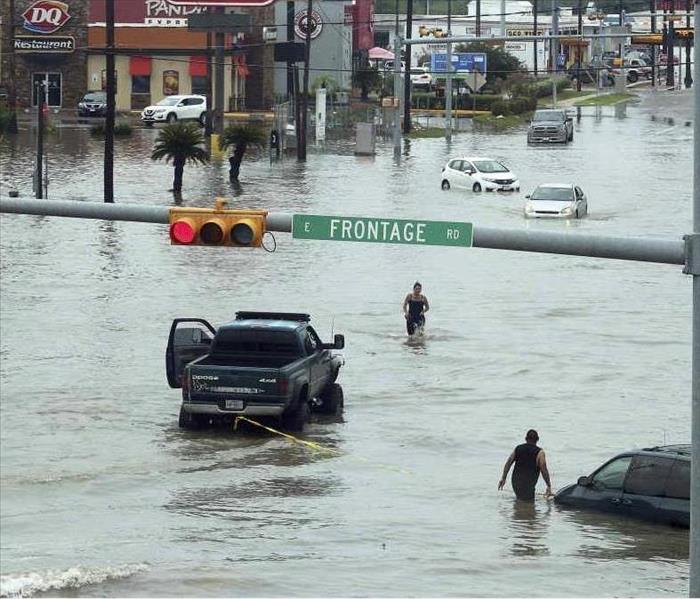 Disasters often come quickly and unexpectedly.
Disasters often come quickly and unexpectedly.
It’s unlikely that you’ll have a lot of time to prepare when a natural disaster strikes. Disasters often come quickly and unexpectedly. According to the Public Policy Institute of California only 29% of Californians feel they’re very knowledgeable about preparing for a disaster.
Being prepared can greatly reduce your risk of injury or damage following a natural disaster. Follow these steps to prepare for a natural disaster.
- Understand Your Level of Risk
Before you can set up an emergency plan or create a disaster kit, you need to know what types of natural disasters pose a threat in your area. You should try to create your disaster plan based on the most likely emergencies to happen in your area. Common types of natural disasters in California include:
Earthquakes: California has many active fault lines, which make it prone to earthquakes. An earthquake occurs when the earth’s crust along a fault line shifts suddenly. This causes movement, like shaking, on the ground level. This shaking can cause unsecured objects to fall, such as a book falling off of a bookshelf, or cause damage to the foundation of buildings.
Wildfires: Wildfires are fast-moving fires that feed off of dry vegetation, such as desert plants like sagebrush. They commonly start due to a lightning strike, but can also be caused by human carelessness. A wildfire can grow quickly and cause major damage to entire neighborhoods or destroy thousands of acres of wilderness. Southern California, in particular, is prone to wildfires due to limited annual rainfall and dry vegetation. Wildfires can potentially be stopped or slowed using a wildfire defensible space around your home.
Mudslides: Mudslides are a type of landslide that is caused by heavy rainfall sweeping loose soil and debris down steep hills. Several areas in California are prone to landslides and mudslides, especially desert landscapes after a sudden rainfall.
Extreme Heat:
Extreme heat is when there is a long period of time with high heat and humidity. This could be 2-3 days of temperatures above 90 degrees. Not only can extreme heat be dangerous to the human body, it is also dangerous to your home. Damages include inconsistent moisture in the foundation, deteriorating roofs, or even warped hardwood floors.
- Plan and Practice Your Disaster Plan
Once you know what natural disasters you’re most likely to encounter, you should come up with a disaster plan in case of an emergency. Since disasters strike unexpectedly, you may not be with your family when one hits. Having a plan in place that everyone knows should help you find one another, even if there’s a power outage or you can’t use a phone.
Your disaster plan should include information such as:
The meeting place for your family.
Potential evacuation routes from home, work or school.
A shelter plan in case your home is damaged.
Considerations for family members with special needs, including children, seniors or those with disabilities.
An emergency contact, such as a family member in a different state.
The location of important documents, such as a bank deposit box or fire-proof safe in your home.
A plan for pets in case of an emergency.
Your plan is only helpful if everyone in your family knows and understands it, so it’s crucial to practice it regularly. This is especially true if you have young children. Sit down as a family and go over the plan in detail, then start practicing.
Remember that different disasters may have slightly different emergency plans. For example, if a wildfire is heading towards your neighborhood, you’ll likely have to evacuate the area and won’t be able to meet your family in front of your home. Be sure to set up multiple meeting spots for different scenarios.
- Invest in a Disaster Preparedness Kit
Whether you buy a pre-made kit or build one yourself, a disaster preparedness kit could help your family stay safe after a disaster. You can create an emergency kit for your home, and smaller kits for your vehicles. This helps you stay safe even if you experience a disaster while on the road.
Your disaster kit should include:
Non-perishable food
Clean drinking and sanitation water in airtight containers
First aid kit
Battery-powered radio
Flashlights
Extra batteries
Bedding and a change of clothes
Power bank and charging cables for your cell phone
Whistle
Pen or pencil and a notebook
Copies of family documents, such as insurance cards and ID
Tarp, duct tape and rope in case you need to build a shelter
Personal supplies – prescription medications, glasses, feminine hygiene products
Infant supplies – diapers, formula, wipes
Pet supplies
Cash
You should check your kit at least once a year to make sure everything still works and nothing has expired. Put the kit in an easy-to-access location in your home and make sure each family member knows its location.
- Learn Basic First Aid Skills
Investing in a CPR certification program could potentially save a life in a disaster situation. If you can’t take a CPR class, you should at least learn basic first aid skills. Not only are these skills helpful in the event of a disaster, but you can use them in non-emergency situations as well. There are lots of ways to learn basic first aid- from taking an in-person class to watching instructional videos on the internet. Find the method that works best for you to learn.
You should also consider teaching your children how to use vital components of your first aid kit. Sit down with your family and go through the kit. Remember that many children may feel anxious at the thought of their parents getting hurt, so try to keep your lessons fun. For example, let your child pretend to be a doctor and use extra supplies, like gauze, to treat your fake injuries.
- Reduce Risks in Your Home
Eliminating hazards in your home, office or vehicle could help you avoid an injury if you experience a natural disaster. Earthquakes, for example, are common in California. The shaking of an earthquake can cause items to fall off shelves or even knock over furniture. Securing objects on tabletops or bookshelves and anchoring your furniture helps reduce the chance it falls over. A wildfire defensible space is another example of reducing risks around your home.
Spring Cleaning Tips for Homeowners
4/21/2021 (Permalink)
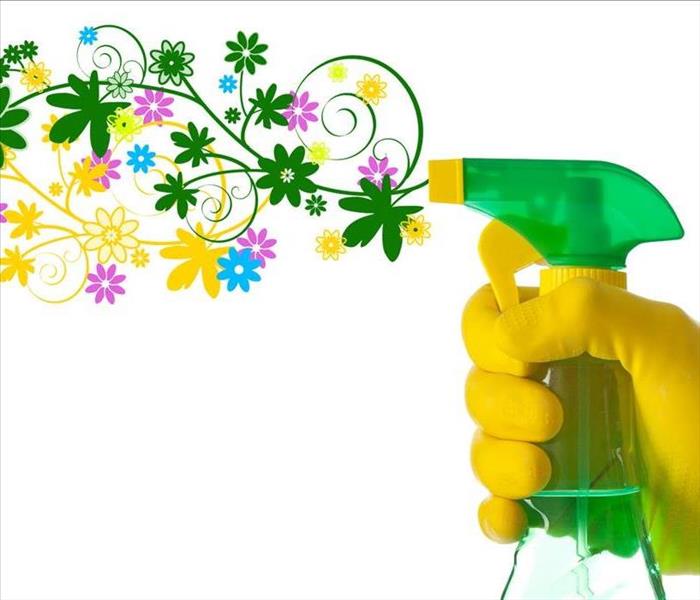 Long days and warmer temperatures make for a great time to do a little spring cleaning.
Long days and warmer temperatures make for a great time to do a little spring cleaning.
Winter has finally started to thaw and the chill in the air is beginning to fade away. Even if you live in a warmer climate with mild winters, springtime brings longer days. Those long days and warmer temperatures make for a great time to do a little spring cleaning.
As a homeowner, your spring-cleaning routine should include a little more than just scrubbing the bathrooms and vacuuming the floors. You can use spring as a time to check up on parts of your home that affect property value and longevity of your house. Our list of spring-cleaning tips for homeowners gives you some ideas for not only cleaning your home but making sure all systems are running correctly.
Remove Dust and Built-Up Dirt
Just like a regular house cleaning, your spring-cleaning routine should include a complete scrub down of your home. You can sweep, vacuum and mop floors to pull up the dust and grime that has built up over winter. Dust along molding and floorboards to pick up the dirt that has settled there. Ceiling fans tend to collect a lot of dust over the winter, so be sure to wipe them down thoroughly using a vacuum attachment or old pillowcase for dusting. Also, be sure to check that the fan is rotating in the correct direction. In spring and summer, you want it to spin counter-clockwise by pressing the switch on the fan’s side. As hot air rises, the counter-clockwise rotation forces cool air down towards the floor.
Do the Laundry
You’ve been doing laundry all winter so you’ll have clean clothes to wear, of course, but spring is a great time to air out warm-weather clothes and linens. Perhaps you use heavier sheets, such as flannel sheets, in the cooler winter months. Use your spring-cleaning day to pull out lighter bedding and wash the winter sheets before storing them until next winter. Alternatively, you might just want to switch up your color palette or décor for the warmer months. Many people switch to a light color scheme for the warmer months. Fresh colored bedcovers such as green, yellow and light blue can help welcome spring into your home.
While you’re doing your laundry, make sure to clean out your washer and dryer and check them for any issues. Be sure that the water lines running to your washing machine aren’t leaking. Give the tub of the washer a good rinse and sweep or vacuum behind and underneath the machine. You will probably also want to do this with your dryer, as well as checking that the vent is properly connected and vents cleanly outside your home.
Check Pipes and Water Lines
An increase in your monthly water or utility bill could be a signal that you have a burst or leaking pipe. Water damage in your home can be a costly expense that is a pain to deal with. Even if you don’t suspect a leak, springtime is a great opportunity to look through your home for any potential leaks or cracks. Check each of your faucets, including the ones outside your home, to make sure that they aren’t dripping. In bathrooms, you should inspect the areas around bathtubs, showers and toilets for leaking or damaged caulking so you can fix it before it becomes an issue.
Service Heating and Cooling Systems
Your heating and cooling units might be some of the most expensive and important equipment in your home. Luckily, these systems tend to have a long life with proper care. Proper maintenance of your heating and cooling systems can save you a lot of money, and a lot of hassle down the road. Spring makes an excellent time to have your heating system checked out after running it all winter. Your air conditioner, likewise, could likely use a checkup from a professional before using it through the hot summer months. You may need to replace things like air filters that have gotten filled with dust and dirt.
Declutter Closets and Storage
Spring cleaning is an ideal time for going through old winter clothes or items and getting rid of things you don’t need. Go through each of the closets or storage spaces in your home and make three piles of the items you find. One will be for keeping, one for donating to charity and one for tossing out in the garbage or recycling. Put your items into their respective piles to help declutter your home. This exercise is also great for making a home inventory list. Home inventory lists are a breakdown of the items in your home that could assist you when filing a homeowners insurance claim. Your list should include important items you would want to be replaced and a short description of each item, including brand and serial number if possible.
Let in Fresh Air While Checking Windows and Doors
One of the best parts of a spring-cleaning day is the chance to let in fresh new air and let out the stuffiness of winter. You can open up all your doors and windows while cleaning to enjoy the sunshine and the springtime breeze. Not only does this make your home feel refreshed, but it also gives you a chance to look at doors and windows for signs of damage or leaks. Be sure to check the caulking around the windows and doors. Sunshine and exposure to the elements can cause caulk to dry out or flake off. Also, check for signs of water damage anywhere around your windows or doors. This might indicate you have a leak from a broken seal.
Clean Gutters
Over the winter, your gutters may have gotten clogged with debris from trees, birds or squirrels. You can either hire a service to clean your gutters for you or you can clean them yourself. If you choose to clean them yourself, remember to be cautious when using a ladder. Always have someone there to help you and hold the ladder for stability.
Check Roofing
A new roof is an incredibly expensive undertaking, so it’s important to keep your current roof in the best shape possible. Check your roof for signs of stress or damage. This might include missing, broken or loose shingles. Additionally, check shingles to make sure they haven’t lost their protective layer. That gritty, asphalt-like substance on a roof tile protects it from the sun’s harmful UV rays. Just like with gutter cleaning, you will want to use caution and have a friend on the ground when you’re up on your roof.
Touch Up Peeling Paint
Peeling or cracking paint on a home never looks good. Even if it’s just cosmetic, peeling paint may lower the overall value and curb appeal of your home. It’s also usually a fairly easy fix. For homes with a lot of peeling paint, or cracked paint in hard-to-reach places, consider hiring a professional contractor to take care of the work for you. If you have a few small spots, you might want to take on the project yourself.
Refresh and Renew Your Home with a Spring Cleaning
A good spring cleaning helps your home feel refreshed and renewed for the warm season. Additionally, spring cleaning gives you the chance to go through your home’s important equipment and systems. You’ll be able to ensure everything is working properly and should be able to feel confident enjoying your home throughout the sunny spring and summer months.
Spring Cleaning Benefits and Tips for the Office
4/19/2021 (Permalink)
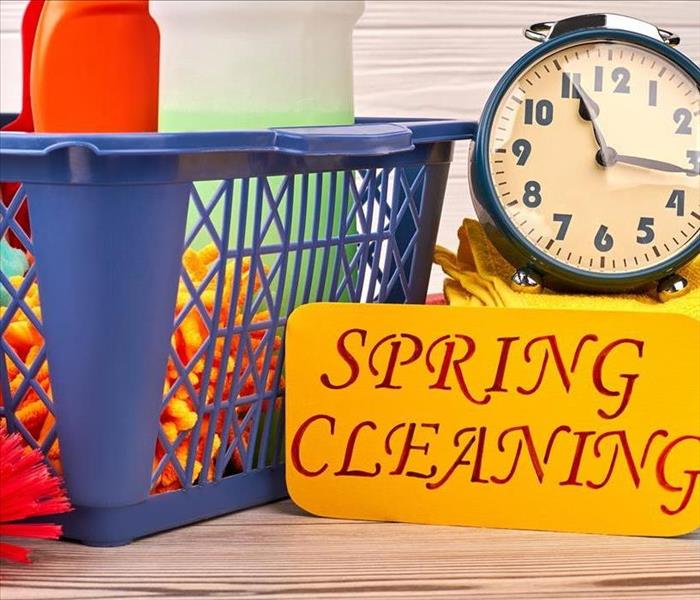 Warm weather is just around the corner and that can only mean one thing—spring cleaning
Warm weather is just around the corner and that can only mean one thing—spring cleaning
Warm weather is just around the corner and that can only mean one thing—spring cleaning. No more dreary weather, muddy footprints, and soaked carpets. Spring is almost here and that means we get to welcome a fresh start.
Now is the perfect time to stow away your winter-related items, declutter unnecessary items, reorganize, and refresh the office. We encourage you to make the most of the upcoming season by reading the rest of our blog post which contains the benefits of office spring cleaning and tips on where to begin.
Cleaning is always a good idea—especially now—as we continue to live with the pandemic along with practicing better hygiene. Five benefits that can stem from spring cleaning your office include:
Reduced stress
Increased productivity
Positive mood
Allergy symptom relief
A more healthy lifestyle
Reduced Stress
Cleaning can help reduce stress because it offers a sense of accomplishment and also makes for a very relaxing experience. Digging through piles of papers and other office materials can be extremely time-consuming and stressful if you cannot find what you are looking for. By cleaning out your office space, you’ll spend less time worrying and stressing about where specific items are.
Increased Productivity
It should come as no surprise that a clean workspace helps to increase productivity. Having pens, papers, staplers, and other office supplies scattered around your desk can be distracting you from your priorities. By cleaning, tossing away unnecessary clutter, organizing, and placing your items back where they belong, not only will your workspace look more presentable, but you’ll also improve your workflow efficiency.
Positive Mood
Clutter is often linked with negative emotions such as irritability and confusion, whereas a clean workspace is linked with positive emotions such as calmness and contentment. A clean environment will help to elevate your mood as it gives you better control of your surroundings. Not to mention, you’ll feel a sense of accomplishment once your workspace is neat and tidy.
Allergy Symptom Relief
Aside from cleaning, the springtime is also unfortunately known for being allergy season. If you have employees who suffer from seasonal allergies, we recommend putting together a regular cleaning and disinfecting routine in order to get rid of immune system triggers such as dust and pollen. We also recommend checking your office’s ventilation system to ensure good indoor air quality.
A more healthy lifestyle
All of the benefits above can be combined to support an overall healthier lifestyle physically, mentally, and emotionally. Spring is the season for new beginnings so get started by cleaning out your workspace today. Not sure where to start? Read our tips below!
Spring Cleaning Tips
Clean and disinfect all surfaces, especially the ones you are in daily contact with such as your desk, keyboard, door handles, etc.
Declutter and organize your drawers, placing everything back where they belong and tossing away unnecessary items
Keep only your frequently used items on your desk and store the rest
Manage long, messy wires or cables by using Velcro strips for a neat and professional look
Perform a digital declutter by getting rid of files and emails that you no longer need and organizing the icons on your desktop to make them more easily accessible
Check in with the appropriate manager regarding the office ventilation system
Make cleaning and disinfecting a part of your weekly routine if possible—if not, consider hiring a commercial cleaning company to come in once a week or as needed.
6 Ways to Save on Electric Bills
4/16/2021 (Permalink)
 When you’re looking for ways to save money, lowering your bills should be a top priority.
When you’re looking for ways to save money, lowering your bills should be a top priority.
When you’re looking for ways to save money, lowering your bills should be a top priority. Some bills are easy to lower, such as that premium cable subscription you never use. Others might seem impossible to cut down.
If you’re like a lot of people, you’d love to lower your electric bill, but you’re not sure where to start. The good news is there are a lot of little changes you can make to help cut energy costs. Start by trying these six simple tips to lower your electric bill.
- Program Your Heating and Cooling
There are a lot of fancy smart-home devices available today, and they can get pretty expensive. Luckily, you don’t need to spend a fortune to add a few smart elements that can help cut your power bills.
Start with a programmable thermostat. You can opt for a top-of-the-line smart thermostat or a simple programmable one. Some smart thermostats allow you to change your home’s temperature from your smartphone remotely. Even a simple programmable thermostat lets you set the temperature in your home for specific times of the day.
Programming your heating and cooling saves you money on electricity by maximizing efficiency when you need it most. In the summer, you could set the thermostat to start running the air conditioning about an hour before you get home from work in the evening. You’ll come home to a cool house while not wasting money cooling the house when no one’s home.
- Unplug Appliances When Not in Use
It’s not always easy to tell if an appliance or gadget is using electricity when it’s turned off, but a lot of them do. Even if you hit the “off” button, leaving an appliance plugged in could be costing you money.
You can cut this unnecessary expense by unplugging appliances when you’re done with them. After making breakfast, unplug the toaster so it doesn’t sap energy till the next morning. You can do the same with almost any appliance or tool in your home — from gaming consoles and televisions to coffee makers and microwaves.
Unplugging all of your appliances after each use might seem inconvenient. Once you’re in the habit, however, you’ll enjoy a lower electric bill while also reducing your chance of overloading an outlet and causing a home fire.
- Wash Your Clothes in Cold Water
Traditional clothes-washing wisdom might tell you to use hot water to get your clothes clean. That’s because laundry detergents of the past needed the heat from hot water to activate. Most modern detergents, however, can work just as well in cold water as hot.
This is good news for your wallet since heating the water for a load of laundry uses a lot of energy. By washing clothes in cold water, you’re reducing the amount of electricity you need.
As a bonus, you’ll also get more use out of your clothes. Cold water is generally less harsh on your clothing than hot water. Hot water can cause fibers to break down and lead to shrinking, running dyes, or faded colors.
Make your laundry even more energy-efficient by skipping a cycle in the hot dryer. You can line-dry your clothes for similar benefits — you’ll save money on energy costs and your clothes won’t be exposed to extreme heat.
- Wear the Right Clothing
It may sound silly but wearing the right clothes indoors can help reduce your heating and cooling costs, ultimately lowering your electric bill.
In the winter, you might be tempted to crank the heater and start a cozy fire in the fireplace. After a while, you realize you’re warm. Instead of turning down the heat or putting out the fire, you change into shorts and a tank top to beat the heat.
In the summer, you could end up doing the opposite. You run the air conditioner so the house is cold, then pull on a sweatshirt or long pants because you’re chilly.
Most of the time, you probably don’t realize you’re changing to match your current comfort level. The next time you reach for an extra layer or change into summer clothes in the winter, try adjusting your home’s thermostat instead.
- Maintain Your HVAC System
Your heating and cooling system has to work hard to give you an ideal indoor temperature, especially if the outdoor temperature is extreme. The best way to keep your HVAC system from running up your electric bill is to practice proper maintenance.
The easiest step is to replace your air filter regularly. The air filter works to keep debris, dust, and allergens out of the air in your home. As the particles collect in the filter, the system has to work harder to move air through. Check your air filter regularly. If it’s dirty and dusty, it’s time to replace it.
You should also consider hiring a professional HVAC technician to service your system each year. A professional will have the tools and knowledge to alert you if there are any issues and clean your system so it’s running properly.
- Keep Your Appliances in Good Condition
A dirty appliance in need of repairs often costs a lot more to run than a clean one. Reduce your energy costs by keeping your appliances in good repair. If you notice an appliance isn’t running as efficiently, such as a dryer not drying clothes, clean out dust, dirt, and buildup or contact a repair company.
When your appliance gets beyond repair, you might want to think about replacing it with a newer, more efficient model. Many modern appliances are designed to reduce energy costs and may even come with a rebate from your local power company.
Reducing your energy expenses can be easy is you follow these six steps. Remember to monitor your monthly bill to see the impact these costing-saving ideas can have on your electric bill.
HOW MOLD CAN DAMAGE YOUR HOUSE
4/15/2021 (Permalink)
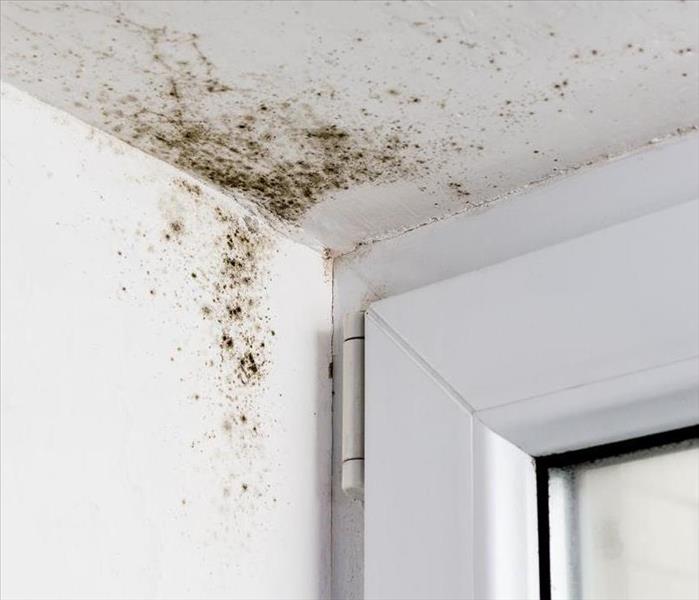 Water damage is the leading cause of mold growth in many homes.
Water damage is the leading cause of mold growth in many homes.
While mold is not harmful at all as it participates in the decomposition of dead organisms and other aspects of the environment, the problem happens when it enters your house and damages it.
Water damage is the leading cause of mold growth in many homes. According to insurance industry research, 98% of US basements will experience some type of water damage, while about 14,000 Americans suffer water damage emergencies at home or work each day.
Once molds enter and penetrate your home, its population can start growing in just 24 hours. It’s only then a matter of time before they cause permanent damage to your house.
Where do molds usually grow?
Molds only two things to thrive and multiply —- damp and humid environment and permeable objects. With this, the following areas in your home make it the perfect breeding ground for molds.
-Bathrooms
-Drywall
-Carpets
-Attics
-Ventilation and air-conditioning system
-Upholstery
-Ceiling
-Areas around washing machines and dryers
-Fireplaces and chimneys
How molds damage your home?
Once molds are attached to a specific area or part of your house, it starts to eat away the material of its host; causing it to weaken. A weakened foundation of the house should be dealt with right away, or else it may collapse or result in a more costly repair.
Early detection is the best solution to deal with molds in your house. Here are the sneaky signs that molds may be growing inside your home.
-The nasty smell coming from your heating and cooling systems
-Discoloration or dark spots forming on the wall and ceiling
-Musty odors that seem to linger in the air
How to deal with molds in your home?
Molds may be microscopic, but they are also tough to deal with. They can’t be removed with simple cleaning using soap and water. It is important to note that where there are molds, there is also a source of moisture. Deal with water leaks right away, no matter how minor the problem is. For significant water damage, calling water damage professionals is the best option.
It is also crucial to call a professional mold remediation company when you spot molds in your house. The good thing about hiring professional services is that they have the proper equipment in dealing with molds. They can altogether remove mold out of your home and even get to its source.
Understanding Commercial Floor Cleaning and its Benefits
4/9/2021 (Permalink)
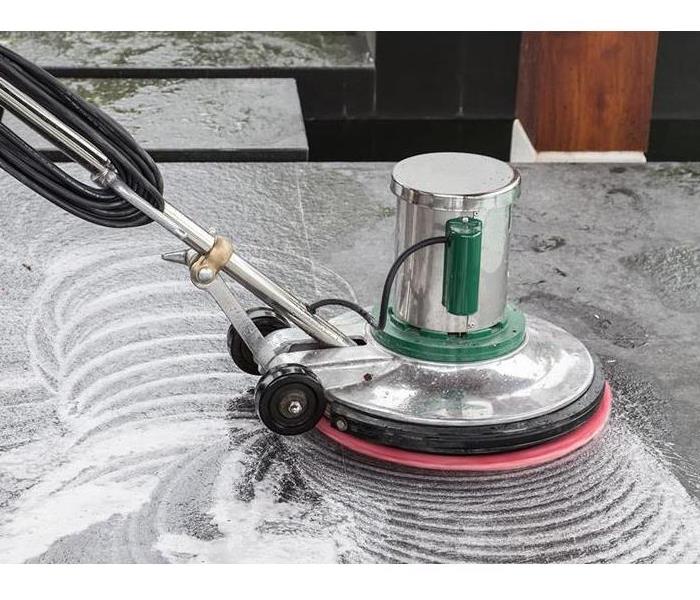 It can be easy to take floors for granted when it comes to a comprehensive cleaning and maintenance plan for your facility
It can be easy to take floors for granted when it comes to a comprehensive cleaning and maintenance plan for your facility
It can be easy to take floors for granted when it comes to a comprehensive cleaning and maintenance plan for your facility. However, floors are just as important as any other part of a building, if not even more so.
Clean and shiny floors are a key aspect of any well-maintained building and successful business. However, over time, floors can easily become scuffed, worn, and permanently dirty. This can happen sooner if routine floor care and maintenance is neglected.
What is Floor Stripping and Waxing?
Many hard floors, such as linoleum, acrylic, hardwood, and vinyl have a special wax coating to keep them shiny and make them easier to clean. The wax protects the flooring from dirt, debris, scratches, and cracking.
Stripping is the process of completely removing the preexisting wax coating, while waxing refers to re-applying a fresh coat of wax finisher. Stripping and waxing can be a difficult undertaking without the correct training, tools, and materials, so hiring a commercial floor cleaning company is strongly advised.
Benefits of Hiring a Commercial Floor Cleaning Service
Not only is the process itself rather involved, but proper personal protective equipment (PPE) is also required, which may not be readily available given our current public health crisis.
To properly strip and wax a floor, expensive appliances and tools are needed, including a floor scrubber, a wet-dry vacuum, and a floor buffer. Unless you are a commercial cleaner, you likely do not have these items at your facility.
Furthermore, it is important to consider the potential cost if the process is performed incorrectly. If a floor cleaning project goes awry, there could be potentially irreparable damage to already expensive floors, massive inconveniences to everyone involved, and an even bigger financial burden by having to replace sections of the floor, or even the entire floor.
Stripping and waxing a floor is something that can be done by someone on your team, but hiring an industrial floor cleaning service would be a safer and more cost-effective solution.
8 Spring Home Maintenance Projects You Should Do This Season
4/6/2021 (Permalink)
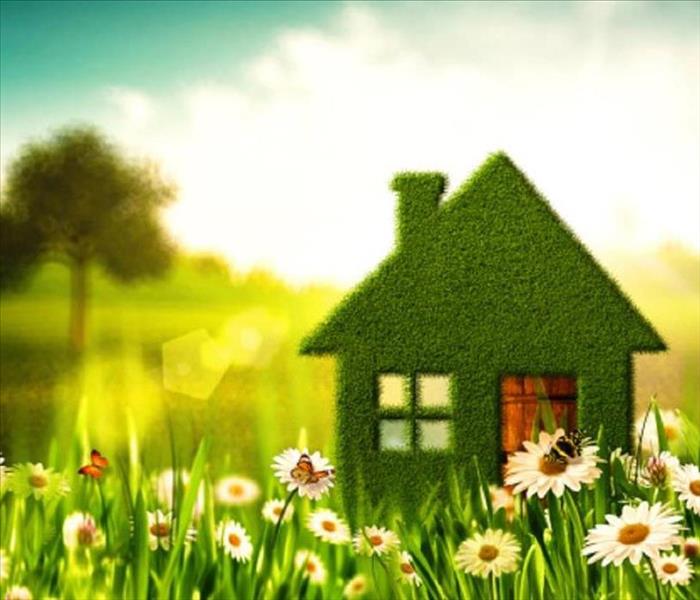 Spring brings longer days and warmer weather, both of which make it easier for us to plan and take on important spring home maintenance tasks.
Spring brings longer days and warmer weather, both of which make it easier for us to plan and take on important spring home maintenance tasks.
Spring brings longer days and warmer weather, both of which make it easier for us to plan and take on important spring home maintenance tasks. From repairing property damage to preparing for summer, there are a number of things that we should do to “tune up” a home’s major systems and features. Doing so doesn’t just maintain your home’s property value – it also helps to prevent bigger breakdowns and repairs down the line.
Not sure where to start? These 8 basic maintenance needs are each worth your attention this month:
Get Your HVAC Inspected
If there is one system you always want to be functional, it’s your heating, ventilation, and air conditioning system. All too often, people skip spring maintenance only to find their system breaking down during the hot summer. Rather than losing the comforts of home during a heat wave, you should hire a licensed professional to service the equipment before the start of summer. Just be sure to discuss any health and safety measures needed during your appointment this spring.
Clean Your Dryer Vent
One of the biggest fire hazards in your home is a clogged dryer vent. Fortunately, you can prevent this hazard by cleaning out your dryer vents each spring.
Check Your Windows’ Caulking
Caulk, the material used to seal the seams around your windows both inside and outside your home, doesn’t last forever, and its breakdown leads to air drafts and water leaks. It’s important to check the caulking in your home every spring for tears, cracks, or gaps. Should you find damaged caulking, it will need to be replaced, either by you or a professional.
Inspect Your Home’s Woodwork
Because it’s exposed to the elements, exterior woodwork requires lots of maintenance. Each spring, you should inspect the state of your wood decks, fences, railings, trellises, pergolas, and other outdoor structures.
In addition to planning necessary repairs and addressing wood rot, you should also plan on staining or resealing these structures every year or two. During your inspection, you should also check for signs of termites, as these insects need to be addressed by pest control sooner rather than later.
Examine Your Roof
Roof maintenance is one of the most important parts of home ownership. Are the shingles in place? Are the vent pipes, flashing, or anything else damaged? Answering these questions annually can help you spot small issues before they become big ones. If you notice anything that needs closer inspection or repair, the next step is to call a roofer, who can work with you to safely determine your next steps.
Clean Your Gutters
While not exactly a favorite chore around the house, cleaning your home’s gutters is extremely important. Blocked or damaged gutters can’t do their job during those numerous spring rain showers. Clogged gutters can also lead to wood rot, pest infestations, and other problems. So debris needs to be removed from gutters each spring, and you should also check that downspouts are still turned away from your home. Additionally, make sure water isn’t collecting at the foundation of your home.
Pressure Wash Your House
Rain, leaves, dust, and other outdoor elements tend to create a buildup of residue on your home’s exterior. In the worst cases, this buildup can lead to green mold! So it’s best to pressure wash the outside of your house each spring to prevent this. At the very least, the annual wash will add shine to your property!
Check Your Basement
In addition to examining exterior elements and essential household systems, you should also examine the state of your basement each spring. Because moisture is a common problem in basements, these are easy places for mold and other types of fungus to grow. To prevent a serious problem from developing, you should examine your basement each spring for signs of moisture or water damage.
These home maintenance projects each play an important part in keeping your home in good condition. Not only will they help you live comfortably and safely – but they’ll also be important should you look to sell your house at some point. So be sure to schedule time to complete each maintenance item this spring.
Disaster Shut Down
4/2/2021 (Permalink)
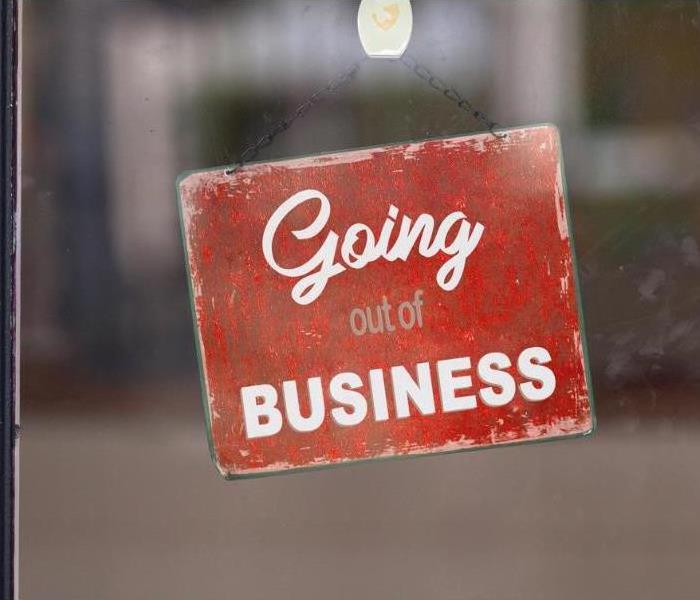 There’s never a convenient time for a disaster to strike.
There’s never a convenient time for a disaster to strike.
When you own a business, there’s never a convenient time for a disaster to strike. Fire, flooding, or destruction from a natural disaster can take time to mitigate and should be dealt with immediately before the damage spreads. Once the immediate danger is handled, cleanup and restoration of the damage can begin. In a world where time means money, any amount of downtime can put your business at risk of lost revenue and productivity. Remember, every hour spent cleaning up and repairing damage is an hour of opportunity lost for your business.
If you are a small business and have limited resources, it can be difficult to recover from a disaster, especially when it interrupts your daily operations. However, with the support of the right disaster commercial recovery team and a comprehensive recovery strategy, you can get back to business faster.
Be Prepared Before an Emergency Hits
According to FEMA, almost half of all small businesses affected by a disaster will never re-open their doors. For those that do, 90 percent will fail within a year if they don’t resume their operations within five days of the damage occurring. Why is that? Depending on the type and extent of damage, general operations may have to stop within the affected area. Meanwhile, life as usual goes on for customers and clients who are not directly impacted by the disaster. While some may be willing to wait for the business to reopen its doors, any long-term business disruption can send customers and clients looking elsewhere to get their needs met.
Businesses, large and small have a better chance of recovering from a disaster and successfully returning to business as usual if they have a plan before disaster strikes. Even when a disaster plan does exist, only 80 percent of companies spend time re-evaluating their plan each year. If you do not have one, it’s time to create one, so your business can go on as usual in the event of an emergency.
Creating a Emergency Response Plan (ERP)
If a fire, flood, or natural disaster were to occur, would you know who to contact to save your business? Regardless of the size of your business, having a ERP for your business will give you a roadmap to recovery if an emergency occurs. This plan will help you save time and limit your property losses by saving as many assets as possible. It includes:
commercial services - commercial space with painters plastic hanging in windows
Compiling a list of emergency contacts, including phone numbers and addresses.
Phone calls
E-mails
What is Involved in Commercial Restoration?
SERVPRO of The Saint Croix Valley offers multiple restoration services to our commercial clients, including:
Emergency mitigation services to protect remaining business assets and building from secondary damage
Stabilization of building
Boarding-up your facility
Drying and dehumidifying your building
Recovering documents
Restoring electronics and wiring
Restoring your location to preloss condition
Reconstructing your building
10 Tips to Keep Your Office Space Clean
4/2/2021 (Permalink)
 Maintaining a clean work space means a healthy environment for your employees and a presentable establishment for clients.
Maintaining a clean work space means a healthy environment for your employees and a presentable establishment for clients.
Maintaining a clean work space means a healthy environment for your employees and a presentable establishment for clients. Avoid germ buildup and dirty spaces with these simple tips to keep your office space clean.
Desk Duty
All the hustle and bustle of a busy workday usually leads to a cluttered desk. Take some time at the end of your day to clean your desk area. Straighten out office documents and throw excess papers, food wrappers and other trash away.
Avoid Food Messes
When work gets busy, it’s easier to stay at your desk and have lunch while typing away on your computer. Eating at your desk, however, guarantees a messy workspace as crumbs and even liquids fall into the crevices of your keyboard or stick to the desktop. Over time, stains become harder to remove and bacteria begins to accumulate.
Kill the Germs
If eating at your desk is your thing, then make sure to maintain a healthy work environment. Dust and other particles accumulate overtime. Wipe those germs away at least once a week with a quick wipe down of your desktop with a multi-purpose cleaner.
Antibacterial is Your Best Friend
Germs spread fast in any environment. You’ll want to keep hand sanitizers in stock and easily available to avoid the spread of germs. The last thing you want is for the entire office to come down with a stomach bug, flu or cold.
Group Effort at Play
Break rooms or common areas should be cleaned regularly to avoid germ buildup. As a place where all workers spend time, don’t shy away from maintaining this area. Avoid leaving dishes in the sink, throw out old takeout from the refrigerator and sanitize the countertops.
Trash Duty
If your office doesn’t have a daily janitorial service, make sure to empty your trash every night or every other night so bacteria and odor don’t become a problem. Make this a group effort. Designate a different work associate to take care of the trash on certain days.
Get Those Hard to Reach Places
When it comes to a full office cleaning, make sure all spaces are accessible. You may consider rearranging office furniture to avoid hard-to-reach places, like large gaps behind filing cabinets or sofas.
Carpet and Tile Cleaning
With paperclips, staples and papers, office floors can get pretty dirty. Whether you need to vacuum or mop, keeping the office floors clean makes your workspace safe and presentable for clients and visitors.
Do Your Part
Your area is your responsibility. Take the time to ensure it is maintained on a day-to-day basis. Office cleanliness is a group effort that can be made easy when everyone participates.
Commercial Water Damage Restoration Explained
4/1/2021 (Permalink)
 Water damage can strike your commercial building at any given time.
Water damage can strike your commercial building at any given time.
Commercial Water Damage Restoration Explained
Water damage can strike your commercial building at any given time. Depending on the severity, it can leave devastating effects and financial burdens. Despite the unpredictability of disaster, understanding the basics of commercial water damage restoration can help you prepare your business and minimize damage. Find out what to do when you discover water damage, the risks associated, and how to find the right service provider for you.
Contacting Commercial Restoration Services for Water Damage
Disaster is inherently hard to plan for, but when it strikes, time is of the essence. You must act fast when dealing with water damage. Whether it’s from a sewer backup, burst pipes, flooding, or a natural disaster, it can leave your facility unfit for business. Water may seep into your ceiling, walls, and underneath carpet or floors. If left untreated, more damage accrues and continues getting worse over time.
If your business has water damage, it’s crucial to act quickly. Contact a local commercial restoration service provider. A reputable provider can provide timely emergency service assistance. Usually, they’ll arrive within hours. Until then, carefully assess any building damage and potential hazards. If possible, try to identify the type of water loss. Doing so helps your contractor prepare by knowing which water removal equipment to bring ahead of time.
Potential Risks of Commercial Water Damage
Taking the above measures and quickly getting in touch with a specialist is crucial to minimizing damage to your facility and keeping the area as safe as possible. Standing or rising water can quickly spread from room to room and destroy everything in its path. In a matter of minutes, your flooring and upholstery may all suffer permanent damage. Soaked wooden structures can also warp or split, leading to broken door frames and windows.
Mold growth is another common offender in water-damaged buildings. Mold can cause health effects.
Choosing the Right Commercial Water Damage Restoration Specialist
Every day spent restoring your commercial property is another day of lost earnings. Therefore, we recommend working with an experienced restoration company. Treating water damage promptly and thoroughly is the best way to prevent lasting damage. No matter if it’s from a plumbing leak or storm damage, a trusted commercial restoration service will quickly stabilize your property.
Flooded facility in need of commercial water damage restoration
After getting things under control, most water damage restoration specialists dry and clean your damaged building structures. Using dehumidifiers and heavy-duty drying equipment is essential for stopping mold growth. As they assess your building, any leftover items will be removed or salvaged.
Your insurance company may also contact you to fill out insurance paperwork. Fortunately, you don’t have to manage your claims alone. The J.C. Restoration team can assist you with this step to make the process as stress-free as possible.
THE CAUSES OF COMMERCIAL WATER DAMAGE AND HOW TO DEAL WITH THEM
4/1/2021 (Permalink)
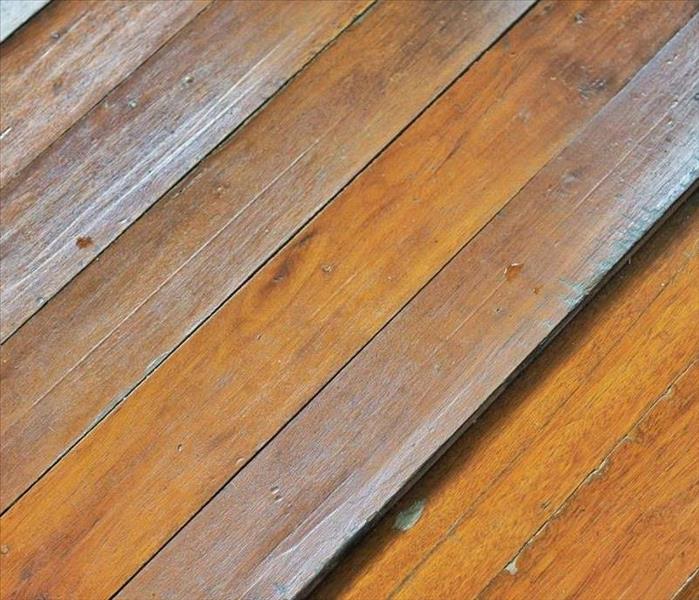 Water damage in the workplace may not only prevent you from doing business.
Water damage in the workplace may not only prevent you from doing business.
Water damage in the workplace may not only prevent you from doing business. It can also put the health and safety of your employees at risk. The moment you spot signs of commercial water damage, it’s important to take action immediately.
Commercial water damage restoration is often more complex than residential water damage restoration and usually requires an intensive approach. The size and structure of commercial buildings, the extent of damage, the varying uses of space, and the number of occupants all affect the restoration process. Aside from these, there’s usually always a time constraint for the job because business has to continue as soon as possible.
While some water damage issues are inevitable, most problems can be prevented when the cause of water damage is found earlier.
In this post, we’ll talk about the most common causes of water damage in commercial properties and how to deal with them.
CAUSES OF COMMERCIAL WATER DAMAGE
Here are the common causes of commercial water damage:
DAMAGED WINDOWS
In commercial buildings, water damage is often caused by windows that are not properly sealed. Damaged windows can cause moisture to seep in, which triggers a lot of problems including mold build-up and warped wood and drywall. Resealing windows regularly is important as caulk can break down over time.
DAMAGED PIPES
Causes of Commercial Water Damage
Broken pipes can stem from many reasons, such as changes in pressure, deteriorated water supply lines and sewer drains, and cold weather (freezing temperature can cause pipes to burst). Bulging walls, water stains on walls or floors, cracked or loose tiles, and musty smell – these are all signs of damaged pipes. Detecting leaky pipes is challenging and it usually requires some specialized water leak detection equipment.
BUILDING FOUNDATION
If gutters are not cleaned regularly, they can get clogged, causing water to leak into the property through the roof or the foundation. One of the most common signs of leaks in building foundations are puddles nearby or framing that has become wet. Poor drainage systems can also lead to water damage in your foundation.
ROOF LEAKS
A leaky roof can cause ceiling damage, mold or mildew issues, fire hazards from shortened wires, and compromised structural integrity. Exposure to heavy rains and snow make roofs vulnerable to damage. Moreover, incorrect snow/ice removal can also trigger water damage in roofs.
HVAC PROBLEMS
HVAC systems work by heating or cooling the air through a series of ducts. Over time, these ducts wear out and get damaged, resulting in leaks. The HVAC system needs to be cleaned regularly and the excess water from the condensation reservoirs has to be removed to prevent water damage.
SEWER CLOGS
Sewer water contains bacteria and other pathogens that cause illnesses and infections. If you see signs of sewage damage, such as gurgling sounds or water backing up out of the drain or toilet, you should call water damage and restoration professional immediately.
SPRINKLER SYSTEM LEAKS
Other causes of water damage in commercial buildings are leaks in sprinkler systems. Signs of sprinkler leaks include wet surfaces like drywall and carpets, presence of mold and mildew, and standing water. Regularly inspect your sprinkler systems for leaks and moisture.
COMMERCIAL WATER DAMAGE PREVENTION
Commercial water damage restoration
Taking the necessary measures to prevent water damage can save you from costly repairs and business interruption in the future. Since water damage can come from a variety of sources, it’s essential to have the building inspected regularly to prevent leaks and related issues.
CREATE A FLOOD MONITORING SYSTEM
Regardless of whether your business is located in a flood-prone area, make sure you have an efficient flood warning system in place. Flooding can result from other causes, including plumbing failures, overflowing rivers, and melting snow.
GET ENOUGH COVERAGE FOR YOUR PROPERTY
Flooding is not usually included in property insurance policies. Water damage restoration can be very expensive. Water damage insurance can you deal with the costs if ever your property gets damaged by a flood in the future.
CONDUCT A WATER DAMAGE INSPECTION REGULARLY
Water damage prevention is a lot cheaper than restoration. To prevent water damage from getting worse, have professionals inspect your property at least once a year. Leak detection is performed in several ways, such as humidity monitoring and the use of spot sensors.
INVEST IN FACILITY MAINTENANCE
A preventative maintenance plan should keep your commercial building safe and secure and contribute to your water leak prevention efforts. Different parts of a commercial building should be inspected at different intervals. For example, doors, windows, and gates should be checked each year for weariness while the roof can be coated every five years or so to prevent damage.
COMMERCIAL WATER DAMAGE AND MOLD
Commercial Water Damage and Mold
Water damage and mold go hand in hand.
One of the most common effects of water damage in commercial buildings is mold and mildew build-up. It only takes 24-48 hours of exposure to water damage before these dangerous microorganisms start growing.
To stop mold growth, the source of water damage should be fixed right away. It’s to hire emergency water damage restoration professionals to conduct commercial mold cleanup and mold mitigation to ensure that no trace is left.
COMMERCIAL WATER DAMAGE RESTORATION
Commercial water damage restoration is a job that is handled by professionals. Make sure to hire restoration contractors who have water damage restoration certification, like SERVPRO.
Fire Safety Equipment: Five Pieces You Need for Your Home
3/30/2021 (Permalink)
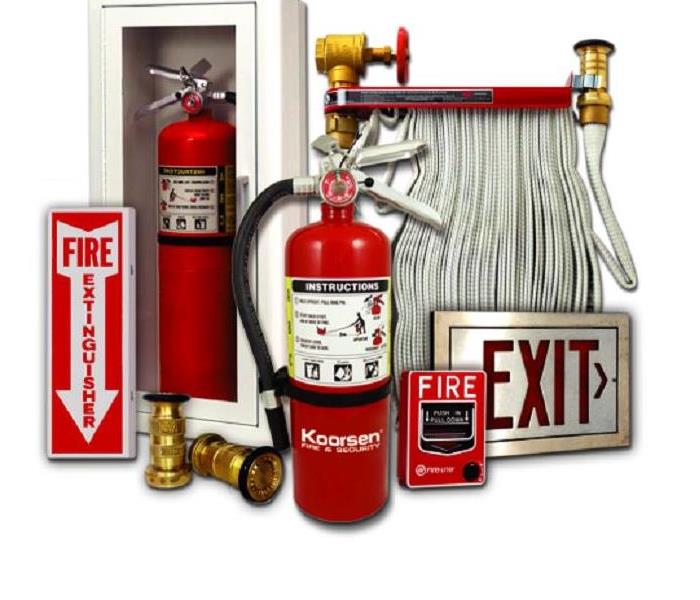 Our homes may be our sanctuaries, but they also present multiple opportunities for fire danger.
Our homes may be our sanctuaries, but they also present multiple opportunities for fire danger.
Our homes may be our sanctuaries, but they also present multiple opportunities for fire danger. An unattended stovetop can result in a kitchen fire, while electrical systems and appliances can overheat. Fireplaces, candles, flammable liquids, and outdoor grills — to name just a few — all add to the risk.
Having the correct fire safety equipment in your house is essential to keep your family safe and your home protected. This article highlights the five most important pieces of equipment needed to safeguard your home and loved ones. The peace of mind that comes from knowing you’re prepared is worth the time, effort, and expense involved.
- Smoke Alarms
This is your first line of defense. According to the Red Cross, the National Fire Alarm Code (NFPA 72) requires all new homes to have inter-connected hard-wired smoke alarms with battery backup. If you don’t have an interconnected system, battery-powered alarms are easily installed. Both types of alarms need to be located on every level of the home with one inside each bedroom.
4 important rules for smoke alarms:
- Never disable them – even if they go off when they shouldn’t.
- Check them once a month using the test feature.
- Replace the batteries at least once a year.
- Replace the alarm every 10 years as older alarms may not perform properly
- Fire Extinguishers
Since most home fires start in the kitchen, you’ll want to put a fire extinguisher in there, at a minimum. But it’s recommended to place them in multiple locations around the house. Since extinguishers from various makers all work differently, it’s a good idea for the adults in the household to get training from the local fire department. Extinguishers should be installed near exits, away from heat sources, and up high enough that kids can’t reach them.
- Sprinkler Systems
While a smoke alarm will detect smoke, an automatic sprinkler system gives you a way of dealing with flames immediately. While you’re waiting on the fire department to arrive, sprinklers can help slow a fire’s progress or can even douse it completely. Moreover, a sprinkler system can prevent deadly gases and smoke from affecting your family and could also extinguish a fire that breaks out while you’re away from home.
- Carbon Monoxide Alarms
There’s a good reason carbon monoxide (CO) is called the “silent killer.” This deadly gas is invisible, odorless, and colorless and even a small amount can be fatal if inhaled for long enough. Install carbon monoxide alarms on each level of your home and outside bedrooms. If the alarm emits its high-pitched warning, get outside as quickly as possible or open windows and doors and take deep breaths of fresh air. CO poisoning can cause headaches, nausea, and tiredness and can be mistaken for flu.
- Fire Escape Ladders
If your home has more than one floor, collapsible fire ladders should be a part of your fire-safety arsenal. Place a ladder where it’s easy to access in every upper-level room in case your evacuation route gets cut off by smoke or fire. Then, have the entire family rehearse the steps they would take to get the ladders out and attached to open windows.
No one wants to dwell on the possibility of their family being in danger or their home being consumed by flames, but this is one situation where being properly prepared could save lives and property. If you haven’t already done so, make an escape plan and go over it with your family. And check your homeowner’s insurance to make sure your policy is up to date with adequate coverage.
Be Prepared to Stay Safe and Healthy in Winter
3/16/2021 (Permalink)
 Winter storms and cold temperatures can be dangerous.
Winter storms and cold temperatures can be dangerous.
Winter storms and cold temperatures can be dangerous. Stay safe and healthy by planning ahead. Prepare your home and vehicles. Prepare for power outages and outdoor activity. Check on older adults.
Although winter comes as no surprise, many of us may not be ready for its arrival. If you are prepared for the hazards of winter, you are more likely to stay safe and healthy when temperatures start to fall.
Prepare Your Home
Staying inside is no guarantee of safety. Take these steps to keep your home safe and warm during the winter months.
- Winterize your home.
- Install weather stripping, insulation, and storm windows.
- Insulate water lines that run along exterior walls.
- Clean out gutters and repair roof leaks.
- Check your heating systems.
- Have your heating system serviced professionally to make sure that it is clean, working properly, and ventilated to the outside.
- Inspect and clean fireplaces and chimneys.
- Have a safe alternate heating source and alternate fuels available.
- If you do not have a working smoke detector, install one. Test batteries monthly and replace them twice a year.
- Prevent carbon monoxide (CO) poisoning emergencies.
- Install a CO detector to alert you of the presence of the deadly, odorless, colorless gas. Check or change the battery when you change your clocks in the fall and spring.
- Learn the symptoms of CO poisoning: headache, dizziness, weakness, upset stomach, vomiting, chest pain, and confusion.
Get your vehicle ready for cold weather use before winter arrives.
Prepare Your Vehicle
Get your vehicle ready for cold weather use before winter arrives.
- Service the radiator and maintain antifreeze level.
- Check your tires’ tread or, if necessary, replace tires with all-weather or snow tires.
- Keep the gas tank full to avoid ice in the tank and fuel lines.
- Use a wintertime formula in your windshield washer.
- Prepare a winter emergency kit to keep in your car in case you become stranded. The kit should include:
- Cell phone, portable charger, and extra batteries;
- Items to stay warm, such as extra hats, coats, mittens, blankets, or sleeping bags;
- Food and water;
- Booster cables, flares, tire pump, and a bag of sand or cat litter (for traction);
- Compass and maps;
- Flashlight, battery-powered radio, and extra batteries;
- First-aid kit; and
- Plastic bags (for sanitation).
Prepare for Emergencies
Be prepared for weather-related emergencies, including power outages.
- Stock food that needs no cooking or refrigeration and water stored in clean containers.
- Ensure that your cell phone is fully charged.
- When planning travel, be aware of current and forecast weather conditions.
- Keep an up-to-date emergency kit, including:
- Battery-operated devices, such as a flashlight, a National Oceanic and Atmospheric Administration (NOAA) Weather Radio, and lamps;
- Extra batteries;
- First-aid kit and extra medicine;
- Baby items; and
- Cat litter or sand for icy walkways.
- Protect your family from carbon monoxide (CO).
- Keep grills, camp stoves, and generators out of the house, basement and garage.
- Locate generators at least 20 feet from the house.
- Leave your home immediately if the CO detector sounds, and call 911.
Wear appropriate outdoor clothing: layers of light, warm clothing; windproof coat, mittens; hats; scarves; and waterproof boots.
Take Precautions Outdoors
Outdoor activities can expose you to several safety hazards, but you can take these steps to prepare for them:
- Wear appropriate outdoor clothing: wear a tightly woven, preferably wind-resistant coat or jacket; inner layers of light, warm clothing; mittens; hats; scarves; and waterproof boots.
- Sprinkle cat litter or sand on icy patches.
- Learn safety precautions to follow when outdoors.
- Work slowly when doing outside chores.
- Take a buddy and an emergency kit when you are participating in outdoor recreation.
- Carry a cell phone.
Do This When You Plan to Travel
When planning travel, be aware of current and forecast weather conditions.
- Avoid traveling when the National Weather Service has issued advisories.
- If you must travel, inform a friend or relative of your proposed route and expected time of arrival.
- Follow these safety rules if you become stranded in your vehicle.
- Make your vehicle visible to rescuers. Tie a brightly colored cloth to the antenna, raise the hood (if it is not snowing), and turn on the inside overhead lights (when your engine is running).
- Move anything you need from the trunk into the passenger area. Stay with your vehicle unless safety is no more than 100 yards away.
- Keep your body warm. Wrap your entire body, including your head, in extra clothing, blankets, or newspapers. Huddle with other people if you can.
- Stay awake and stay moving. You will be less vulnerable to cold-related health problems. As you sit, keep moving your arms and legs to improve circulation and stay warmer.
- Run the motor (and heater) for about 10 minutes per hour, opening one window slightly to let in air. Make sure that snow is not blocking the exhaust pipe—this will reduce the risk of carbon monoxide (CO) poisoning.
Be ready to check on family and neighbors who are especially at risk from cold weather hazards: young children, older adults, and the chronically ill.
If you have pets, bring them inside. If you cannot bring them inside, provide adequate, warm shelter and unfrozen water to drink.
No one can stop the onset of winter. However, if you follow these suggestions, you will be ready for it when it comes.
Please follow our page, as we continue to explore the benefits of mitigation, and how this approach helps both your clients and your business. Please call us with any questions you have, 715-381-2266. Visit our site: SERVPRO of The Saint Croix Valley
When It Rains, It Pours
3/16/2021 (Permalink)
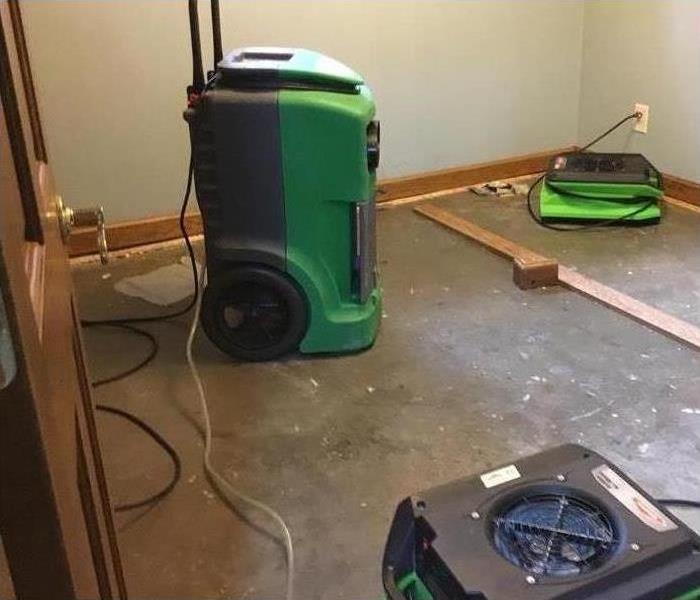 A property loss to your home is a stressful event, and it can seem like the end of the world.
A property loss to your home is a stressful event, and it can seem like the end of the world.
It has been raining for three days straight and you feel like you should have webbed toes by now. By the end of the third day, you come home from a long day at work and all you want to do is relax in your newly finished basement. That’s when you walk down the stairs and step on the carpet. You feel a squish between your toes. It's not that normal warm and fuzzy feeling, but rather that cold and wet feeling. The saturation of water outside from the rain found a way into your basement, soaking your drywall and carpet. You ask yourself, ugh, what to do now?
You have a few options:
- Try to run fans and dehumidifiers and try to manage the water yourself. Saves money up front, but could lead to major problems later in the year with potential mold issues or degrading of the building materials.
- You could bring a contractor into the project. Contractors do fabulous work, however, they may tend to demo more of the area than is needed, as water restoration work is not their area of expertise.
- Call a Mitigation company like SERVPRO of The Saint Croix Valley to evaluate the loss. Once mitigation begins, materials that can be saved are salvaged and dried. Portions that cannot be salvaged are removed, and instead of replacing whole sheets of drywall, you have a cost savings of only replacing what was damaged.
A property loss to your home is a stressful event, and it can seem like the end of the world. SERVPRO understands these feelings and is able to mobilize quickly to start mitigation work 24 hours a day, 7 days a week. The faster stabilization work begins on the loss, the likelihood of saving materials is increased.
5 Quick Cleaning Tips That Can Boost Productivity at Work
3/16/2021 (Permalink)
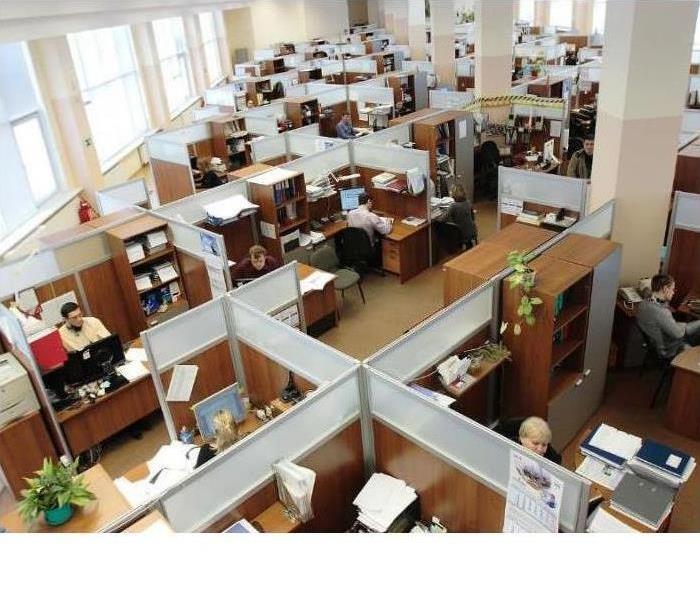 It’s a well-known fact that a neat and tidy office increase productivity.
It’s a well-known fact that a neat and tidy office increase productivity.
It’s a well-known fact that a neat and tidy office increases productivity. Not to mention, keeping your office clean of germs will discourage employees from calling in sick. Giving your office a deep Spring Cleaning will help boost your productivity and give your office the look it needs to attract the best customers.
If you are looking to clean your office yourself, these are the top 5 things you can do to keep your office clean in order to ensure and increase productivity.
Clean your phones!
Phones are a cesspool of germs. When your employees get sick, productivity declines. If they miss work due to sickness, it becomes an even bigger problem. Cleaning your phones daily with an anti-bacterial wipe is the number one way to ensure phones are germ free and your employees are healthy.
Get rid of that smell!
Floors and carpets that are not properly cleaned will absorb bad smells. It’s proven that certain smells, such as orange, increase energy and productivity. Working in an environment that doesn’t smell good is a factor that declines worker morale. Cleaning and shampooing your carpets will guarantee this problem is corrected. You can rent a carpet vacuum and risk the chance of harboring mold under the damp carpets, or you can call a commercial cleaning service, who may be better equipped to handle that kind of situation.
Keep desks dust free!
Dust carries many allergies which cause a lot of people to get sick. Not to mention, working in a dirty space declines staff morale. Dusting your commercial space, as well as all of the desks every night is very important. It's also important to move all the supplies off a desk and wipe the desks once a week.
Sweep that floor!
Working in an office space that is cluttered or dirty does not help increase productivity. On the contrary, it decreases productivity. It is also something that may turn off prospective customers. Sweeping floors every night is imperative to having a clean and put-together office. First appearances are very important and if a customer sees a dirty floor, they may not trust your product or service.
Empty the trash!
Full trash cans attract little critters. Especially trash cans full of snack and lunch wrappers. Emptying the trash daily is very important when it comes to maintaining the productivity in an office. An employee working in an area that smells like a garbage bin won’t be as focused and productive as one working in an office with fresh air.
SERVPRO is Here to Help During This Time of Need
3/12/2021 (Permalink)
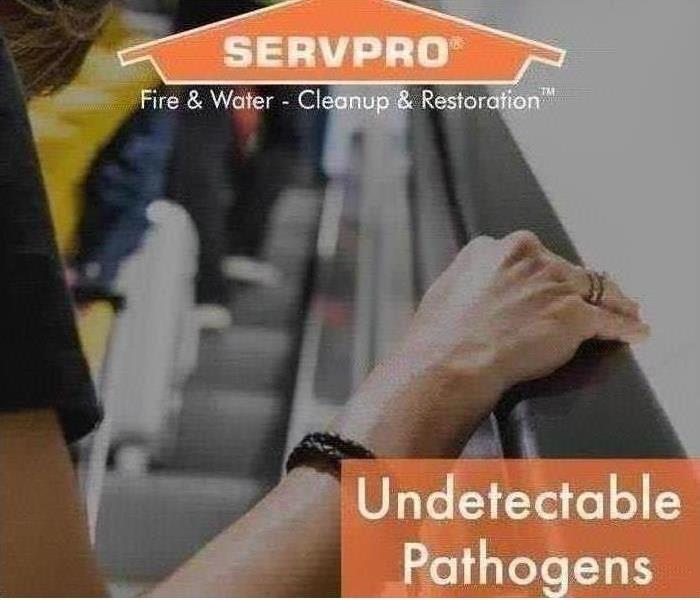 We are prepared to clean and disinfect your home or business.
We are prepared to clean and disinfect your home or business.
During this unprecedented time caused by the global pandemic of corona virus, this is a reminder to our customers that we are specialists in cleaning services, and we adhere to the highest cleaning and sanitation standards.
Specialized Training
We are prepared to clean and disinfect your home or business, according to protocols set forth by the Centers for Disease Control and Prevention. We have years of experience in dealing with biological contaminants, and we will go beyond the scope of work that regular janitorial staff perform on a daily basis.
The CDC encourages cleaning of high-touch surfaces such as counters, tabletops, doorknobs, light switches, bathroom fixtures, toilets, phones, keyboards, tablets and tables. Other spaces mentioned in the CDC’s guidance for commercial spaces include:
- Kitchen/Food Areas
- Bathrooms
- Schools/Classrooms
- Offices
- Retail Spaces
- Water Fountains
- Shelving/Racks
- Sales Counters
- Carpets and Rugs
- Stair Handrails
- Elevator Cars
- Playground Equipment
- Fitness Equipment
Specialized Products
The CDC recommends usage of a labeled hospital-grade disinfectant with claims against similar pathogens to the corona virus. Multiple products in the SERVPRO product line carry the EPA-approved emerging pathogens claims. While there is currently no product tested against this particular strain of the corona virus, we are following all guidelines as provided by the CDC and local authorities.
Severe Weather Season Is Almost Here
3/12/2021 (Permalink)
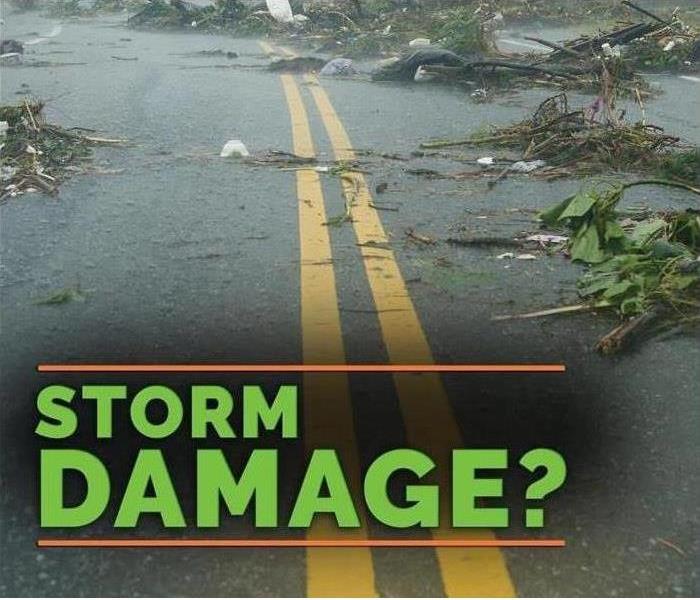 How do you secure your home and processions from further damage? Call in a mitigation company.
How do you secure your home and processions from further damage? Call in a mitigation company.
You are resting peacefully, when you are abruptly awoken by the storm sirens going off. You rush your family down to the basement to hunker down as the storm hits. Wind, rain, hail and lightning strikes, damaging window and roofs, starting fires. In the light of day you emerge with your family safe, but your home is damaged. Your roof is partial damaged and missing, the hail and blowing debris has smashed in windows. What do you do next? Call your insurance company, but knowing that a wide area of local community has been hit, it may take time for an adjuster to get to you home. How do you secure your home and processions from further damage? Call in a mitigation company.
A company like SERVPRO can be called into the disaster to start securing the homes in businesses in the area. What does that mean? Tarping and sealing that open roof, and board the broken windows. Why, because the first step is to stabilize the structure. The faster a building can be secured, and the environment inside that building can be stabilize the sooner mitigation can start. The sooner that mitigation is started, the more of the structure and personal procession can be saved. Once the mitigation is completed, the sooner reconstruction can start and the faster you can get back to living your life.
SERVPRO ERP, the Bridge to Your Business Continuity Plan
3/12/2021 (Permalink)
 SERVPRO offers all commercial, educational, and governmental buildings a free Emergency Readiness Plan.
SERVPRO offers all commercial, educational, and governmental buildings a free Emergency Readiness Plan.
SERVPRO offers all commercial, educational, and governmental buildings a free Emergency Readiness Plan, which includes a walkthrough of the building and a report in both hard and digital copies. Which can be accessed on any mobile device, anywhere and anytime. 70% of businesses go out of business after a major disaster to the physical business, and of the 30% that make it through the disaster only half have some kind of plan in place. And that 50% is who this article is directed at.
When I sit down and chat with businesses, nursing homes, schools, city governments, or hospitals that all have some sort of plan in place they don’t initially see the value in having SERVPRO put together an ERP for them. That’s when I ask about their plan, and usually get the same types of answers: “Our employees will work remotely.” “Our residents and staff will be moved to another facility.” “Why reinvent the wheel?" And more answers along the same lines. All having to do with continuing work.
That’s when I ask the question, well how do you plan on stabilizing the building once the disaster is under control? How do you plan on securing the premises and contents of the building? What if you as the owner or decision maker aren’t available, will the employees know how to contact the next person in line, or your insurance agent. Do they even know where the binder with the master plan is kept, and if you are at the scene, will you be able to get to it. That’s why it’s nice to have an app on your phone that you can access with ease.
If a company already has a continuity plan in place, the SERVPRO ERP is a great bridge to get your organization stable and into the plan you have in place for situations that stop you from working as normal. The faster a damaged building can be secured and mitigation can be put in place, the more of the building that can be saved and the faster the reconstruction can begin. If your business does not already have a plan in place, the ERP is a great base to build your plan from.
4 FAQs on Flammable Gas Safety
3/11/2021 (Permalink)
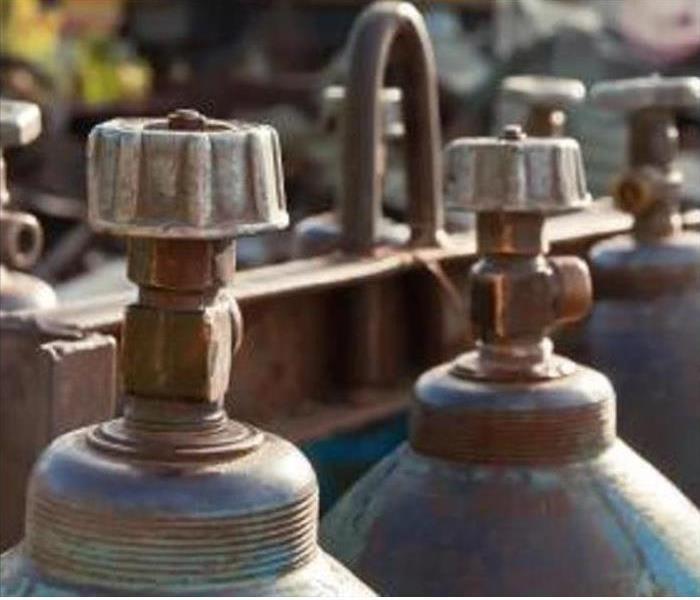 Propane, hydrogen, butane, ethylene, and other flammable, compressed gases present hazards without the right precautions.
Propane, hydrogen, butane, ethylene, and other flammable, compressed gases present hazards without the right precautions.
Propane, hydrogen, butane, ethylene, and other flammable, compressed gases present hazards without the right precautions. While fire safety maintenance will help you avoid trouble, you should also understand how to handle and store gas cylinders. Here’s what to know to keep your facility safe.
Common Questions About Flammable Gases
Can I store containers outdoors?
Yes, as long as the manufacturer's instructions permit outdoor storage. Closely follow the guidelines on all cylinder labels. If a label is missing or damaged, you may need to call the manufacturer.
Cylinders stored outdoors must remain upright on compacted, level surfaces. These should be far away from drainage areas, manholes, or other openings. Use an open-sided enclosure with a weatherproof roof to protect the cylinders from sunlight, snow, and other elements.
What about indoor storage?
Fire safety maintenance. Indoor storage is also possible as long as you follow all ventilation guidelines outlined by the manufacturers. Store the gases in a separate building that has noncombustible structural components that resist fire for at least 120 minutes. The area should also have lightweight roofing and explosion vents.
Keep gases on the ground floor and place electrical wiring outside of the building to further limit the chances of fires and explosions.
What are the best materials for securing the cylinders?
Unrestrained cylinders could roll away or fall, so you must keep them secure. Use specialized chains, straps, and bungee cords. Refer to the label or manufacturer’s instructions for information on how to secure the units.
How should I handle the cylinders?
Inspect all items before handling. Do not handle any cylinder that has dents, severe corrosion, or other visible signs of damage. Avoid contact if you notice grease, oil, solvent, or dirt, which could cause explosions.
Open cylinder valves only with the manufacturer-provided key, and ensure you are working away from all heat sources. You must also have fire safety equipment within reach and follow all other manufacturer’s guidelines, such as opening specific valves if you’re working with an irritating gas
Please follow our page, as we continue to explore the benefits of mitigation, and how this approach helps both your clients and your business. Please call us with any questions you have, 715-381-2266. Visit our site: SERVPRO of The Saint Croix Valley
Fire Damage Restoration Process
3/11/2021 (Permalink)
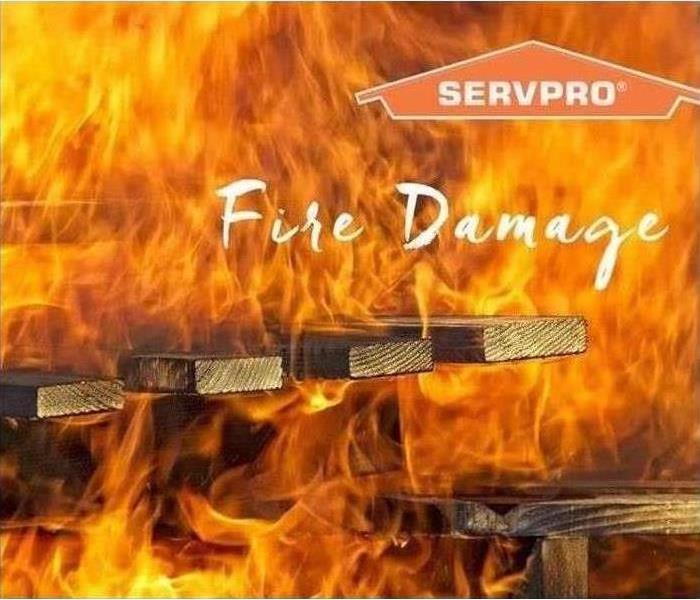 Every fire damage event is a little different, and requires a unique solution,
Every fire damage event is a little different, and requires a unique solution,
Every fire damage event is a little different, and requires a unique solution, but the general process stays the same. The steps listed below illustrate our process for the “typical” fire damage emergency.
Step 1: Emergency Contact
The restoration process begins when you call the SERVPRO Customer Care Center, which is staffed 24 hours a day. Our specialist will ask a series of questions regarding the fire damage event that will help us dispatch the nearest SERVPRO Franchise Professional with the appropriate equipment and resources.
Step 2: Inspection and Fire Damage Assessment
Our Professionals will carefully inspect and test adjoining rooms of your property to determine the extent of the fire, smoke, and soot damage. This step is crucial to developing a plan of action.
Step 3: Immediate Board-Up and Roof-Tarp Service
Fire damage can often compromise windows, walls, and roofs. To maintain security and to protect against further damage, the SERVPRO Franchise Professional can board up missing windows and walls and place tarps on damaged roofs.
Step 4: Water Removal and Drying (if water damage is present)
The water removal process begins almost immediately and removes the majority of the water. They will then use dehumidifiers and air movers to remove the remaining water and complete the drying process.
Step 5: Removal of Smoke and Soot from All Surfaces
The SERVPRO Franchise Professionals use specialized equipment and techniques to remove smoke and soot from ceilings, walls, and other surfaces.
Step 6: Cleaning and Sanitizing
They will clean all of the restorable items and structures that were damaged by the fire. They use a variety of cleaning techniques to restore your belongings to pre-fire condition. They’re also trained to remove odors using industrial air scrubbers and fogging equipment.
Step 7: Restoration
Restoration is the final step—getting your home or business to its pre-fire condition. Restoration may involve minor repairs, such as replacing drywall, painting, and installing new carpet; or it may entail major repairs such as the reconstruction of various areas or rooms in a home or business.
Please follow our page, as we continue to explore the benefits of mitigation, and how this approach helps both your clients and your business. Please call us with any questions you have, 715-381-2266. Visit our site: SERVPRO of The Saint Croix Valley
Not So Pleasant Home Away from Home
3/11/2021 (Permalink)
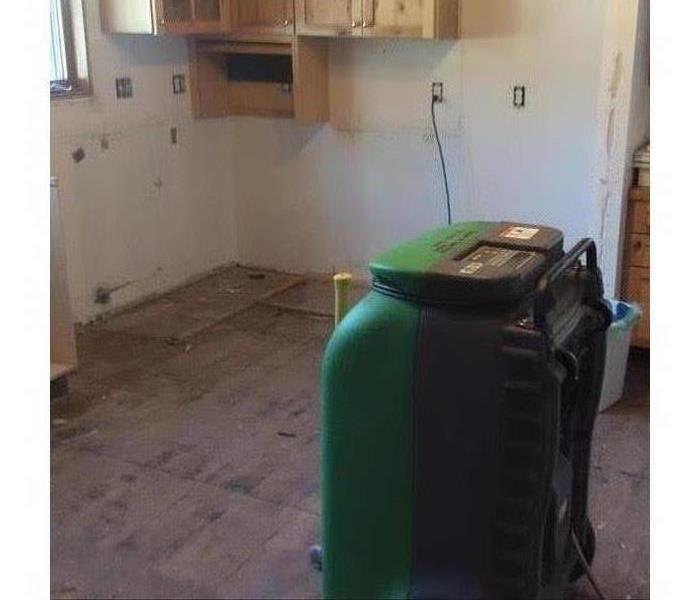 What do you do?
What do you do?
For most people that are fortunate enough to own a cabin up north, or a second vacation home, the thought of getting away is filled with thoughts of unplugging, relaxing and family time. Unfortunately, that wasn’t the case for one of our recent clients. When they arrived at their second property to enjoy a few days of quiet, they opened a door to a home full of water damage and mold.
What do you do? You are far from home, and don’t really know the area. Luckily for these clients we had been in the area a few months prior, and their neighbor we worked for gave our number to them. We were able to coordinate with their insurance adjuster, and work out the cause of the damage and scope of the project. It was discovered after we brought in a local HVAC provider that the heating core on the furnace had cracked, causing the temperature inside the house to drop, and allowed the water line to freeze and burst.
Before we could stabilize the environment in the home, we needed to get heat back into it. That is where we helped the client coordinate with the HVAC company to bring in and install a new furnace. Once in, we were able to stabilize the climate and coordinate with a mold testing vendor to determine the appropriate course of action to mitigate the mold. Once the area was properly cleaned, including cleaning the duct system, and damaged areas removed a contractor was able to come in and start the rebuild.
Please follow our page, as we continue to explore the benefits of mitigation, and how this approach helps both your clients and your business. Please call us with any questions you have, 715-381-2266. Visit our site: SERVPRO of The Saint Croix Valley
Follow These Tips to Prevent Spring Thaw Flooding
2/26/2021 (Permalink)
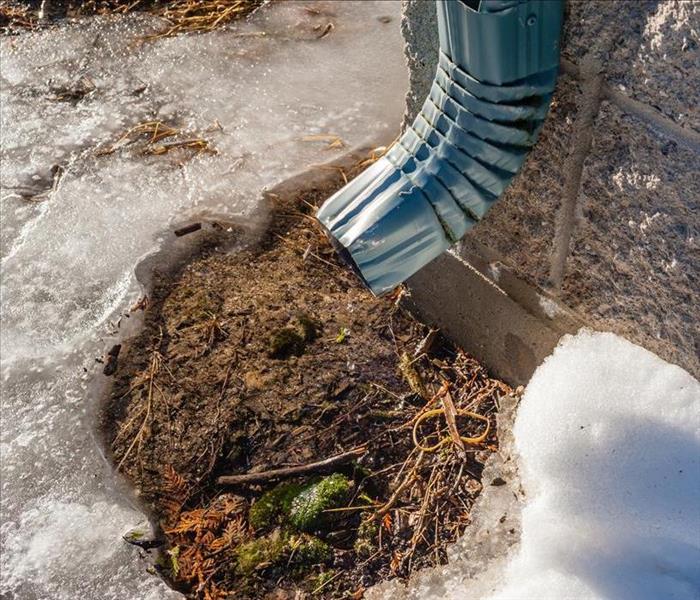 The combination of heavy rains and rapid snow thaw can result in severe home flooding.
The combination of heavy rains and rapid snow thaw can result in severe home flooding.
Spring is notorious for its unpredictable weather. The combination of heavy rains and rapid snow thaw can result in severe home flooding. Here are vital tips to prepare your home for spring thaw and prevent water damage:
- Remove snow around your house with a shovel so that thawed snow will drain away from your home. Also, remove obstructions or debris that could prevent water from being carried away from your house.
- Check your home’s drainage. Ensure that flood drains outside your house are not obstructed by debris. Check that the floor drains in your home are unobstructed as well. Roof drains should be open and flow freely.
- Maintain gutters and downspouts. Backed up gutters and downspouts are likely to cause overflows and flooding. Remove debris, ice, and snow from gutters and downspouts so water can freely move away from your home.
- Have your roof inspected to ensure that it is prepared for storms and to keep water out of your house.
- Install water alarm and flood sensors if your home is prone to flooding. These devices are designed to send an alert when they detect unwanted water in the home.
- Elevate items in the basement. Relocate sensitive items, such as documents or electronics to the upper levels of your home. If you can’t move items from the basement, move them off the ground and onto shelves or pallets.
- Install a sump pump in the basement. Sump pumps protect your basement from flooding by removing excess water around your home’s foundation, transporting it safely outside. If you already have a sump pump, make sure it is clean and the intake valve is clear. Test the sump pump to ensure it’s in proper condition.
- Purchase flood insurance ahead of time. Most homeowners’ policies do not include flood damage so it’s important to purchase this protection separately.
Oh Boy, My Pipes Froze This Winter
2/10/2021 (Permalink)
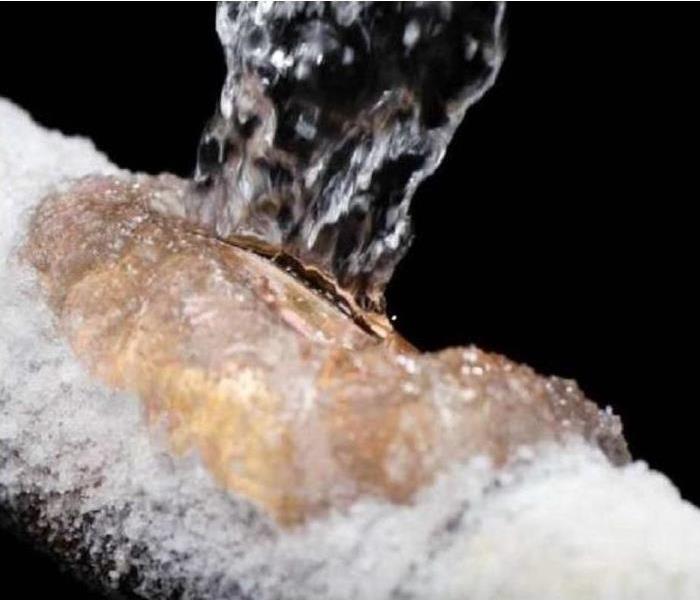 Don't wait for Spring Surprises.
Don't wait for Spring Surprises.
You’ve made it to the end of another winter of cold long nights. You didn’t have to call out SERVPRO because you took care of the snow on your roof and stopped the ice dam build up. You kept the heat in the house above 55 degrees all winter and turned off your water when you went on that tropical vacation in January.
It’s time to start the clean up the spring and summer seasons. You hook up your hose to your pressure washer to clean the winter grime off your gutters and eaves. Pull the trigger on the pressure washer and, nothing happens. That’s when you realize that you don’t have any water pressure, but where is the water going.
You turn off the outside facet and run downstairs, to find that water has been running into you finished man cave basement. The one thing you didn’t check was the pipe running to that outside facet, and you may have forgotten to open the facet to run the rest of the water out of it when you shut the source off. It’s pretty common and we aren’t surprised that it happened, we get quite a few calls at SERVPRO in the spring in early summer about this exact same thing.
Please follow our page, as we continue to explore the benefits of mitigation, and how this approach helps both your clients and your business. Please call us with any questions you have, 715-381-2266. Visit our site: SERVPRO of The Saint Croix Valley
3 Top Causes of Winter Water Damage
2/10/2021 (Permalink)
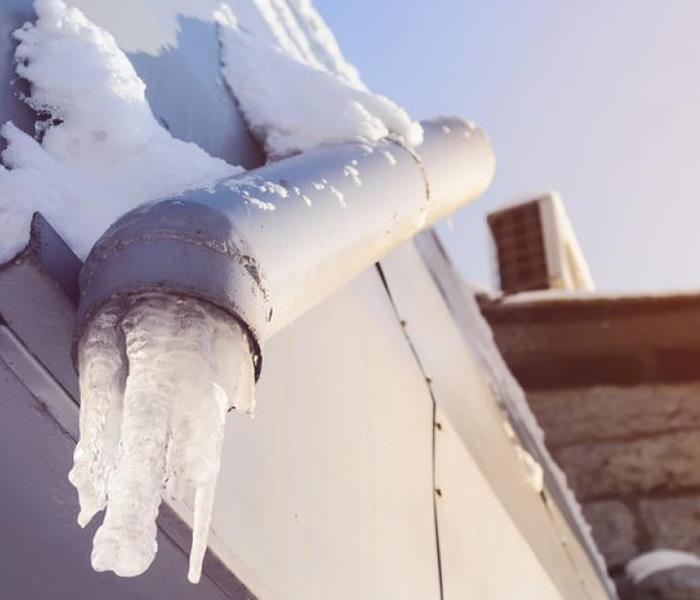 Residential Homes Are Especially Vulnerable to Water Damage
Residential Homes Are Especially Vulnerable to Water Damage
Winter brings along with its chilling temps a host of water damage possibilities. Residential homes are especially vulnerable to water damage during the winter season. Three main types of winter water damage are common when the weather is below freezing. Burst pipes are one of the top sources of water damage that can be prevented. Roof leaks are an enormous burden, which, again, with proper attention, can be stopped before transforming into an expensive repair. Outdoor water sources can also be a likely source of winter water damage when left unattended.
Burst Pipes Are Commonplace
Pipes, whether plastic or metal, are notorious for bursting in subfreezing temps. Contrary to popular assumption, pipes rarely burst due to expanding ice contained within them. Rather, pipes break due to the buildup of water pressure between a sink’s faucet and an ice blockage. No matter how sturdy a pipe may be, it’s no match for expanding water. The pipe will rupture.
Typically, the pipes that are especially prone to breakage are uninsulated ones that are located along the exterior walls and water pipes that run along unheated areas of a home, like the attic, basement, garage, crawl space or underneath a kitchen sink.
Insulation is the number one protection against a burst pipe. Prior to winter, inspect all areas of your home that contain unheated water supply lines. Pipe sleeves can easily be purchased and fitted to the pipes in the garage, under the sink and beneath the bathroom cabinets. If pipe sleeves are unavailable, experts recommend using a quarter-inch of newspaper to surround the pipes, which offers an equally effective solution against the damage caused by sustained freezing temperatures.
Maintain a cozy indoor temperature to prevent frozen pipes. Especially when you are away, run the heat continuously at no less than 55 degrees Fahrenheit. Experts also suggest maintaining a consistent temperature throughout the home. (This is costlier than turning down the heat at night, but it may prevent an even more expensive broken pipe fix.) Another tried and true method to prevent a split in your water pipe is to let the faucet trickle small amounts of water. Dripping even the tiniest volume of water during subfreezing temperatures allows the water to run through the pipe without freezing. Unheated compartments of a home can also benefit from warm air. A winter weather defense strategy like this can be achieved by leaving open the kitchen cupboards and bathroom cabinets to allow warm air to circulate around the pipes. Lastly, keep garage doors closed if water lines run through them.
When water pipes are frozen, they can be thawed. Apply a towel soaked in hot water around the frozen pipes to gently thaw the freeze. An electrical heating pad will do the trick, just as well. Also, keep the faucet running, which allows the flowing water to gradually melt the ice.
Prevent Gutter Blocks to Protect Your Roof
Gutters are invaluable in directing running water away from your home. When gutters freeze, however, or are blocked by ice, they can end up being rather destructive. A home’s gutter system can get weighed down by ice buildups. When the snow along the roof melts from heat that escapes from inside the home and trickles into the gutter, it pools and freezes into what is known as an ice dam. Snow that melts from the home’s internal heat is a key indication that there is a lack of proper insulation.
Ice dams along the gutter put unnecessary stresses on a roof. Water can infiltrate underneath the roof shingles, lifting them up and causing roof damage. Roof leaks are the result. Once a leak happens, you may find unsightly water marks along your home’s ceilings or drips that cascade into your home’s interior—both causes for concern.
When you detect a faulty shingle, take immediate action to replace it, especially prior to the winter season. It’s more cost effective to replace worn shingles as you find them, rather than replacing an entire roof.
Observing your home’s gutters and grading during dry or rainy weather and before winter helps to ensure your roof is properly prepped for winter.
Outside Water Sources Can Spell Disaster
When the first snowflakes fall, it’s far easier to enjoy its splendor than it is to remember what’s left on the ground underneath the snow. Outside water sources can be irksome when subject to subfreezing weather.
Be sure to remove all outdoor hoses from the yard. Drain them and store the dry hoses inside. Plus, shut off valves that supply water to the outdoors. All hose bibs should be opened to allow any remaining water to drain. Experts suggest leaving the outside valve open so that any excess water has enough room to expand without breaking the pipes.
When a water pipe in your home’s plumbing system unexpectedly bursts, surges of water end up penetrating the surrounding areas at breakneck speeds. As a homeowner, you’re left with puddles of water and the likelihood of mold infestations to clean up. Or, perhaps a roof has finally given in during the dead of winter, resulting in drips of water that causes property ruin within minutes.
Water Damage Restoration
Despite all preventive measures, disasters tend to occur. When an emergency happens, contact a professional water damage restoration company, like SERVPRO. Specialists from companies like ours are well-equipped to drain all excess moisture from homes and businesses in substantially less time than a standard dehumidifier. It is crucial to remove standing water immediately, due to the growth of mold and bacteria that occurs within hours.
Water damage restoration technicians use advanced meters to detect the level of water damage. Air movers and other high-tech equipment are used to thoroughly dry out the affected areas.
Our specialists will quickly return your home to its pre-damaged condition.
Please follow our page, as we continue to explore the benefits of mitigation, and how this approach helps both your clients and your business. Please call us with any questions you have, 715-381-2266. Visit our site: SERVPRO of The Saint Croix Valley
Soon It Wil Be Melting Season
2/10/2021 (Permalink)
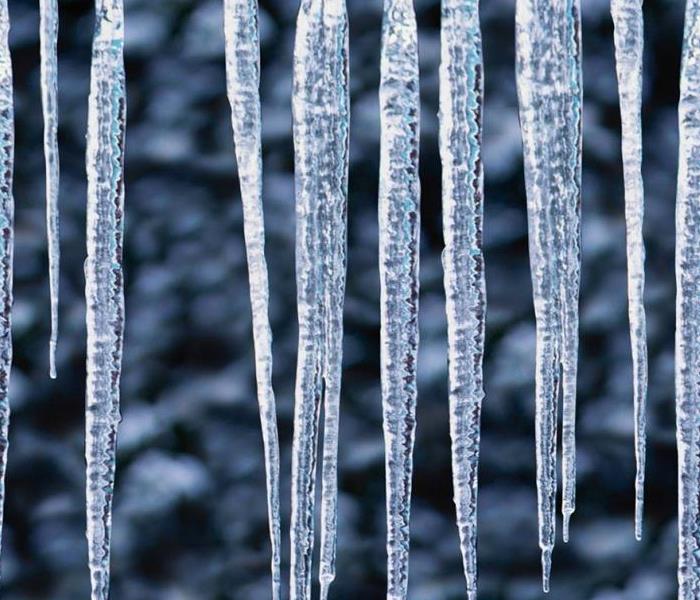 Spring is coming!
Spring is coming!
Though it may not feel like it right now, soon seasons will change and we are reminded of the approach of spring, and with that, winter run off. What have you done to prepare your home for the winter melt? If you remember a few years ago in the Saint Croix Valley region, the spring brought rivers running over their banks, parking lots flooding, businesses, schools and home basements filling with water. Now with that year’s crazy weather, there wasn’t much you could do to combat the flooding. On a more manageable year like the winter we’ve had, there are a few things you can do.
First, way back in the fall you should have clear your gutters on the roof out one more time, once the leaves were off the trees. This allows for the roof snow to melt off and drain properly, avoiding water running over the sides and pooling next to your house’s foundation. Throughout the winter it’s a good idea to rake the snow off your roof as well, this will help avoid ice dams on your roof. This will also help with the flow of water once the roof snow starts to melt.
Around the foundation of your house, you will want to shovel the snow away and make sure that melting snow flows away from your home. If you do all of this, and mother nature still decides to not play nice, SERVPRO of The Saint Croix Valley will be here to help, make it like it never even happened.
Please follow our page, as we continue to explore the benefits of mitigation, and how this approach helps both your clients and your business. Please call us with any questions you have, 715-381-2266. Visit our site: SERVPRO of The Saint Croix Valley
Ice Dam Prevention
1/19/2021 (Permalink)
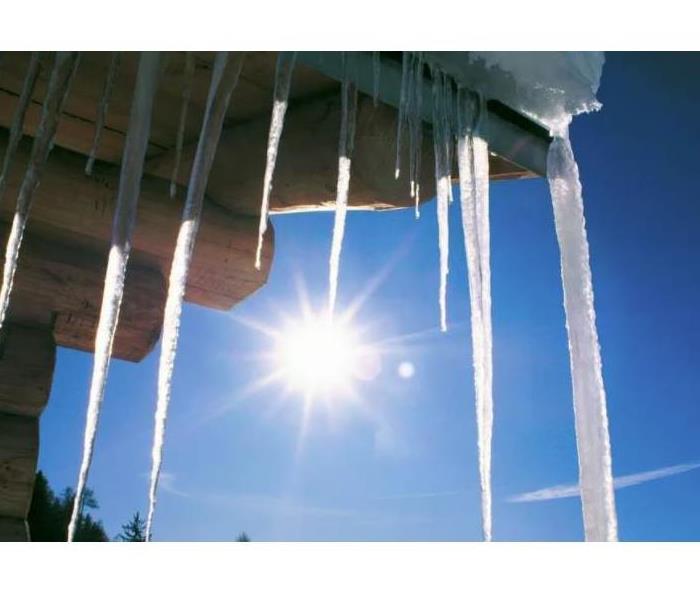 Stopping ice dams is simple, in principle.
Stopping ice dams is simple, in principle.
Here’s how to prevent ice dams in 8 steps so you can enjoy a winter free of icicles and the damage they can do to your roof.
Dam Busters
Stopping ice dams is simple, in principle: Just keep the entire roof the same temperature as the eaves. You do that by increasing ventilation, adding insulation, and sealing off every possible air leak that might warm the underside of the roof, as shown in the illustration below. By taking care of these trouble spots, listed here in order of priority, you should enjoy a winter free of dams and use less energy to boot.
- Ventilate Eaves and Ridge
A ridge vent paired with continuous soffit vents circulates cold air under the entire roof. Both ridge and soffit vents should have the same size openings and provide at least 1 square foot of opening for every 300 square feet of attic floor. Place baffles at the eaves to maintain a clear path for the airflow from the soffit vents.
- Cap the Hatch
An unsealed attic hatch or whole-house fan is a massive opening for heat to escape. Cover them with weather-stripped caps made from foil-faced foam board held together with aluminum tape.
- Exhaust to the Outside
Make sure that the ducts connected to the kitchen, bathroom, and dryer vents all lead outdoors through either the roof or walls, but never through the soffit.
- Add Insulation
More insulation on the attic floor keeps the heat where it belongs. To find how much insulation your attic needs, check with your local building department.
- Install Sealed Can Lights
Old-style recessed lights give off great plumes of heat and can't be insulated without creating a fire hazard. Replace them with sealed "IC" fixtures, which can be covered with insulation.
- Flash Around Chimneys
Bridge the gap between chimney and house framing with L-shaped steel flashing held in place with unbroken beads of a fire-stop sealant. Using canned spray foam or insulation isn't fire safe.
- Seal and Insulate Ducts
Spread fiber-reinforced mastic on the joints of HVAC ducts and exhaust ducts. Cover them entirely with R-5 or R-6 foil-faced fiberglass.
- Caulk Penetrations
Seal around electrical cables and vent pipes with a fire-stop sealant. Also, look for any spots where light shines up from below or the insulation is stained black by the dirt from passing air.
WHAT IS THE BEST TYPE OF PROFESSIONAL CARPET CLEANING?
1/5/2021 (Permalink)
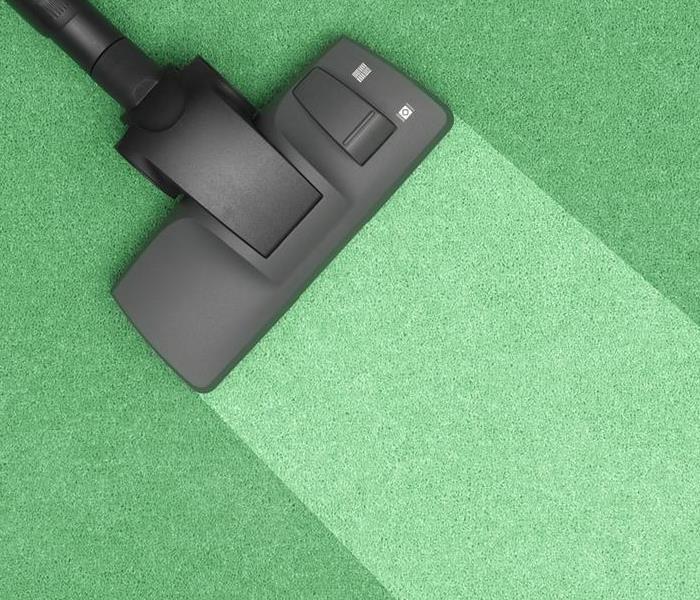 There are several types of professional carpet cleaning out there, all of which are meant to get the dirt out of your carpet.
There are several types of professional carpet cleaning out there, all of which are meant to get the dirt out of your carpet.
There are several types of professional carpet cleaning out there, all of which are meant to get the dirt out of your carpet. They all do the same thing in the end, but not all types of carpet cleaning are equal. Some work better on different types of carpeting, and others perform well in high-traffic areas. The best type depends on your home.
Carpet Shampooing
Most people don’t shampoo their carpets anymore, but this is still a viable option. It works like you would expect as you put a cleaning solution into the carpet in the form of a wet foam. The problem with this method is that the foam can leave behind a residue, and you do have to remember to rinse out the carpet after you’ve applied the shampoo. This reduces the sticky feeling in your carpeting.
This method can feel like a lot of work for some people, since you have to apply not only the solution, but you need to rinse it out too. Then again, it is less expensive than the machinery you’ll need for a steam cleaning.
Dry Carpet Cleaning
There are solutions that you can buy at the store that will help you with dry carpet cleaning. You only need to shake these powder solutions above your carpeting. The solution will work to absorb the dirt in your carpeting, so after 15 minutes, you can just vacuum it up. If you’re looking for a quick sort of clean, this is the perfect method.
This is also a great method if you have jute, coir, or seagrass flooring, which are prone to damage and shrinkage if they get wet. For these types of carpeting, dry carpet cleaning is the best option.
This is a convenient method because there’s very little drying time and it’s easy to do. You may not like the harsh chemicals used in these solutions either, and you shouldn’t try to use this on plush pile carpeting, which can trap the powder mixture.
Foam Cleaning
You have the ability to clean with foam too. Just like the powder, a cleaning solution is distributed evenly across the surface of the carpet, but then it is whipped into a foam. The foam is then worked into your carpeting with a rotating brush. Once the foam sits for a little while, it can be removed with a vacuum cleaner, and since there’s so much foam and very little water, this works for water-sensitive carpets.
You will need about an hour to wait until the carpeting is dry and ready to use again, which is faster than other options. You won’t necessarily be able to get the dirt that’s deeply embedded into the carpeting though.
Hot Water Extraction
You’ve probably heard of this type of carpet cleaning since it’s more commonly referred to as steam cleaning. This is the type that we offer from a truck mounted motor. Steam cleaning works as the name suggests: using steam. The carpet is first pre-conditioned with a chemical emulsifier that is meant to lift dirt and anything else that may be stuck in your carpet fibers.
Heated water is then pressurized to become steam before it is injected into the carpet. After around 15 minutes, all of this is sucked up with a vacuum.
Steam cleaning works best for the removal of ingrained dirt and deep stains, and doesn’t leave any residue or odors in your carpeting. Especially if you have pets, this is the best method for getting smelly stains out. Your only problem might be the cost, and the fact that you have to wait a while for the carpeting to dry.
Conclusion
In terms of the best carpet cleaning option, it really depends on what you’re looking for. If you want to get the most amount of dirt possible, hot water extraction may be best. If you have carpeting that doesn’t work well with water, foam cleaning or dry carpet cleaning is better. There’s also carpet shampooing as a cheaper yet more time-consuming option. Which method you use just depends on what method will work best for your carpets.
Please follow our page, as we continue to explore the benefits of mitigation, and how this approach helps both your clients and your business. Please call us with any questions you have, 715-381-2266. Visit our site: SERVPRO of The Saint Croix Valley
Why is it important to know where the water shut off is?
1/5/2021 (Permalink)
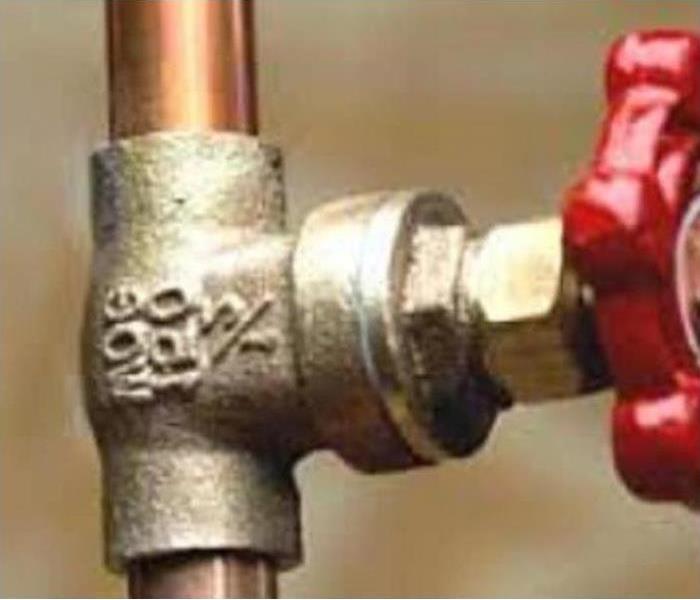 As a homeowner, it's essential to know where the main water shut off valve is located.
As a homeowner, it's essential to know where the main water shut off valve is located.
The Importance of Main House Water Shut Off Valves
As a homeowner, it's essential to know where the main water shut off valve is located. Water leaks from running toilets, burst pipes, broken water heaters, and even leaky sinks can cause significant damage in a short amount of time. In order to prevent costly damage, turn off the water supply as soon as a leak, flood, or spill occurs.
When Do I Need to Shut Off My Main Water Line?
Typically, you won't have to go directly to the main water line to fix a leak. Instead, your first attempt at stopping your water supply should be straight at the source. Most local supply lines have valves located directly behind or above the fixture and can be turned clockwise to shut off the water supply.
To locate water valves next to specific fixtures in your home, use these tips:
- For sinks, look under the cabinet on the supply lines leading to the faucet. There will likely be two shut-off valves to control both cold and hot water.
- For toilets, look close to the ground behind or beside the toilet, along the flexible metal tubing leading to the tank.
- For washing machines, look either directly above the washer or pull the machine away from the wall and check behind it.
- For water heaters, the water valve should be located just above the heater itself.
If the leaky fixture's valves aren't working or break off, turn off your main water line right away. Acting fast could save you plenty in damages and repair costs.
How Do I Find My Main House Water Shut Off Valve?
The main water line valve to a house is usually located in the basement or in the crawlspace and enclosed behind an access panel. However, there isn't a standard location specified in any home.
If you don't know where to look for your water shut off valve, use these tips:
- The valve will often be located on-grade, so you'll likely find it at floor-level in the basement or near the ground on the first floor.
- Take a look at the property inspection report provided when you purchased your home. This report should note the location of the valve.
Maintaining Your Water Valves
At SERVPRO of The Saint Croix Valley, we know how terrifying it can be to try shutting off your supply lines just to see the valves stick in place – or worse, snap off in your hands. That's why we recommend periodically checking your shut off valves to ensure they're in good working condition.
At least twice a year, test all the valves in your home. Simply turn them completely off and on again to ensure they aren't stuck in place or include faulty parts. That way, if an emergency ever does occur, you can have peace of mind that you'll be able to fix the problem quickly and efficiently.
If the unexpected happens and you aren’t able to shut off your water valves in time, call on the experts at SERVPRO of THE SAINT CROIX VALLEY. Our water damage restoration services can help you get your home back to normal as quickly as possible. With the proper tools and knowledge, we'll work fast and efficiently to prevent additional water damage, cleanup costs, and overall stress.
We Had _________ Happen To Our Place of Business, What Now!
1/5/2021 (Permalink)
 Every business owner’s worst nightmare is something happening to the physical location of their company.
Every business owner’s worst nightmare is something happening to the physical location of their company.
Every business owner’s worst nightmare is something happening to the physical location of their company. The place where your inventory, records, or employees report for work each day. In a digital age, the brick-and-mortar location is still an important element of many companies. What happens when a sprinkler head breaks, or that bag of popcorn in the breakroom microwave catches on fire? Most businesses need to be in their facilities to conduct business, what’s your plan to get back into your building after an accident.
70% of businesses that go through some sort of disaster do not reopen. Of the 30% that do reopen, half had emergency readiness plans in place. It is hard enough to reopen a business after a loss, have you improved your odds by having a plan in place. If not, SERVPRO of the Saint Croix Valley can help put one in place. Our complimentary program, compiles the emergency contacts, shut offs and service entrances throughout the building. Along with any other information of value, to first responders or employees. The information is kept both in a hard copy, as well as, a mobile app on key employees’ phones. Faster response times are always critical in any emergency situation.
For our commercial insurance partners, teaming with SERVPRO to provide this plan is a fantastic way to give additional value and protection to your clients. Reach out today to schedule a time to put your plan into place.
Please follow our page, as we continue to explore the benefits of mitigation, and how this approach helps both your clients and your business. Please call us with any questions you have, 715-381-2266. Visit our site: SERVPRO of The Saint Croix Valley
Your Client Has A Property Lost – What Now? 1-4-8 Response Time
1/5/2021 (Permalink)
 In last week’s article we discussed the potential cost benefits of using a remediation company, what that mean.
In last week’s article we discussed the potential cost benefits of using a remediation company, what that mean.
In last week’s article we discussed the potential cost benefits of using a remediation company, what that mean. So, you have a client call in with a loss. That’s when our 1-4-8 service guarantee kicks in. Within 1 hour of receiving notice of loss your client will be contacted to determine scope of loss. Within 4 hours of that notice, we will have boots on the ground to visual determine the scope and begin necessary work to mitigate further loss. By the 8th hour, we will have spoken with you and your client to provide an update on how the course of action will proceed. Response time in any loss, be it fire, water, etc. is critical, when trying to salvage both building and personal materials. That’s why we are faster to any size disaster.
Please follow our page, as we continue to explore the benefits of mitigation, and how this approach helps both your clients and your business. Please call us with any questions you have, 715-381-2266. Visit our site: SERVPRO of The Saint Croix Valley
Everything you need to know about frozen pipes
12/17/2020 (Permalink)
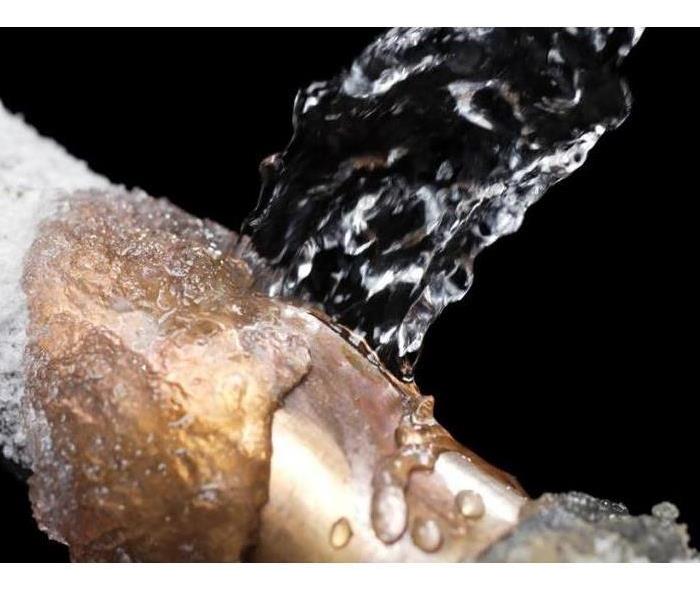 If you live in an area of the country that gets cold winters, one of those things that can go wrong is a frozen pipe that bursts.
If you live in an area of the country that gets cold winters, one of those things that can go wrong is a frozen pipe that bursts.
As a homeowner, you have a list of maintenance items and things that can go wrong in your home. If you live in an area of the country that gets cold winters, one of those things that can go wrong is a frozen pipe that bursts. Burst pipes can cause massive water damage in your home and become a very expensive mess to clean up. You need more information to keep your pipes from bursting.
What causes a water pipe to burst?
Of course, there is more than one reason that a water pipe in your home can burst. It's beneficial to be aware of the various causes of pipes bursting, including:
- Corrosion: If your pipes are made from metal, over the years, they begin to rust and weaken. This weakness can cause your pipe to burst.
- High water pressure: Your pipes can burst if the water pressure is too high. According to Energy.gov, your water pressure shouldn't exceed 60 pounds of pressure per square inch (PSI).
- Tree roots: As the pipes wind through your yard to the house, tree roots may grow into them, and this causes the pipes to burst.
- Shifting soil: If construction is going on around your home, it's possible for the soil to shift and your water pipes to burst.
- Clogs: Excess toilet paper and hair can create clogs in your pipe, and if these clogs get large enough, it can cause the pipe to burst.
- Freezing temperatures: When the temperatures dip low enough, the water in your pipes can freeze. As ice builds up in a single location, it applies pressure to the pipe, leaving it vulnerable to bursting.
After learning the common cause of burst water pipes, you can take steps to avoid problems. You don't want the expense and aggravation of dealing with a burst pipe.
At what temperatures do pipes freeze?
Is it enough that the temperature outside is freezing for my pipes to freeze? No, not really.
You need to remember that both the ground and the material of the pipe need to freeze before the water inside it will freeze. You need a few days and possibly weeks of freezing weather before the water inside freezes. In order for the water inside your pipe to freeze overnight the outside temperature needs to reach 20 degrees Fahrenheit. While you can't do anything about freezing temperatures, there are things that you can do to protect your pipes.
How can you protect your pipes from freezing and bursting?
You don't want to deal with the mess and expense that come from a burst pipe, no matter the cause. Fortunately for burst pipes due to freezing, there are some steps you can take to prevent them from freezing and to prevent them from bursting if they've become frozen. Here are some tips to avoid frozen pipes, including:
Leave the water on at a drip: While moving water can freeze, it's much less likely that water in your pipes will freeze if it's moving. It's beneficial when you hear that your area is experiencing or expected to experience a deep freeze that you turn on each of your faucets to a drip. It doesn't need to be a heavy flow. A slow drip is enough, and it shouldn't affect your water bill too drastically. It's certainly cheaper than replacing pipes, and the cost of repairs due to water damage.
- Keep your garage doors shut: If you have water pipes that wind their way through the garage, you want to keep the doors shut to keep the temperatures inside the garage warmer, and hopefully, above freezing.
- Open cabinet doors; You need to open the cabinet doors below any sinks or other water sources in your home. By opening the cabinet doors, you allow the warmed air in your home to reach part of the pipes inside the home. This keeps the pipes warmers so that they don't freeze.
- Maintain a constant temperature: Many people lower the temperature in their homes at night during the winter months to sleep more comfortably and to save money on utility bills. However, to protect your pipes, it's better to pay a little more on your utility bills and protect your pipes by not allowing your home to become too cool at night.
- Add insulation: To keep your attic, basement and crawl spaces warmer during hard freezes, add insulation to these areas. These are places where pipes are apt to freeze and burst due to the colder temperatures in these areas.
- Remove hoses: If you have hoses attached to your home, remove and store them during the winter months. It's also a good idea to shut off the water running to the outdoor faucets while leaving them in an open position. The remaining water will flow out of the pipes.
If you've done all of this, and you still suspect that you have a frozen pipe, you can still keep the pipe from bursting. Follow these tips:
- Turn the faucet on to a drip: If you suspect that you have a frozen pipe, you need to turn it on to a drip. As you attempt to melt the ice blocking the pipe, running helps the ice to melt faster. However, you don't want to turn the faucet on full, because the pressure of the water behind the pipe might cause it to burst.
- Apply heat to the blocked area: If you can locate the area of the pipe that has the frozen blockage, you can apply heat with a hairdryer, heating pad, a space heater or some other non-flammable source. This will melt the ice inside and allow the water to flow freely again.
- Call a professional: When you can't find the frozen section or it's behind a wall or under the floor, it's time to call a professional.
Among other things, cold weather can cause a water pipe in your home to burst. However, the outside temperatures must reach around 20 degrees Fahrenheit and below for this to happen. By following our tips, you can avoid frozen pipes and pipes bursting due to freezing temperatures.
How Can Wind Mitigation Protect Your Home and Family During Severe Winds?
12/10/2020 (Permalink)
How Can Wind Mitigation Protect Your Home and Family During Severe Winds?
Wind is an unpredictable element that can threaten your home and safety. During periods of high wind, air currents can fluctuate and change directions without warning, placing pressure on all parts of a structure and potentially pulling it apart or lifting it from its foundation. When wind speeds climb, pieces of debris can also become dangerous — crashing into your home with significant force and potentially breaking through it and endangering your loved ones. But there are steps you can take to increase your safety with wind mitigation.
Protect Your Home from Wind Storm Damage
Traditional Homes
- Keep your home firmly anchored in high winds, have anchor bolts with heavy-gauge, square bolt washers installed to connect your floor to the foundation.
- Reinforce the rest of the frame by connecting wall and floor components with properly installed plywood or oriented strand board (OSB), and attach roof trusses or rafters to the walls with metal connectors.
- On existing homes, this can be done when replacing siding.
Manufactured Homes
- Manufactured homes are more prone to damage from high winds as a result of non-permanent foundations.
- Inspect all straps and tie-downs regularly for rust, weakness or wear, and have repairs made immediately.
Make Your Home Less Vulnerable to Wind Damage
Windows
- Install windows rated for the wind speeds in your region.
- For the best protection in hurricane-prone areas, install impact-resistant permanent shutters that meet applicable building code approved standards.
Doors
- To better resist wind pressure and flying debris, make sure your entry doors are solid wood or hollow metal.
- All entry doors should have three hinges and a dead bolt lock with at least a one-inch bolt throw length.
- Door framing should be securely anchored to the wall structure using fasteners that are at least three inches long.
- If you have double-entry doors, secure the inactive door with head and foot bolts that extend through the door header and into the subfloor.
- Patio doors should be made of impact-resistant safety glass.
- Shuttering doors offers extra protection.
Garage Doors
- Install doors rated for the wind speeds in your region.
- If building a new home in a hurricane-prone area, consider installing horizontally braced, single-wide garage doors instead of double-wide doors.
- For existing homes, check with your garage door manufacturer for availability of retrofit bracing kits.
- Be aware that your garage door panels, especially if double-wide, may require both horizontal and vertical bracing to ensure stability.
- You can also protect your garage door with a shutter or screen rated for wind pressure and debris impact.
Roofing
- Strong winds can cause shingles to peel off, especially if edge shingles are not well secured or the adhesive on their tabs has failed.
- A roofing professional can evaluate your roof, and if needed, additional roofing cement can be added under each tab to help keep the shingles attached during a high-wind event.
- The shingles should be attached to roof decking of solid 5/8' thick plywood.
- The roof decking should be attached to the roof framing using 8d ring shank nails, and a secondary water barrier created by installing self-adhering flashing tape over the joints in the roof deck.
- For greater resistance to wind uplift, apply a bead of construction adhesive along both sides of the intersection between the roof decking and the rafters or trusses; your roofing professional can provide you with information about additional safeguards.
Soffits
- To help anchor the soffits, the exposed siding under your roof rafters to your home, have a professional apply a bead of polyurethane sealant between the wall and the trim into which the soffit panels are inserted.
- You can also apply a dollop of caulk in the V-shaped hole where the joint between two soffit panels meets the trim.
Safe Rooms
- Designate a place in your home that will protect your family from injuries caused by broken windows and flying debris.
- The basement is often the best location for a safe room; otherwise, locate the room on the interior, ground floor of your home.
- An experienced contractor can equip your safe room with reinforced floors, walls and ceilings, regardless of whether you have a new or existing home.
Landscaping
- Avoid using gravel or rock landscaping materials, which can be hazardous when airborne. Shredded bark can be an attractive and less dangerous alternative.
- The National Oceanic and Atmospheric Administration (NOAA) broadcasts official Weather Service warnings, watches, forecasts and other hazard information, 24 hours a day, seven days a week. To tune into these NOAA Weather Radio (NWR) broadcasts, you’ll need an NOAA Weather Radio Receiver. These are available at many retail outlets.
When preparing your home for seasonal winds, it's also important to review your insurance coverage.
Why Fire Safety Training Matters for Your Company
12/10/2020 (Permalink)
Even if your office is fully stocked with alarms, sprinklers, and extinguishers, these safety measures are less effective if your workforce doesn’t understand emergency procedures. By implementing routine fire drills and training from a professional, you’ll prepare all your employees to stay safe during an emergency. Here is more information about why fire safety maintenance is necessary.
How Should Your Employees Be Trained for Fire Safety?
To contain small fires, such as microwave accidents, every employee should know how to use a fire extinguisher. A brief training demonstration could save your company from costly property damage and potential staff endangerment. For larger fires that can’t be eliminated with an extinguisher, everyone should know the quickest way to evacuate the building.
To prevent injuries, you must undergo fire drills, which will force your staff to act like an emergency is occurring in your building. Every employee should move quickly toward the nearest exit, helping those who may have limited mobility. By teaching your workforce to act calmly under pressure, you’ll minimize the chances of chaotic rushing that could lead to trampling.
Most importantly, having an evacuation plan is required by the Occupational Safety and Health Administration, and nearly all businesses should have regular fire drills as per the state of Wisconsin fire code. A professional will help you comply with the law.
How to Enjoy a Fire Free Christmas
12/8/2020 (Permalink)
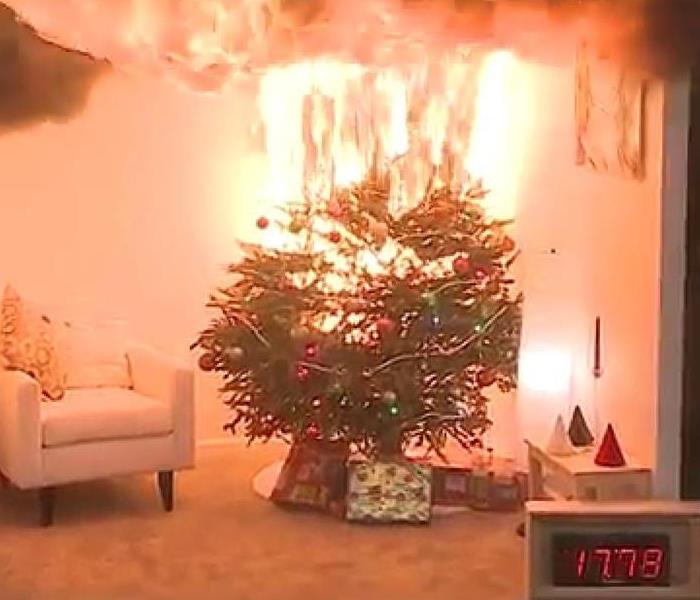 Between 2013 and 2017, US fire departments responded to an average of 160 home fires per year that started with Christmas trees.
Between 2013 and 2017, US fire departments responded to an average of 160 home fires per year that started with Christmas trees.
Like a lot of people, you're probably not taking down your Christmas tree for a few months. So now's a good time to learn how to keep it from catching fire and burning your house down. Between 2013 and 2017, US fire departments responded to an average of 160 home fires per year that started with Christmas trees, according to the National Fire Protection Association. Those fires caused an average of three deaths, 15 injuries and $10 million in direct property damage each year, according to the association. For anyone celebrating Christmas with a natural or artificial tree, here are some ways to keep it brightly lit while staying safe.
Keep trees away from heat to make sure a tree is far away from any heat source. This includes candles, radiators, stoves, fireplaces and open flames. Smokers should never light up near a Christmas tree.
Make sure you're using the right lights; A Christmas tree isn't complete without glittering lights. But always make sure the lights are labeled "UL" or "FM," meaning they've met current safety requirements. Tree lights should be examined for frayed wires and damaged plugs. While the more the merrier, it's important not to overload electrical outlets or run wires under carpets or rugs. When positioning the tree, try to put it close to an electrical outlet to minimize the use of extension cords.
If you're using an artificial metallic tree, only use remote spot or reflective lights, not electric lights. For candle fanatics, keep them somewhere else. Lighted candles should never be placed on trees. And before heading to bed or leaving the house, make sure you turn off those lights.
If you're using a natural Christmas tree, make sure it's a fresh one. Once it starts drying up and those needles start falling out, immediately dispose of the tree. Experts recommend that natural trees should be kept for no longer than two weeks.
For natural tree aficionados, it's important to cut "one inch from base of tree to allow water absorption" and always keep the water receptacle under the tree full.
Five Safety Tips for Deep Frying Turkey
11/24/2020 (Permalink)
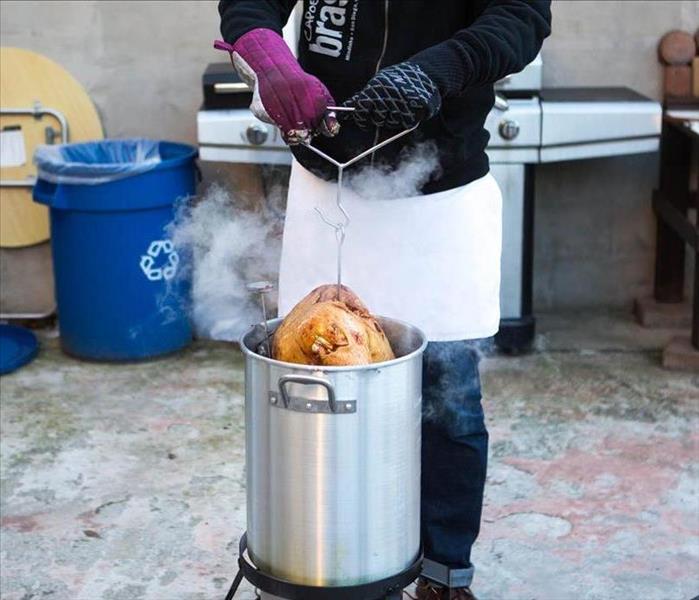 Fried turkeys are delicious, but they come with a slew of safety issues
Fried turkeys are delicious, but they come with a slew of safety issues
Fried turkeys are delicious, but they come with a slew of safety issues. Thousands of fires as well as many deaths and injuries happen each year due to turkey fryer fires. Before you set up your turkey fryer this Thanksgiving, remember these safety tips.
Get the Tips
- Stay Away from The House– Set up the turkey fryer more than 10 feet away from your home and keep children and pets away. Never leave it unattended.
- Find Flat Ground– The oil must be even and steady at all times to ensure safety. Place the fryer on a flat, level surface and carefully gauge the amount of oil needed.
- Use a Thawed and Dry Turkey– Make sure your Thanksgiving turkey is completely thawed and dry. Extra water will cause the oil to bubble furiously and spill over. If oil spills from the fryer onto the burner, it can cause a fire.
- Monitor the Temp– Use caution when touching the turkey fryer. The lid and handle can become very hot and could cause burns. Also be sure to keep track of the oil?s temperature as many fryers do not have their own thermostats.
- Be Prepared– Have a fire extinguisher (multipurpose, dry-powder) ready at all times in the event that the oil ignites.
And if you follow all of these tips, and still have an overly well done turkey and garage, we are here to help make it, Like it never even happened.
Please follow our page, as we continue to explore the benefits of mitigation, and how this approach helps both your clients and your business. Please call us with any questions you have, 715-381-2266. Visit our site: https://www.SERVPROthesaintcroixvalley.com/
Reduce Heat Loss and Lower Your Monthly Bills
11/17/2020 (Permalink)
 You can save as much as 10% a year on heating and cooling by simply turning your thermostat back 7°-10°F for 8 hours a day from its normal setting.
You can save as much as 10% a year on heating and cooling by simply turning your thermostat back 7°-10°F for 8 hours a day from its normal setting.
Reduce Heat Loss and Lower Your Monthly Bills
- Set Your Thermostat Back 7°-10°F for 8 Hours to Save Money
You can save as much as 10% a year on heating and cooling by simply turning your thermostat back 7°-10°F for 8 hours a day from its normal setting.
To do this easily, buy a programmable thermostat. By lowering the temperature for 8 hours a day, you save approximately $83 dollars a year.
Going on vacation? You can set it lower to 55 degrees (without worrying about your pipes freezing).
Turning the heating temperature down at night and then back up in the morning saves a significant amount of energy.
"Mathematically speaking, the amount of energy required to keep a house warm is equal to the difference between the indoor and outdoor temperatures multiplied by the time that this difference is maintained."
- Properly Calibrate Your Thermostat
If your thermostat isn't properly calibrated, you could be overspending on energy. Your thermostat can lose its calibration if dirt gets inside or if it gets accidentally bumped. Have your thermostat checked and calibrated annually, or install a computerized thermostat for the best fuel and cost efficiency.
ABC Home and Commercial offer step by step instructions on how to calibrate your thermostat properly.
- Replace an Older Furnace with a High Efficiency Furnace
According to Jill Murphy, senior product marketing manager, residential heating, Lennox Industries Inc., "Replacing an older furnace that is 60 percent efficient with one that is 98 percent efficient can save homeowners up to $11,469 over the life of the system."
Furnaces use either gas, oil or electricity for fuel. Efficiency is measured as an Annual Fuel Utilization Efficiency rating.
Modern furnaces can have ratings as high as 98.2% (which means only 1.8 % is exhaust).
If you are replacing an older furnace with a high-efficiency (90%+) furnace, you should see savings on your heating bills of 25% - 30%.
- Inspect, Clean and Adjust Your Furnace’s Burners
Energy efficiency is gained or lost at your furnace’s burners.
“Be sure to look for any type of rust or corrosion that may have accumulated on the burners due to a condensate leak that might have gone undetected at some point during the life of the furnace,” says Brian Vinsant, product support specialist, residential heating equipment, Rheem Mfg. Co.
- Reverse Your Ceiling Fans and Cut Your Heating Costs
Reverse your ceiling fans to force warm air downward, keeping your home more comfortable. This home maintenance task makes rooms with high ceilings more comfortable.
Switching to a clockwise rotation pushes warm air that has risen to the ceiling back down into the living space. This can cut your heating costs as much as 10 percent, according to Popular Mechanics.
- Inspect and Boost Your Insulation
Adequate insulation will help keep your home warm in the winter. And if your insulation is insufficient, your heating system will have to work overtime this winter.
By adding some insulation to your attic, walls, and crawlspace, you can save money on heating costs. Insulation is one of the best ways to save energy and reduce cost.
- Check and Seal Your Ducts
Studies show 10 to 30 percent of heated (or cooled) air in an average system escapes from ducts.
Ducts that leak air into an attic or crawl space can add hundreds of dollars a year to your heating and cooling bills.
The duct work that transports the heated air throughout your home will often become damaged with age. When this occurs, you are opening your indoor air up to microscopic air contaminants that can aggravate allergy and asthma symptoms and negatively affect your overall well-being.
These cracks, tears and other damage will also reduce the furnace’s performance. The best DIY approach is to use mastic sealant or metal tape to fix the damage and then insulate the ducts.
- Allow Sunlight to Enter Your Home
During winter, keep the draperies and shades on your south-facing windows open during the day to allow the sunlight to enter your home and closed at night to reduce the chill you may feel from cold windows.
- Seal Air Leaks
Sealing air leaks can save up to 10% in heating bills.
Most leaks can be fixed with a simple caulking gun.
Improve Indoor Air Quality
HVAC units get dirty quickly. When this dirt and debris isn’t cleaned from the unit, it is reintroduced into your home, lowering your indoor air quality.
- Change Your Furnace Filter to Avoid Trouble
You may have changed it at the end of the heating season, or then again, you may have forgotten. A new filter costs so little, while a furnace costs so much, why risk damaging it?
Replacing the filter (or cleaning a permanent filter) is easy and puts you well on your way to preparing your furnace for winter. Using old filters puts more stress on the compressor and can lead to mechanical failures over time.
- Filters and coils should be cleaned so the dirt inside doesn't circulate in your home. Clean or replace filters on furnaces once a month or as recommended.
- Dirty filters make your furnace work harder. At a minimum, you should replace a disposable filter every six months (winter and summer) or your manufacturer’s recommendation.
- Clean warm-air registers, baseboard heaters, and radiators as needed. Make sure they're not blocked by furniture, carpeting, or drapes.
- Vacuum
Keep the area around your furnace and all areas free of dust. Use an ordinary vacuum to clean the room where your furnace works hard to keep you cozy.
Gently vacuum electrical connections to keep them dust-free, and keep the floor clean so "dust bunnies" are not stirred and lifted onto the furnace.
Maintenance, Inspection and Action
- Maintain Performance Record
Write down the model numbers of all your products. It's good to have them listed in a file for easy access. Keep a regular log of furnace performance. This will help you identify problems as they occur, and provides you with an accurate method of tracking furnace efficiency.
- Test Your Detectors Every 6 Months
You'll want to check your carbon monoxide and smoke detectors. Buy a carbon monoxide (CO) detector - save yourself, possibly your family, and your pets by investing a few dollars in a carbon monoxide detector.
You can install it around 15 feet away from the furnace. Remember that carbon monoxide is odorless, colorless, tasteless and invisible, making it extremely dangerous.
- Listen for Unusual Sounds or Pay Attention to Strange Smells
- High-pitched squeal? It could be a slipped or frayed blower belt. Loud sounds can be an indication of a mechanical problem. Listen for banging, popping, rattling, and screeching noises.
- Nose around. Sniff the furnace room. Smells like rotten eggs? It could be a gas leak. Musty, grimy smell? Check for any oil leaks. Metal or iron smells? It could be an indication of your furnace motor starting to have trouble.
- Check the Electric Ignition or Pilot Light
If these are faulty it will reduce the heat getting in your home. A "flickering or yellow pilot light could be a sign of excess carbon monoxide in gas furnaces."
- Turn off Kitchen, Bath, and Other Exhaust Fans
Turn off kitchen, bath, and other exhaust fans within 20 minutes after you are done cooking or bathing.
When replacing exhaust fans, consider installing high-efficiency, low-noise models.
- Test Safety Features
Deliberately tripping and resetting safety controls ensures proper shut-off in the event of a real emergency.
- Clean Your Flue and Chimney
You may feel comfortable doing this by investing in a chimney cleaning kit (brushes and fiberglass handles). However, you may be better off hiring a chimney sweep if you are unsure of what to do (although it is not hard, and only a little messy).
Your furnace flue ventilates toxic gases, so it must be clean and free of obstructions such as squirrel and bird nests or heavy deposits of soot.
- Inspect and Lubricate all Moving Parts
A little light lubrication in all the right places can add years of service to your furnace.
- Inspect the Electrical Connections and Systems
Loose connections can cause sparks or trip safety systems.
- Make an Appointment Early in the Season
The last part of your work to prepare furnace for winter is to call your helpful HVAC service company for a season appointment.
Conclusion
While most of the do-it-yourself furnace maintenance tips will go a long way to ensure your unit is functioning the way it was designed, you should not overlook the importance of a professional tune up and preventive maintenance plan.
A well-trained and trusted HVAC technician has the knowledge to spot potential problems before they occur - something most homeowners cannot do, and can keep your furnace functioning at its peak performance.
3 Workplaces at an Increased Fire Risk
11/6/2020 (Permalink)
 Some workplaces contain materials and systems that make them more susceptible to fires.
Some workplaces contain materials and systems that make them more susceptible to fires.
Some workplaces contain materials and systems that make them more susceptible to fires. If you manage a commercial space that is at risk, you must have fire extinguishers and safety designs in place to prevent costly accidents. Understanding some of the potential dangers in your workplace will also help you stay safe. Here’s a guide to some of the spaces that are at an increased risk and how to minimize it.
Commercial Establishments That Are at Risk for Fires
- Restaurants
Most restaurants use open flames and produce a lot of cooking grease and oils. This combination is a common cause of many residential and commercial fires. To avoid issues, always have fire extinguishers handy and ensure employees know how to operate them. You must also have your restaurant’s grease trap and hood cleaned (6 Steps to a Professional Kitchen Hood Cleaning) to avoid accumulation and promote ventilation. Staff should never leave open flames unattended.
- Offices
fire extinguishers Paper documents, electronics, as well as overloaded power strips, outlets, and circuits leave offices at risk for fire. A damaged power cable or overheated strip could create a spark, so always inspect your wiring for damage and excess heat. If desks at your workplace have been relying on extension cords in the long term, consider having additional outlets installed. You should also have fire extinguishers placed throughout the office, as well as alarm protection systems (Commercial Fire Sprinkler Systems Myths). A workplace safety plan should also be in place so employees know what to do in an emergency situation.
- Industrial Plants
Several flammable chemicals are used in manufacturing and material treatment, which is why industrial plants are at increased fire risk. Combustible materials such as fuel need to be carefully monitored and stored in a well-ventilated room. Employees should be trained to handle chemicals and operate any machinery that involves open flames. Having a fire suppression system in place will ensure issues are quickly spotted and dealt with. If you manage a warehouse, have fire safety maintenance professionals routinely test your equipment to make sure it’s operational.
Should you have a fire and are in need of clean up services or just have questions about the process, call SERVPRO of The Saint Croix Valley at 715-381-2266. Our staff of professionals are available 24 hours a day, 7 days a week for emergency commercial and residential mitigation services.
Fire Prevention Tips
10/22/2020 (Permalink)
October brings us fire prevention week. With that, we at SERVPRO, wanted to take a moment to remind you of a few things to keep an eye on to prevent fires this fall and into the winter.
- Watch your cooking
Stay in the kitchen when you are frying, grilling, or broiling food. If you must leave, even for a short time, turn off the stove. - Give space heaters space
Keep fixed and portable space heaters at least three feet from anything that can burn. Turn off heaters when you leave the room or go to sleep. - Smoke outside
Ask smokers to smoke outside. Have sturdy, deep ashtrays for smokers. - Keep matches and lighters out of reach
Keep matches and lighters up high, out of the reach of children, preferably in a cabinet with a child lock. - Inspect electrical cords
Replace cords that are cracked, damaged, have broken plugs, or have loose connections. - Be careful when using candles
Keep candles at least one foot from anything that can burn. Blow out candles when you leave the room or go to sleep. - Have a home fire escape plan
Make a home fire escape plan and practice it at least twice a year. - Install smoke alarms
Install smoke alarms on every level of your home, inside bedrooms and outside sleeping areas. Interconnect smoke alarms throughout the home. When one sounds, they all sound. - Test smoke alarms
Test smoke alarms at least once a month and replace batteries once a year or when the alarm “chirps” to tell you the battery is low. Replace any smoke alarm that is more than 10 years old. - Install sprinklers
If you are building or remodeling your home, install residential fire sprinklers. Sprinklers can contain and may even extinguish a fire in less time than it would take the fire department to arrive.
Candle Safety
10/22/2020 (Permalink)
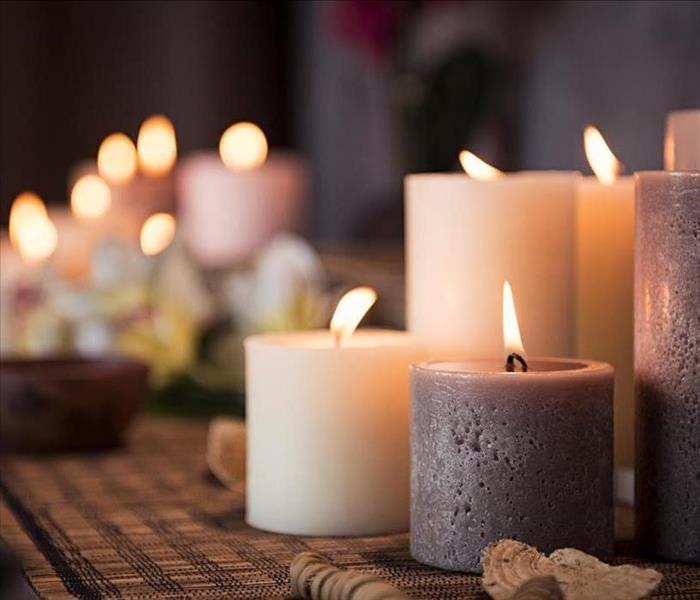 There’s something about the flickering glow and scent of candles that keeps us buying more.
There’s something about the flickering glow and scent of candles that keeps us buying more.
There’s something about the flickering glow and scent of candles that keeps us buying more.
Unfortunately, lit candle use is also the cause of many preventable home fires. FEMA estimates that there are more than 15,000 home candle fires every year, many resulting in injury or even death. More than half of these fires start because the candles are too close to combustible materials, which is something that can be easily preventable.
Here are a few candle safety tips to review before you light your next candle:
1. Burning candles should never be left unattended.
2. Keep candles away from anything flammable.
3. If your candle is in a candle holder, it should be sturdy enough to avoid being easily knocked over.
4. Candles should be placed where children and pets can’t reach them.
5. The National Candle Association recommends that candlewicks be trimmed to ¼ inch each time before burning. Long wicks can cause uneven burning and dripping.
6. Keep the pool of wax in the candle clear of debris such as wick trimmings.
7. Read and follow the manufacturer’s instructions for candle use. Most candles should be burned for only a couple of hours at a time.
8. Extinguish candles with a candle snuffer rather than blowing them out, as hot wax can splatter.
Keeping Your Basement Dry
10/8/2020 (Permalink)
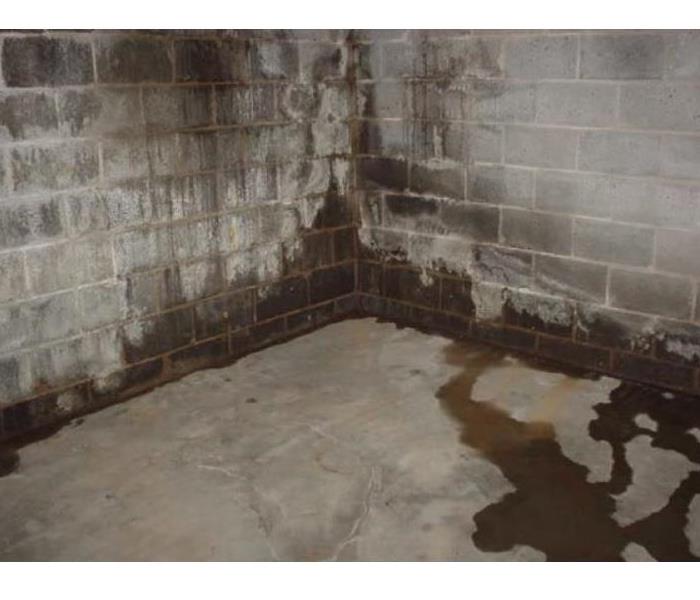 During the wet months of the year we run across homes that have had multiple water events in the basement over the years.
During the wet months of the year we run across homes that have had multiple water events in the basement over the years.
During the wet months of the year we run across homes that have had multiple water events in the basement over the years. These homeowners have redone landscaping, put up new gutters and downspouts and, still have water, in the basement. What else can a homeowner do? The can look into drain tile options:
What is Drain Tile?
Chances are, if your home has a basement and has experienced flooding, someone has told you to get drain tile. But what is drain tile and how does it help?
Essentially drain tile is a way to protect your home from groundwater flooding. It redirects water away from your home before it can enter and cause damage. It is one of those things you never need – until you do! Increased run off from urban expansion and more frequent severe weather systems make our homes more likely to flood. Investing in a drain tile system could save you from lengthy insurance claims and expensive cleanups in the future.
How Drain Tile Works
Despite its name, drain tile is actually not tile at all. When used in the construction industry it actually refers to drainage piping. Drain tile is a system of subterranean drainage laid around the footings of a building. Water always chooses the path of least resistance so drain tile offers the easiest path. The pipe used for drain tile is porous so water finds its way into the pipe system rather than your home. Water is then directed away from your home using gravity or an electric sump pump. Once in the pipe the system directs the water to a dry well or releases it above ground to run off into a storm drain or sewage system.
Why SERVPRO Offers Post Construction Cleaning
10/8/2020 (Permalink)
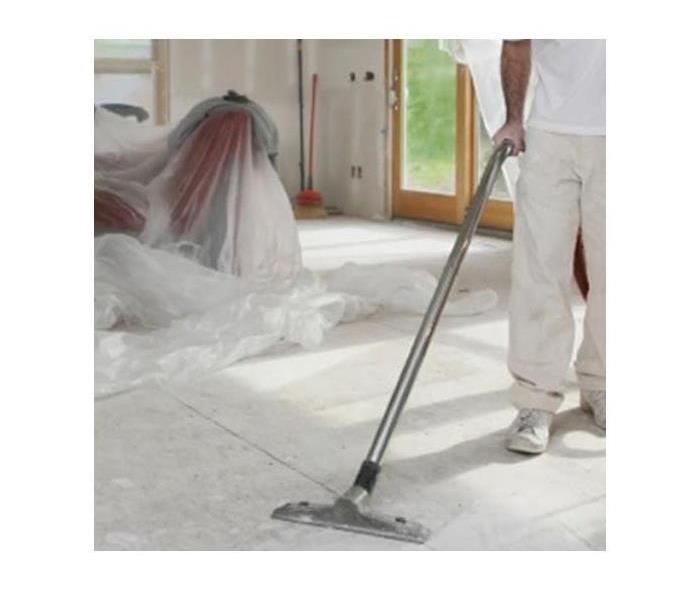 The biggest mistake a janitorial service provider or a client can make is to assume post construction cleaning is like other cleaning.
The biggest mistake a janitorial service provider or a client can make is to assume post construction cleaning is like other cleaning.
The biggest mistake a janitorial service provider or a client can make is to assume post construction cleaning is like other cleaning. If you like surprises, you will love post construction cleaning. Post construction is a lot like remodeling, you never know what to expect until you get started. You have to be ready for every eventuality. So what makes post construction so unique?
We Don’t Have the Luxury of Time
When we clean after construction we go in after everyone else is done (translated, we clean up the other trades’ messes) and we have to make the building look like ‘new’, even if it isn’t. This is not as easy as it sounds for reasons we will discuss in a moment. The new tenant is expecting a clean, move in ready space and the building management company is looking at us to deliver. The challenge is that the janitorial service providers are the last trade in the building, which means the original schedule is meaningless and we are under the gun to meet the deadline. It’s not like when you are cleaning on a regular recurring schedule because you can ‘fix’ mistakes and take care of things you may have missed the next time you go to clean. Post construction cleaning does not have that flexibility.
We Are Operating on the Tenants’ Schedule
By the time we get started with our service the building management has leased the building to a tenant who has a time line and it cannot be moved. This is like the first point but it bears further attention. The client determines when we will clean whether it is convenient or not. To handle post construction cleaning well you have to be flexible and able to adapt to changes all on some other persons time table.
Uncommon Surfaces Are Normal
Normal day in and day out janitorial service is fairly straight forward and the areas we clean are not all that unusual (although there are those times). On a normal basis janitorial service providers are not tasked to wipe down and clean 20′ transoms or walls. We normally don’t clean inside cabinets once the tenant occupies the space. We don’t normally remove factory glued stickers from windows, appliances or fixtures. But all of these surfaces must be cleaned in post construction and it must look like new when you’re done. Post construction cleaning requires a broader knowledge of tools and techniques to be successful.
We Clean Substances Left By Construction That We Will Not Encounter During Daily Cleaning
When other trades are doing their work they will often leave behind ‘mystery substances’. Sometimes it is a glue or a sealant or… well, you get the idea. The problem is if it is on a wall or a floor or a window we are tasked to remove it even when we might not know what it is. To do well in post construction cleaning you have to have an understanding of what the other trades are using so that you can clean it up. You need to be prepared to address any stain or mark or ugly glob you find. The tools and knowledge required for this go well beyond your average cleaning.
Other Trades Are Continuing to Work While We Are Trying to Detail the Building
This is what the last guy in has to face. Everyone else has a deadline just like us but our challenge is doing our job while others continue to make messes and undo what we just did. It’s frustrating to go through a building only to get a call back to clean up a paint spill or sheet rock dust that wasn’t there yesterday. If you don’t learn to deal with it you won’t do well at post construction cleaning. It’s just the nature of what we do.
It’s National Preparedness Month: Make a plan
9/4/2020 (Permalink)
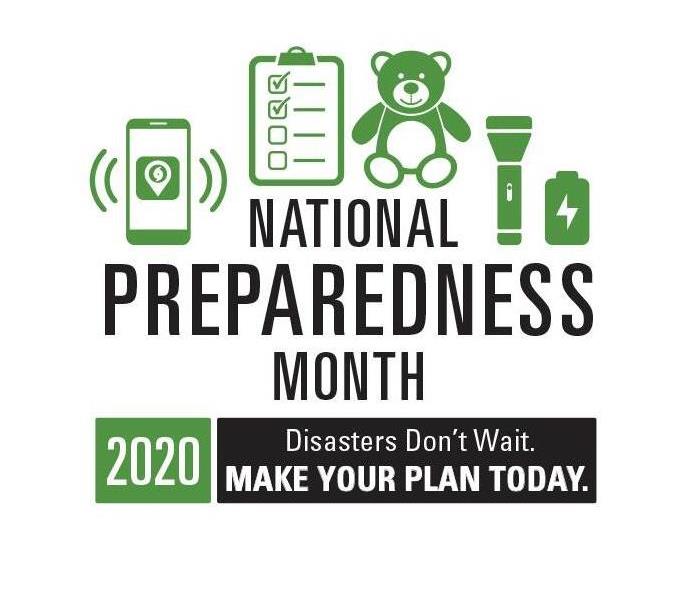 Extreme weather and natural disasters can occur with little warning.
Extreme weather and natural disasters can occur with little warning.
Extreme weather and natural disasters can occur with little warning. This year’s floods and wildfires are proof of that. Are you ready to leave your home at a moment’s notice? You can reduce your anxiety about these scary events by making sure you are prepared if and when they happen. September is National Preparedness Month and a good time to get your family, pets, and property ready. You can, for example:
- Organize your finances. When it comes to preparing for situations like weather emergencies, financial readiness is as important as a flashlight with fully charged batteries. Having your financial documents up-to-date, in one place, and portable can make a big difference at a tense time.
- Replace missing documents. If you’re missing important documents, now’s the time to replace them.
- Check your insurance. Find out if any of your home, health, or other insurance policies will pay for temporary shelter, replacement clothing, furniture, or other items if you are affected by extreme weather or a disaster.
- Prepare your home. From floods to fires, earthquakes, high winds and tornadoes, check out The Federal Emergency Management Agency’s (FEMA) How-To Series: Protect Your Home or Business. If you live where storms and flooding are likely, visit floodsmart.gov to learn about FEMA’s National Flood Insurance Program.
- Plan for your pets. If you’re like millions of animal owners nationwide, your pet is an important member of your household. A little planning today can help ensure safety for your pets during an emergency.
- Sign up for alerts and warnings in your area. Public safety officials use timely and reliable systems to alert you and your family in the event of severe weather and disasters.
Please follow our page, as we continue to explore the benefits of mitigation, and how this approach helps both your clients and your business. Please call us with any questions you have, 715-381-2266. Visit our site: SERVPRO of The Saint Croix Valley https://www.SERVPROthesaintcroixvalley.com/
6 Steps to a Professional Kitchen Hood Cleaning
9/1/2020 (Permalink)
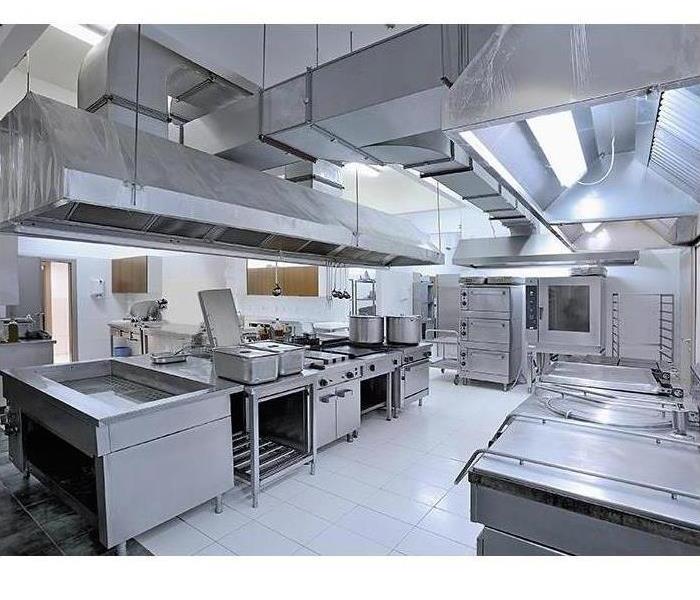 Regular cleanings of restaurant kitchen hood vents are an essential part of any fire safety maintenance plan.
Regular cleanings of restaurant kitchen hood vents are an essential part of any fire safety maintenance plan.
Regular cleanings of restaurant kitchen hood vents are an essential part of any fire safety maintenance plan. Without regular attention, oil and other debris can build up in the hood, exhaust fan, filters and ductwork, significantly increasing the chances of a grease fire. Undergoing a hood cleaning twice a year will help you meet the National Fire Protection Agency’s (NFPA) standards for reducing the risk of fire. This process typically takes between three and six hours. To help you prepare for your upcoming appointment, here’s a guide to what to expect during this procedure.
What Happens During a Professional Hood Cleaning?
- Kitchen Prep
Hood cleaning may create a mess, so the cleaning company will begin by prepping the kitchen for the process. This includes turning off pilot lights and gas valves, covering appliances, and removing any items that could potentially get contaminated by the cleaning chemicals and dirty water. The cleaning crew will also remove all filters and disassemble any wall-mounted hoods and fans for cleaning.
- Filter Cleaning
Kitchen exhaust filters often become caked in grease and grime. The hood cleaning process involves removing the filters and soaking them in a cleaning solution to loosen the hardened grease. After several hours, the filters are power-washed and then reinstalled.
- Fan Cleaning
Kitchen exhaust fans are another place where grease builds up. Fire safety maintenance requires the fans to be removed for a thorough cleaning from top to bottom to reduce hidden hazards. The crew will spray the fan with degreasing chemicals and then scrub the blades clean by hand and power washing. Before the fans are reinstalled, the entire system is inspected and the fan belts replaced to ensure it’s in working order.
- Vent & Ductwork Inspection
NFPA guidelines require that all exhaust duct systems be cleaned and degreased regularly, so a thorough hood cleaning includes manually scraping any solidified grease from the vents and ducts before spraying on chemicals to dissolve the remaining grease. After a final scrub, the vents and ductwork are inspected to ensure they comply with NFPA rules.
- Power Washing
Once the fans, vents, and filters are clean, the crew will tackle the kitchen hoods themselves. This begins with manually scraping congealed grease from the hood, and then applying a degreasing cleaning chemical to loosen any remaining residue. After 30 to 60 minutes, the cleaners’ power-wash the hood with hot water, leaving it clean and free of grease that could start a fire.
- Inspection & Documentation
The final step of the process happens once the crew has restored the kitchen to its prior condition. This is when the process will be documented and your technician will apply a certification sticker to the unit. This tells health inspectors and insurance companies that you are in compliance NFPA guidelines and have worked with licensed fire protection services to ensure the safety of your kitchen.
Facts About Mold
9/1/2020 (Permalink)
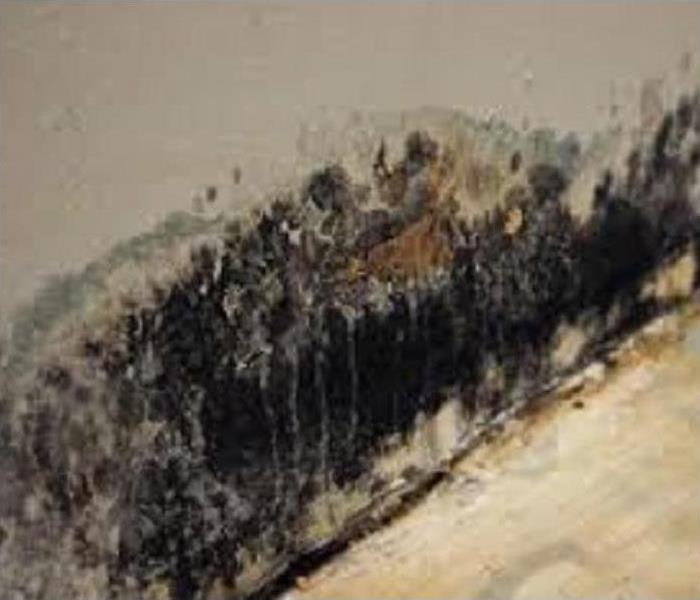 For more than a decade, mold has been in the news.
For more than a decade, mold has been in the news.
For more than a decade, mold has been in the news. People are talking about the effect on population health and damage to the building. But what are the risks and issues?
The term “mold” is a colloquial term for a group of filamentous fungi that are common on food or wet materials. This includes the green Penicillium species that produces penicillin, and fungi that spoil our bread, fruit, cheese and crops. Most of these are Ascomycetes that produce a lot of spores.
The majority of the molds that grow on damp building materials are found in the soil and are adapted to grow on a wide variety of materials. Outdoors, molds live in the soil, on plants, and on dead or decaying matter. There are thousands of species of mold and they can be any color. Different mold species are adapted to different moisture conditions ranging from very wet to just damp. Many times, mold can be detected by a musty odor. Live spores act like seeds, forming new mold growths (colonies) under the right conditions. All of us are exposed to a variety of fungal spores daily in the air we breathe, both outdoors and indoors.
How mold gets into a house or building
Mold and fungal spores occur naturally outdoors, where fungi are the earth’s most important recyclers. Indoors, mold needs moisture to grow; it becomes a problem only where there is water damage, elevated and prolonged humidity, or dampness. Common sources of excessive indoor moisture that can lead to mold problems include:
- flooding from surface waters (i.e., overflowing rivers) or from severe storms;
- roof leaks from damaged or missing roofing materials, ice dams or blocked gutters;
- storm-driven rain through window frames, exterior walls or door assemblies;
- leaking pipes, sewer back-ups or overflows;
- damp basements or crawl spaces due to a high-water table or poorly managed rainwater drainage; and
- condensation on cold surfaces.
How to prevent mold growth
The key to preventing and stopping indoor mold growth is to control excessive moisture and condensation. Keeping susceptible areas in the home clean and dry is critical. In general, mold will not grow indoors without water, dampness or excessive moisture.
Three main factors contribute to condensation of water on building surfaces:
- Relative Humidity: Condensation occurs when the air is saturated with water and it cannot hold any more moisture. For example, steam generated from bathroom showers or from cooking can fill up the air with moisture, which will then condense into drops of water on cooler surfaces, such as mirrors and windows. Where possible, localized sources of humidity, such as clothes dryers, should be directly vented to the outdoors. To lower indoor humidity during warm, humid weather, air conditioners and/or dehumidifiers should be used. In chronically damp areas such as basements or crawlspaces, it is often recommended that dehumidifiers be used to maintain humidity levels below 60 percent.
- Temperature: Warm air holds more moisture than cold air. Condensation occurs when warm humid air comes into contact with a cold surface and the moisture condenses into water. This can often be seen on single-pane windows, where water condenses and then runs down, causing the wood frames and sills to rot and the wall under the windows to blister. Condensation can occur on exterior walls, particularly north-facing walls, if they are not properly insulated. Other chronically cold surfaces, such as cold-water pipes, should be covered with insulation to help prevent condensation.
- Poor Ventilation: Indoor humidity can build up if there is not enough ventilation and exchange of indoor and outdoor air. Where there is little or no air movement, such as behind dressers and cabinets, surfaces can remain cooler than surrounding areas, which can lead to increased condensation and mold growth. It is recommended that the area be ventilated and the occupants use exhaust fans (vented to the outdoors) to remove moisture from high-humidity areas, particularly in bathrooms, kitchens and laundry areas. Furniture should be moved slightly away from walls so that air can freely pass behind it. Air should be allowed to circulate between rooms and regularly ventilate to remove humid air. Fans should be used as needed.
Other things that can be done are to clean and repair gutters regularly, make sure the ground slopes down and away from the home’s foundation and keep air conditioner drip pans and drain lines clean. In addition, in air-conditioned buildings in hot and humid climates, vinyl wall coverings on the interior sides of exterior walls should not be used, as these materials can trap moisture, resulting in mold growth underneath them.
In the case of floods or leaking pipes, any standing water should be promptly removed and water-damaged materials should either be dried out and cleaned, or removed and replaced. Porous materials that are wet for more than 48 hours are likely to produce mold growth and should be discarded. In instances where the water damage is extensive, it is recommended that professional help, such as a commercial restoration company, be consulted.
Common Causes of Mold
8/18/2020 (Permalink)
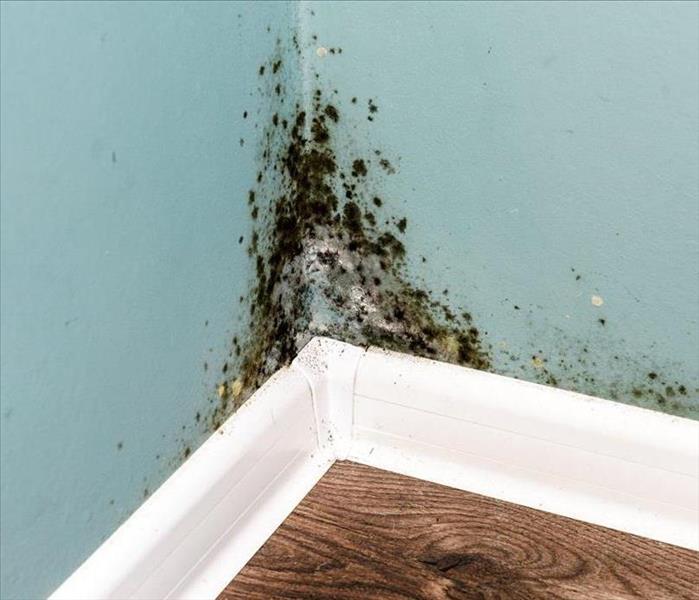 Mold can pop up anywhere that meets it's conditions.
Mold can pop up anywhere that meets it's conditions.
Mold can grow just about anywhere but is most commonly found in areas such as bathrooms, kitchens, basements, cabinets, and near pipes or ducting areas. It only needs a few elements to grow and proliferate throughout your home, the key element being moisture.
Mold behind drywall may be one of the most common household problem areas as drywall, wood, and cotton are ideal food sources.
Ceiling mold is also highly common due to a lack of ventilation and accumulation of moisture.
If the temperature is right, there is a moisture source and enough oxygen, you can be sure mold will begin to grow and spread.
Here are 6 of the most common causes of mold in your home:
- Persistent Humidity
If you live in an area where humidity is consistently high, you may have a problem with mold. This is only natural due to the high moisture content in the air.
- Leaking Pipes in the Home
This is one of the most common causes of mold behind drywall and in under-sink cupboards.
- A Leaking Roof
A roof which is partially damaged due to wear and tear or severe weather conditions can quickly lead to mold build-up in your home.
- A Build-Up of Condensation
During the winter time, some homes may experience a build-up of condensation on cold surfaces due to the fluctuations in temperature.
- A Damp Basement
Due to the fact that they are below ground level, it’s only natural that a basement is exposed to higher levels of moisture.
- Home Flooding
Unfortunately, one of the realities you’ll face after you experience the drama of home flooding is mold growth.
Please follow our page, as we continue to explore the benefits of mitigation, and how this approach helps both your clients and your business. Please call us with any questions you have, 715-381-2266. Visit our site: SERVPRO of The Saint Croix Valley
Stay Cool
8/11/2020 (Permalink)
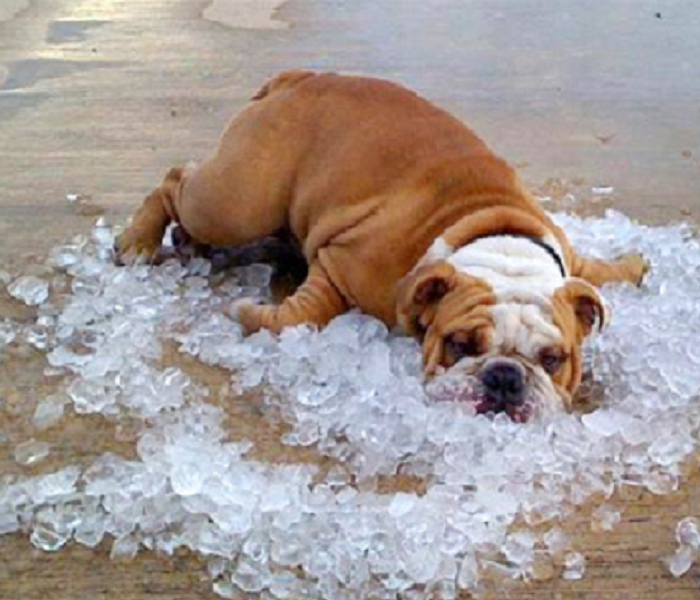 Minding the heat is everyone's responsibility.
Minding the heat is everyone's responsibility.
Tips for Preventing Heat-Related Illness (original source cdc.gov)
Wear Appropriate Clothing: Choose lightweight, light-colored, loose-fitting clothing.
Stay Cool Indoors: Stay in an air-conditioned place as much as possible. If your home does not have air conditioning, go to the shopping mall or public library—even a few hours spent in air conditioning can help your body stay cooler when you go back into the heat. Call your local health department to see if there are any heat-relief shelters in your area.
- Keep in mind: Electric fans may provide comfort, but when the temperature is in the high 90s, they will not prevent heat-related illness. Taking a cool shower or bath or moving to an air-conditioned place is a much better way to cool off. Use your stove and oven less to maintain a cooler temperature in your home.
Schedule Outdoor Activities Carefully: Try to limit your outdoor activity to when it’s coolest, like morning and evening hours. Rest often in shady areas so that your body has a chance to recover.
Pace Yourself: Cut down on exercise during the heat. If you’re not accustomed to working or exercising in a hot environment, start slowly and pick up the pace gradually. If exertion in the heat makes your heart pound and leaves you gasping for breath, STOP all activity. Get into a cool area or into the shade, and rest, especially if you become lightheaded, confused, weak, or faint.
Wear Sunscreen: Sunburn affects your body’s ability to cool down and can make you dehydrated. If you must go outdoors, protect yourself from the sun by wearing a wide-brimmed hat, sunglasses, and by putting on sunscreen of SPF 15 or higher 30 minutes prior to going out. Continue to reapply it according to the package directions.
- Tip:Look for sunscreens that say “broad spectrum” or “UVA/UVB protection” on their labels- these products work best.
Do Not Leave Children in Cars: Cars can quickly heat up to dangerous temperatures, even with a window cracked open. While anyone left in a parked car is at risk, children are especially at risk of getting a heat stroke or dying. When traveling with children, remember to do the following:
- Never leave infants, children or pets in a parked car, even if the windows are cracked open.
- To remind yourself that a child is in the car, keep a stuffed animal in the car seat. When the child is buckled in, place the stuffed animal in the front with the driver.
- When leaving your car, check to be sure everyone is out of the car. Do not overlook any children who have fallen asleep in the car.
Avoid Hot and Heavy Meals: They add heat to your body!
Stay Hydrated
Drink Plenty of Fluids: Drink more fluids, regardless of how active you are. Don’t wait until you’re thirsty to drink.
- Warning: If your doctor limits the amount you drink or has you on water pills, ask how much you should drink while the weather is hot.
- Stay away from very sugary or alcoholic drinks—these actually cause you to lose more body fluid. Also avoid very cold drinks, because they can cause stomach cramps.
Replace Salt and Minerals: Heavy sweating removes salt and minerals from the body that need to be replaced. A sports drink can replace the salt and minerals you lose in sweat.
- If you are on a low-salt diet, have diabetes, high blood pressure, or other chronic conditions, talk with your doctor before drinking a sports beverage or taking salt tablets.
Keep Your Pets Hydrated: Provide plenty of fresh water for your pets, and leave the water in a shady area.
Stay Informed
Check for Updates: Check your local news for extreme heat alerts and safety tips and to learn about any cooling shelters in your area.
Know the Signs: Learn the signs and symptoms of heat-related illnesses and how to treat them.
Use a Buddy System: When working in the heat, monitor the condition of your co-workers and have someone do the same for you. Heat-induced illness can cause a person to become confused or lose consciousness. If you are 65 years of age or older, have a friend or relative call to check on you twice a day during a heat wave. If you know someone in this age group, check on them at least twice a day.
Monitor Those at High Risk: Although anyone at any time can suffer from heat-related illness, some people are at greater risk than others:
- Infants and young children
- People 65 years of age or older
- People who are overweight
- People who overexert during work or exercise
- People who are physically ill, especially with heart disease or high blood pressure, or who take certain medications, such as for depression, insomnia, or poor circulation
Visit adults at risk at least twice a day and closely watch them for signs of heat exhaustion or heat stroke. Infants and young children, of course, need much more frequent watching.
Top 4 Causes for Home Damage, According to Travelers Insurance
8/4/2020 (Permalink)
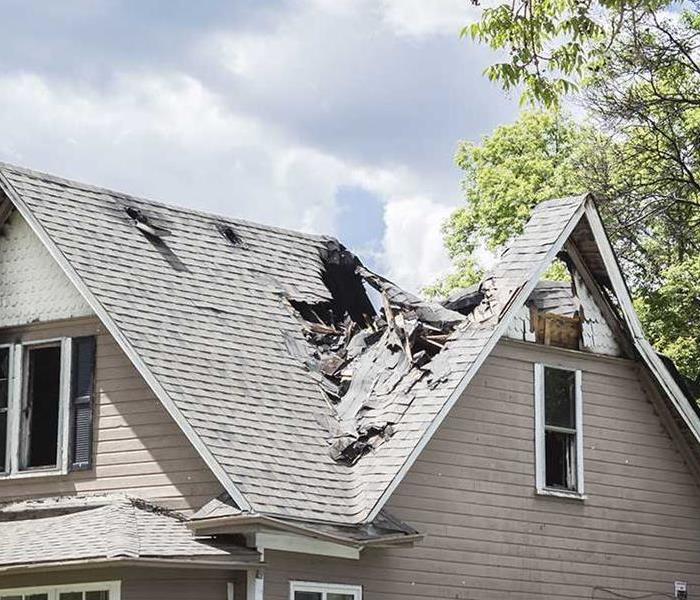 No one wants to imagine something going wrong with their house.
No one wants to imagine something going wrong with their house.
While no one wants to imagine something going wrong with their house, accidents happen. It’s important to be prepared for the worst. When a bad storm hits your town or a pipe bursts in your basement, for example, it can create severe and costly property damage.
Home insurance is critical to protecting your home when damage strikes; it’ll help cover the expenses when you need to fix or replace something. While claims may be unpredictable, there are a few things you can do around your house to help prevent these common causes of property damage in the first place.
- WIND
The Damage
The most common causes of property damage and home insurance claims are wind-related. Gusts of wind can uproot trees, damage roofs or even send outdoor furniture flying through windows.
What You Can Do
It’s important to limit the risk before the wind picks up. Look around your house and ask yourself ‘What could hit my home?’ Trees that are close to your home, furniture, etc can all be a cause of damage in high winds. Once you identify your risks, take precautions. Keeping trees pruned, strengthening structures and storing projectile objects indoors before a storm are great ways to get your home ready. This simple step could be the difference between a home insurance claim or just a little clean up once the storm passes.
- NONWEATHER-RELATED WATER
Twenty percent of reported property damage comes from non-weather-related water.
The Damage
When you think of water damage, you likely think of weather and flooding as the most common source. However, it’s actually more common for damage to come from water that is already inside your home. Things like the dishwasher, washing machine, pipes and toilets can all cause leaks or flooding.
What You Can Do
Always know where the water sources are and perform routine inspections. For example, if your washing machine has a rubber hose, you should check it annually for cracks or wear. Also consider turning off your water when you will be away from home for a long periods of time.
- HAIL
The Damage
Hail affects many different areas of the country, sometimes unexpectedly. Because it is often difficult to avoid hail striking, it is no surprise that it causes costly damage to cars and homes.
What You Can Do
If you have car, park it in a garage or under a roof if possible. Move items susceptible to hail damage, such as patio furniture, indoors or under a covered area.
While you can’t do much to protect your home or roof, you can try to strengthen it before hail strikes. Installing sturdy building materials that are more resistant to this type of hazard can reduce the damage.
- WEATHER-RELATED WATER
The Damage
While it may not be as high on the list as non-weather-related water claims, storms can bring costly water claims. Heavy rain and flooding can do a number on your house, but there are a few things you can do to prevent damage.
What You Can Do
Make sure your roof is in good condition and that the shingles aren’t old and worn. Downspouts should direct water away from home. Keep your gutters properly cleaned and free of debris. Take note of any areas where water pools near your home after a heavy rain and level the ground or install drainage. During the winter months, remove snow accumulation from the roof after every storm and insulate pipes.
Please follow our page, as we continue to explore the benefits of mitigation, and how this approach helps both your clients and your business. Please call us with any questions you have, 715-381-2266. Visit our site: SERVPRO of The Saint Croix Valley
We Answer The Phone
7/21/2020 (Permalink)
 "Guess what! We answer the phone!"
"Guess what! We answer the phone!"
Not a week goes by that we don’t get a call from a new client in desperate need of help. At the end of the phone call our office staff always asks, so how did you hear about SERVPRO? Most of the time we get an answer like my parents, neighbor, or a friend used your services in the past. Or, we looked you up on line, or saw your social media page. Not a month goes by that we don’t get a call, where the answer is, you are the only ones that answered my call. When people call us, it’s usually not because something fun and exciting happens. It’s usually on one of their worst days that they call us. When you are having a bad day, you just want someone to respond and help.
Guess what! We answer the phone! When a franchise’s office is closed for the night, the weekend, or a holiday we are still on call and answering the phone. SERVPRO headquarters has a 24 hour call center that routes all calls to the appropriate franchise. Each franchise has a dedicated person answering the phone 24 hours a day, even in the middle of the night. And finally techs are on a rotating on call schedule to make sure we can gets boots on the ground of any emergency when the calls come in.
Please follow our page, as we continue to explore the benefits of mitigation, and how this approach helps both your clients and your business. Please call us with any questions you have, 715-381-2266. Visit our site: SERVPRO of The Saint Croix Valley
Honey, We Have a Pool In the Basement
7/8/2020 (Permalink)
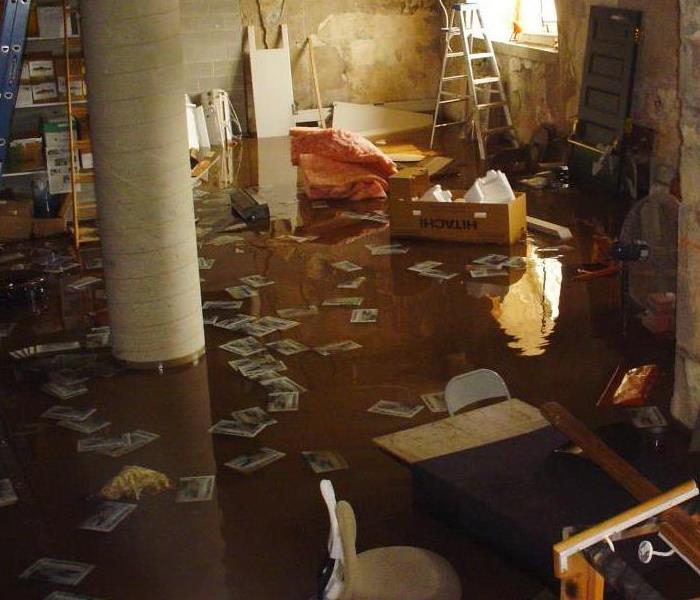 Sights like these can take your breath away.
Sights like these can take your breath away.
With the recent storm our office has had quite few calls about standing water in homeowners’ basements. Once the water has been mitigated, the next question we get asked is how to stop this from happening again. We aren’t experts in the stopping it from happening again area, but we can give you some suggestions to think about.
You constantly keep your gutters cleaned out, and everything unplugged, but your gutters still overflow in a heavy rain. Maybe the size of gutter you have is too small for the amount of rain that comes off your roof. If you have a 3 or 4 inch gutter system, look at installing a 5-7 inch gutter to accommodate the volume of rain. Is your problem standing water around your foundation? You may need to address your landscaping, making sure that your yard slopes away from your foundation. If your yard is properly sloped and you still have excess water sitting in your yard a French drain may help with this. Finally if your problem is seepage into your basement from a high sitting water table, a tile drain system with sump pump may be the answer. Typically you would want to discuss any of these solutions with an expert to have them properly installed.
Please follow our page, as we continue to explore the benefits of mitigation, and how this approach helps both your clients and your business. Please call us with any questions you have, 715-381-2266. Visit our site: SERVPRO of The Saint Croix Valley
Rain Rain Go Away
6/17/2020 (Permalink)
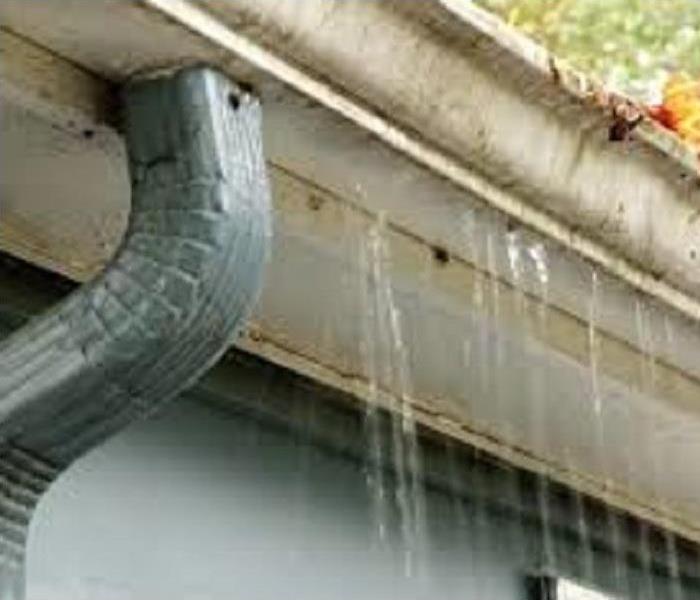 It’s a good idea to keep up with your home maintenance.
It’s a good idea to keep up with your home maintenance.
During the winter months we talk a lot about watching your roof and gutters for ice buildup, to help avoid ice dams. Today we are going to talk about your house gutters again, but only with a non winter slant. It may not be fall yet, but debris from trees still falls on your roof, the usual leaves or sticks on a winter day, or the really messy dried pine needles. All of which can plug your gutters and cause rain run off to flow over the edge and collect around your foundation.
We suggest that you periodically check your gutters and remove the buildup. Especially when the weather man is predicting a heavy rain fall. If the water over flows and lands around your foundation causing an excessive saturation, which can seep into your basement and cause damage. The good news is, SERVPRO can help with the mitigation. The bad news, homeowners insurance doesn’t always cover for seepage of this sort in most policies. That’s why it’s a good idea to keep up with your home maintenance to avoid having to call us out.
Please follow our page, as we continue to explore the benefits of mitigation, and how this approach helps both your clients and your business. Please call us with any questions you have, 715-381-2266.
Flood and Storm Damage.
6/2/2020 (Permalink)
While most business and homeowners know the destructive effects that flood damage causes, not everyone knows the right steps to take to mitigate the associated damage. These are incidents which need immediate professional intervention to learn what is restorable and what to replace. That is why it is vital for St Croix County residents to know how to act when faced with such incidents.
Remember water carries along all sorts of debris, oils, and mud into a premise. When contaminated water comes into contact with metallic surfaces, oxidation occurs, and they start to rust. To prevent such eventualities, extracting the water and cleaning is necessary. Our SERVPRO team can in some cases use wet-vacuuming to remove the debris and water. Truck-mounted pumps and portable generators for a power source are readily available from our stocked Green Fleet.
We may recommend a replacement if we notice that the water contaminated your porous materials. Where necessary, our team uses detergents and water to clean hard surfaces such as wood furnishings, desks, and metal cabinets before we dry them.
To dry your property, we set up air movers and leave them in position until we achieve the desired evaporation. Since evaporation moves moisture into the air, we position dehumidifiers to lower the humidity. Dependent on the situation at hand, we may decide to use desiccant, low grain or refrigerant dehumidifiers.
SERVPRO of The Saint Croix Valley is just a phone call away, 24 hours a day, 7 days a week. 715-381-2266.
Danger of a Leaky Roof
5/1/2020 (Permalink)
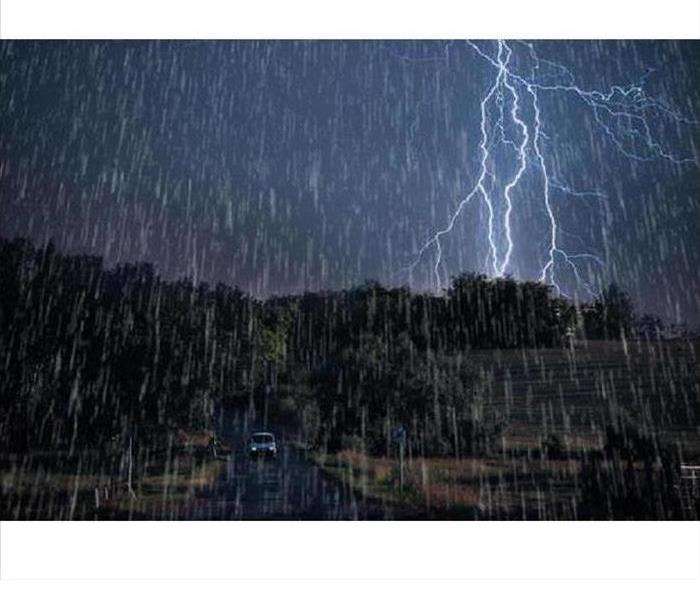 Heavy rains can expose roof leaks
Heavy rains can expose roof leaks
With all the different kinds of weather that we have had in the last month or so in the Saint Croix Valley, a durable roof is one of the most important infrastructures of a house, right after a strong, sturdy foundation. Just like it’s necessary to fix cracks in a foundation to ensure the rest of a house isn’t affected from the ground up, it’s important to fix leaks in a roof to protect a home from the top down, too. If you suspect you have a leaky roof, a roofing contractor can determine the cause and perform roof repairs, if necessary. To avoid any leaks or other issues from happening in the future, make sure to schedule regular inspections, perform general maintenance and upkeep, and have repairs completed as quickly as possible, since acting quickly could help you save time and money.
Causes and Sources of Leaks
There are a number of reasons why a roof may develop leaks, from both natural and manmade causes. No matter the cause, it's imperative to seek the services of a reliable roofing contractor to get your roof back in its best shape so that your home is protected from the elements.
SHINGLES AND FLASHING
Something as small and simple as a broken shingle could be the culprit of a leak. Severe weather, hail and high winds can cause shingles to become loose, crack and break off, leaving your roof exposed. If the nails used to secure shingles aren't properly sealed with a durable coating like roofing cement, it can leave exposed holes which can allow water and moisture to get into the attic. Broken or cracked flashing—the pieces of material installed under shingles, on joints and around chimneys—can also cause leaks. Both damaged flashing and missing shingles can be easily identified, usually as different, discolored patches or exposed areas on a roof. You may even find pieces of them in your yard after a bad storm.
IMPROPER INSTALLATION/REPAIRS
If you've had previous roof repairs done but if a leak keeps coming back, you've either got a problem with the workmanship of the roofing contractor who did the work or the materials they used (or both). Improperly installing elements such as skylights and chimneys can also cause roof leaks - this can happen from incorrectly measuring and fitting fixtures and/or insulation that's started to decay or disintegrate. Leaks from this kind of problem are generally easy to spot. Just look for wet spots or small streams of water coming out of skylights or running down walls/chimneys when it rains.
PLUMBING AND PIPE PROBLEMS
Pipes run throughout the home including the roof, which means there are a number of areas that are common leak sources related to your home's plumbing and ventilation system. These include plumbing vent pipes, ventilation fan ducts, attic vents and exhaust pipes/flues (for appliances). Anytime there are worn or cracked rubber boots and/or broken flashing around the vent pipes that come out of the roof, it's likely you're in need of repairs.
CONDENSATION AND MOISTURE
Since the attic is usually the least insulated—and the highest elevated—place in your home, it is more prone to mold and mildew growth from excessive moisture that can accumulate when condensation becomes trapped. The cause of the moisture is from wet weather such as rain, sleet, and hail, but also ice dams melting and the fluctuation in temperatures when seasons change. You'll most likely notice a smell—before you see the mold—as a sign of a leak in your roof.
What Can Happen if You Don't Get Roof Repairs
Whether you’re dealing with issues associated with weather and moisture or improperly installed parts, it’s essential to perform any necessary roof leak repairs as soon as possible – not only to fix the problem, but also to prevent any future damage. For example, if you have a moisture issue causing a leak that goes untreated, it could result in mold and mildew growth, which could not only destroy the wood in the attic, but also negatively affect your health.
Every roof experiences some level of wear and tear from all types of weather (sun, rain, hail, extreme heat, wind, etc.). As a home's first line of defense from these elements, it's important to make sure you have a durable, weatherproof roof that's properly sealed and maintained in order to increase the lifecycle of the roof and decrease the risk of damage to it.
The Importance of Roof Repairs
If you have a roof leak, repair it as soon as possible to avoid further damage and to help protect your home from bigger problems such as flooding. Contact a roofing contractor to have a thorough assessment of the roof completed and get advice on what steps you need to take to repair the damage. It’s best to work with a roofing contractor because their expertise is in roofing and they will be able to pinpoint and address your specific needs. Depending on the cause of the damage, your home insurance company may cover the costs of the roof repair, so make sure to contact your insurance company, too.
Lastly, if you should have a roof that leaks into the structure and need to begin the mitigation process, call SERVPRO of The Saint Croix Valley. Our team of professionals specialize in removal and mitigation of storm damaged material and have the experience of quickly drying out affected areas from storm and weather damage before it is made worse. We at SERVPRO of The Saint Croix Valley partner with all major insurance companies and vendors to make the transition back to “Like it never even happened,” as quickly as possible.
Call us today and let us show you. 715-381-2266
Independent Franchises, But One National Team
4/21/2020 (Permalink)
 While Franchises stand alone they serve under one umbrella.
While Franchises stand alone they serve under one umbrella.
by Lance Lueck, Business Development Manager
As with anyone in sales, I get asked one question more than any other. What makes SERVPRO different then the next restoration company? It’s a great question to ask, and really struck me as I was at a vendor convention hosted by an insurance company. Sitting there at our booth I could see that the majority of vendors at this adjuster’s convention offered the same type of services we did. They all did water and fire damage restoration and mold mitigation. Some also did the same types of cleaning services we offer. Others included the mitigation and reconstruction of the structure as well. So what really does make us different?
It really starts with the fact that we are a national company, with independent owner operators. Our partners at SERVPRO Headquarters in Tennessee, set the tone for how operations are carried out. Be it from a piece of equipment that is tested and put through the ringer to make sure it will hold up in the field for our techs. Or the fact that when a disaster strikes we can quickly mobilize and send resources from around the country to help. We truly are faster to any size disaster.
None of this works though without the men and women at the franchise level. Be it the normal daytime routine, or reporting to the scene of a disaster in the middle of the night, SERVPRO techs answer the call knowing that they are walking into most people’s worst nightmare, and are the calming voice of reason and reassurance to our clients. They aren’t comic book heroes, but they do save the day on a regular basis.
Finally, we answer the phone! When a franchise’s office is closed for the night, the weekend, or a holiday we are still on call and answering the phone. SERVPRO headquarters has a 24 hour call center that routes all calls to the appropriate franchise. Each franchise has a dedicated person answering the phone 24 hours a day, even in the middle of the night. And finally, our techs are on a rotating on-call schedule to make sure we can gets boots on the ground of any emergency when the calls come in.
Please follow our page, as we continue to explore the benefits of mitigation, and how this approach helps both your clients and your business. Please call us with any questions you have, 715-381-2266 in WI, or 651-705-7028 in MN. Visit our sites: SERVPRO of The Saint Croix Valley and SERVPRO of Stillwater, Oakdale, Mahtomedi
Mold In The Attic
4/14/2020 (Permalink)
If you’re like most of us, you rarely if ever venture into your home’s attic. Why would you? It’s not usually a place you care to venture and for the most part if you do it’s because something isn’t going well. With warmer temps here for the summer, we start to see an increase in jobs where homeowners have discovered mold damage in their attic. In this blog post, we’ll talk through what we typically see when homes have considerable amounts of attic mold and help you understand ways you can make sure it doesn’t happen to you.
Why mold grows in attics
Mold damage in your attic space occurs for the same reasons it occurs anywhere else in a dwelling. It’s a combination of a few things:
() the right temperature – mold spores like warmer, ambient temps. In fact, it likes about the same temp range as we do, between 60-80 degrees Fahrenheit.
() food – no, not crumbs from discarded food a home service technicians might have left while doing some work up in your attic long ago. Mold likes anything that is high in cellulose. Unfortunately for homeowners, that’s pretty much anything in your attic, like plywood, wood joists, roof decking, etc.
() elevated moisture – many homeowners don’t realize that moisture is found in every surface of their home, as it should be. If those surfaces were completely devoid of moisture they wouldn’t perform their duties properly. But if a surface gets too much moisture in it, that’s the trigger mold needs to start growing. Another thing most homeowners don’t realize is that mold spores are present in most environments, and certainly in every home or other type of dwelling. It exists naturally and in low levels and is completely harmless to humans and pets. But with the right conditions, it can grow quickly and spread, causing wide spread damage to your home and potentially cause health effects for the home’s inhabitants.
As you can see from the list above, 2 of those things are normal. It’s the 3rd thing, elevated moisture that is not normal and creates the right environment for a mold problem. So now let’s talk through how moisture gets into attics and what you can do to make sure it doesn’t get into yours.
Causes of attic mold growth
When we are called to a home and discover mold in the attic, the culprits are usually pretty easy to spot. There are only so many ways moisture finds its way into an attic. Here’s what we usually see:
Venting directly into the attic
Many bathrooms are equipped with vents that take the warm, wet air released when a shower is running and remove it from the bathroom. Unfortunately, sometimes a misguided homeowner or shoddy handyman will simply install the vent fan such that the air is pushed into the attic where it has nowhere to escape. Bathroom fans should be vented to the outside of the house. If you have an older home that is equipped with one or multiple of these types of exhaust fans, it’s probably worth you taking a look in the attic space to make sure it’s vented properly.
A leaky roof
One culprit we find when inspecting an attic with mold is a leaky roof. Just one damaged or misplaced shingle can allow rain water to slowly seep into your attic. While most people picture a deluge of water coming through their ceiling, more often than not, a roof leak will just allow a slow amount of rain water to enter the attic, usually soaking the roof deck and eventually dripping down onto the attic floor and/or your exterior walls. We recommend that you (safely) inspect your roof’s exterior each spring and it’s also a good idea to just crawl up into your attic and peer at the interior decking of the roof. If you start to see staining, it’s a sign you have some moisture intrusion that needs to be addressed!
Improper Ventilation
Your attic needs to breathe. When we have extended periods of extremely cold weather like we had this past winter, warm air leaks from the interior of your home into the attic. This warm wet air will condensate on the roof deck and possibly ice over the ventilation. One it warms up, this frost will thaw causing the roof deck to get wet. One sign to look for is roofing nails that are rusty. We recommend working with an insulating contractor to make sure your attic vents well so you can avoid this problem.
With a few simple steps and things to be mindful of your attic can remain trouble free. If you suspect you have a problem feel free to give us a call. 715-381-2266
Disaster Shut Down
4/1/2020 (Permalink)
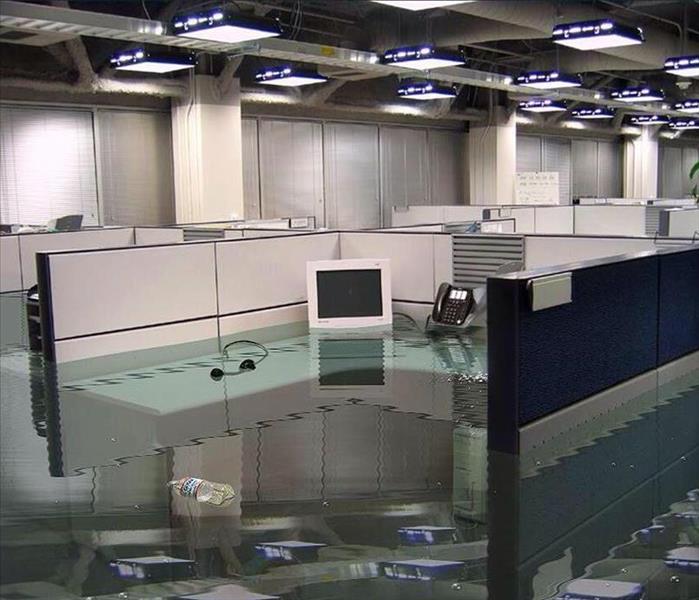 Don't get caught unprepared.
Don't get caught unprepared.
When you own a business, there’s never a convenient time for a disaster to strike. Fire, flooding, or destruction from a natural disaster can take time to mitigate and should be dealt with immediately before the damage spreads. Once the immediate danger is handled, cleanup and restoration of the damage can begin. In a world where time means money, any amount of downtime can put your business at risk of lost revenue and productivity. Remember, every hour spent cleaning up and repairing damage is an hour of opportunity lost for your business.
If you are a small business and have limited resources, it can be difficult to recover from a disaster, especially when it interrupts your daily operations. However, with the support of the right disaster commercial recovery team and a comprehensive recovery strategy, you can get back to business faster.
Be Prepared Before an Emergency Hits
According to FEMA, almost half of all small businesses affected by a disaster will never re-open their doors. For those that do, 90 percent will fail within a year if they don’t resume their operations within five days of the damage occurring. Why is that? Depending on the type and extent of damage, general operations may have to stop within the affected area. Meanwhile, life as usual goes on for customers and clients who are not directly impacted by the disaster. While some may be willing to wait for the business to reopen its doors, any long-term business disruption can send customers and clients looking elsewhere to get their needs met.
Businesses, large and small have a better chance of recovering from a disaster and successfully returning to business as usual if they have a plan before disaster strikes. Even when a disaster plan does exist, only 80 percent of companies spend time re-evaluating their plan each year. If you do not have one, it’s time to create one, so your business can go on as usual in the event of an emergency.
Creating a Emergency Response Plan (ERP)
If a fire, flood, or natural disaster were to occur, would you know who to contact to save your business? Regardless of the size of your business, having a ERP for your business will give you a roadmap to recovery if an emergency occurs. This plan will help you save time and limit your property losses by saving as many assets as possible. It includes:
commercial services - commercial space with painters plastic hanging in windows
Compiling a list of emergency contacts, including phone numbers and addresses.
Phone calls
E-mails
What is Involved in Commercial Restoration?
SERVPRO of The Saint Croix Valley offers multiple restoration services to our commercial clients, including:
Emergency mitigation services to protect remaining business assets and building from secondary damage
Stabilization of building
Boarding-up your facility
Drying and dehumidifying your building
Recovering documents
Restoring electronics and wiring
Restoring your location to preloss condition
Reconstructing your building
What Should You Do if a Disaster Shuts Down Your Business?
When disaster strikes in the Saint Croix Valley and surrounding areas, SERVPRO of The Saint Croix Valley is ready to get to work. As a leader in property emergency services, we can help your business overcome the devastating setbacks of property damage caused by fire, water, or other natural disasters. We can assist our commercial clients in preloss planning and project management in helping create a solid business disaster recovery plan.
10 Tips to Keep Your Office Space Clean
4/1/2020 (Permalink)
Maintaining a clean work space means a healthy environment for your employees and a presentable establishment for clients. Avoid germ buildup and dirty spaces with these simple tips to keep your office space clean.
Desk Duty
All the hustle and bustle of a busy workday usually leads to a cluttered desk. Take some time at the end of your day to clean your desk area. Straighten out office documents and throw excess papers, food wrappers and other trash away.
Avoid Food Messes
When work gets busy, it’s easier to stay at your desk and have lunch while typing away on your computer. Eating at your desk, however, guarantees a messy workspace as crumbs and even liquids fall into the crevices of your keyboard or stick to the desktop. Over time, stains become harder to remove and bacteria begins to accumulate.
Kill the Germs
If eating at your desk is your thing, then make sure to maintain a healthy work environment. Dust and other particles accumulate overtime. Wipe those germs away at least once a week with a quick wipe down of your desktop with a multi-purpose cleaner.
Antibacterial is Your Best Friend
Germs spread fast in any environment. You’ll want to keep hand sanitizers in stock and easily available to avoid the spread of germs. The last thing you want is for the entire office to come down with a stomach bug, flu or cold.
Group Effort at Play
Break rooms or common areas should be cleaned regularly to avoid germ buildup. As a place where all workers spend time, don’t shy away from maintaining this area. Avoid leaving dishes in the sink, throw out old takeout from the refrigerator and sanitize the countertops.
Trash Duty
If your office doesn’t have a daily janitorial service, make sure to empty your trash every night or every other night so bacteria and odor don’t become a problem. Make this a group effort. Designate a different work associate to take care of the trash on certain days.
Get Those Hard to Reach Places
When it comes to a full office cleaning, make sure all spaces are accessible. You may consider rearranging office furniture to avoid hard-to-reach places, like large gaps behind filing cabinets or sofas.
Carpet and Tile Cleaning
With paperclips, staples and papers, office floors can get pretty dirty. Whether you need to vacuum or mop, keeping the office floors clean makes your workspace safe and presentable for clients and visitors.
Do Your Part
Your area is your responsibility. Take the time to ensure it is maintained on a day-to-day basis. Office cleanliness is a group effort that can be made easy when everyone participates.
If you need commercial cleaning, such as carpet cleaning or clean up after a fire or water loss, give the pros at SERVPRO of The Saint Croix Valley a call 715-381-2266.
Independent Franchises, But One National Team
3/28/2020 (Permalink)
As with anyone in sales, I get asked one question more than any other. What’s makes SERVPRO different then the next restoration company? It’s a great question to ask, and really struck me as I was at a vendor convention hosted by an insurance company. Sitting there at our booth I could see that the majority of vendors at this adjusters convention offered the same type of services we did. They all did water and fire damage restoration and mold mitigation. Some also did the same types of cleaning services we offer. Others included the mitigation and reconstruction of the structure as well. So what really does make us different?
It really starts with the fact that we are a national company, with independent owner operators. Our partners at SERVPRO Headquarters in Tennessee, set the tone for how operations are carried out. Be it from a piece of equipment that is tested and put through the ringer to make sure it will hold up in the field for our techs. Or the fact that when a disaster strikes we can quickly mobilize and send resources from around the country to help. We truly are faster to any size disaster.
None of this works though without the men and women at the franchise level. Be it the normal daytime routine, or reporting to the scene of a disaster in the middle of the night, SERVPRO techs answer the call knowing that they are walking into most people’s worst nightmare, and are the calming voice of reason and reassurance to our clients. They aren’t comic book heroes, but they do save the day on a regular basis.
Finally, we answer the phone! When a franchise’s office is closed for the night, the weekend, or a holiday we are still on call and answering the phone. SERVPRO headquarters has a 24 hour call center that routes all calls to the appropriate franchise. Each franchise has a dedicated person answering the phone 24 hours a day, even in the middle of the night. And finally techs are on a rotating on call schedule to make sure we can gets boots on the ground of any emergency when the calls come in.
Please follow our page, as we continue to explore the benefits of mitigation, and how this approach helps both your clients and your business. Please call us with any questions you have, 715-381-2266. Visit our site: SERVPRO of The Saint Croix Valley
4 FAQs on Flammable Gas Safety
3/27/2020 (Permalink)
Propane, hydrogen, butane, ethylene, and other flammable, compressed gases present hazards without the right precautions. While fire safety maintenance will help you avoid trouble, you should also understand how to handle and store gas cylinders. Here’s what to know to keep your facility safe.
Common Questions About Flammable Gases
Can I store containers outdoors?
Yes, as long as the manufacturer's instructions permit outdoor storage. Closely follow the guidelines on all cylinder labels. If a label is missing or damaged, you may need to call the manufacturer.
Cylinders stored outdoors must remain upright on compacted, level surfaces. These should be far away from drainage areas, manholes, or other openings. Use an open-sided enclosure with a weatherproof roof to protect the cylinders from sunlight, snow, and other elements.
What about indoor storage?
Fire safety maintenance. Indoor storage is also possible as long as you follow all ventilation guidelines outlined by the manufacturers. Store the gases in a separate building that has noncombustible structural components that resist fire for at least 120 minutes. The area should also have lightweight roofing and explosion vents.
Keep gases on the ground floor and place electrical wiring outside of the building to further limit the chances of fires and explosions.
What are the best materials for securing the cylinders?
Unrestrained cylinders could roll away or fall, so you must keep them secure. Use specialized chains, straps, and bungee cords. Refer to the label or manufacturer’s instructions for information on how to secure the units.
How should I handle the cylinders?
Inspect all items before handling. Do not handle any cylinder that has dents, severe corrosion, or other visible signs of damage. Avoid contact if you notice grease, oil, solvent, or dirt, which could cause explosions.
Open cylinder valves only with the manufacturer-provided key, and ensure you are working away from all heat sources. You must also have fire safety equipment within reach and follow all other manufacturer’s guidelines, such as opening specific valves if you’re working with an irritating gas.
5 Quick Cleaning Tips That Can Boost Productivity At Work
3/27/2020 (Permalink)
It’s a well-known fact that a neat and tidy offices increase productivity. Not to mention, keeping your office clean of germs will encourage less employees to take off work. Giving your office a deep clean Spring Cleaning will help boost your productivity and give your office the look it needs to attract the best customers.
If you are looking to clean your office yourself, these are the top 5 things you can do to keep your office clean in order to ensure and increase productivity
Clean your phones!
Phones are a cesspool of germs. When your employees get sick, productivity declines. If they continue to do so, it becomes an even bigger problem. Cleaning your phones daily with an anti-bacterial wipe is the number one way to ensure phones are germ free and your employees are healthy enough to produce.
Get rid of that smell
Floors and carpets that are not properly cleaned will absorb bad smells. It’s proven that certain smells, such as orange, increase energy and productivity. Working In an environment that doesn’t smell good is a factor that declines worker morale. Cleaning and shampooing your carpets will guarantee this problem is corrected. You can rent a carpet vacuum and risk the chance of harboring mold under the damp carpets, or you can call a commercial cleaning service who may be better equipped to handle that kind of situation.
Keep desks dust free
Dust carries many allergies which cause a lot of people to get sick. Not to mention, working in a dirty space declines staff morale. Dusting your commercial space, as well as all of the desks every night is very important. It;s also important to move all the supplies off a desk and wipe the desks once a week.
Sweep that floor
Working in an office space that is cluttered or dirty does not help increase productivity. On the contrary, it decreases productivity. It is also something that may turn off prospect customers. Sweeping floors every night is imperative to having a clean and put-together office. First appearances are very important and if a customer sees a dirty floor, they may not trust your product or service
Empty the trash
Full trash cans attract little critters. Especially trash cans full of snack and lunch wrappers. Emptying the trash daily is very important when it comes to maintaining the productivity in an office. An employee working in an area that smells like a garbage bin won’t be as focused and productive as one working in an office with fresh air. Not to mention these little critters carry contaminants that may make you and your employees sick.
Fire Damage Restoration Process
3/27/2020 (Permalink)
Every fire damage event is a little different, and requires a unique solution, but the general process stays the same. The steps listed below illustrate our process for the “typical” fire damage emergency.
Step 1: Emergency Contact
The restoration process begins when you call the SERVPRO Customer Care Center, which is staffed 24 hours a day. Our specialist will ask a series of questions regarding the fire damage event that will help us dispatch the nearest SERVPRO Franchise Professional with the appropriate equipment and resources.
Step 2: Inspection and Fire Damage Assessment
Our Professionals will carefully inspect and test adjoining rooms of your property to determine the extent of the fire, smoke, and soot damage. This step is crucial to developing a plan of action.
Step 3: Immediate Board-Up and Roof-Tarp Service
Fire damage can often compromise windows, walls, and roofs. To maintain security and to protect against further damage, the SERVPRO Franchise Professional can board up missing windows and walls and place tarps on damaged roofs.
Step 4: Water Removal and Drying (if water damage is present)
The water removal process begins almost immediately and removes the majority of the water. They will then use dehumidifiers and air movers to remove the remaining water and complete the drying process.
Step 5: Removal of Smoke and Soot from All Surfaces
The SERVPRO Franchise Professionals use specialized equipment and techniques to remove smoke and soot from ceilings, walls, and other surfaces.
Step 6: Cleaning and Sanitizing
They will clean all of the restorable items and structures that were damaged by the fire. They use a variety of cleaning techniques to restore your belongings to pre-fire condition. They’re also trained to remove odors using industrial air scrubbers and fogging equipment.
Step 7: Restoration
Restoration is the final step—getting your home or business to its pre-fire condition. Restoration may involve minor repairs, such as replacing drywall, painting, and installing new carpet; or it may entail major repairs such as the reconstruction of various areas or rooms in a home or business.
Not So Pleasant Home Away From Home
3/27/2020 (Permalink)
For most people that are fortunate enough to own a cabin up north, or a second vacation home, the thought of getting away is filled with thoughts of unplugging, relaxing and family time. Unfortunately, that wasn’t the case for one of our recent clients. When they arrived at their second property to enjoy a few days of quiet, they opened a door to a home full of water damage and mold.
What do you do? You are far from home, and don’t really know the area. Luckily for these clients we had been in the area a few months prior, and their neighbor we worked for gave our number to them. We were able to coordinate with their insurance adjuster, and work out the cause of the damage and scope of the project. It was discovered after we brought in a local HVAC provider that the heating core on the furnace had cracked, causing the temperature inside the house to drop, and allowed the water line to freeze and burst.
Before we could stabilize the environment in the home we needed to get heat back into it. That is where we helped the client coordinate with the HVAC company to bring in and install a new furnace. Once in, we were able to stabilize the climate and coordinate with a mold testing vendor to determine the appropriate course of action to mitigate the mold. Once the area was properly cleaned, including cleaning the duct system, and damaged areas removed a contractor was able to come in and start the rebuild.
Please follow our page, as we continue to explore the benefits of mitigation, and how this approach helps both your clients and your business. Please call us with any questions you have, 715-381-2266. Visit our site: SERVPRO of The Saint Croix Valley
When It Rains, It Pours
3/25/2020 (Permalink)
It has been raining for three days straight and you feel like you should have webbed toes by now. By the end of the third day you come home from a long day at work and all you want to do is relax in your newly finished basement. That’s when you walk down the stairs and step on the carpet. You feel a squish between your toes, not that normal warm and fuzzy feeling, but that cold, wet and I think I need my waders feeling. The saturation of water outside from the rain found a way into your basement, soaking your drywall and carpet. You ask yourself, ugh, what to do now?
You have a few options:
- Try to run fans and dehumidifiers and try to manage the water yourself. Saves money up front, but could lead to major problems later in the year with potential mold issues or degrading of the building materials.
- You could bring a contractor into the project. Contractors do fabulous work, however they may tend to demo more of the area then is needed, as water restoration work is not there area of expertise.
- Call a Mitigation company like SERVPRO of The Saint Croix Valley to evaluate the loss. Once mitigation begins, materials that can be saved are salvaged and dried. Portions that cannot be salvaged are removed, and instead of replacing whole sheets of drywall you have a cost savings of only replacing what was damaged for example.
A property loss to your home is a stressful event, and it can seem like the end of the world. SERVPRO of The Saint Croix Valley understand these feelings and are able to mobilize quickly to start mitigation work 24 hours a day, 7 days a week. The faster stabilization work begins on the lost, increases the ability of mitigation to save materials.
Please follow our page, as we continue to explore the benefits of mitigation, and how this approach helps both your clients and your business. Please call us with any questions you have, 715-381-2266. Visit our site: SERVPRO of The Saint Croix Valley
Severe Weather Season Is Almost Here
3/23/2020 (Permalink)
Severe Weather Season Is Almost Here
You are resting peacefully, when you are abruptly awoken by the storm sirens going off. You rush your family down to the basement to hunker down as the storm hits. Wind, rain, hail and lightning strikes, damaging window and roofs, starting fires. In the light of day you emerge with your family safe, but your home is damaged. Your roof is partial damaged and missing, the hail and blowing debris has smashed in windows. What do you do next? Call your insurance company, but knowing that a wide area of local community has been hit, it may take time for an adjuster to get to you home. How do you secure your home and processions from further damage? Call in a mitigation company.
A company like SERVPRO of The Saint Croix Valley can be called into the disaster to start securing the homes in businesses in the area. What does that mean? Tarping and sealing that open roof, and board the broken windows. Why, because the first step is to stabilize the structure. The faster a building can be secured, and the environment inside that building can be stabilize the sooner mitigation can start. The sooner that mitigation is started, the more of the structure and personal procession can be saved. Once the mitigation is completed, the sooner reconstruction can start and the faster you can get back to living your life.
Please follow our page, as we continue to explore the benefits of mitigation, and how this approach helps both your clients and your business. Please call us with any questions you have, 715-381-2266. Visit our site: SERVPRO of The Saint Croix Valley
SERVPRO ERP, the Bridge to Your Business Continuity Plan
3/23/2020 (Permalink)
SERVPRO offers all commercial, educational, and governmental buildings a free Emergency Readiness Plan, which includes a walkthrough of the building and a report in both hard and digital copies. Which can be accessed on any mobile device, anywhere and anytime. 70% of businesses go out of business after a major disaster to the physical business, and of the 30% that make it through the disaster only half have some kind of plan in place. And that 50% is who this article is directed at.
When I sit down and chat with businesses, nursing homes, schools, city governments, or hospitals that all have some sort of plan in place they don’t initially see the value in having SERVPRO put together an ERP for them. That’s when I ask about their plan, and usually get the same types of answers: “Our employees will work remotely.” “Our residents and staff will be moved to another facility.” “Why reinvent the wheel?" And more answers along the same lines. All having to do with continuing work.
That’s when I ask the question, Well how do you plan on stabilizing the building once the disaster is under control? How do you plan on securing the premises and contents of the building? What if you as the owner or decision maker aren’t available, will the employees know how to contact the next person in line, or your insurance agent. Do they even know where the binder with the master plan is kept, and if you are at the scene, will you be able to get to it. That’s why it’s nice to have an app on your phone that you can access with ease.
If a company already has a continuity plan in place, the SERVPRO ERP is a great bridge to get your organization stable and into the plan you have in place for situations that stop you from working as normal. The faster a damaged building can be secured and mitigation can be put in place, the more of the building that can be saved and the faster the reconstruction can begin. If your business does not already have a plan in place, the ERP is a great base to build your plan from.
Please follow our page, as we continue to explore the benefits of mitigation, and how this approach helps both your clients and your business. Please call us with any questions you have, 715-381-2266. Visit our site: SERVPRO of The Saint Croix Valley
SERVPRO is Here to Help during this time of need
3/20/2020 (Permalink)
During this unprecedented time caused by the global pandemic of corona virus, this is a reminder to our customers that we are specialists in cleaning services, and we adhere to the highest cleaning and sanitation standards.
Specialized Training
We are prepared to clean and disinfect your home or business, according to protocols set forth by the Centers for Disease Control and Prevention. We have years of experience in dealing with biological contaminants, and we will go beyond the scope of work that regular janitorial staff perform on a daily basis.
The CDC encourages cleaning of high-touch surfaces such as counters, tabletops, doorknobs, light switches, bathroom fixtures, toilets, phones, keyboards, tablets and tables. Other spaces mentioned in the CDC’s guidance for commercial spaces include:
- Kitchen/Food Areas
- Bathrooms
- Schools/Classrooms
- Offices
- Retail Spaces
- Water Fountains
- Shelving/Racks
- Sales Counters
- Carpets and Rugs
- Stair Handrails
- Elevator Cars
- Playground Equipment
- Fitness Equipment
Specialized Products
The CDC recommends usage of a labeled hospital-grade disinfectant with claims against similar pathogens to the corona virus. Multiple products in the SERVPRO product line carry the EPA-approved emerging pathogens claims. While there is currently no product tested against this particular strain of the corona virus, we are following all guidelines as provided by the CDC and local authorities.
Please follow our page, as we continue to explore the benefits of mitigation, and how this approach helps both your clients and your business. Please call us with any questions you have, 715-381-2266.
Well I Guess My Pipes Froze This Winter
2/26/2020 (Permalink)
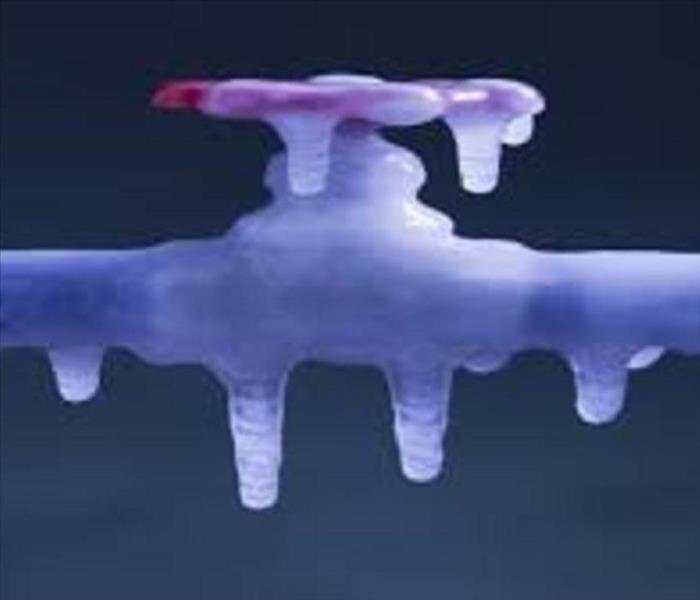 Frozen Pipes Can Be a Hidden Surprise.
Frozen Pipes Can Be a Hidden Surprise.
You’ve made it to the end of another winter of cold long nights. You didn’t have to call out SERVPRO because you took care of the snow on your roof and stopped the ice dam build up. You kept the heat in the house above 55 degrees all winter and turned off your water when you went on that tropical vacation in January.
It’s time to start the clean up the spring and summer seasons. You hook up your hose to your pressure washer to clean the winter grime off your gutters and eaves. Pull the trigger on the pressure washer and, nothing happens. That’s when you realize that you don’t have any water pressure, but where is the water going.
You turn off the outside facet and run downstairs, to find that water has been running into you finished man cave basement. The one thing you didn’t check was the pipe running to that outside facet, and you may have forgotten to open the facet to run the rest of the water out of it when you shut the source off. It’s pretty common and we aren’t surprised that it happened, we get quite a few calls at SERVPRO in the spring in early summer about this exact same thing.
Please follow our page, as we continue to explore the benefits of mitigation, and how this approach helps both your clients and your business. Please call us with any questions you have, 715-381-2266. Visit our site: SERVPRO of The Saint Croix Valley
Tis the Melting Season
2/24/2020 (Permalink)
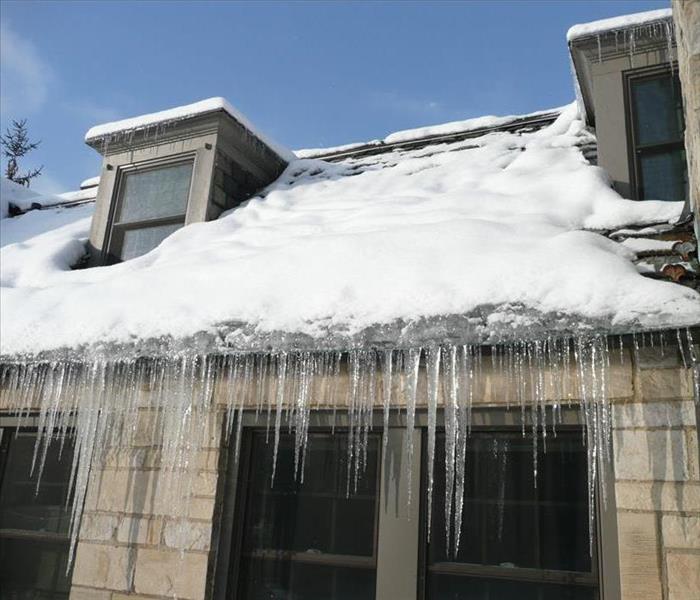 While they might be pleasing to the eye, ice dams can be very destructive to property.
While they might be pleasing to the eye, ice dams can be very destructive to property.
With temperatures over 40 degrees this weekend, we are reminded of the approach of spring, and with that, winter run off. What have you done to prepare your home for the winter melt? If you remember last year in the Saint Croix Valley region, the spring brought rivers running over their banks, parking lots flooding, businesses, schools and home basements filling with water. Now with last year’s crazy weather, there wasn’t much you could do to combat the flooding. On a more manageable year like the winter we’ve had, there are a few things you can do.
First, way back in the fall you should have clear your gutters on the roof out one more time, once the leaves were off the trees. This allows for the roof snow to melt off and drain properly, avoiding water running over the sides and pooling next to your house’s foundation. Throughout the winter it’s a good idea to rake the snow off your roof as well, this will help avoid ice dams on your roof. This will also help with the flow of water once the roof snow starts to melt.
Around the foundation of your house you will want to shovel the snow away and make sure that melting snow flows away from your home. If you do all of this, and mother nature still decides to not play nice, SERVPRO of The Saint Croix Valley will be here to help, make it like it never even happened.
Please follow our page, as we continue to explore the benefits of mitigation, and how this approach helps both your clients and your business. Please call us with any questions you have, 715-381-2266. Visit our site: SERVPRO of The Saint Croix Valley
Your Client Has A Property Lost – What Now? 1-4-8 Response Time
1/13/2020 (Permalink)
In last week’s article we discussed the potential cost benefits of using a remediation company, what that mean. So, you have a client call in with a loss. That’s when our 1-4-8 service guarantee kicks in. Within 1 hour of receiving notice of loss your client will be contacted to determine scope of loss. Within 4 hours of that notice we will have boots on the ground to visual determine the scope and begin necessary work to mitigate further loss. By the 8th hour, we will have spoken with you and your client to provide an update on how the course of action will proceed. Response time in any loss, be it fire, water, etc is critical, when trying to salvage both building and personal materials. That’s why we are faster to any size disaster.
Please follow our page, as we continue to explore the benefits of mitigation, and how this approach helps both your clients and your business. Please call us with any questions you have, 715-381-2266. Visit our site: SERVPRO of The Saint Croix Valley
We Had _________ Happen To Our Place of Business, What Now!
1/10/2020 (Permalink)
Every business owner’s worst nightmare is something happening to the physical location of their company. The place where your inventory, records, or employees report for work each day. In a digital age, the brick and mortar location is still an important element of many companies. What happens when a sprinkler head breaks, or that bag of popcorn in the breakroom microwave catches on fire? Most businesses need to be in their facilities to conduct business, what’s your plan to get back into your building after an accident.
70% of businesses that go through some sort of disaster do not reopen. Of the 30% that do reopen, half had emergency readiness plans in place. It is hard enough to reopen a business after a loss, have you improved your odds by having a plan in place. If not, SERVPRO of the Saint Croix Valley can help put one in place. Our complimentary program, compiles the emergency contacts, shut offs and service entrances throughout the building. Along with any other information of value, to first responders or employees. The information is kept both in a hard copy, as well as, a mobile app on key employees’ phones. Faster response times are always critical in any emergency situation.
For our commercial insurance partners, teaming with SERVPRO to provide this plan is a fantastic way to give additional value and protection to your clients. Reach out today to schedule a time to put your plan into place.
Please follow our page, as we continue to explore the benefits of mitigation, and how this approach helps both your clients and your business. Please call us with any questions you have, 715-381-2266. Visit our site: SERVPRO of The Saint Croix Valley
Why is it important to know where the water shut is?
1/3/2020 (Permalink)
The Importance of Main House Water Shut Off Valves
As a homeowner, it's essential to know where the main water shut off valve is located. Water leaks from running toilets, burst pipes, broken water heaters, and even leaky sinks can cause significant damage in a short amount of time. In order to prevent costly damage, turn off the water supply as soon as a leak, flood, or spill occurs.
When Do I Need to Shut Off My Main Water Line?
Typically, you won't have to go directly to the main water line to fix a leak. Instead, your first attempt at stopping your water supply should be straight at the source. Most local supply lines have valves located directly behind or above the fixture and can be turned clockwise to shut off the water supply.
To locate water valves next to specific fixtures in your home, use these tips:
- For sinks, look under the cabinet on the supply lines leading to the faucet. There will likely be two shut-off valves to control both cold and hot water.
- For toilets, look close to the ground behind or beside the toilet, along the flexible metal tubing leading to the tank.
- For washing machines, look either directly above the washer or pull the machine away from the wall and check behind it.
- For water heaters, the water valve should be located just above the heater itself.
If the leaky fixture's valves aren't working or break off, turn off your main water line right away. Acting fast could save you plenty in damages and repair costs.
How Do I Find My Main House Water Shut Off Valve?
The main water line valve to a house is usually located in the basement or in the crawlspace and enclosed behind an access panel. However, there isn't a standard location specified in any home.
If you don't know where to look for your water shut off valve, use these tips:
- The valve will often be located on-grade, so you'll likely find it at floor-level in the basement or near the ground on the first floor.
- Take a look at the property inspection report provided when you purchased your home. This report should note the location of the valve.
Maintaining Your Water Valves
At SERVPRO of The Saint Croix Valley, we know how terrifying it can be to try shutting off your supply lines just to see the valves stick in place – or worse, snap off in your hands. That's why we recommend periodically checking your shut off valves to ensure they're in good working condition.
At least twice a year, test all the valves in your home. Simply turn them completely off and on again to ensure they aren't stuck in place or include faulty parts. That way, if an emergency ever does occur, you can have peace of mind that you'll be able to fix the problem quickly and efficiently.
If the unexpected happens and you aren’t able to shut off your water valves in time, call on the experts at SERVPRO of THE SAINT CROIX VALLEY. Our water damage restoration services can help you get your home back to normal as quickly as possible. With the proper tools and knowledge, we'll work fast and efficiently to prevent additional water damage, cleanup costs, and overall stress.
Breaking Through The Panic When You Need Water Damage Restoration
12/6/2019 (Permalink)
You were just relaxing at home when all of a sudden, there was a loud clunk and then a rushing sound as water began to pour into your basement. Maybe the rains came and didn’t stop for so long that the ground became saturated and water seeped into your living room. It could have been an unnoticed leak behind the walls, or even improperly sealed doors. But whatever the cause of unwanted moisture in your home, the result is the same – water damage that destroys property and creates a breeding ground for all sorts of nasty stuff.
When this happens, we feel panic because the water needs to be stopped and removed as quickly as possible to minimize the damage. The longer it sits around – or worse, continues to flow – the more significant the health hazards.
We know it’s an insane time, but we’re here to help guide you through the process, from important first steps to finding and engaging excellent water damage restoration services. Take a deep breath, center yourself, and then get started. The following steps will prepare you to safely address water damage in your home.
Stop or contain the flow of water if possible
If the cause is a burst pipe, locate the main water valve and turn it off. This is also helpful if you have a leaky pipe that is merely dripping, but if it is in an accessible area, you can choose to catch the drops in a bucket rather than cut off water to the entire home. If you’ve had a flood, discover where most of the water is entering and try to divert the flow with strategically placed sandbags.
Turn off electricity
When you have standing water, it can be a good safety precaution to cut power to the affected areas of the home. Before you step into any standing water, check to see if electricity is flowing through it by lightly grazing the water with the back of your hand. If you feel any tingling at all, evacuate the home and call for emergency services. You may also want to have an electrician come to check out the system before turning the power back on.
Call a reputable water damage restoration company
The best companies are ones that are available 24/7 to assess the damage, quote a price for necessary services, and schedule the work to be done quickly. If there has been flooding in the area, the most reliable providers will get booked up fast, so get on their schedule as soon as possible. Also beware of companies that spring up overnight after natural disasters; they are likely not prepared or qualified to perform the work.
Deal with the standing water
Bailing out standing water and overseeing the drying process is part of the package that your water damage restoration company will offer you. If you want to get started right away, you can begin removing standing water with a wet/dry vacuum or with buckets. However, flood waters are often contaminated with dangerous germs and the collected water needs to be dumped carefully so that it doesn’t flow back into your home. For these reasons, it may be best to wait for the professionals. If you do decide to begin the work yourself, be sure to wear protective gear.
Increase the ventilation
Good air flow is critical for drying out a home that has been flooded. If it’s not raining, open the windows to release moisture as it evaporates. If you still have power, run multiple fans as well as a dehumidifier. The more air you can move through the area, the faster it will dry. Don’t worry about this too much if you don’t have power – your water damage experts will have a plan for ventilation.
Remove wet possessions
It is likely that certain possessions will be destroyed by the water, especially things made of paper. If you have important files that got wet, each page should be laid out separately to dry. Though they will be warped and wrinkled, you may still be able to read the information. Books should be thrown away as water can remain trapped in the bindings and easily grow mold.
Items made of metal dry quickly but may later rust around joints, and wooden items will have to be assessed after drying to determine if they are still structurally sound. Cloth that can be washed and dried, either on a line or in the dryer, should be safe to keep.
Relax and wait for help
The days or possibly weeks ahead will be stressful, especially if you have to vacate your home during repairs. Even if you can stay home, water damage restoration can be disruptive to your routine. Once you have done all you can to salvage as many possessions as possible, take some time to rest and recuperate. Take the family out for a comforting meal or snuggle together in one room to read. If you’ve had to leave home, enjoy the amenities offered by your hotel. Family bonding is one bright side to a disaster situation.
If you have experienced water damage, you know it is a serious hassle to manage. There will be time, money, and possessions lost in the effort to recover. Just try not to panic as that can freeze you in your tracks when time is of the essence. It’s also really important that you do engage a water damage restoration firm to make your home safe again. Dangerous mold grows easily in areas that have been flooded, and certain structures including support beams and drywall can become unsound. The whole situation stinks, but rest assured that there are qualified professionals in your area that can help make your house a home again.
Weathering the storm: how your business can mitigate natural disasters
12/6/2019 (Permalink)
2017 was the seventh most active hurricane season in the historical record dating to 1851 and was the most active season since 2005.
The National Oceanic and Atmospheric Administration is predicting a lot of activity this hurricane season, with as many as 16 named storms. This follows a historic 2017 hurricane season, which precipitated the most costly year on record for insurers, according to Swiss Re.
A savvy use of technology combined with equally savvy advanced planning can help companies prepare for the worst and expedite their recovery after a storm clears. Technology for storm preparation and recovery is steadily expanding in sophistication and utility, from drones that can navigate the interiors of flooded buildings to artificial intelligence-enabled applications that enhance modeling and speed claims processes.
Claims: The quicker, the better
Whether Fortune 500 firms or small businesses, companies share a common goal when it comes to recovery after a hurricane or other major natural disaster: They want to replace lost inventory, infrastructure, stores, offices and plants; ensure their employees are safe; and get back to normal operations as soon as possible.
Being able to file an advance claim — or, for that matter, help employees begin their own rebuilding process — hinges on how quickly and efficiently companies can gather the information and documentation needed in the chaotic aftermath of a major natural disaster.
In a recent Marsh survey, more than 80 percent of respondents indicated they would consider changing insurers or other advisers based on their ability to provide claims management innovations.
In a recent Marsh survey, more than 80 percent of respondents indicated they would consider changing insurers or other advisers based on their ability to provide claims management innovations.
Leveraging technology, from drones to social media, can be crucial to prioritizing company response actions, speeding up the claims process and getting the money needed to begin rebuilding, while also enabling employees to file their own claims for lost or damaged cars and homes.
Visual intelligence
Visual intelligence made a big difference in accelerating organizations’ recovery after hurricanes Harvey, Irma and Maria last year. In Houston, one hospital, flooded in the aftermath of Harvey, was able to use drones to capture evidence of the damage the water had wrought, with footage of the waterline along the complex.
In the Florida Keys, a retailer gathered critical information on the condition of its stores by leveraging imagery acquired via fixed-wing aircraft with sensitive imaging technology to document hurricane damage to all of its stores.
The flyovers helped the retailer take stock of the damage at each location and focus its recovery efforts on swiftly reopening undamaged stores while simultaneously directing restoration teams to the one location where Irma had blown the roof off.
The value of drones
Drones, aerial intelligence surveillance reconnaissance (hovering drones), fixed-wing aircraft, helicopters and satellites can gather crucial information from devastated areas far faster than people on the ground. Drones also can save employees or adjusters from having to enter still-hazardous areas and scramble up on rickety roofs and other structures to check damage.
Deploying directly over the top of facilities sometimes can be a cause for concern to risk managers, but 360-degree panoramas developed through the clever processing of drone footage can offer detailed intelligence from a safe distance at the site perimeter.
3D imagery, in turn, provides a far fuller picture of damage than traditional photographic images, while a plane or drone equipped with thermal technology can spot flooding and roof damage at night or when it otherwise might be hard to see.
A plane or drone equipped with thermal technology can spot flooding and roof damage at night or when it otherwise might be hard to see.
And thanks to advances in battery power and operator navigation technology, drones are starting to be used to inspect building interiors. In a recent case in the United Kingdom, a drone was used to inspect the fire-ravaged interior of a commercial building full of high-value machinery, safely performing what otherwise would have been a potentially risky job for an employee or contractor.
Don’t forget public information sources
While drones and other aerial technologies are exciting, companies also can glean crucial intelligence about the condition of their facilities through careful monitoring of public sources of information, such as Twitter, Facebook, other online platforms, and even closed-circuit television cameras.
All of these techniques can help businesses resolve claims, recover from storms and return to normal operations more quickly.
For example, a retailer with a $24 million store loss may be able to get an advance payment of $10 million on undisputed costs if it can show its insurer through video or photographic evidence that a return to work is impossible or that a location is a complete loss.
Is it worth having your own capacity?
As companies consider using visual intelligence technology to gather critical storm damage information, they’ll need to decide whether to hire an outside vendor or build up in-house capabilities. Some companies, especially in the energy sector, have invested heavily in building out their own visual intelligence capabilities.
Hiring seasoned drone pilots or training employees to handle this technology, however, can be an expensive process. Investing in external contractors might be the better course of action so that you can draw on precisely the right technologies and analysis.
If you work with an outside vendor, make sure its personnel are fully versed in regulations and the practical operational requirements for deploying any type of aerial technology in disaster situations, when emergency responders may be controlling airspace. You also may want to consider a vendor’s overseas reach, in case Caribbean territories are once again in the spotlight in 2018.
Working at street level
This survey technology need not be airborne. If streets are passable, then Lidar, a laser scanner system, can be mounted on the roof of a van and instantaneously can take millions of measurements as it drives through a neighborhood to create 3D models. Put on a boat, the same device — coupled with an optical camera — could provide crucial documentation of a flooded neighborhood.
If streets are passable, then Lidar can be mounted on the roof of a van and instantaneously can take millions of measurements as it drives through a neighborhood.
Insurers more often are on the scene with mobile claims units that travel into storm-damaged areas to help homeowners and others file their claims, but they’re using technology in other ways. As some insurers allow customers to process claims via text messaging, email and mobile apps, images of flooded or otherwise damaged homes and cars can give employees stranded in shelters or hotels the ability to start the claims process before they eventually return home.
Similarly, receipts and other documentation can be transmitted digitally. Behind the scenes, sophisticated software and artificial intelligence can help insurers process the incoming data and build the claim file.
Staying in touch with employees
Meanwhile, employers will want to establish a way to communicate vital information to employees after a storm hits and keep tabs on their well-being. Because major hurricanes severely can disrupt communications networks, you’ll want to establish at least three methods through which employees can get the information they need and report back to the company on their status.
One increasingly popular method is to hire a third-party mass notification vendor to handle such critical communications. In the event of a major storm or other emergency, the messaging service will reach out to employees by email, phone and text.
The messages also may ask employees to register whether they are OK. This can provide a quick snapshot on how employees are faring and how many will be able to return to work.
With hurricane season upon us, new technologies can help businesses and individuals better prioritize their efforts, more efficiently collect information in support of claims payments from insurers, and accelerate a return to normal operations.
7 Must-Have Items For Your Storm Emergency Kit
12/6/2019 (Permalink)
7 Must-Have Items For Your Storm Emergency Kit
When it comes to hurricanes and tornadoes, you can't be too prepared. Atlantic Hurricane Season runs from June 1 to November 30, and while tornadoes can occur any time of the year, peak season is May and early June for the Southern Plains, early spring for the Gulf Coast, and June and July in the Northern Plains and Upper Midwest. No matter where you live, it's never too early to gather supplies and put together your storm emergency kit. Use these helpful hacks to create your own storm emergency kit with items you probably already have around your house.
- The Basics: Of course, no hurricane emergency kit would be complete without first-aid supplies, personal medications, non-perishable food for a minimum of three-to-five days (including baby formula), clean water, toilet paper, soap, emergency blankets, matches, and a flashlight with extra batteries. These are also the first to fly off the shelves as soon as a hurricane watch is issued.
Pro Tip:Make sure to include a manual can opener in your kit for your non-perishable food items.
- Bleach: You should have at least a gallon of clean water per person per day for three-to-five days in your emergency kit. But if you're running low on clean drinking water and can't boil any, the CDCrecommends that you use unscented household bleach as a method of water purification. Add one-eighth of a teaspoon of unscented bleach to a gallon of water, mix it well, and let it stand for at least 30 minutes before drinking.
Pro Tip:Do not use bleach that is six months or older, and be sure to open windows or doors to get fresh air when using bleach.
- Goggles, Work Gloves and Breathing Masks: If you have damage during a hurricane or tornado, this protective gear will come in handy during cleanup. It can help keep you from being contaminated by exposure to harmful materials like lead, asbestos, cement, or mold.
- Trash Bags: There are several ways that trash bags can come in handy during a hurricane or tornado emergency. In addition to their obvious function, you can wear trash bags as rain ponchos, use them as temporary tarps, or to collect rainwater. And since they don't have an expiration date, you can stock up.
- NOAA Weather Radio (NWR): A battery-powered All Hazards NOAA Radio is a must-have in a weather emergency. With over 1000 stations across the 50 states4, it provides 24/7 live updates from the National Weather Service on weather and emergency information. You can also get live updates from the NWR on the FEMA app, but only if you have cell service and a charged battery.
Pro Tip:Don't wait until a storm emergency to buy a NWR receiver, because that's when stores sell out. If you can't get a NWR, a hand crank or battery-powered radio with extra batteries works too.
- Hand Tools: You probably already have a screwdriver, wrench, and pliers in your home (if not, read 10 Things Every Handy Homeowner's Toolkit Should Have), so you'll want to keep them handy in your emergency kit. You may need a wrench or pliers for turning off utilities, and a screwdriver to remove storm shutters from your windows after a hurricane.
Pro Tip:Familiarize yourself with your home's utilities and know how to access the water, gas, and power shut-off valves in advance. - Home Inventory:
Creating a list of your belongings is an extremely important step in emergency storm and claims preparedness. Take stock of everything in your home, so you have it documented before a hurricane or tornado is approaching. Having this record will make the claims process much easier if damage occurs.
Now that you know what should be in your emergency storm kit, you can get a head start on stocking yours with the non-perishables and tools you hope you won't need. It'll save you a hectic trip to the store and ensure you’re ready for the next storm that comes your way.
4 Types of Fire Alarms for Your Business
12/2/2019 (Permalink)
You only want the best when it comes to choosing a fire detector for your commercial building. Fire alarm protection systems safeguard your property against smoke and fire threats, preventing injuries and damage. There are many types of alarms available on the market. To help you make an informed decision, here are some of the most popular choices and how they work.
Different Fire Alarm Protection Systems
Heat Detectors
Heat detectors respond when a fire raises the temperature of a room. These alarms are triggered once temperatures rise above 135 degrees Fahrenheit. Since they only function as a heat-sensitive unit, they're meant to supplement smoke alarms to improve fire detection. For the best response, have heat detectors installed in areas where fumes and smoke are likely to collect, such as rooms without windows.
Ionization Smoke Alarms
Fire alarm protection system Ionization smoke alarms are best at detecting abrupt fires. The ionization chambers inside these fire alarm protection systems contain traces of radioactive particles that trigger when smoke enters the unit. Since these alarms are more sensitive to smoke, they can create false positives when someone burns their food in a microwave, for example.
Photoelectric Smoke Alarms
Photoelectric alarms are useful for detecting smoldering fires that create a lot of smoke. The inner components contain light beams aimed toward sensors. When smoke particles enter the chamber, the light beam inside is refracted from the sensor, activating the alarm. It's recommended placing these fire protection systems in areas with low dust buildup, since dust particles are known to accidentally trigger them.
Dual-Sensor Smoke Alarms
When you combine the sensors from ionization and photoelectric fire detection systems, you get dual-sensor smoke alarms. These types of fire alarms protect your building from both smoldering and lightly flaming fires. Since most models are designed to activate when both sensors are triggered, you'll get less false alarms than with single-sensor fire alarms. However, dual-sensor units may respond slower, causing a delay in response if a fire occurs.
3 Workplaces at an Increased Fire Risk
11/19/2019 (Permalink)
 Some work places have increased fire risk.
Some work places have increased fire risk.
Some workplaces contain materials and systems that make them more susceptible to fires. If you manage a commercial space that is at risk, you must have fire extinguishers and safety designs in place to prevent costly accidents. Understanding some of the potential dangers in your workplace will also help you stay safe. Here’s a guide to some of the spaces that are at an increased risk and how to minimize it.
Commercial Establishments That Are at Risk for Fires
- Restaurants
Most restaurants use open flames and produce a lot of cooking grease and oils. This combination is a common cause of many residential and commercial fires. To avoid issues, always have fire extinguishers handy and ensure employees know how to operate them. You must also have your restaurant’s grease trap and hood cleaned(6 Steps to a Professional Kitchen Hood Cleaning) to avoid accumulation and promote ventilation. Staff should never leave open flames unattended.
- Offices
fire extinguishers Paper documents, electronics, as well as overloaded power strips, outlets, and circuits leave offices at risk for fire. A damaged power cable or overheated strip could create a spark, so always inspect your wiring for damage and excess heat. If desks at your workplace have been relying on extension cords in the long term, consider having additional outlets installed. You should also have fire extinguishers placed throughout the office, as well as alarm protection systems(Commercial Fire Sprinkler Systems Myths). A workplace safety plan should also be in place so employees know what to do in an emergency situation.
- Industrial Plants
Several flammable chemicals are used in manufacturing and material treatment, which is why industrial plants are at increased fire risk. Combustible materials such as fuel need to be carefully monitored and stored in a well-ventilated room. Employees should be trained to handle chemicals and operate any machinery that involves open flames. Having a fire suppression system in place will ensure issues are quickly spotted and dealt with. If you manage a warehouse, have fire safety maintenance professionals routinely test your equipment to make sure it’s operational.
Should you have a fire and are in need of clean up services or just have questions about the process, call SERVPRO od The Saint Croix Valley at 715-381-2266. Our staff of professionals are available 24 hours a day, 7 days a week for emergency commercial and residential mitigation services.
3 Mistakes to Avoid During a Workplace Fire
10/21/2019 (Permalink)
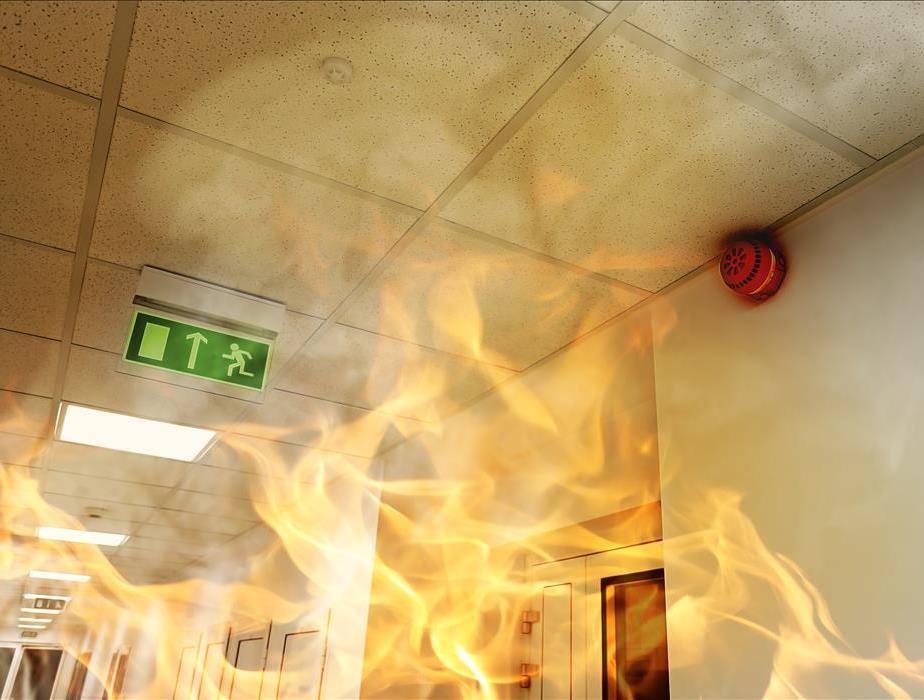 Don't get stuck in a hot situation, have a plan ready when you need it.
Don't get stuck in a hot situation, have a plan ready when you need it.
Making sure fire extinguishers are accessible and smoke alarms are maintained are crucial steps to take as an employer. If a fire does erupt in your workplace, it’s natural for people to panic. Unfortunately, this can lead to common mistakes that aggravate the situation. To ensure everyone makes it out of the building safely during an emergency, here are a few safety guidelines to remind your staff of during fire training.
What Not to Do During a Workplace Fire
- Break Windows
Smoke inhalation is a threat to those inside the building. In an effort to access fresh air, some people might open windows or break the glass. However, when oxygenated air from outside rushes in, the intensity of the fire will build more quickly.
As smoke and heat rise, everyone should stay close to the ground and crawl to the exits to avoid fumes. If exits are blocked, put wet towels under the doors to keep out the smoke instead of opening windows.
- Fail to Use Emergency Exits
fire extinguishers. When a fire starts, people might try to evacuate the building the same way they got in. However, you shouldn’t open any doors leading to the main corridors, especially if the handles are warm to the touch. Flames could be on the other side of these, and opening them could feed more oxygen to the fire and expose people to smoke.
To keep the fire from spreading, instruct your staff to use only emergency exit doors, stairwells, and fire escapes.
- Forget to Alert Others
When they hear the fire alarm protection system, some people may think it’s just a test. If they don’t smell smoke or feel the heat, they might fail to take action.
To protect everyone in the workplace, people who see the flames or smoke should yell “fire” to alert others that it is not a drill. Those trained to use fire extinguishers can try to control the blaze while others call emergency services for help. If anyone in the workplace has mobility difficulties, assign someone to ensure they can get out safely during your safety plan design.
To ensure your staff is prepared for any emergency situation, reach out to SERVPRO of The Saint Croix Valley. We have been helping many commercial customers set up Emergency Ready Plans and have been in the St Croix Valley for over 10 years. Call 715-381-2266 for your free commercial ERP today.
6 Steps to a Professional Kitchen Hood Cleaning
9/25/2019 (Permalink)
Regular cleanings of restaurant kitchen hood vents are an essential part of any fire safety maintenance plan. Without regular attention, oil and other debris can build up in the hood, exhaust fan, filters and ductwork, significantly increasing the chances of a grease fire. Undergoing a hood cleaning twice a year will help you meet the National Fire Protection Agency’s (NFPA) standards for reducing the risk of fire. This process typically takes between three and six hours. To help you prepare for your upcoming appointment, here’s a guide to what to expect during this procedure.
What Happens During a Professional Hood Cleaning?
- Kitchen Prep
Hood cleaning may create a mess, so the cleaning company will begin by prepping the kitchen for the process. This includes turning off pilot lights and gas valves, covering appliances, and removing any items that could potentially get contaminated by the cleaning chemicals and dirty water. The cleaning crew will also remove all filters and disassemble any wall-mounted hoods and fans for cleaning.
- Filter Cleaning
Kitchen exhaust filters often become caked in grease and grime. The hood cleaning process involves removing the filters and soaking them in a cleaning solution to loosen the hardened grease. After several hours, the filters are power-washed and then reinstalled.
- Fan Cleaning
Kitchen exhaust fans are another place where grease builds up. Fire safety maintenance requires the fans to be removed for a thorough cleaning from top to bottom to reduce hidden hazards. The crew will spray the fan with degreasing chemicals and then scrub the blades clean by hand and power washing. Before the fans are reinstalled, the entire system is inspected and the fan belts replaced to ensure it’s in working order.
- Vent & Ductwork Inspection
NFPA guidelines require that all exhaust duct systems be cleaned and degreased regularly, so a thorough hood cleaning includes manually scraping any solidified grease from the vents and ducts before spraying on chemicals to dissolve the remaining grease. After a final scrub, the vents and ductwork are inspected to ensure they comply with NFPA rules.
- Power Washing
Once the fans, vents, and filters are clean, the crew will tackle the kitchen hoods themselves. This begins with manually scraping congealed grease from the hood, and then applying a degreasing cleaning chemical to loosen any remaining residue. After 30 to 60 minutes, the cleaners power-wash the hood with hot water, leaving it clean and free of grease that could start a fire.
- Inspection & Documentation
The final step of the process happens once the crew has restored the kitchen to its prior condition. This is when the process will be documented and your technician will apply a certification sticker to the unit. This tells health inspectors and insurance companies that you are in compliance NFPA guidelines and have worked with licensed fire protection services to ensure the safety of your kitchen.
If your restaurant kitchen hood needs cleaning, call SERVPRO of The Saint Croix Valley at 715-381-2266. Our trained professionals can help many of your professional cleaning and mitigation needs.
Facts About Mold
9/11/2019 (Permalink)
For more than a decade, mold has been in the news. People are talking about the effect on population health and damage to the building. But what are the risks and issues?
The available science on molds and their potential health effects remains under study, but considerable progress has been made. The U.S. Centers for Disease Control and Prevention (CDC), the Institute of Medicine of the U.S. National Academy of Sciences, the World Health Organization and Health Canada all agree that living or working in a building with mold damage results in increased risk of respiratory disease. Although there are several guidance documents available, there are no accepted national or international standards for mold investigation, evaluation or remediation. AIHA, however, has worked to translate the advice from the previously mentioned government agencies into state-of-the-art inspection and sampling protocols, such as AIHA’s Recogni?tion, Evaluation and Control of Indoor Mold? book, also known as the Green Book. If properly used, these methods are suitable for assessing hidden contamination and directing essential visual inspections. For health outcomes, there are no available exposure assessment methods that can provide useful information for individuals. This is primarily due to the fact that each person’s response to mold exposure is unique.
The scientific complexities surrounding this issue would be a huge challenge but the truth is that other, less scientific, difficulties dwarf them. Media attention on this topic often creates emotionally charged circumstances, making scientific and professional judgment, as well as reasoned dialogue on this subject, very difficult. In some instances, building owners have been known to ignore or dismiss potentially serious problems. Many indoor air quality (IAQ) problems have nothing to do with mold, and buildings seldom have only one indoor environmental quality problem. It is essential to consider multiple sources of building IAQ problems instead of focusing on just mold concerns. In other instances, building occupants or public officials armed with mold sampling reports of dubious quality have reacted with alarm to potential threats, making risk communication very difficult.
Public and occupational health practice is rarely an exact science. Prevention always poses the challenge of making tough and often costly decisions with incomplete information or understanding.
The Facts about Mold: For Everyone
What is mold?
The term “mold” is a colloquial term for a group of filamentous fungi that are common on food or wet materials. This includes the green Penicillium species that produces penicillin, and fungi that spoil our bread, fruit, cheese and crops. Most of these are Ascomycetes that produce a lot of spores.
The majority of the molds that grow on damp building materials are found in the soil and are adapted to grow on a wide variety of materials. Outdoors, molds live in the soil, on plants, and on dead or decaying matter. There are thousands of species of mold and they can be any color. Different mold species are adapted to different moisture conditions ranging from very wet to just damp. Many times, mold can be detected by a musty odor. Live spores act like seeds, forming new mold growths (colonies) under the right conditions. All of us are exposed to a variety of fungal spores daily in the air we breathe, both outdoors and indoors.
How mold gets into a house or building
Mold and fungal spores occur naturally outdoors, where fungi are the earth’s most important recyclers. Indoors, mold needs moisture to grow; it becomes a problem only where there is water damage, elevated and prolonged humidity, or dampness. Common sources of excessive indoor moisture that can lead to mold problems include:
- flooding from surface waters (i.e., overflowing rivers) or from severe storms;
- roof leaks from damaged or missing roofing materials, ice dams or blocked gutters;
- storm-driven rain through window frames, exterior walls or door assemblies;
- leaking pipes, sewer back-ups or overflows;
- damp basements or crawl spaces due to a high-water table or poorly managed rainwater drainage; and
- condensation on cold surfaces.
How to prevent mold growth
The key to preventing and stopping indoor mold growth is to control excessive moisture and condensation. Keeping susceptible areas in the home clean and dry is critical. In general, mold will not grow indoors without water, dampness or excessive moisture.
Three main factors contribute to condensation of water on building surfaces:
- Relative Humidity: Condensation occurs when the air is saturated with water and it cannot hold any more moisture. For example, steam generated from bathroom showers or from cooking can fill up the air with moisture, which will then condense into drops of water on cooler surfaces, such as mirrors and windows. Where possible, localized sources of humidity, such as clothes dryers, should be directly vented to the outdoors. To lower indoor humidity during warm, humid weather, air conditioners and/or dehumidifiers should be used. In chronically damp areas such as basements or crawlspaces, it is often recommended that dehumidifiers be used to maintain humidity levels below 60 percent.
- Temperature: Warm air holds more moisture than cold air. Condensation occurs when warm humid air comes into contact with a cold surface and the moisture condenses into water. This can often be seen on single-pane windows, where water condenses and then runs down, causing the wood frames and sills to rot and the wall under the windows to blister. Condensation can occur on exterior walls, particularly north-facing walls, if they are not properly insulated. Other chronically cold surfaces, such as cold-water pipes, should be covered with insulation to help prevent condensation.
- Poor Ventilation: Indoor humidity can build up if there is not enough ventilation and exchange of indoor and outdoor air. Where there is little or no air movement, such as behind dressers and cabinets, surfaces can remain cooler than surrounding areas, which can lead to increased condensation and mold growth. It is recommended that the area be ventilated and the occupants use exhaust fans (vented to the outdoors) to remove moisture from high-humidity areas, particularly in bathrooms, kitchens and laundry areas. Furniture should be moved slightly away from walls so that air can freely pass behind it. Air should be allowed to circulate between rooms and regularly ventilate to remove humid air. Fans should be used as needed.
Other things that can be done are to clean and repair gutters regularly, make sure the ground slopes down and away from the home’s foundation and keep air conditioner drip pans and drain lines clean. In addition, in air-conditioned buildings in hot and humid climates, vinyl wall coverings on the interior sides of exterior walls should not be used, as these materials can trap moisture, resulting in mold growth underneath them.
In the case of floods or leaking pipes, any standing water should be promptly removed and water-damaged materials should either be dried out and cleaned, or removed and replaced. Porous materials that are wet for more than 48 hours are likely to produce mold growth and should be discarded. In instances where the water damage is extensive, it is recommended that professional help, such as a commercial restoration company, be consulted.
If you have had mold growth from these conditions please call us at SERVPRO of the Saint Croix Valley 715-781-2266. Our professionals, combine with industry standard technology and experience can help mediate needs quickly and professionally.
Restore vs. Replace
7/26/2019 (Permalink)
SERVPRO of The Saint Croix Valley specializes in restoring contents damaged by water, fire, or mold. Our expertise and “restore” versus “replace” mentality can help you save money while preserving precious keepsakes that can’t be replaced. We pretest your belongings to determine what items we can restore to pre-fire condition. We use several methods of cleaning your contents, including:
- Dry Cleaning - Used for cleaning light residues or to pre-clean prior to wet cleaning.
- Wet Cleaning - An effective cleaning method for removing moderate to heavy residues.
- Spray and Wipe -Effective for items that can’t withstand wet cleaning.
- Foam Cleaning - Used for upholstery fabrics that might shrink or bleed if wet cleaned.
- Abrasive Cleaning - Involves agitation of the surface being cleaned.
- Immersion Cleaning - Contents are dipped into a bath of the cleaning product.
Move-Outs/Pack-Outs
If your home requires extensive restoration or cleaning due to fire damage, SERVPRO of The Saint Croix Valley can conduct an organized, efficient move-out of the affected area. Move-out will provide several benefits, including:
- A quicker remodeling processes
- Protecting items from potential damage
- Protecting contents from further on-site damage
When restoration is completed, we will work with you to coordinate the move-in according to your needs. The services offered upon move-in may depend on your insurance coverage.
Electronic Cleanup
Fire-damaged electronics can present a serious hazard. Do not attempt to turn on or operate any electrical device that you suspect has been damaged by fire. Smoke residues can contain acids that corrode metal surfaces. If the residues are not removed, corrosion causes electronic failure in the device. We will coordinate the restoration of your electronics, including:
- Television sets
- DVD players
- Computers
- And more
The key to restoring electronics is taking prompt action to prevent further damage. Electronics will be cleaned and inspected by a qualified electronics technician.
Document / Photograph Drying
When your valuable documents, including photographs, are damaged by water or fire, extreme caution should be taken to help ensure the fire damage does not destroy the document. Although some documents may not be restored to pre-fire damage condition, SERVPRO of The Saint Croix Valley can save a great deal and help minimize additional damage.
Depending on the type of documents and the level of fire, smoke, or soot damage, they have five options for the restoration of documents:
- Air Drying
- Dehumidification
- Freezer Drying
- Vacuum Freeze Drying
- Vacuum Thermal Drying
Contents Claim Inventory Service
When a fire emergency strikes, the damage can often feel overwhelming. We can help ease the worry and confusion during the recovery process by offering our Contents Tracker by Xactware, which provides a detailed and accurate list of your belongings. We take a room-by-room inventory of your contents, including digital photos, and in some instances, bar coding.
Our Contents Claim Inventory Service:
- Pre-loss list and value of contents
- Detailed and accurate report
- Better information to settle claims quicker
- Assistance with burden of proof for claims
Peace of mind when you need it most!
Flooding vs. Water Damage
4/3/2019 (Permalink)
Learn the differences, similarities and causes between the two and how to handle water removal and cleanup.
Flooding vs. Water Damage
Whether you’re dealing with water damage or flooding, both can cause big problems and usually require professionals to perform water cleanup. Depending on the size and scope of your situation, your home may require water removal, flood repair or further restoration. While flooding caused by natural disasters or severe weather may be inevitable, there are some preventative measures you can take in and around your house to help slow the flow of water and/or help minimize the damage. The same goes for water damage – if you identify areas around the home that are more prone to water damage than others, you can take action to help prevent or at least decrease the amount and severity of the damage.
Causes and Effects of Flooding and Water Damage
Flooding can happen as a result of both natural and manmade causes, and it can affect the inside and outside areas of your home and property. During a very rainy season, yards can become oversaturated and if there isn’t adequate drainage, or if you have slow-draining soil, flooding is usually inevitable. Preventative measures – such as enhancing your yard’s soil composition and adding plants with deep roots and a high tolerance for water – are a good way to make your yard less susceptible to flooding. These measures can also minimize the amount of flood cleanup if you do experience heavy storms.
Leaky or faulty appliances, burst pipes and water damage that’s not repaired in a timely manner are all non-weather related causes of flooding. Low-lying areas of a home – such as a basement or the foundation – are often more prone to flooding since they are at or below ground level and may experience rising waters from surrounding bodies of water (lakes, rivers, streams) that can overflow during heavy periods of rain. Also, basements oftentimes have multiple pipes running both under the ground and through the ceilings, making them vulnerable to flooding.
Water damage is one of the results of flooding. Even after water removal, the remnants of flooding can appear in the form of discoloration on walls, damaged flooring and mold growth. Common causes include leaky appliances, plumbing issues and heavy periods of rain. Homeowners can help avoid water damage to their homes by having several annual inspections. These include roof inspections (to detect leaks and other areas that may be vulnerable to penetration) and appliance checkups (to make sure they are all running properly and to replace any faulty parts). If left untreated, you will probably end up having to contact professional water cleanup services, like SERVPRO of The Saint Croix Valley, to properly address and repair any damage incurred.
Similarities and Differences
Flooding and water damage are both caused by natural sources such as heavy periods of rain/natural disasters and manmade sources like burst pipes and leaky or faulty appliances.
Depending on the level and severity, both situations will usually require help from professional water cleanup services and/or flood repair.
Flooding is usually an immediate occurrence that can happen in a matter of minutes or even seconds (think: a burst pipe or an overflowing toilet).
Many insurance companies consider water damage and flood damage two different types of claims. While water damage is typically covered under most homeowners insurance, it’s important to carefully read over your policy, as some insurers may only cover certain types of water damage.
How to Deal With Water Removal
If you have flooding or water damage on your hands, you’ll probably need the help of professional water cleanup services like SERVPRO of The Saint Croix Valley. We can handle the initial assessment/inspection, water removal and drying/containment, and help prevent further water damage throughout the entire water cleanup process. If your home or property requires restoration, you may have to contact a contractor to help with water damage/flood repairs in order to completely restore your home back to its original state. You’ll also want to get in touch with your home insurance company to report the damage and see if it’s covered under your policy.
COMMERCIAL FIRE SPRINKLER SYSTEMS MYTHS
4/1/2019 (Permalink)
If a fire breaks out in your business, acting fast to put out the flames could save you from costly damage and loss. That's why commercial fire sprinkler systems are so important.
Although sprinkler systems can protect you, your staff, your customers and your business from harm, myths about fire sprinklers still exist.
MYTH: Water damage caused by fire sprinklers is more costly than fire damage.
FACT: According to the Federal Emergency Management Agency (FEMA), sprinkler systems are actually more cost-effective than damage caused by other firefighting efforts. Since sprinklers can keep a fire contained within one room rather than allowing the flames and smoke to spread throughout the building, most fire damage clean-up will only occur in one space. Furthermore, water damage from fire hoses is typically more expensive to repair. Quick-response sprinklers only release 8 to 24 gallons of water per minute, whereas fire hoses release 50 to 125 gallons per minute.
MYTH: If one fire sprinkler is triggered, all fire sprinklers will go off.
FACT: When one sprinkler in your commercial sprinkler system goes off, only the adjacent sprinklers that sense high levels of heat will activate. According to FEMA, this means that only one or two sprinkler heads will go off in the event of a fire.
MYTH: Sprinklers are overly sensitive.
FACT: Fire sprinklers only ever activate when high heat is detected, so an employee burning their lunch or taking a smoke break too close to the building will not set off the sprinkler system. According to FEMA, only 1 in 16 million sprinkler heads activate accidentally, making their benefits far outweigh any risks.
As a business owner, safety and protection are important to keeping operations going smoothly. To help keep your company safe from any potential fire damage, install commercial sprinklers and place fire extinguishers throughout your facility.
If the unexpected does happen, know that you're not alone. SERVPRO of The Saint Croix Valley is committed to being by your side every step of the way to get your business on its feet as quickly as possible. Use our fire and smoke damage clean-up services and our water damage clean-up services to get your doors back open fast.
HOW TO PREVENT LEAKS IN YOUR COMMERCIAL BUILDING
4/1/2019 (Permalink)
A leak in a commercial building can be costly. Not only could it cause thousands of dollars in damage and repairs, it could also shut down your company until the destruction can be fixed. To help prevent the worst from happening, use these tips to tackle plumbing maintenance in your building and ensure that you can keep business as usual.
Maintenance matters
Regular maintenance can help you prevent leaks that can cost your company a lot of money and headaches. The more proactive you are about maintaining healthy pipes and plumbing, the less likely you'll be to experience a major leak that causes you to close your doors. Follow these maintenance tips to keep your plumbing systems in great shape:
- Inspect pipes regularly. A professional visual inspection of all pipes, faucets, toilet fixtures, and plumbing systems should be conducted at least quarterly. This can prevent plumbing failures before they become a serious issue.
- Upgrade pipes, faucets, and fittings that pose a risk to your commercial property. Updating old plumbing that can't handle high-volume usage can save you money in the long run.
- Pay close attention to your water heater and any filtration systems you have installed. These systems can cause big issues if they aren’t regularly maintained. Commercial water heaters, like residential ones, need regular maintenance to prevent leaks, system failures, and even explosions.
Prepare for emergencies before they happen
Small leaks are often simple to fix. However, if you don’t catch them right away, or more serious leaks are occurring in spots inside your building, an emergency preparedness plan can help you avoid costly damage. While making your own detailed emergency plan, keep these essential steps in mind:
- Identify an action plan. If employees notice a leak anywhere in the building, they should know to whom to communicate the issue, who should be responsible for shutting off water valves, and where important water systems are located throughout the building.
- Create an emergency contact sheet. This list should be easily accessible to all employees within the building. Include contact information for plumbers, building supervisors, other tenants, water mitigation damage services, and other people you may need to reach in case of emergency.
- Protect your data. Business owners should have data backed up to an external hard drive or a cloud-based system to ensure all assets are protected in an emergency.
- Determine off-site work locations. If the building has to close until repairs are complete, you may need to work remotely to keep business running. Employees and customers should be notified of temporary workspaces and working hours.
What to do if you have a plumbing leak
Maintenance and emergency preparation only go so far. When you've got a surprise leak, acting quickly and correctly can help you avoid serious damage to your commercial building. Follow these tips if notice a leak in your building:
- Turn the water off in that area or at the main shutoff valve. This can stop the immediate problem until repairs can be made.
- Block entry to and use of the area. Even slow leaks from faucets or toilet fixtures can become serious issues, especially in high-use areas like commercial buildings.
- Call your plumber to make repairs. Use your emergency contact sheet to notify everyone who needs to be aware of the issue, and try to get the plumber there as soon as possible.
Once the issue is resolved, you may be left with damage. Call a reputable restoration company, like SERVPRO to get your business back on its feet as quickly as possible.
WHAT TO DO IF YOU FIND A LEAK IN YOUR COMMERCIAL BUILDING
2/28/2019 (Permalink)
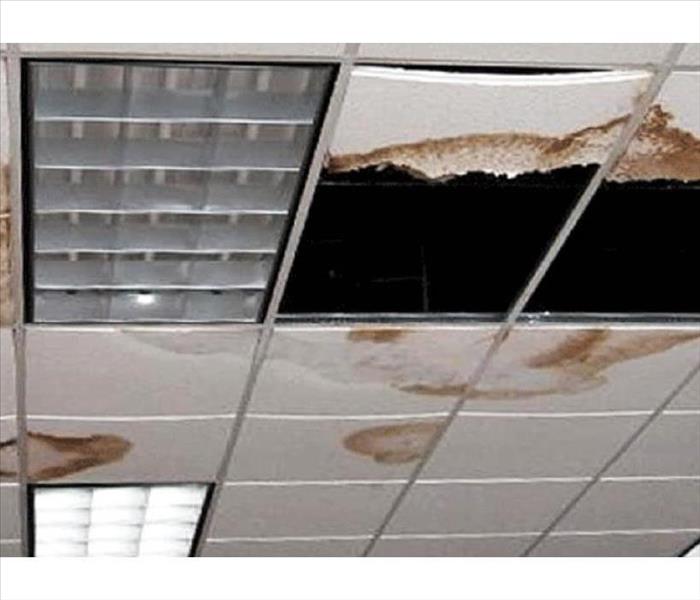 Leaks come in all shapes and sizes. With a little bit of education you can be better prepared for when they do happen.
Leaks come in all shapes and sizes. With a little bit of education you can be better prepared for when they do happen.
It only takes a small leak in a commercial building to cause extensive water damage. The longer the leak goes unnoticed, the more damage you can expect.
Common leaks detected in commercial buildings
Any building can spring a leak. But commercial buildings are put under quite a bit more stress than residential buildings, with heavy use of bathrooms, kitchens and other water-intensive processes. Learn about the most common types of leaks found in commercial buildings, and what you can do to fix them.
Faucet leaks
Every faucet has components that can wear out over time, especially with frequent use. When a seal or other faucet component begins to leak, it leads to ongoing water loss. When the drip becomes a trickle or a flow, water loss can be extensive and your water bill can substantially increase.
Toilet leaks
Toilets have a number of parts that can wear and lead to issues, especially water loss. For example, a flapper that fails to create a solid seal will allow water to leak from the toilet tank drain. If leaks like these aren’t repaired as soon as possible, you may experience additional damage to other toilet components, your water bill may increase significantly, and you may eventually have to replace the entire toilet to remedy the problem.
Underground leaks
Underground leaks often go unnoticed. Signs that you may be experiencing an underground leak include:
- Areas of wet soil
- Areas where grass, plants, or other items are growing faster than their surroundings
- Unexpected rises in water bills
Items like sewer drains, water supply pipes, or other buried piping systems require water leak detection equipment to help locate any leaks. If found, pipes can be dug up and repaired. If not, exploratory digging may be necessary to find the source of the leakage.
Hidden leaks
A leak can hide anywhere in a commercial building. If the leak is not discovered early, the amount of water loss and damage caused may be extensive.
Signs of hidden leaks include:
- Increases in the water bill
- Wet surfaces
- Water marks and swelling of the walls, ceiling, and floors
Once the leak is identified, it may require pulling out walls, ceilings, and other major pieces of the building to fix the leak and repair the damage.
How to detect plumbing leaks in your commercial building
Installing a leak detection system can make it much easier to identify potential leaks and address them as quickly as possible. These systems can be extremely beneficial in commercial buildings, as they allow for the creation of a building-wide detection system.
Technology offers some exciting innovations in leak detection. Wireless water leak detectors can communicate by phone, text, and email when a leak is detected. Cloud-based sensors are also available that integrate with a portal where you can monitor all sensors in a system. There are even automated sensors which can shut off water in certain applications. If you are unsure which type of water leak detection equipment is best for your building, consult a contractor before installation.
What to do if you find a leak
If you suspect a leak in your business, contact SERVPRO of The Saint Croix Valley. We are here to help, 24 hours a day, seven days a week. 715-381-2266.
How Long Does it Take to Repair a Home After a Fire?
1/18/2019 (Permalink)
Dealing with a home fire can be overwhelming. It takes time, money, and oftentimes unexpected factors arise that are almost always out of your control. While each restoration job is unique, it’s important to understand the general process and how long each phase can take.
The Fire Damage Repair Process
PHASE 1: MITIGATION AND DEMOLITION – 3 WEEKS
First, the mitigation vendor will come out to assess the level of damage in the home. The affected rooms will be tested for soot and smoke damage by using special sponges or gloves, and a high-efficiency particulate air (HEPA) vacuum and deodorizer will be used to clean the air. The mitigation vendor will also explain what the demolition and rebuild phase may consist of (if applicable) and determine whether it makes sense to do more complex tasks such as flood cutting, a process that determines the water accumulation in drywall, or tearing down walls and ceilings, and removing floors. These tasks may be necessary when a severe fire occurs as water damage can occur from extinguishing the fire. Lead and asbestos testing may also take place depending on the state the house is in and the year it was built.
PHASE 2: GENERAL CONTRACTOR AND SUBCONTRACTOR
The general contractor often takes on subcontractors to rebuild other parts of the home, such as installing flooring or drywall (or uses an architect for larger losses), so you can get the type of flooring, roofing, etc., you want in your newly restored home.
When all work is complete, you and your contractor will perform a final walk through to review the repairs and you will be asked to sign a Certificate of Satisfaction, which is documentation needed to close out the job.
The Amount of Time Depends on the Amount of Damage
Remember, there’s no one-size-fits-all time estimate for the restoration process. It depends on the size of the house, severity of damage and vendors involved. A small house with light damage could be fixed in a couple of days, whereas a larger job requiring a full gut (or complete rebuild) could take six months or more. It’s always helpful to ask for a scope of the work involved as well as an estimate, so you have a better sense of what to expect for your specific situation.
Here are some other things to consider when a home fire occurs:
- Permits can prevent demolition from happening. For example, you may have to hold off on a rebuild if the building fails lead or asbestos testing.
- Hire a trustworthy mitigation vendor, like SERVPRO of The Saint Croix Valley, with proper credentials and good reviews. If the mitigation is not done well, it can create more work for the general contractor.
- Avoid cleaning prior to speaking with a professional company, as it could cause further damage.
- Collect all sentimental items to handle/clean yourself to avoid potential accidents while professionals are there.
SERVPRO Can Help
If you have experienced fire damage to your home, it’s important to begin the restoration process as soon as possible. SERVPRO of The Saint Croix Valley is a qualified fire restoration company from its nationwide network to help restore your home from beginning to end. WE are just a phone call away, 24 hours a day, 7 days a week, 715-381-2266.
Important Information About Your Water Shut Off
1/2/2019 (Permalink)
 Labeling your water shut-off valve is an excellent way for it to be identified in case of an emergency.
Labeling your water shut-off valve is an excellent way for it to be identified in case of an emergency.
As a homeowner, it's essential to know where the main water shut off valve is located. Water leaks from running toilets, burst pipes, broken water heaters, and even leaky sinks can cause significant damage in a short amount of time. In order to prevent costly damage, turn off the water supply as soon as a leak, flood, or spill occurs.
When Do I Need to Shut Off My Main Water Line?
Typically, you won't have to go directly to the main water line to fix a leak. Instead, your first attempt at stopping your water supply should be straight at the source. Most local supply lines have valves located directly behind or above the fixture and can be turned clockwise to shut off the water supply.
To locate water valves next to specific fixtures in your home, use these tips:
- For sinks, look under the cabinet on the supply lines leading to the faucet. There will likely be two shut-off valves to control both cold and hot water.
- For toilets, look close to the ground behind or beside the toilet, along the flexible metal tubing leading to the tank.
- For washing machines, look either directly above the washer or pull the machine away from the wall and check behind it.
- For water heaters, the water valve should be located just above the heater itself.
If the leaky fixture's valves aren't working or break off, turn off your main water line right away. Acting fast could save you plenty in damages and repair costs.
How Do I Find My Main House Water Shut Off Valve?
The main water line valve to a house is usually located in the basement or in the crawlspace and enclosed behind an access panel. However, there isn't a standard location specified in any home.
If you don't know where to look for your water shut off valve, use these tips:
- The valve will often be located on-grade, so you'll likely find it at floor-level in the basement or near the ground on the first floor.
- Take a look at the property inspection report provided when you purchased your home. This report should note the location of the valve.
Maintaining Your Water Valves
At SERVPRO of The Saint Croix Valley, we know how terrifying it can be to try shutting off your supply lines just to see the valves stick in place – or worse, snap off in your hands. That's why we recommend periodically checking your shut off valves to ensure they're in good working condition.
At least twice a year, test all the valves in your home. Simply turn them completely off and on again to ensure they aren't stuck in place or include faulty parts. That way, if an emergency ever does occur, you can have peace of mind that you'll be able to fix the problem quickly and efficiently.
If the unexpected happens and you aren’t able to shut off your water valves in time, call on the experts at SERVPRO of THE SAINT CROIX VALLEY. Our water damage restoration services can help you get your home back to normal as quickly as possible. With the proper tools and knowledge, we'll work fast and efficiently to prevent additional water damage, cleanup costs, and overall stress.
Space Heater Safety
12/10/2018 (Permalink)
Heating equipment is the second leading cause of home fires in the United States. More than 65,000 home fires are attributed to heating equipment each year. These fires result in hundreds of deaths, thousands of injuries and millions of dollars in property damage.
Portable electric space heaters can be a convenient source of supplemental heat for your home in cold weather. Unfortunately, they can pose significant fire and electric shock hazards if not used properly. Fire and electrical hazards can be caused by space heaters without adequate safety features, space heaters placed near combustibles, or space heaters that are improperly plugged in.
Safety should always be a top consideration when using space heaters. Here are some tips for keeping your home safe and warm when it’s cold outside:
- Make sure your space heater has the label showing that it is listed by a recognized testing laboratory.
- Before using any space heater, read the manufacturer’s instructions and warning labels carefully.
- Inspect heaters for cracked or broken plugs or loose connections before each use. If frayed, worn or damaged, do not use the heater.
- Never leave a space heater unattended. Turn it off when you're leaving a room or going to sleep, and don't let pets or children play too close to a space heater.
- Space heaters are only meant to provide supplemental heat and should never be used to warm bedding, cook food, dry clothing or thaw pipes.
- Install smoke alarms on every floor of your home and outside all sleeping areas and test them once a month.
- Proper placement of space heaters is critical. Heaters must be kept at least three feet away from anything that can burn, including papers, clothing and rugs.
- Locate space heaters out of high traffic areas and doorways where they may pose a tripping hazard.
- Plug space heaters directly into a wall outlet. Do not use an extension cord or power strip, which could overheat and result in a fire. Do not plug any other electrical devices into the same outlet as the heater.
- Place space heaters on level, flat surfaces. Never place heaters on cabinets, tables, furniture, or carpet, which can overheat and start a fire.
- Always unplug and safely store the heater when it is not in use.
Fire Prevention
11/14/2018 (Permalink)
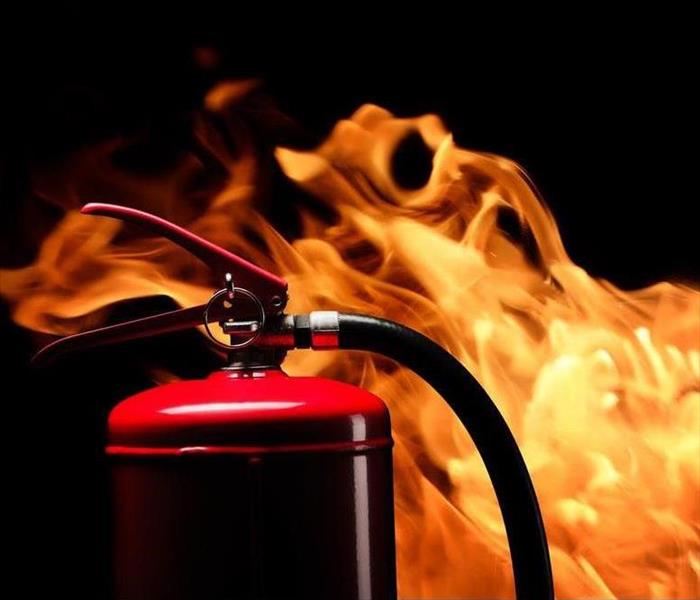 Fire can be a destructive force, but with a little prevention, you can cut down your risks.
Fire can be a destructive force, but with a little prevention, you can cut down your risks.
As we are in to the season of turning on furnaces and starting space heaters, the chance of having a fire increase greatly. In just two minutes, a fire can become life-threatening. In five minutes, a residence can be engulfed in flames. Here are some steps to help if a fire should break out in your home or business.
During a Fire
- Crawl low under any smoke to your exit - heavy smoke and poisonous gases collect first along the ceiling.
- Before opening a door, feel the doorknob and door. If either is hot, or if there is smoke coming around the door, leave the door closed and use your second way out.
- If you open a door, open it slowly. Be ready to shut it quickly if heavy smoke or fire is present.
- If you can’t get to someone needing assistance, leave the home and call 9-1-1 or the fire department. Tell the emergency operator where the person is located.
- If pets are trapped inside your home, tell firefighters right away.
- If you can’t get out, close the door and cover vents and cracks around doors with cloth or tape to keep smoke out. Call 9-1-1 or your fire department. Say where you are and signal for help at the window with a light-colored cloth or a flashlight.
- If your clothes catch fire, stop, drop, and roll – stop immediately, drop to the ground, and cover your face with your hands. Roll over and over or back and forth until the fire is out. If you or someone else cannot stop, drop, and roll, smother the flames with a blanket or towel. Use cool water to treat the burn immediately for 3 to 5 minutes. Cover with a clean, dry cloth. Get medical help right away by calling 9-1-1 or the fire department.
Fire Escape Planning for Older Adults and People with Access or Functional Needs
- Live near an exit. You'll be safest on the ground floor if you live in an apartment building. If you live in a multi-story home, arrange to sleep on the ground floor, and near an exit.
- If you use a walker or wheelchair, check all exits to be sure you get through the doorways.
- Make any necessary accommodations, such as providing exit ramps and widening doorways, to facilitate an emergency escape.
- Speak to your family members, building manager, or neighbors about your fire safety plan and practice it with them.
- Contact your local fire department's non-emergency line and explain your special needs. Ask emergency providers to keep your special needs information on file.
- Keep a phone near your bed and be ready to call 911 or your local emergency number if a fire occurs.
After a Fire
The following checklist serves as a quick reference and guide for you to follow after a fire strikes.
- Contact your local disaster relief service, such as The Red Cross, if you need temporary housing, food and medicines.
- If you are insured, contact your insurance company for detailed instructions on protecting the property, conducting inventory and contacting fire damage restoration companies. If you are not insured, try contacting private organizations for aid and assistance.
- Check with the fire department to make sure your residence is safe to enter. Be watchful of any structural damage caused by the fire.
- The fire department should see that utilities are either safe to use or are disconnected before they leave the site. DO NOT attempt to reconnect utilities yourself.
- Conduct an inventory of damaged property and items. Do not throw away any damaged goods until after an inventory is made.
- Try to locate valuable documents and records. Refer to information on contacts and the replacement process inside this brochure.
- Begin saving receipts for any money you spend related to fire loss. The receipts may be needed later by the insurance company and for verifying losses claimed on income tax.
- Notify your mortgage company of the fire.
At SERVPRO of The Saint Croix Valley we have the ability to help start the recovery process of your property, your home, and your life after fire affects you. In the unfortunate event that you have a fire, please call us and let us show you how we can help you. 715-381-672.
OH THE DAMAGE A DISHWASHER CAN DO!
10/2/2018 (Permalink)
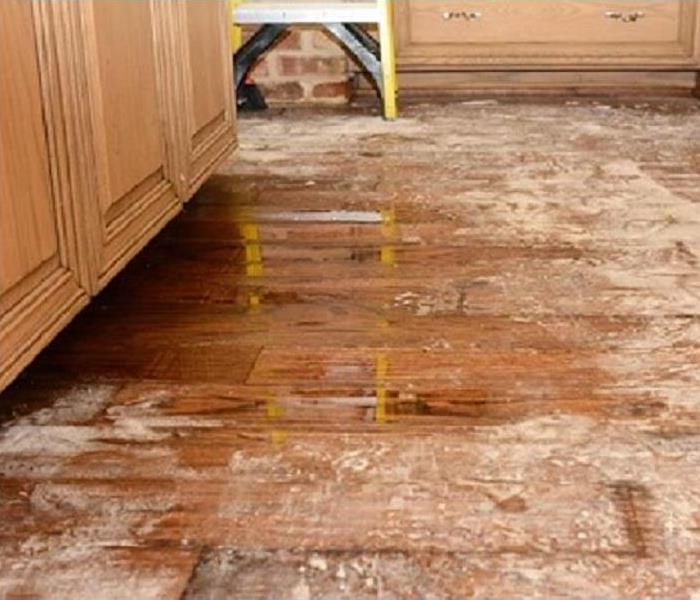 This isn't ever a pleasant sight to find but, with a little knowledge this won't have to put you through the "rinse cycle!"
This isn't ever a pleasant sight to find but, with a little knowledge this won't have to put you through the "rinse cycle!"
Dishwashers are great, but also encompass great water damage potential. Imagine a dishwasher breaking down while working, all full of water. The amount of water flowing would be overwhelming, especially since in most cases the water keeps flowing as the dishwasher doesn't stop the water flow.
While in most cases a dishwasher failing causes only a small water flood, in more complex cases the damage goes far beyond just blotting the water. In some cases, that dishwasher will really be disruptive to your daily routine.
THE WORST CASE SCENARIO OF DISHWASHER WATER DAMAGE
You're getting ready for work. You put all the dishes in the dishwasher, hit the start button, pick up your keys from the counter, and you and the kids are out the door off to another regular day. Or at least the beginning of a regular day. With the workday behind you, you go home to get the house prepared for another afternoon of fun & kids. You open the door, walk to the kitchen, and see a big puddle of water next to the dishwasher. Uh oh. Bad sign #1.
You check the dishwasher, and see it's off now. The water isn't running anymore. But the water traveled around the kitchen. And all the way to the basement stairs. You walk over, only to see the water spilled down the stairs. How long has the water been standing there? And how are you going to handle the water now?
Steps of Water Damage Restoration
If you have water damage, either from a dishwasher or other water sources (leaky pipes, for example) the remediation process is quite similar - stop the water flow, call the experts, get the water out, dry the area and fix the damage.
The sooner you find out about the water leaks, the easier it is to restore your property and clean up the mess. If your dishwasher just broke, and you closed the water immediately, you may not have even suffered from minor water damage yet. But if your water heater broke sometime last night, and you only just found out - your water heater just caused a lot of water damage. Same goes for the case mentioned above - as one of our customers found out.
Dishwasher Breakage Taking Down the House. Almost.
The dishwasher leaked all the way to the basement. The basement ceiling got wet, the kitchen floor got soaked, and the basement's carpets got drenched as well. Getting the water out was not a simple task, but we got it done. We used professional water extraction machines to get all the excess water out of the kitchen and basement. After we got rid of the water, we started the drying process - removing all items that could not be restored to preloss condition and drying them, placing air movers and dehumidifiers to dry the floors and ceiling and eventually fixing the parts of the drywall that got removed as well.
It wasn't a simple job, but we had it done in 10 days. It was more than we thought it would take, but the water from that dishwasher went as far as it could and caused big damage. Never underestimate the power of water, especially when it comes to water damage and your home.
Top 3 Facts About Water Damage Restoration for The Saint Croix Valley
8/20/2018 (Permalink)
Fact #1: The First 24 to 48 Hours Are Critical
If your home is flooded, the first 24 to 48 hours are critical because this is all the time mold and other microorganisms needs to begin growing and thriving.
Five conditions are required by fungi and bacteria to germinate, grow, amplify, and disseminate:
- Organic food source, especially cellulose (e.g., paper, wood), which are found in abundance in construction materials.
- Moisture, even high humidity (60% RH plus)
- Moderate temperature – 68-86°F/20-30°C
- Stagnant air
- Time – several hours to several days.
Water damage restoration has two main goals. First, to restore the home to preloss condition. Second, to prevent the onset of mold and other microorganisms.
In order to accomplish these goals, you need to take action immediately. These are the action steps.
- Contact a restoration contractor immediately to begin the removal of excess water. Once the excess water is removed, the restoration contractor can deploy drying equipment, dehumidifiers, and air movers, which will be effective at preventing mold growth.
- Contact your insurance company to begin the claims process.
Fact #2: Mold Growth Is Not the Only Concern
The other reason time is not on your side relates to the bio-hazard level of the water. There are three hazard levels.
Category 1 Water, also known as clean water, is not considered hazardous because it originated directly from a sanitary source such as a broker water supply line, melting ice or snow, rain water, and/or uncontaminated tub or sink water.
Category 2 Water, also known as gray water, is a health concern because the water originated from a contaminated source such as discharge from dishwashers or washing machines, toilet bowl overflows (urine, no feces), seepage due to hydrostatic pressure, and sump pump failures. Gray water has bacteria present that carry nutrients for microorganisms that cause sickness and discomfort when consumed.
Category 3 Water, also known as black water, is the worst level of water contamination because the water originated from sewage, rising flood water from rivers and streams, and ground surface water flowing horizontally into the home. Black water can cause death and sickness because it can be contaminated with E. coli; Acanthamoeba; Salmonella; Helicobacter pylori; Leptospira; Cryptosporidium; Giardia; Hepatitis A Virus; Clostridium Tetani; and Adenoviridae. Illnesses caused by black water include gastroenteritis; Weil’s disease also known as Leptospirosis; Hepatitis; acute respiratory illnesses; and tetanus.
The problem with standing flood water is that the risk of bio-hazard increases as time passes. In short, after two to three days, clean water can turn to gray water, and eventually black water as bacteria and pathogens begin to grow and proliferate.
Fact #3: Water Damage Restoration Should Be Done By Professionals
The immediate inclination of most property home owners is to begin the clean-up process themselves and if you do, please take precautions because micro-organisms enter the body through direct contact or by breathing in contaminants. For this reason, always wear protective clothing, rubber boots, gloves, eye, and respiratory protection.
In order to avoid long term health, structural, and mold concerns, we recommend the services of a professional restoration company that has the experience and training to restore your home to preloss condition.
Well trained professionals understand that not all water damage restoration projects are the same. When they are formulating their action plan also known as a scope of work, they will assess the hazard level of the water, but will also determine the extent of water damage to create a sensible plan of action.
There are four distinct classes of water damage:
- Class 1 Water Damage: The lowest and easiest to deal with, this has a slow evaporation rate. Only part of a room or area was affected, there is little or no wet carpet, and the moisture has only affected materials with a low permeance rate, such as plywood or concrete.
- Class 2 Water Damage: With a fast evaporation rate, this level affects an entire room, carpeting, or cushioning, the wetness has wicked up the walls at least 12”, and there is moisture remaining in structural materials.
- Class 3 Water Damage: This class has the fastest evaporation rate, and ceilings, walls, insulation, carpet and sub-floors are all saturated. The liquid may have come from overhead.
- Class 4 Water Damage: This class is labeled as a specialty drying situations, which means there has been enough liquid and time to saturate materials with very low permeance, such as hardwood, brick, or stone.
Other reasons you should hire a professional include the following:
- Trained professionals have specialized equipment to pump out excess water, commercial grade dehumidifiers and air movers.
- Experienced professionals have the knowledge to properly determine the class of water damage and category of water to put together a scope of work (ie. plan of action).
- Ability to assess structural issues caused by the water damage, which could have long term safety and property value consequences if not fixed properly.
- Advise you on what contents can be cleaned and what needs to be thrown out.
- Create a drying and monitoring strategy using air movers and dehumidifiers.
- Create a sanitizing plan to ensure a healthy living environment.
As a final note, in addition to using the services of a professional restoration company, we also recommend that you hire a third party environmental firm to perform post-remediation verification tests on the air quality to assess the mold spore count and sewage contamination tests if the flood water had category 3 water. These tests should be performed before any reconstruction occurs because it will provide you with verification that the water damage restoration was done properly. There is a cost to post-remediation verification, but it is well worth the investment for peace of mind that the work was done properly. Long term, this final step could save you thousands of dollars and future headaches because if any moisture or bacteria is present after the rebuild is complete, much of the reconstruction will eventually need to be torn down, particularly if there is mold.
Questions? We are here to help. Call us, 715-381-2266
What Is Water Mitigation In The Saint Croix Valley?
7/31/2018 (Permalink)
The simple answer is that, it is the prevention of further water damage by taking strict actions. Actions such as removal of unsalvageable contents and structures (dry wall, flooring, etc.), cleaning of the affected areas, application of disinfecting agents, deodorizing and drying the structure.
The actual water mitigation time of your property and valuables will be determined by the amount of the water damage endured. Our advanced equipment such as drying equipment and the use of testing equipment will ensure your property is being dried out. They will be removed only when the temperature, humidity and moisture testing confirm that the affected areas have been dried to approved standards. With that said, the equipment can be considered noisy and somewhat intrusive but, when you consider that every minute that the equipment is running is one more minute that you are closer to having the entire situation rectified, you will understand that it is a necessary process. Also, the timing of the process can be measured in 24 hour increments for insurance standards, not in minutes.
For the property that has been affected by mold spores it needs to be thoroughly cleaned, and any moisture must be removed completely from that area. This makes sure that the mold will not continue to grow further or return to the area to grow again.
WATER DAMAGE CAUSES AT HOME AND HOW TO DEAL WITH THEM
We all know we're surrounded by water. The ocean, lakes, rivers, ponds, and other natural water reserves. But we are also surrounded by human-made waterways - sewers, water mains and pipes, and gutters also fill up with water when it rains. All this water is great, but can also cause a lot of damage.
TYPES OF WATER DAMAGE CAUSES AT HOME
There are several types of water damage at home. Some can be prevented with simple maintenance, and some of them are just forces of nature doing their thing. Here are some of the water damages we helped people deal with over the years:
- Pipes leaks / bursts (or toilets) - Common reason for water damage at home. Pipes are usually hidden. Either in the floors, walls or just running on the outer walls of your home, they're far out of sight. If they start leaking it may take a few days (or even weeks) before you notice anything is wrong. These leaks create more damage as time goes by, so if you have any suspicion you've got a leaky pipe - call a plumber or water damage experts and have it checked.
- Broken appliances at home - some of our appliances are connected to water mains, use water, and when they break down - we are the ones who suffer. The usual suspects are dishwashers & washing machines, but refrigerators, freezers and aquariums can also be counted here. These causes usually cause less damage than pipe leaks, since they are usually visible almost instantly as they happen, and are not hidden in the walls. The most important thing to do when suffering such water damage is to extract the water as quickly as possible, before it gets absorbed in carpets or floors, and before the water damage becomes a health hazard and a mold growth bed which will be a lot harder (and way more expensive) to repair.
- Sump pump failure and toilet clogs - These are less common, but they do happen. When your sump pump fails in your basement, it creates an overflow of the toilets or sump basin in your basement, which is also harder to get rid of without professional equipment and water damage professionals.
- Sewage backup, or rising water from other water sources (seawater, lakes, rivers) - These reasons for water damage are in "Class 3" water damage, meaning the water contains lots of contaminants and unsanitary agents, causing a serious health hazard. These causes are usually accompanied by bad odors, and can cause discomfort and even sickness.
- Floods - these are really rare in most areas, and more common in some areas. Floods are considered as substantially large amounts of water reaching places they don't usually reach, such as places which are usually dry land like town centers, bridges and of course - your home. Floods are the hardest to deal with when it comes to water damage, because floods create a lot more damage to homes, and affect also access roads and facilities. Moreover, floods usually affect more than one home, and can flow over a whole town and even a city.
WATER DAMAGE AT HOME
Imagine you're at home. Sitting on your sofa, enjoying a good movie on the TV, having some popcorn, when you suddenly look up and see a discoloration on the ceiling. Nothing much, just some bubbles in the paint and a brownish stain of what looks like humidity. Nothing to really worry about, but where is it coming from?
You head up to the attic, only to realize your roof just gave in a little, and water is dripping in from your skylight. A drop every few seconds on days of constant rain can accumulate to large amounts of water that really have nowhere to go. So they get absorbed in your carpet or hardwood floors. And that's a problem. A big problem.
If you suffered from any type of water damage, it's important to remember 3 things:
- Get your belongings far from water ASAP - the longer they are in water, the less chances you have of saving them.
- Get the water extracted - water standing in your home is a bad idea for so many reasons. Get water extraction services and dry your property.
- Make sure the water didn't go any deeper - have water damage experts visit your property, inspect it thoroughly and verify there is no hidden water or wetness that can evolve into something worse.
For many this can be one of the most frustration times of their lives. If nothing else know that there are people out there, like SERVPRO of The Saint Croix Valley, trained in getting you the help that you need to tackle these problems, backed with years of experience.
Why Hiring a Water Damage Restoration Company is the Best Option
7/16/2018 (Permalink)
Although it’s tempting to fix water damage yourself, it’s not a wise choice. Here’s Why:
Safety & Health
If a massive flood flows through your home, two things happen. First, the structural integrity of your home is instantly compromised. Second, the water is filled with harmful bacteria, chemicals, and other toxic material that can affect your health or cause injury. If the water is still standing after several hours or days, there’s no way of knowing what’s in it. Water removal specialists have the skill and equipment necessary to remove the water safely without injury or exposure to whatever is in the water. There’s no need to put yourself or anyone else at risk when you can seek the aid of experienced water removal professionals.
Fast, Efficient Work
Water removal is a time-sensitive task that must be executed without delay. The condition of your home grows progressively worse in a short period once the flood strikes. The water must be removed before it permanently damages the internal structure. Plumbing and electrical systems must be inspected. The wood frame and flooring have to be treated, and everything must be dried fast.
This requires the experience of a certified, reputable water removal company that can complete the job in a fraction of the time it takes for a homeowner to do it. A response team can arrive on-site with all the tools and equipment necessary to go to work right away. They know the proper procedure for extracting the water and restoring the home. An entire team can complete the project within hours to save the property from further damage.
The Right Tools
While shop vacs, bathroom towels, Clorox, and open windows may seem like an effective method for flood cleanup, they neither treat the wood below the surface nor create an arid room that allows moisture to evaporate. In the end, the homeowner wastes time and energy only to get less than satisfactory results.
All equipment and tools used to remove water are specially designed to meet or exceed the highest industry standards when restoring a home after a flood. This includes the time it takes to complete the project. For example, air-moving machines can push 100 cubic feet of air around you home in just 60 seconds. By circulating the air, the machine speeds up evaporation time. An industrial grade dehumidifier does the same thing with water. It can extract 50+ gallons of water out of any building. Large-scale equipment likes the above mentioned can do the work of 10 people but at a faster rate.
Manpower
While this may not seem like a compelling reason to hire a professional water removal company, the alternative is, well, doing it yourself. Nothing is more encouraging, however than seeing an entire staff piling out of work vehicles for the purpose of saving your home. By working in teams, water removal companies have the capacity to take on the most challenging jobs and finish them in record time. If the 48-hour window presents a monumental challenge for a solo cleanup effort, additional help is the way to go if you want your house to survive that initial period before the onslaught mold, spores, and fungi take over your home.
Don’t Let Water & Storm Damage Sink Your Finances
7/9/2018 (Permalink)
Featured Article from IICRC Archives (www.IICRC.org)
In a Nutshell: Water damage can strike unexpectedly, causing costly damage to homes and businesses. Many people don’t face water damage in time, nor do they use proper equipment to get rid of the water or the subsequent mold that develops. The best course of action to ensure your family avoids health problems following water damage to your home is turning to an IICRC-certified professional. The Institute of Inspection, Cleaning, and Restoration Certification (IICRC) sets global standards and provides 27 certifications for people in the cleaning and restoration business. With a presence in more than 25 countries, the IICRC also provides consumers with educational resources on restoration — so they can repair water-related damage themselves — without breaking the bank, but also doing it the safest way possible.
Water damage from flooding and storms can wreak havoc on a family’s home and finances. The average cost of water removal alone is $2,700. Cleanup and restoration add thousands more to the bill, and a foot of flood damage repair can cost nearly $20,000. While the average water damage insurance claim is $7,500, uninsured people are looking at more staggering out-of-pocket costs.
So, people try to cut corners. One of the first mistakes they make is not facing the scope of the problem. When they procrastinate, the water damage can actually worsen, penetrating building materials, and ultimately also driving up the cost of restoration. When people do seek help, they don’t look for certified experts.
Instead, people should reach out to and rely on certified experts right away. The IICRC is an organization dedicated to setting industry standards — and training experts — in inspection, cleaning, and restoration of damaged properties. Its Clean Trust logo has become a symbol of confidence between certified technicians and customers.
For over 45 years, the organization has been helping people to train and certify experts to do the hands-on hard work that goes into cleaning up the mess left by water damage.
Jeff Bishop, a Director of IICRC, is a second-generation restoration expert. He sums up the genesis of the problem that the nonprofit IICRC helps resolve. “It happens frequently when there is wholesale flooding … people have hardly anywhere to turn but to rely on themselves, which can jeopardize the health and safety of their families,” Jeff said.
Although there are a few other organizations similar to IICRC, such as the Restoration Industry Association (RIA), IICRC sets the standard for the training and certification of experts.
“In the industry, there is no specific regulation that governs how restoration can be performed except ANSI/IICRC S500,” also known as the Standard and Reference Guide for Professional Water Damage Restoration, Jeff said.
Cleaning Air Ducts In The Saint Croix Valley.
6/18/2018 (Permalink)
In addition to normal accumulations of dust and dirt found in all homes with air ducts, there are several other factors that can increase the need for regular HVAC system cleaning:
- pets
- occupants with allergies or asthma
- cigarette or cigar smoke
- water contamination or damage to the home or HVAC system
- home renovation or remodeling projects
Some occupants are more sensitive to these contaminants than others. Allergy and asthma sufferers, as well as young children and the elderly tend to be more susceptible to the types of poor indoor air quality that air duct cleaning can help address.
The rule of thumb for consumers is that “if your air ducts look dirty, they probably are,” and that dirty HVAC systems should be inspected by a reputable, certified HVAC professional. Below are some other reasons homeowners choose to have their air ducts cleaned.
Indoor air quality is one concern that homeowners have when they decide to investigate air duct cleaning. Your heating and cooling system is the lungs of your home. The system takes air in and breathes air out.
Through normal occupation in a home, we generate a great deal of contaminants and air pollutants, such as dander, dust, and chemicals. These contaminants are pulled into the HVAC system and re-circulated 5 to 7 times per day, on average. Over time, this re-circulation causes a build-up of contaminants in the duct work.
While dirty ducts don’t necessarily mean unhealthy air in your home, school or workplace, they may be contributing to larger health issues or harboring contaminants that could cause serious problems for people with respiratory health conditions, autoimmune disorders or some environmental allergies.
According to the U.S. Department of Energy, 25 to 40 percent of the energy used for heating or cooling a home is wasted. Contaminants in the heating and cooling system cause it to work harder and shorten the life of your system. Although filters are used, the heating and cooling system still gets dirty through normal use.
When an HVAC system is clean, it doesn’t have to work as hard to maintain the temperature you desire. As a result, less energy is used, leading to improved cost-effectiveness.
Cigarette Smoke Cleaning
6/5/2018 (Permalink)
While not as many people smoke now days we get this call from time to time. After years of smoking in a home, walls and contents become blemished and develop bad odors. And when the time comes to remove the smoke residue and odors, it will be very difficult to successfully complete the task. Professional cleanup is often necessary. This can be one of the toughest jobs a we come across. Learn more about smoke removal below.
"How does smoke affect properties?"
Tobacco smoke is a complex mixture of over 4,000 compounds. Smoke sticks to every surface of the smoking area, such as walls, windows, furniture, and in every nook and cranny. It leaves a yellowish-brown sticky substance that you can see, smell, and feel. Cigarette smoke residue can permanently alter the appearance of every surface it sticks to. What’s worse, the HVAC system in the building will carry the smoke residue and odor throughout the structure. This residue is extremely hard to remove, much harder than the soot left over from a fire.
"How do you remove tobacco smoke from homes?"
As tobacco residue is present throughout the entire affected area, removing it is often very time- consuming. There is no magic formula that just whisks away residues and smells. The only effective way to remove tobacco residue and smell is through very thorough cleaning and then sealing all structural surfaces. Restoration specialists start tobacco smoke removal by cleaning all surfaces, which always includes deodorizing agents to help eliminate the very tiny particles of tobacco smoke. The residue is also filled with nicotine which during the cleaning process can be absorbed through the skin and give a person nicotine poisoning. Proper Personal Protective Equipment (PPE) is a must!
Once the technicians finish cleaning the visible surfaces, using specialized equipment is often necessary to remove the very last of the odors that are not accessible (such as inside walls or joints). This will often involve Chlorine dioxide gas or ozone generators – professional equipment that effectively destroys the smelly particles that penetrated hard-to-reach areas.
The next step consists of sealing the surfaces with a sealant. A product designed to seal smoke residues is required – these can lock in the very last of the stains and odors. Finally, the surfaces will be ready to paint, refinish, or to apply new coverings.
"What about the soft items?"
The soft things in a home such as upholstery, bedding, draperies, and clothes absorb odors so well and are often easily damaged. Because of this, they are very difficult to successfully restore and may require outside specialists. In many cases though, the decision is made to simply replace these materials and items.
If you find yourself dealing with a cigarette smoke odor we’d love to help, call us at 715-381-2266
Don't Let Water And Storm Damage Sink Your Finances
5/30/2018 (Permalink)
Featured Article from IICRC Archives (www.IICRC.org)
In a Nutshell: Water damage can strike unexpectedly, causing costly damage to homes and businesses. Many people don’t face water damage in time, nor do they use proper equipment to get rid of the water or the subsequent mold that develops. The best course of action to ensure your family avoids health problems following water damage to your home is turning to an IICRC-certified professional. The Institute of Inspection, Cleaning, and Restoration Certification (IICRC) sets global standards and provides 27 certifications for people in the cleaning and restoration business. With a presence in more than 25 countries, the IICRC also provides consumers with educational resources on restoration — so they can repair water-related damage themselves — without breaking the bank, but also doing it the safest way possible.
Water damage from flooding and storms can wreak havoc on a family’s home and finances. The average cost of water removal alone is $2,700. Cleanup and restoration add thousands more to the bill, and a foot of flood damage repair can cost nearly $20,000. While the average water damage insurance claim is $7,500, uninsured people are looking at more staggering out-of-pocket costs.
So, people try to cut corners. One of the first mistakes they make is not facing the scope of the problem. When they procrastinate, the water damage can actually worsen, penetrating building materials, and ultimately also driving up the cost of restoration. When people do seek help, they don’t look for certified experts.
Instead, people should reach out to and rely on certified experts right away. The IICRC is an organization dedicated to setting industry standards — and training experts — in inspection, cleaning, and restoration of damaged properties. Its Clean Trust logo has become a symbol of confidence between certified technicians and customers.
For over 45 years, the organization has been helping people to train and certify experts to do the hands-on hard work that goes into cleaning up the mess left by water damage.
Jeff Bishop, a Director of IICRC, is a second-generation restoration expert. He sums up the genesis of the problem that the nonprofit IICRC helps resolve. “It happens frequently when there is wholesale flooding … people have hardly anywhere to turn but to rely on themselves, which can jeopardize the health and safety of their families,” Jeff said.
Although there are a few other organizations similar to IICRC, such as the Restoration Industry Association (RIA), IICRC sets the standard for the training and certification of experts.
“In the industry, there is no specific regulation that governs how restoration can be performed except ANSI/IICRC S500,” also known as the Standard and Reference Guide for Professional Water Damage Restoration, Jeff said.
Duct Cleaning in The Saint Croix Valley
5/30/2018 (Permalink)
Indoor air quality has become a huge topic in recent years. As a result, we’re seeing more and more services and products tuned to improving the overall quality of the air we breathe in our homes and businesses—from air filters, to HVAC filtration improvements, and even to the service of duct cleaning itself. We get asked about the importance of our service pretty often. Is duct cleaning necessary? Is it worth it? As to whether or not the service is worth it, we can give a resounding yes! But is it necessary? That answer can depend on a number of variables, which we’re going to talk about today!
Should I Invest In Duct Cleaning?
Organizations like the NADCA (National Air Duct Cleaners Association) have put tons of study into the importance of duct cleaning in recent years. Duct cleaning often can have a noticeable impact on the cleanliness of your home or business, and in many situations can reduce many of the airborne risks in your structure.
It’s the question of when you need it most that is important. Due to the nature of air filtration and the habit of home and business owners to keep spaces relatively clean, duct cleaning isn’t needed super often. It’s not, say, a monthly service or anything. But having the service performed every few years by trained specialists that carry the tools and experience needed to do the job right can be a huge boon!
When Do I Need Professional Duct Cleaning?
Aside from time, there are some situations where duct cleaning might become necessary, or have demonstrable benefits to your structure. These situations include:
Routine cleaning. It’s a good idea to have your system handled by pros every three to five years, depending on the traffic of your structure, its size, and the overall cleanliness of the occupants. This ensures you don’t end up with a buildup of pollen, dust, and mold spore that can begin to pile up and reduce air quality and HVAC efficiency. Routine care also helps keep your space cleaner overall, reducing the necessity of other cleaning activities and services.
Risks of mold. Hands down one of the biggest benefits of duct cleaning is eradicating a major risk of mold. Mold takes root in ductwork fairly commonly. And because ducts tend to be dark, moist, and fairly spacious, mold spores can become a serious threat to your home. If you suspect a presence of mold in your home, duct cleaning is an excellent service to pursue.
Vermin and infestations. Many common pests like mice, rats, other vermin, and insects can make a pretty prosperous home out of your ductwork. If you notice signs of these (droppings, odd sounds, a presence of insects, etc.), duct cleaning by professionals can solve your problem very effectively.
Construction and renovation. Home additions, remodeling, and construction can all generate huge amounts of dust and small particles that can get jammed in your ductwork. This can result in poor air quality and lower HVAC efficiency. Duct cleaning is a great service to follow up with after construction!
If you would like to set up an appointment to have your ducts cleaned, call SERVPRO of The Saint Croix Valley – 715-381-2266
Carpets and Pets
5/30/2018 (Permalink)
When you own pets and have carpet in your home, it can be difficult to keep the carpet looking clean all of the time. Cats are generally cleaner than dogs since most cats are indoor animals. They do still shed and spread pet dander, so vacuuming twice per week is suggested. It is also ideal to have a carpet with a medium tone and that has a few colors woven in to help hide some pet dirt from showing. Regardless of which pet you have, it's never easy getting the pet smell out of your carpet. Let's explore a few tips that just might help.
Purchase Stain Resistant Carpet
If you are able, stain-resistant carpet is always the way to go. Consider this option if you are replacing the carpeting or wish to carpet a wood or tile floor. This type of carpet is often more costly but also lasts for an extended period of time. Stain-resistant carpet already has a protective layer applied to the fibers. There is no need for scotch guarding practices as it can withstand being steam-cleaned, vacuumed and spills without losing too much of its integrity.
Scotch Guard Non-Stain Resistant Options
If you have carpet that is a few years old it is best to scotch-guard the carpets. This will put a protective guard on the carpet. It will need to be repeated after a period of time to help the fibers maintain their structure and help protect additional stains from being possible. You should have this done professionally to ensure that every fiber is treated. Missing a spot by doing it yourself can cause stains to get under fibers that are treated. This can cause stains that do get past the scotch guarding to be harder to get out.
How to Care for Your Carpet if You Have Pets at Home
Cleaning Pet Urine
Pet urine is one of the toughest things to battle when it comes to carpet care. In order to get accidental urine spots out of the carpet, you need to catch it rather quickly. Get several paper towels first and step on them, a few at a time, with shoes on. This will help you to pull up the urine without spreading it. Continue to do this until the paper towels come up nearly dry. Make a mixture of 1-teaspoon of ammonia and 1-cup of water. Spray this on the area and let it sit for 5-minutes. Use a stiff brush and make small circular motions from the inside of the spot outward. Use a wet/dry vacuum to pull up the rest of the area. This should prevent the urine from staining and should pull all of it up from the carpet.
Keep your Pet’s Nails Trimmed
The length of your pet’s nails can cause damage to a carpet. When a pet gets excited and runs around or scoots across the carpet, it can snag the strands of material. This can cause an unraveling effect that would eventually leave spots that are bare, disheveled looking or less fluffy than the rest of the carpet. When trimming your pet’s nails it is also ideal to use a pet nail file on them. This removes the rigidity left to make the nails feel smooth again. This also helps to protect carpet and hardwood floors as well.
Use a Hardwood or Tile Entrance
After taking the dog for a walk when it has been raining or snowing, a hardwood or tile floor entrance with a rug that they can walk over first is ideal. This prevents wet and muddy feet from making prints on the floor and prevents the mud from getting on the carpet. Some dogs will play in mud or splash a little due to their size. Keep a towel handy, next to the entry door, to wipe them off. Some types of mud can be more difficult to remove from carpet than others.
Vacuum Twice Per Week
Even if your pet does not shed a lot, dander is still created. This can cause a carpet to get weighed down and have a pet odor to it. To prevent this from being an issue, you should vacuum twice per week. One of these times you should move furniture and thoroughly vacuum. Pet dander and hair can travel, causing it to get on carpet that is underneath furniture. If the pet eats on the carpet or plays with toys on carpeted areas, it is also ideal to vacuum their play areas. Drool and particles from toys can get into the carpet as well. Pet saliva can leave an unpleasant odor over time.
If you’ve got problem stains from pets that are too big for you to handle call the professionals at SERVPRO of The Saint Croix Valley at 715-381-2266.
Sump Pumps In The Saint Croix Valley
5/30/2018 (Permalink)
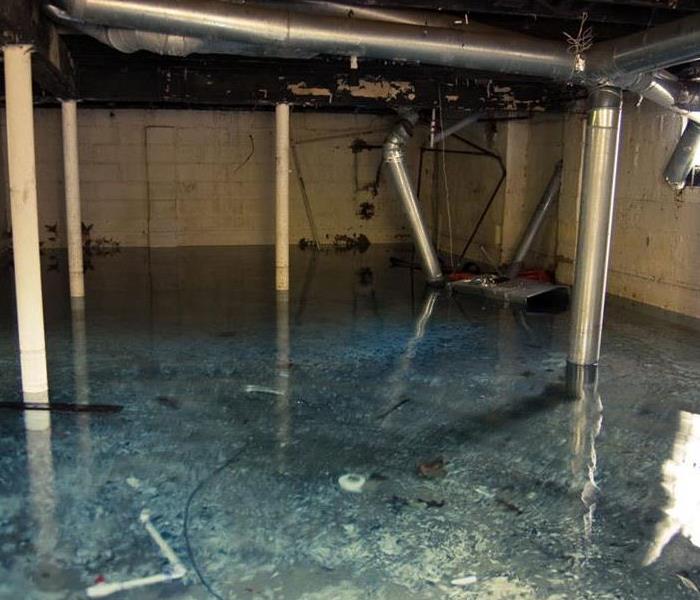
Since we live in an area where homes typically have basements, it’s smart to have a sump pump in the lower spots in the basement. Most homeowners understand the benefits of having such a system in their basement, and that’s definitely the case when they’ve invested a lot of money refinishing their basement to turn it into livable space their family can enjoy. If you’re going to spend that much money on your home, it’s only smart to protect that investment by installing a relatively inexpensive (at least as it compares to the cost of a typical basement finishing project) water mitigation system. Some homes we’ve seen have the crock for the pump but no pump installed. Only when the basement flooded did the home owner become of aware of it. It is wise to check your home and if you don’t have a pump, install one. If you do have one, it is great to run it at least once a year to ensure proper operation. Like any mechanical system in your home, it’s not fail proof. In fact, all too often when they’re expected to perform to protect your home they fail and the consequences can be disastrous.
What do I do if my sump pump fails?
In most cases sump pumps fail during rain events. When that happens, the water usually seeps in through the foundation or basement walls and begins pooling in the lowest area of the basement, gradually rising as more water comes in. So what do you do at that point? Here are a couple of suggestions we have to help you navigate a difficult situation.
First, you’re going to need to get the sump pump fixed. A plumber is going to be necessary to get the sump pump back up and running. Immediately call a licensed plumber in your area and get on their schedule as quickly as possible. During rain events, it’s not unusual for many homes in the area to suffer the same fate as you, so plumbers will get booked up quickly. Act fast and call for their help!
Second, do the same with a certified water mitigation company. Many times it doesn’t make sense for a water mitigation company to come out immediately, because you’re paying them to pump out water as more water is coming in. It’s just an endless cycle that can cost you a lot of money without doing much in the way of saving your home. You may decide that’s worth the money to you, but in many cases it makes more sense to try and manage things temporarily while you wait for a plumber to fix your sump pump. That said, even if the plumber fixes your sump pump you’re still going to need a restoration company to come in and remove any excess moisture and dry out the affected areas.
Third, consider making a quick run up to your local hardware store to purchase a basement water pump. These pumps can operate continuously during the water event and suck up the water that is pooling and then transport it by hose into a bathtub or other drain. They can work in very little water and if the water stops it automatically shuts off so it doesn’t burn up. You can get a good water pump for under $100 which is a small price to pay for peace of mind and reduce damage to your basement.
If you have problems that you feel are larger than you can take care of, call the professionals at SERVPRO of The Saint Croix Valley – 715-386-2266
Cleaning St Croix Valley Air Ducts
5/30/2018 (Permalink)
Your air ducts see a lot of traffic, especially during temperature extremes. But do they really need the kind of cleaning other surfaces in your home do?
Your air ducts may need cleaning if you see these signs:
- An air duct with permanent or long-term water damage.
- Mold, mildew, slime, or other microbial growth.
- Debris buildup that restricts air-flow.
- Dust, cobwebs, or other debris visibly blowing from ductwork/registers.
- Evidence of insect or rodent infestation.
- Offensive odors from your ductwork or HVAC system.
- Frequent bouts of illness or allergies among your family.
- Fiberglass ductwork, which collects contaminants more easily than sheet metal.
"Is cleaning my air ducts really that important?"
During normal operation, dust can accumulate in ductwork that can lead to microbial growth. Duct cleaning has been shown to reduce this growth, as well as increase the efficiency of your system. In fact, in some cases of extreme buildup, it can increase efficiency as much as 40 percent!
How are air ducts cleaned?
Duct cleaning depends on the extent of buildup in your ducts. A trained technician will inspect each air duct, opening all access panels. Once it is determined cleaning is necessary, equipment will be gathered to address your cleaning needs, including brushes and vacuum equipment specially designed to remove ductwork debris. In addition to cleaning supply ducts, return ducts, air vents, and diffusers, your system will also undergo routine cleaning and maintenance as well, addressing system components such as your heat exchanger, coils, drain pan, fan motor and housing, and system housing. This ensures thorough cleaning results as well as the smooth and efficient operation. In all cases of duct cleaning, it is also necessary to address the source of the dirty air duct to prevent recurrence, including moisture, water, dust, debris, pest contamination, and other pollutants.
"Can I do it myself?"
Poor air duct cleaning practices have actually been shown to decrease the air quality in your home. Be certain to protect your home and family by choosing a reputable air duct cleaning company in good standing with the National Air Duct Cleaning Association, whose strict requirements help ensure skillfully performed, effective cleaning.
Want to reduce the need for duct cleaning?
Regularly change your air filter.
Regularly schedule annual professional maintenance and cleaning.
Maintain good housekeeping practices to reduce the likelihood of contaminants.
Ensure air intakes are properly located.
Have your ductwork regularly inspected.
Call SERVPRO of The Saint Croix Valley to schedule your Duct Work Cleaning at 715-381-2266
Does Your Saint Croix Valley Home Have A Mold Problem?
4/28/2018 (Permalink)
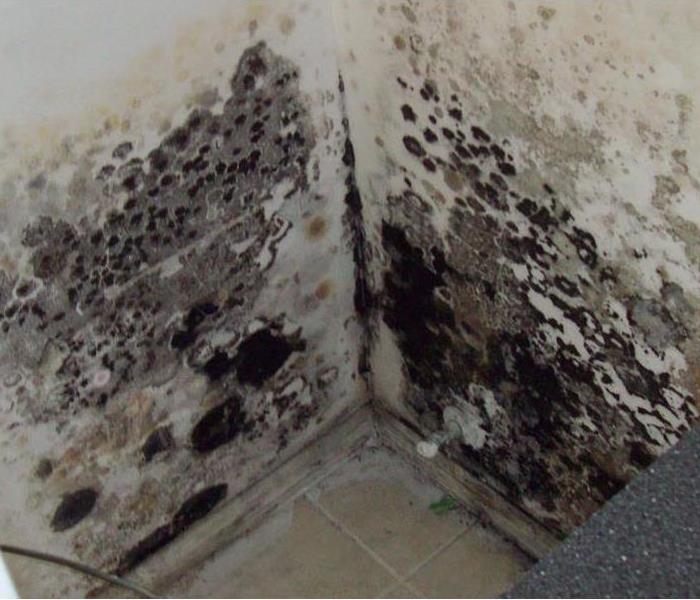 In Saint Croix Valley, mold can spread through a home in as little as 48 hours.
In Saint Croix Valley, mold can spread through a home in as little as 48 hours.
Microscopic mold spores naturally occur almost everywhere, both outdoors and indoors. This makes it impossible to remove all mold from a home or business. Therefore, mold remediation reduces the mold spore count back to its natural or baseline level. Some restoration businesses advertise “mold removal” and even guarantee to remove all mold, which is a fallacy. Consider the following mold facts:
- Mold is present almost everywhere, indoors and outdoors.
- Mold spores are microscopic and float along in the air and may enter your home through windows, doors, or AC/heating systems or even hitch a ride indoors on your clothing or a pet.
- Mold spores thrive on moisture. Mold spores can quickly grow into colonies when exposed to water. These colonies may produce allergens and irritants.
- Before mold remediation can begin, any sources of water or moisture must be addressed. Otherwise, the mold may return.
- Mold often produces a strong, musty odor and can lead you to possible mold problem areas.
- Even higher-than-normal indoor humidity can support mold growth. Keep indoor humidity below 45 percent.
If your home or business has a mold problem, we can inspect and assess your property and use our specialized training, equipment, and expertise to remediate your mold infestation.
If You See Signs of Mold, Call Us Today – 715-381-2266
About SERVPRO of The Saint Croix Valley
3/13/2018 (Permalink)
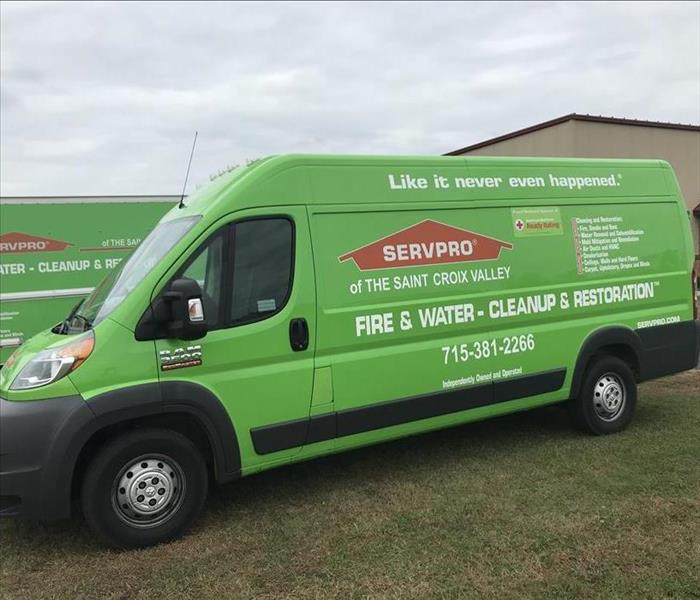 Saint Croix Valley Residents: We provide immediate emergency services day or night!
Saint Croix Valley Residents: We provide immediate emergency services day or night!
SERVPRO of The Saint Croix Valley specializes in the cleanup and restoration of residential and commercial property after a fire, smoke or water damage event. Our staff is highly trained in property damage restoration and we are an IICRC Certified Firm. We believe in continuous training: from initial and ongoing training at SERVPRO’s corporate training facility to regular IICRC-industry certification, rest assured our staff is equipped with the knowledge to restore your property.
Meet Our Crew
Certifications
SERVPRO of The Saint Croix Valley provides 24-hour emergency service and is dedicated to being faster to any-sized disaster in The Saint Croix Valley. We can respond immediately to your emergency and have the expertise to handle your restoration or cleaning needs.
- 24-Hour Emergency Service
- Faster to Any-Sized Disaster
- Highly Trained Restoration Technicians
- A Trusted Leader in the Restoration Industry
- Locally Owned and Operated
- Advanced Restoration and Cleaning Equipment
Have Questions? Call Us 24/7: 715-381-2266
Residential Services
Whether your home needs emergency flood damage or your upholstery cleaned, you can depend on us. Our technicians have extensive cleaning and restoration training and can make your property look its best. Learn more about our residential services:
- Water Damage Restoration
- Fire Damage Restoration
- Mold Remediation
- Storm Damage Restoration
- Cleaning Services
- Building/Reconstruction Services
Commercial Services
There's never a convenient time for fire or Water damage to strike your commercial property. Every hour spent cleaning up is an hour of lost revenue and productivity. So, when the need arises for professional cleaning or emergency restoration services we have the training and expertise to respond promptly with highly trained technicians to get your property back to business. Learn more about commercial services.
- Commercial Water Damage Restoration
- Commercial Fire Damage Restoration
- Commercial Mold Remediation
- Commercial Storm Damage Restoration
- Commercial Cleaning Services
Emergency Ready Profile
3/13/2018 (Permalink)
 Call SERVPRO of The Saint Croix Valley for your free Emergency Ready Profile. Make sure your business has a plan, should disaster strike.
Call SERVPRO of The Saint Croix Valley for your free Emergency Ready Profile. Make sure your business has a plan, should disaster strike.
The best way to reduce business interruption following a disaster is to plan for it NOW.
As many as 50% of businesses may never recover following a disaster according to the latest industry research. Of the businesses that survive, the overwhelming majority of them had a preparedness plan in place. Pre-planning can serve as an insurance policy aimed at peace of mind.
By developing a SERVPRO Emergency Ready Profile for your Saint Croix Valley business, you can minimize business interruption by having an immediate plan of action. Knowing what to do and what to expect in advance is the key to timely mitigation and can help minimize how water and fire damage can affect your business.
Are you ready?
Preparation is a key component for making it through any size disaster, whether it’s a small water leak, a large fire or an area flood. The best time for planning for such events is not when the event happens, but well before it happens. No one ever plans on a disaster, but you can plan for it. Now is the time to ask yourself, “Are you ready for whatever could happen?”
The SERVPRO Emergency READY Profile is a start-up approach that provides the critical information to begin mitigation and recovery services. It is designed to serve as a quick reference of important building and contact information. By working with SERVPRO’s Emergency READY Profile, your business will receive the benefit of over 40 years of experience in reducing the impact of any natural or man-made disaster. SERVPRO is a leader in water and fire damage response and can help you quickly get your property back in working order.
The SERVPRO Emergency READY Profile Advantage
- A no cost assessment of your facility. This means there is no need to allocate funds, giving you a great value at no cost.
- A concise Profile Document that contains only the critical information needed in the event of an emergency. It will only take a little time to complete and will not take you away from current projects. But it will save you a lot of time if ever needed.
- A guide to help you get back into your building following a disaster. This can help minimize the amount of time your business in inactive by having an immediate plan of action.
- Establishes your local SERVPRO Franchise Professional as your disaster mitigation and restoration provider. You have a provider that is recognized as an industry leader and close by.
- Identification of the line of command for authorizing work to begin. This saves time so we can begin the work of mitigating the damage which can save you time and money.
- Provides facility details such as shut-off valve locations, priority areas and priority contact information. Having a quick reference of what to do, how to do it and who to call provides solutions in advance of an emergency so that during the emergency you are “Ready for whatever happens.”
Call us today to get started, 715-381-2266!
SERVPRO of The Saint Croix Valley representatives are happy to meet with property managers and business owners for a free assessment and set up an Emergency READY Profile for your business.
When Storms or Floods hit, SERVPRO is ready!
6/15/2017 (Permalink)
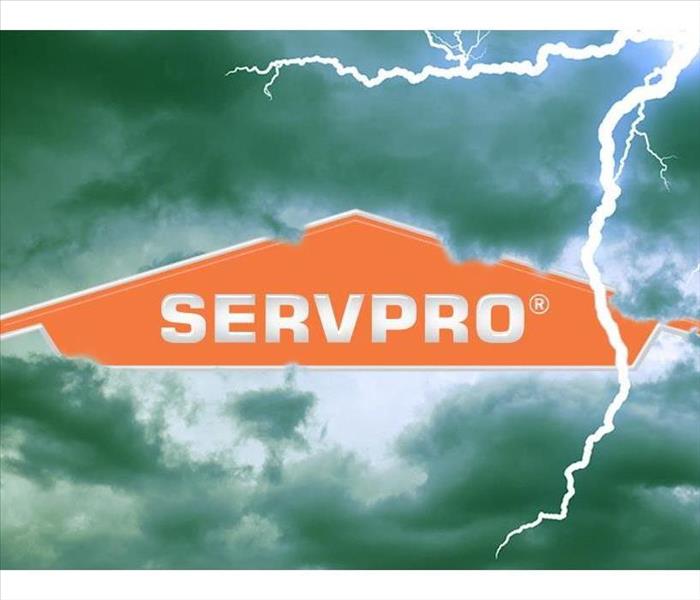 Our highly trained crews are ready to respond 24/7 to storm or flood damage in Pierce and St. Croix County.
Our highly trained crews are ready to respond 24/7 to storm or flood damage in Pierce and St. Croix County.
SERVPRO of The Saint Croix Valley specializes in storm and flood damage restoration. Our crews are highly trained and we use specialized equipment to restore your property to its pre-storm condition.
Faster Response
Since we are locally owned and operated, we are able to respond quicker with the right resources, which is extremely important. A fast response lessens the damage, limits further damage, and reduces the restoration cost.
Resources to Handle Floods and Storms
When storms hit Pierce and St. Croix county, we can scale our resources to handle a large storm or flooding disaster. We can access equipment and personnel from a network of 1,650 Franchises across the country and elite Disaster Recovery Teams that are strategically located throughout the United States.
Have Storm or Flood Damage? Call Us Today, 715-381-2266
Have a Wet Basement? We can help!
5/22/2017 (Permalink)
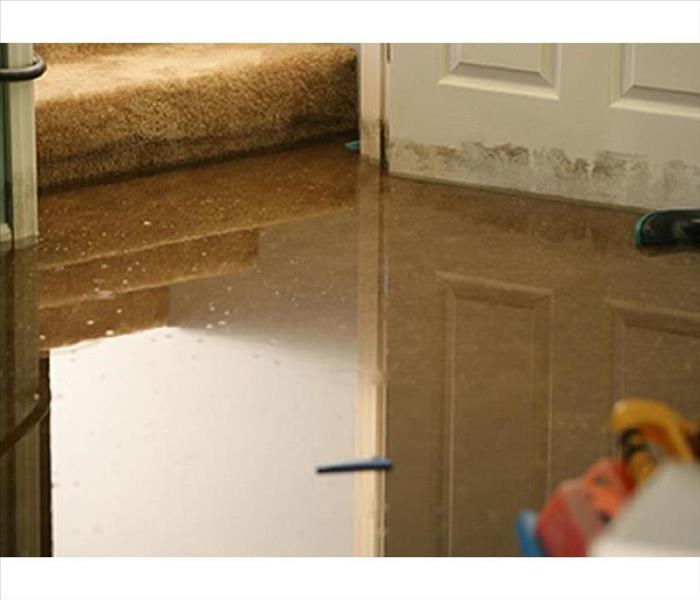 SERVPRO of The Saint Croix Valley can extract water, place the equipment needed, and monitor the progress to complete the drying process.
SERVPRO of The Saint Croix Valley can extract water, place the equipment needed, and monitor the progress to complete the drying process.
Sump pump failures, groundwater seepage, sewage backups... If you have recently experienced flooding in your home, you are not alone. Our phones have been busy this past week with calls about wet basements. If you have water damage in your home or business and need some help, call SERVPRO of The Saint Croix Valley at 715-381-2266.
Our crews have been trained by the IICRC (Institute of Inspection, Cleaning, and Restoration Certification), and have experience drying out structures. We can extract water, place the equipment needed, and monitor the progress to complete the drying process. We would be happy to help ease your worries and ensure that your home or business has been dried out properly so that you do not have to worry about future damage. We are locally owned and operated in the Saint Croix Valley.
Crime & Trauma Scene Decontamination
5/3/2017 (Permalink)
SERVPRO of The Saint Croix Valley professionals remove and dispose of bodily fluids, tissue, and other potentially pathogenic substances resulting from accident, trauma, crime or death. Trained technicians remove and properly dispose of any biohazard waste. As well as, thoroughly clean, disinfect, and deodorize the structure.
We are OSHA compliant and have received training in:
- Bloodborne Pathogens
- Fall Protection
- Hazard Communication
- Lock Out/Tag Out
- Confined Spaces
- Personal Protective Equipment
- Respiratory Protection
- We are a licensed medical waste hauler and can provide documented destruction of waste
We provide fast and discreet service. We are sensitive to the needs of a grieving family. We can take the stress of clean up off of the family members or building owner. Protecting people is our top priority. We work with all insurance companies.
IICRC Certified Firm
3/23/2017 (Permalink)
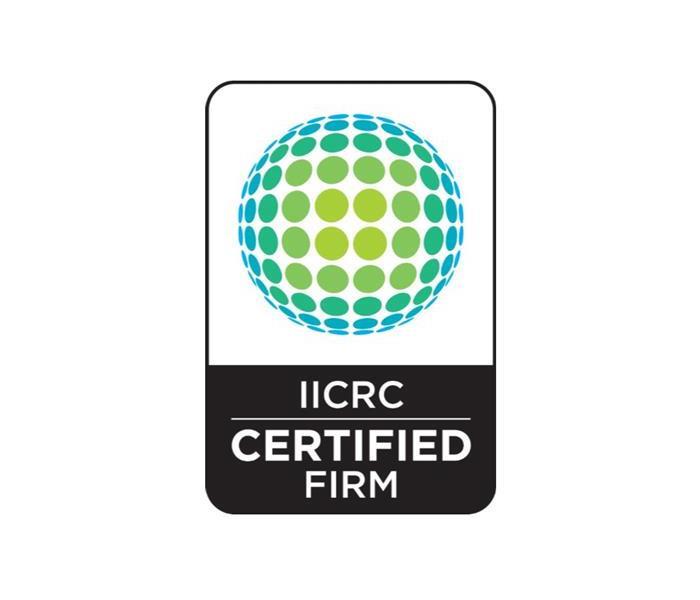 We are an IICRC Certified Firm
We are an IICRC Certified Firm
SERVPRO of The Saint Croix Valley is an IICRC firm. The Institute of Inspection, Cleaning and Restoration Certification (IICRC) creates the standards for the restoration industry and provides training and certification to restoration companies. IICRC Certified Firms have the right to display the IICRC Certified Logo.
IICRC Certified Firms must
• Present accurate information to consumers and conduct business with honesty and integrity.
• Require a technician on all jobs who has been formally trained and passed all required tests.
• Require a continuing education program to keep technicians up-to-date on the latest changes in the industry.
• Maintain liability insurance to protect all parties in the event of an accident.
• Maintain a written complaint policy and agree to Better Business Bureau or similar arbitration to resolve disputes, and accept the conclusions and recommendations of arbitration.
The IICRC Develops The Standards For The Restoration Industry
The IICRC has been the driving force in establishing the main industry standards and reference guides for professional carpet cleaning, water damage restoration and mold remediation. These IICRC standards take years to develop and require the coordination of experts in the field: manufacturers, industry organizations, insurance professionals, training schools, contractors, and public health professionals.
Every five years, the standards are reviewed and updated. The water damage restoration field changes rapidly with advancements in technology and science, and therefore the standards must evolve to keep pace.
About SERVPRO of The Saint Croix Valley
SERVPRO of The Saint Croix Valley specializes in the cleanup and restoration of residential and commercial property after a fire, smoke or water damage event. Our staff is highly trained in property damage restoration and we are an IICRC Certified Firm. We believe in continuous training: from initial and ongoing training at SERVPRO’s corporate training facility to regular IICRC-industry certification, rest assured our staff is equipped with the knowledge to restore your property.
Our technicians are certified in the following areas:
- Water Damage Restoration
- Applied Structural Drying
- Commercial Drying Specialist
- Applied Microbial Remediation
- Fire & Smoke Restoration
- Odor Control
- Carpet Cleaning
- Upholstery & Fabric Cleaning
- Carpet Repair & Reinstallation
- Health & Safety
In addition, Chris Lick, owner of SERVPRO of The Saint Croix Valley has received special recognition from the IICRC as a Master Water Restorer, Master Fire & Smoke Restorer, and Master Textile Cleaner.
Franchise Management Course
2/28/2017 (Permalink)
 Chris and Erin Lick at SERVPRO Industries, Inc.
Chris and Erin Lick at SERVPRO Industries, Inc.
Chris and Erin Lick, owners of SERVPRO of The Saint Croix Valley, just returned after spending a week at the corporate office of SERVPRO Industries, Inc. in Gallatin, Tennessee. Every five years, SERVPRO franchise owners are required to attend Franchise Management Course (FMC) as a prerequisite to renewing their franchise license.
Chris and Erin were able to hear first-hand about some of the new initiatives and resources available at the corporate level. They learned about business management and leadership. Most importantly they enjoyed networking with and learning from other SERVPRO franchise owners.
This is the second time that Chris and Erin have attended FMC, and have enjoyed and benefited from the experience both times. Next January SERVPRO of The Saint Croix Valley will be celebrating ten years in business!
Does Your Home Have A Mold Problem?
2/9/2017 (Permalink)
Microscopic mold spores naturally occur almost everywhere, both outdoors and indoors. This makes it impossible to remove all mold from a home or business. Therefore, mold remediation reduces the mold spore count back to its natural or baseline level. Some restoration businesses advertise “mold removal” and even guarantee to remove all mold, which is a fallacy.
Consider the following mold facts:
- Mold is present almost everywhere, indoors and outdoors
- Mold spores are microscopic and float along in the air and may enter your home through windows, doors, or AC/heating systems or even hitch a ride indoors on your clothing or a pet.
- Mold spores thrive on moisture. Mold spores can quickly grow into colonies when exposed to water. These colonies may produce allergens and irritants.
- Before mold remediation can begin, any sources of water or moisture must be addressed. Otherwise, the mold may return.
- Mold often produces a strong, musty odor and can lead you to possible mold problem areas.
- Even higher-than-normal indoor humidity can support mold growth. Keep indoor humidity below 45 percent.
If your home or business has a mold problem, we can inspect and assess your property and use our specialized training, equipment, and expertise to remediate your mold infestation.
If You See Signs of Mold, Call Us Today – 715-381-2266
Saint Croix Valley Smoke and Soot Cleanup
11/14/2016 (Permalink)
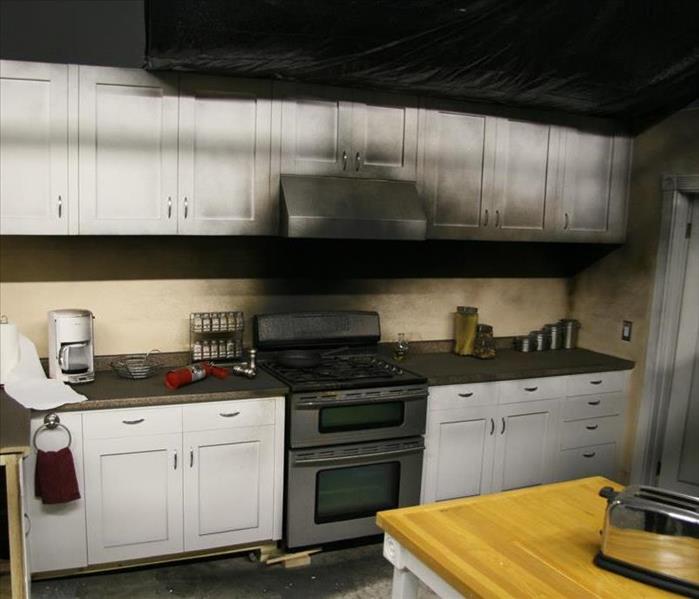 Smoke and Soot Damage Can Cause a Pervasive Odor in Your Saint Croix Valley Home.
Smoke and Soot Damage Can Cause a Pervasive Odor in Your Saint Croix Valley Home.
Smoke and soot is very invasive and can penetrate various cavities within your home, causing hidden damage and odor. Our smoke damage expertise and experience allows us to inspect and accurately assess the extent of the damage to develop a comprehensive plan of action.
Smoke and soot facts:
- Hot smoke migrates to cooler areas and upper levels of a structure.
- Smoke flows around plumbing systems, seeping through the holes used by pipes to go from floor to floor.
- The type of smoke may greatly affect the restoration process.
Different Types of Smoke
There are two different types of smoke–wet and dry. As a result, there are different types of soot residue after a fire. Before restoration begins, SERVPRO of The Saint Croix Valley will test the soot to determine which type of smoke damage occurred. The cleaning procedures will then be based on the information identified during pretesting. Here is some additional information:
Wet Smoke – Plastic and Rubber
- Low heat, smoldering, pungent odor, sticky, smeary. Smoke webs are more difficult to clean.
Dry Smoke – Paper and Wood
- Fast burning, high temperatures, heat rises therefore smoke rises.
Protein Fire Residue – Produced by evaporation of material rather than from a fire
- Virtually invisible, discolors paints and varnishes, extreme pungent odor.
Our Fire Damage Restoration Services
Since each smoke and fire damage situation is a little different, each one requires a unique solution tailored for the specific conditions. We have the equipment, expertise, and experience to restore your fire and smoke damage. We will also treat your family with empathy and respect and your property with care.
Have Questions about Fire, Smoke, or Soot Damage?
Call Us Today – SERVPRO of The Saint Croix Valley 715-381-2266
Saint Croix Valley 24 Hour Emergency Water Damage Service
8/31/2016 (Permalink)
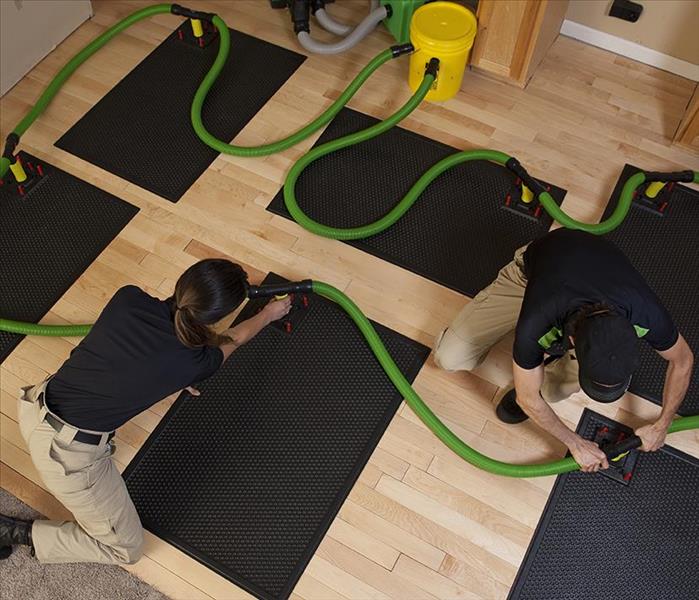 SERVPRO of The Saint Croix Valley provides 24 hour fire and water damage restoration service in Pierce and Saint Croix County, Wisconsin.
SERVPRO of The Saint Croix Valley provides 24 hour fire and water damage restoration service in Pierce and Saint Croix County, Wisconsin.
SERVPRO of The Saint Croix Valley is available 24 hours a day for water emergencies, large or small. When you are dealing with water damage, immediate action is crucial. A delay of just a few hours can greatly increase the severity of the water damage.
We Answer the Phone Ready to Help
Call Today - 715-381-2266
We understand that when you call us, you may be feeling confused, stressed, and vulnerable. You need an expert to guide you through this crisis. SERVPRO of the Saint Croix Valley has the specific water damage training and experience to help you through this tough time. We specialize in water damage restoration—in fact, it's the cornerstone of our business.
What to Expect
When you call, we will ask several questions regarding your water damage emergency. These questions will help us determine what equipment and resources to bring, including how many trained SERVPRO Professionals may be needed.
Our SERVPRO Representative will ask several questions:
- Your name and contact information
- Your insurance information (if applicable)
- The street address of the water-damaged home or business
- When did the flooding or water damage occur?
- What caused the water damage (if known)?
- Is there electricity available (on-site)?
About SERVPRO of The Saint Croix Valley
SERVPRO of The Saint Croix Valley specializes in the cleanup and restoration of residential and commercial property after a fire, smoke or water damage event. Our staff is highly trained in property damage restoration. From initial and ongoing training at SERVPRO’s corporate training facility to regular IICRC-industry certification, rest assured our staff is equipped with the knowledge to restore your property.
National Night Out
7/22/2016 (Permalink)
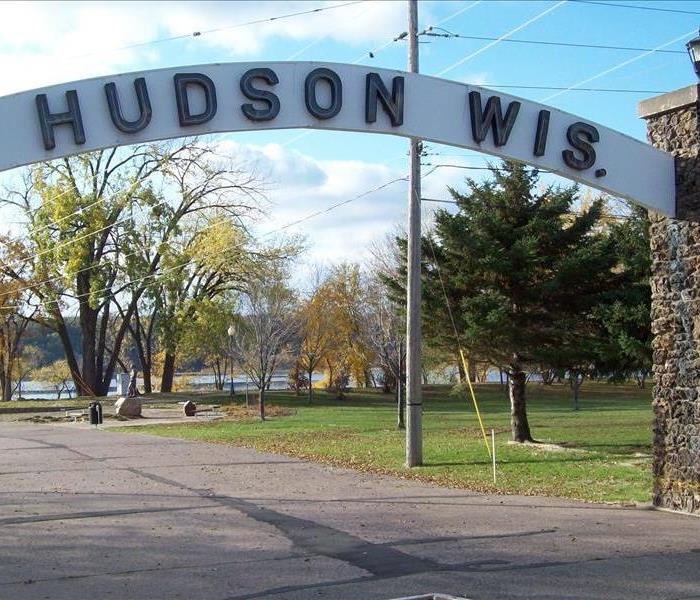 National Night out is held at Lakefront Park.
National Night out is held at Lakefront Park.
SERVPRO of The Saint Croix Valley will be participating in the Hudson National Night Out celebration at Lakefront Park on August 2nd, 2016 from 5-8pm. The goal of National Night Out is to involve all segments of the community in a campaign designed to heighten crime prevention awareness and strengthen police and community partnerships.
SERVPRO of The Saint Croix Valley will be sponsoring a photo booth. Photo props will be available. Take home a series of silly or serious photos of yourself, family, friends, and/or neighbors. Look for us in the corner! Other business and organizations will be there also with activities for the whole family.
We are happy to be part of this event to support the Hudson Police Department and connect with the community of Hudson, Wisconsin. Please join us!
Storms
7/7/2016 (Permalink)
Tuesday night's storm hit Pierce county particularly hard. We have taken in quite a few water damages, both from leaking basements and trees falling on roofs, sewage backups, even a lightning strike. SERVPRO of The Saint Croix Valley is here to help if you expereinced damage to your home or business. Please call our office at 715-381-2266.
http://www.piercecountyherald.com/news/region/4068445-wind-damage-flooding-plague-pierce-after-tuesdays-storm






 24/7 Emergency Service
24/7 Emergency Service





































































